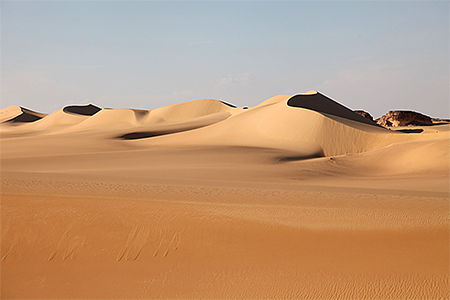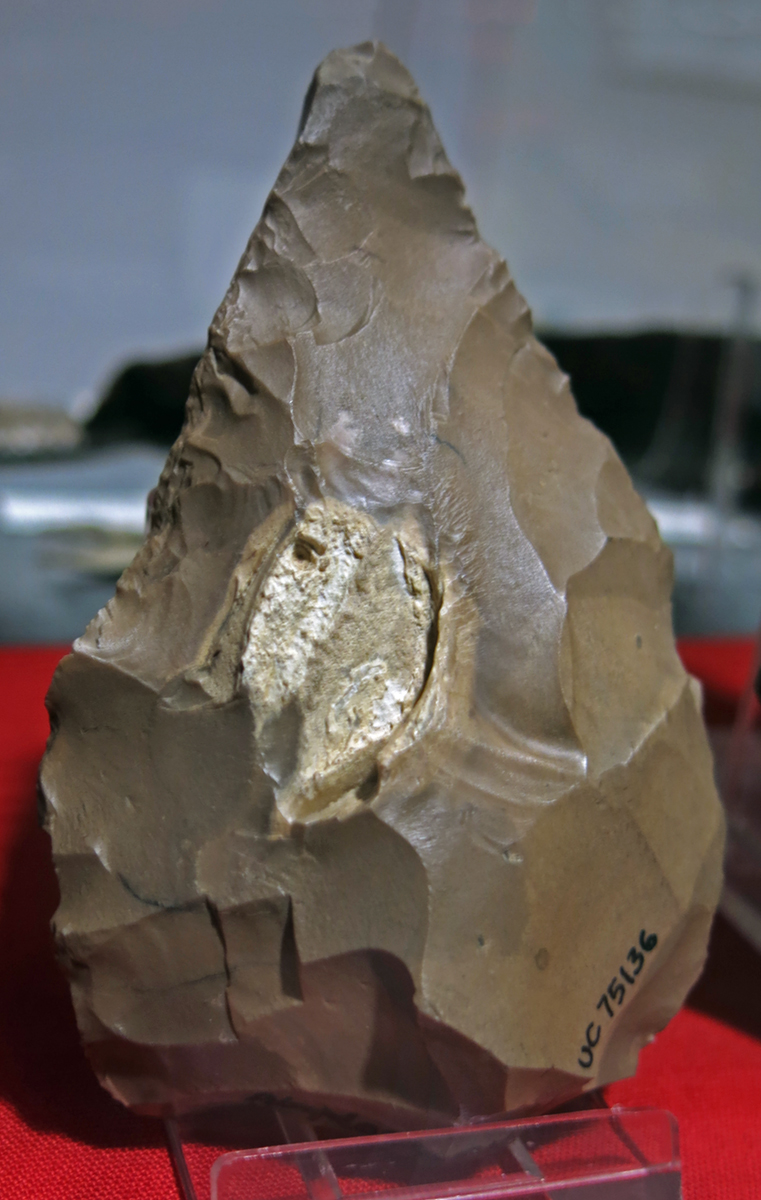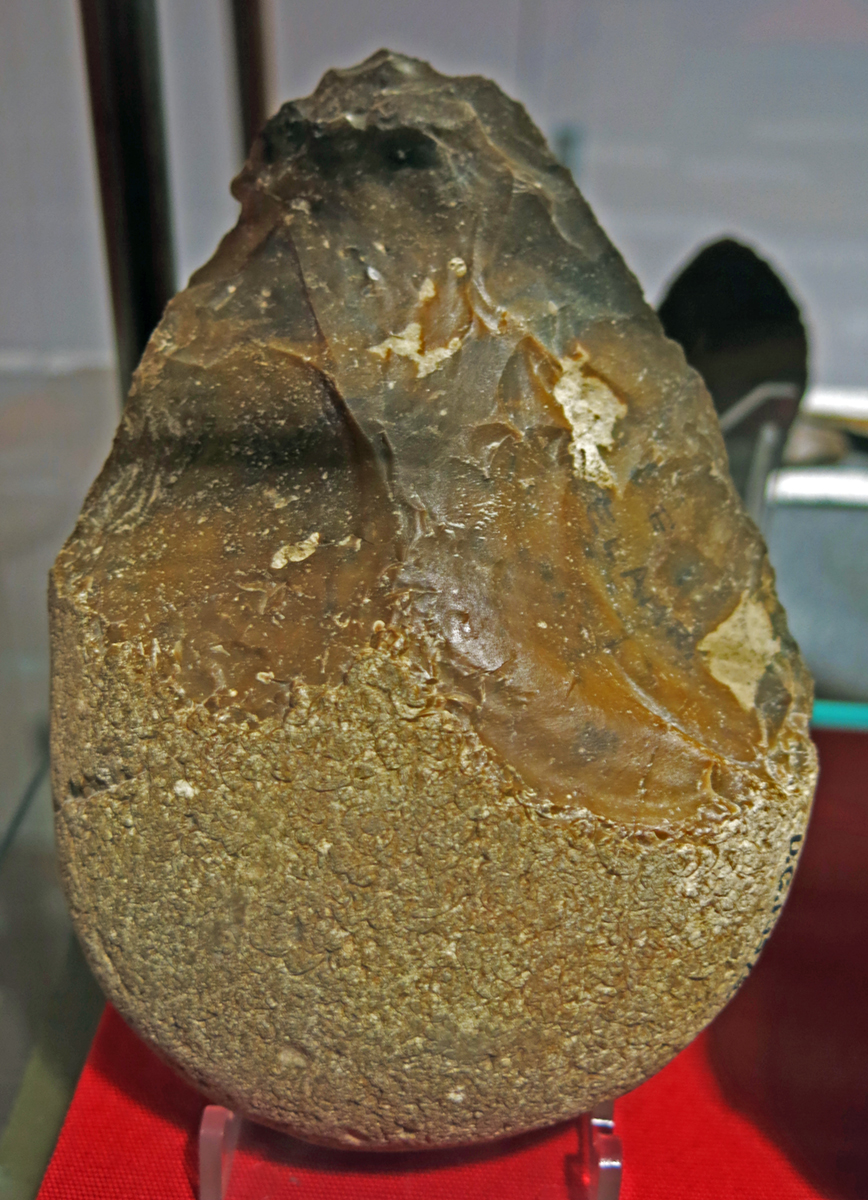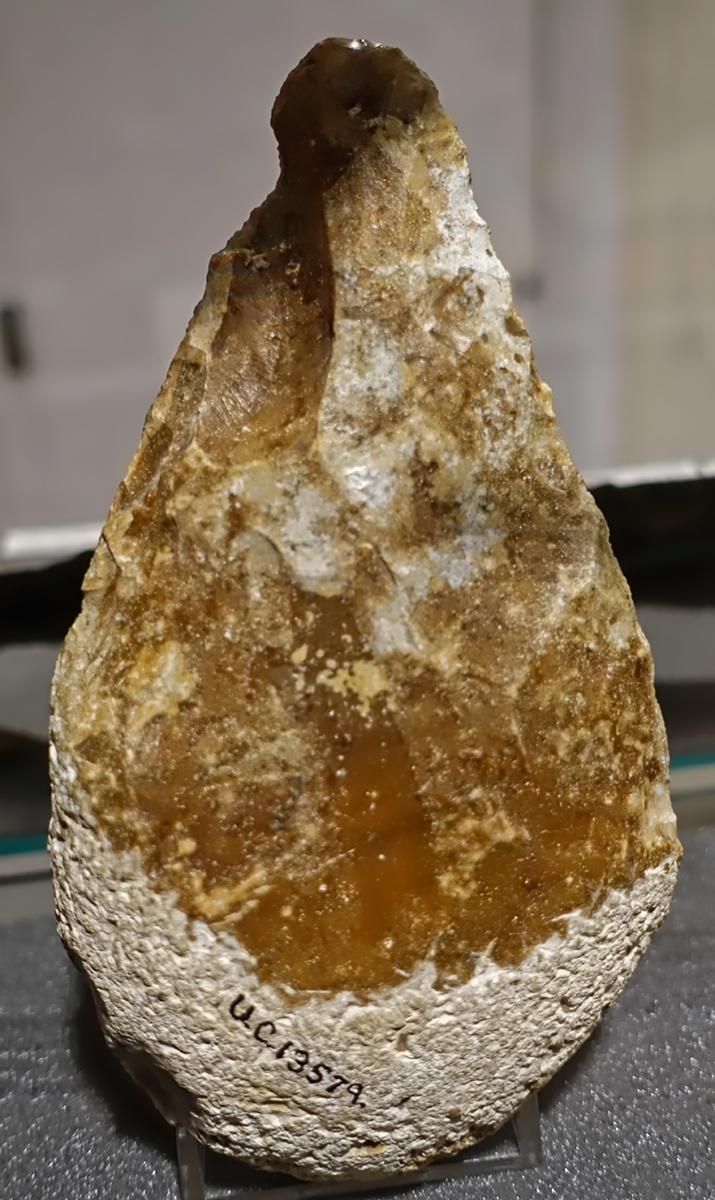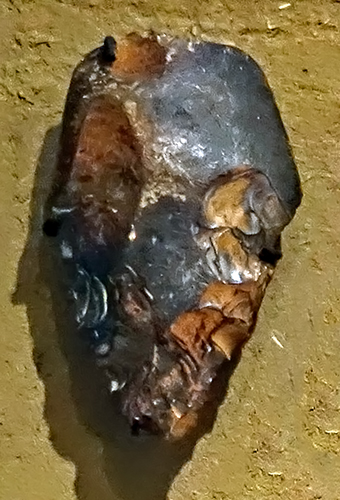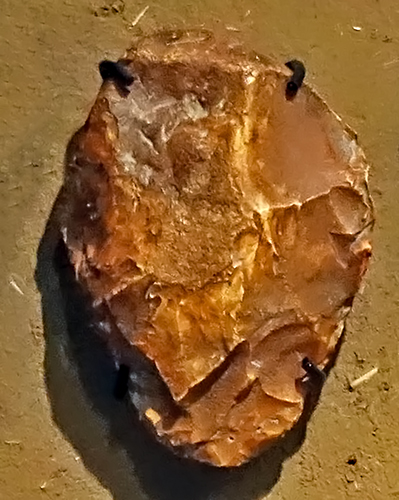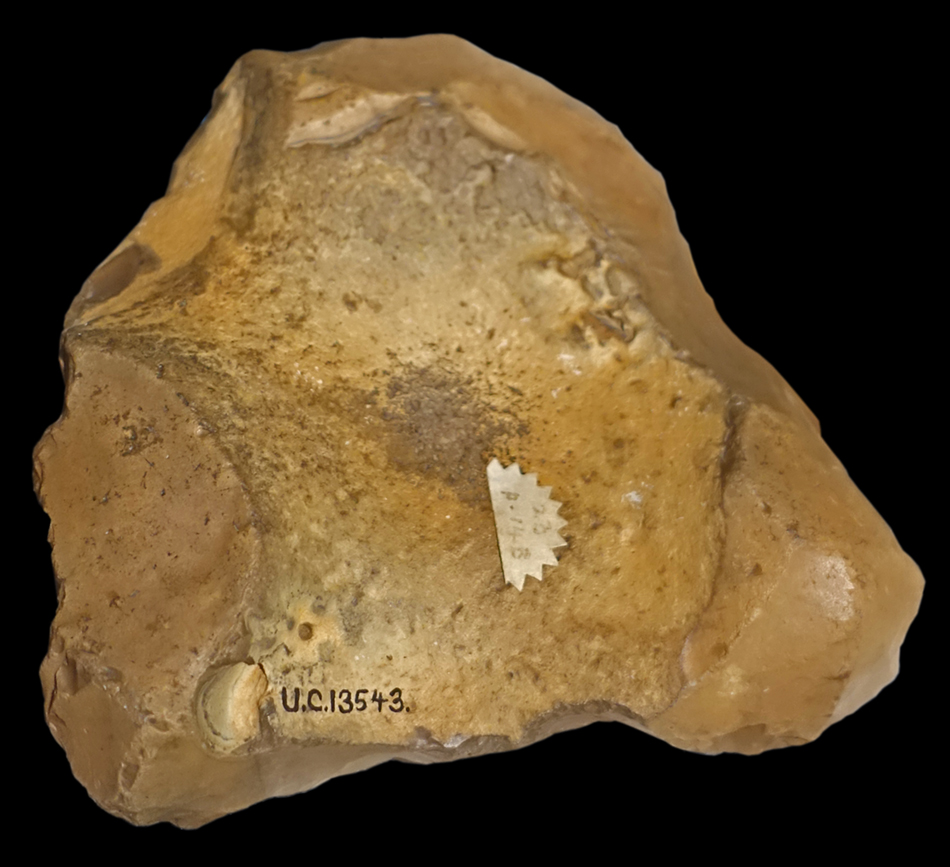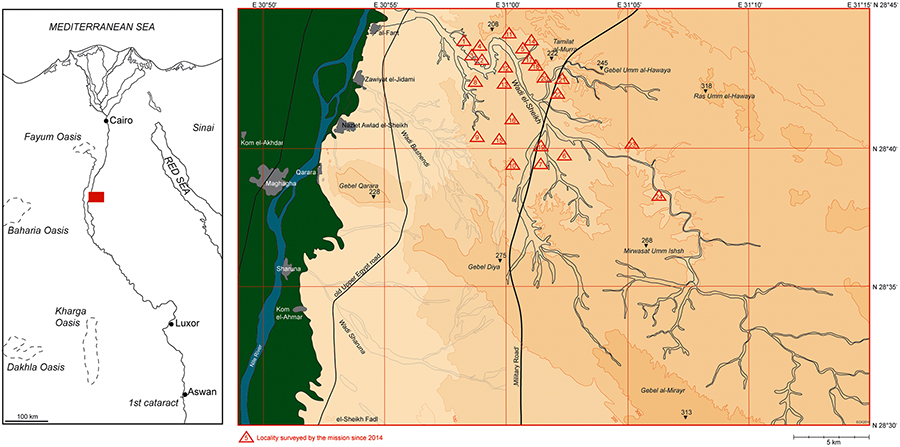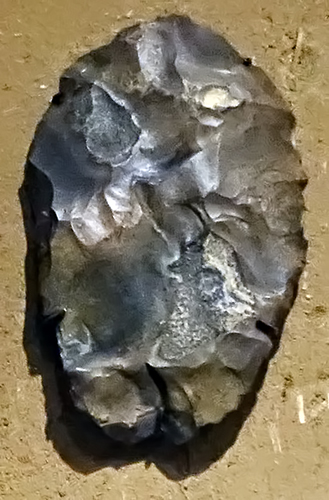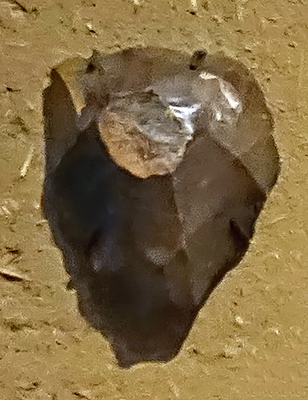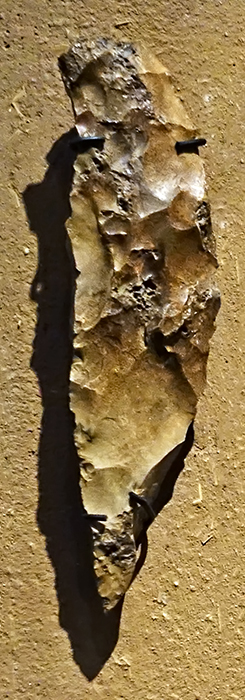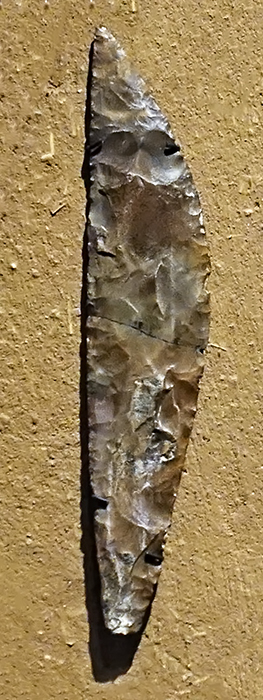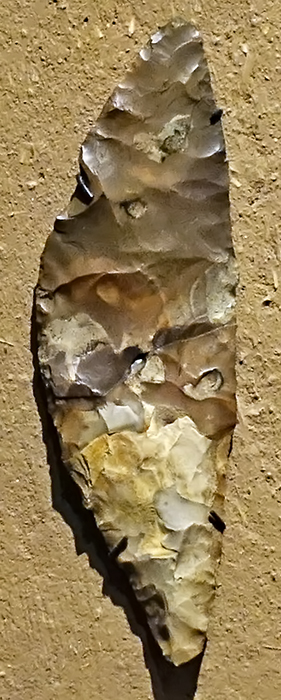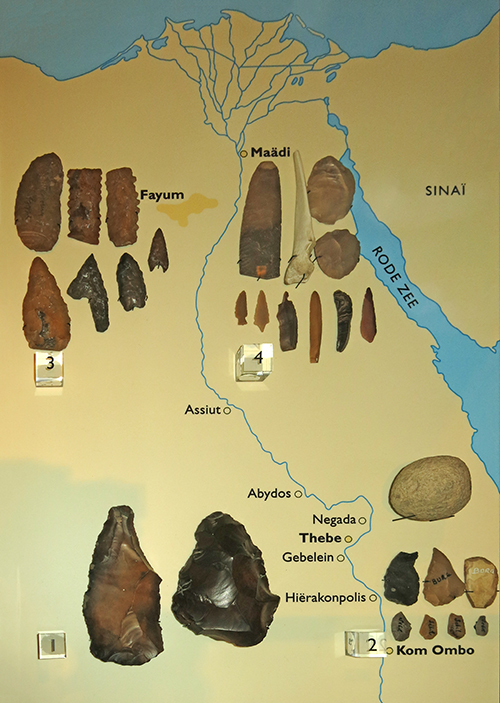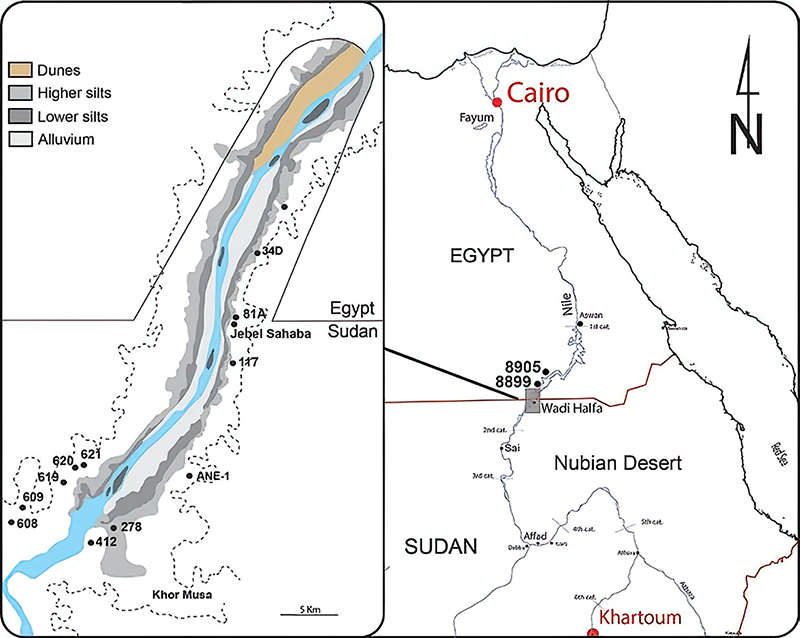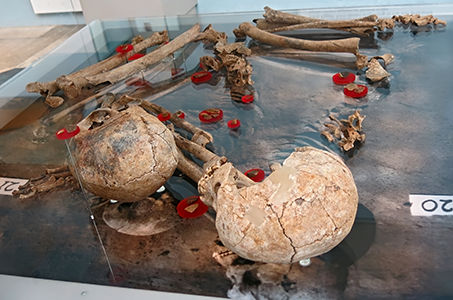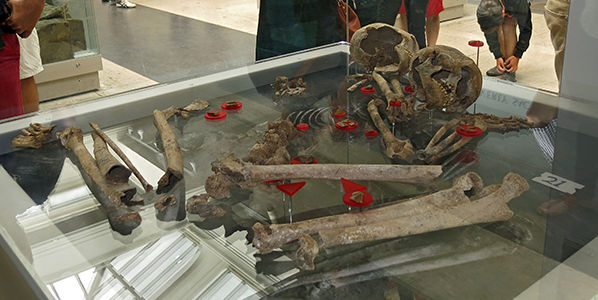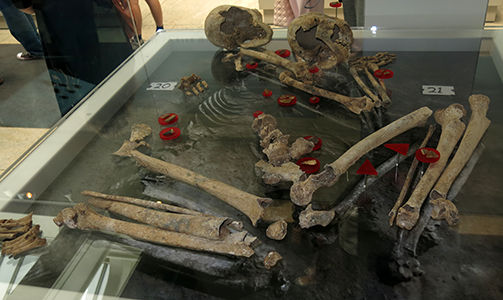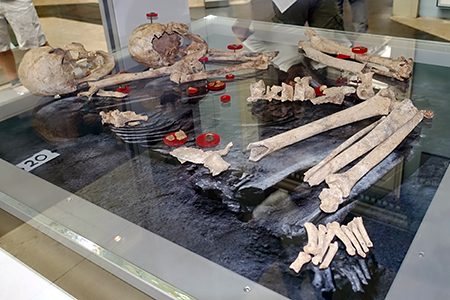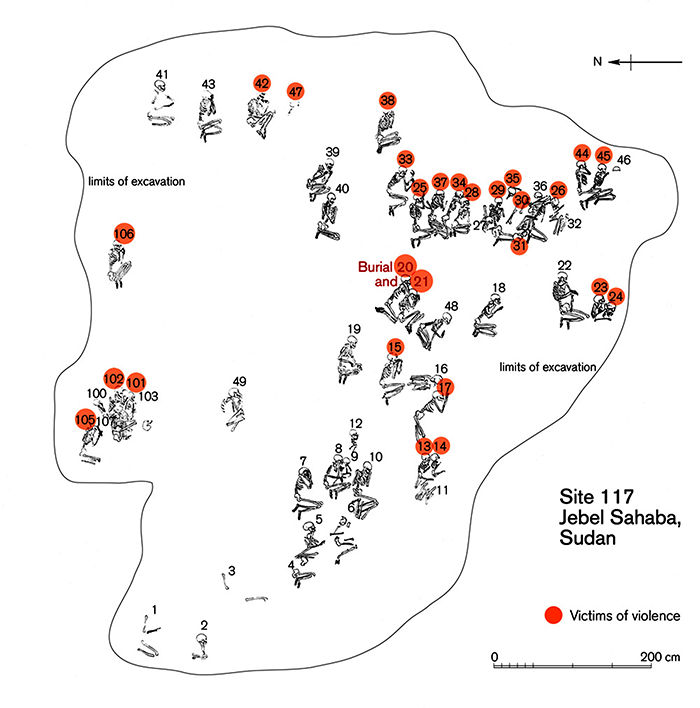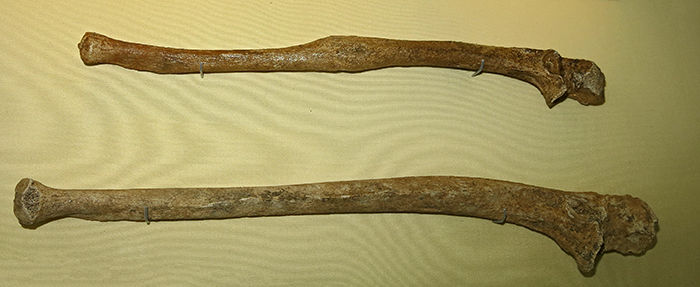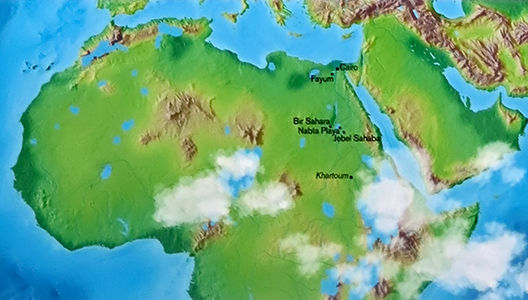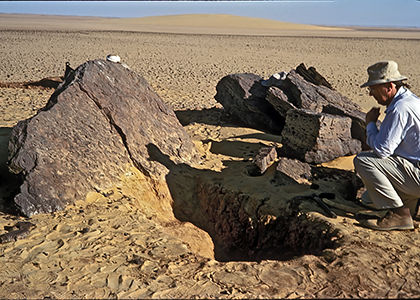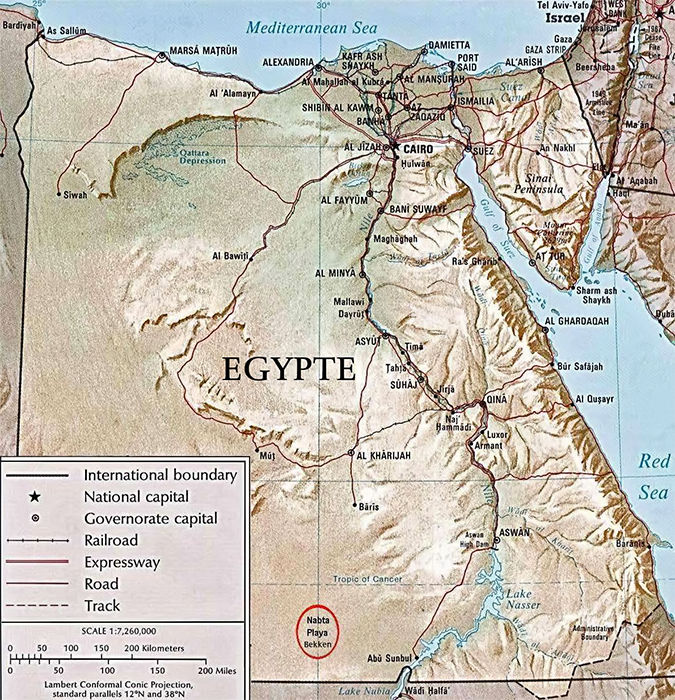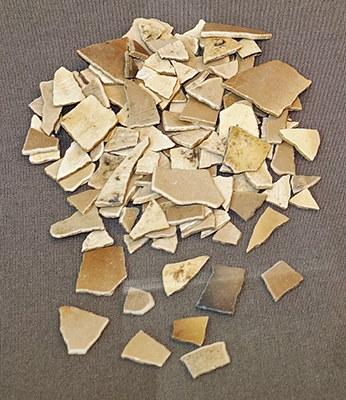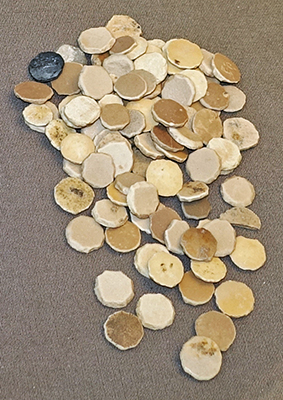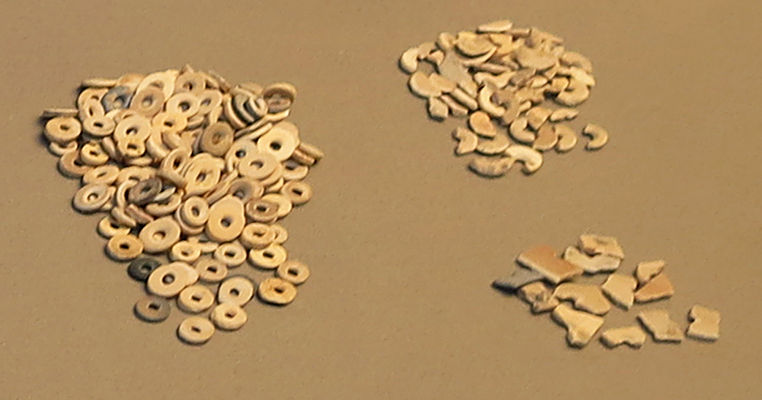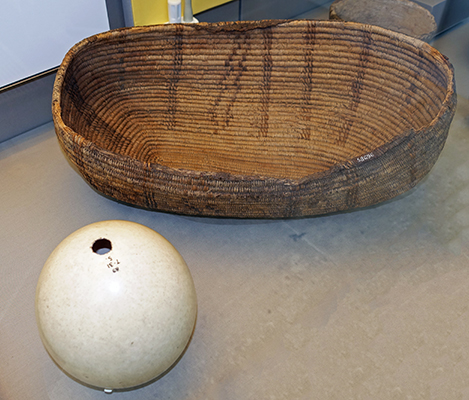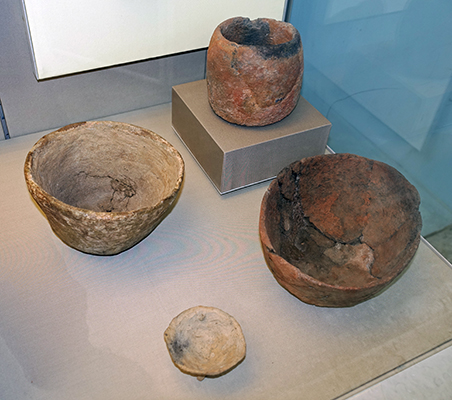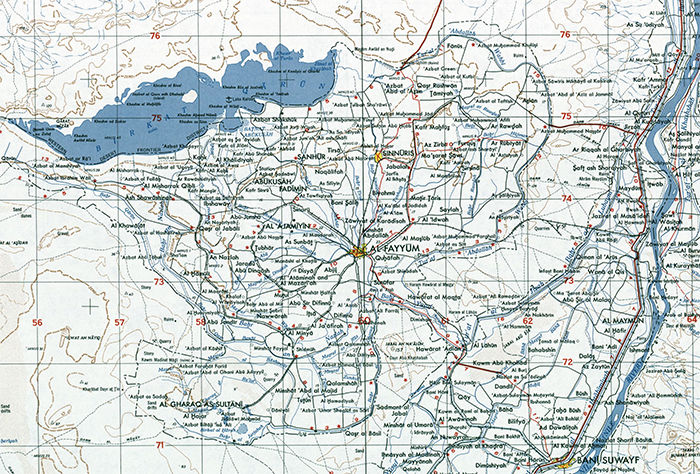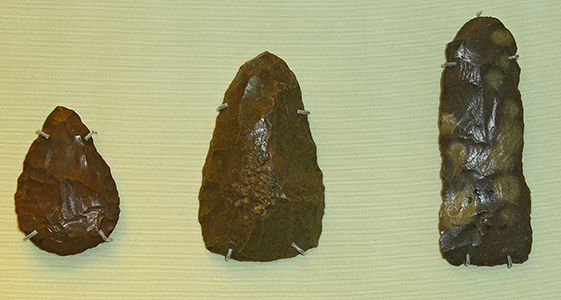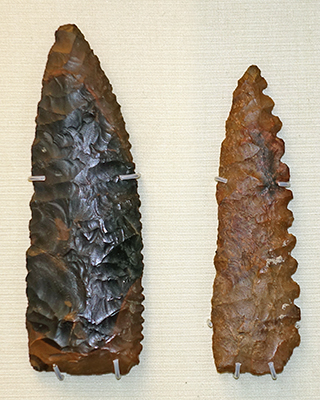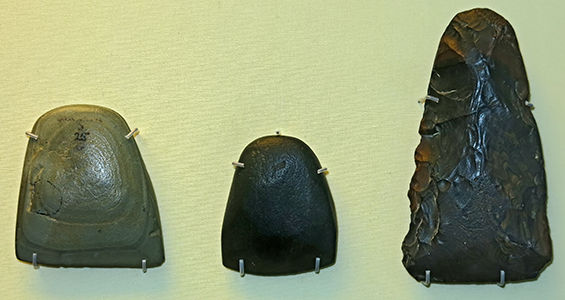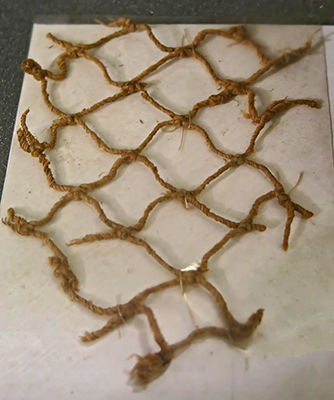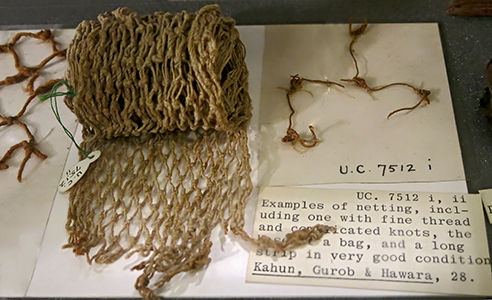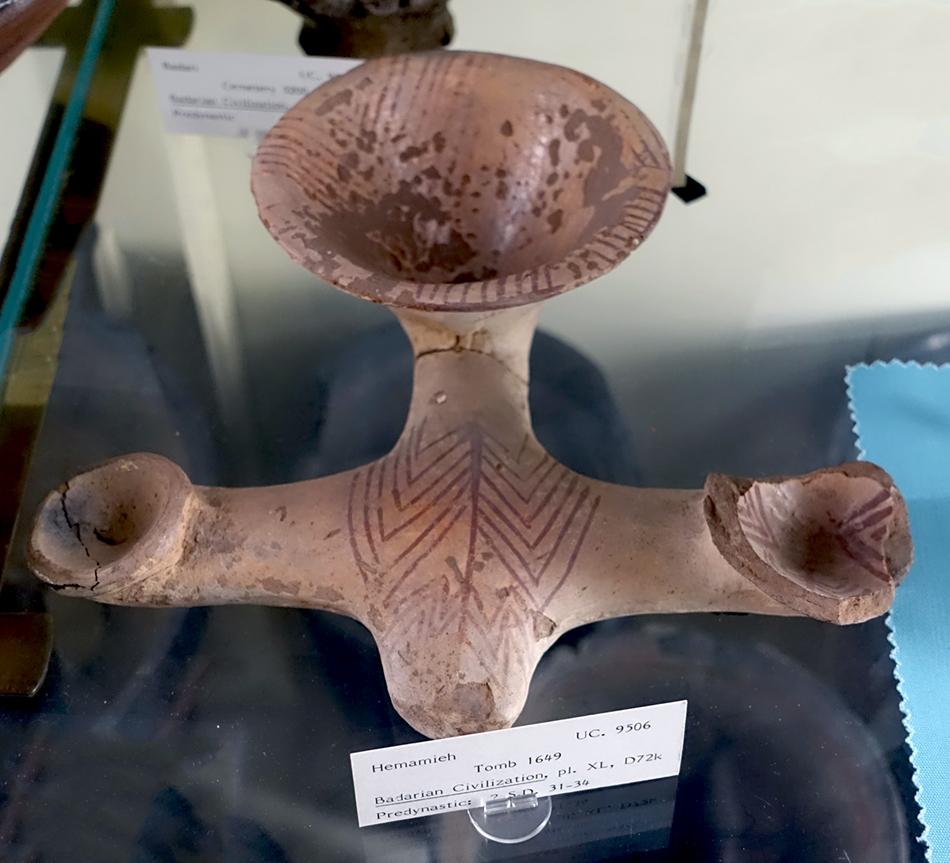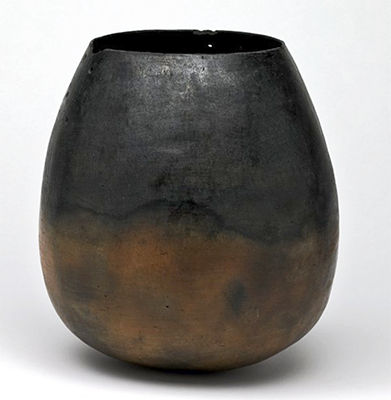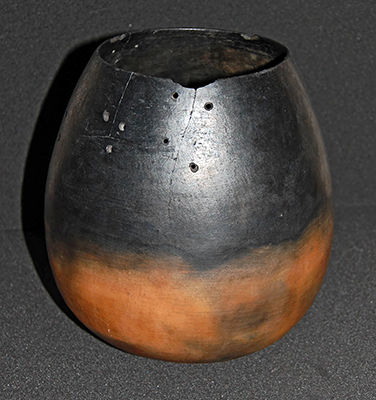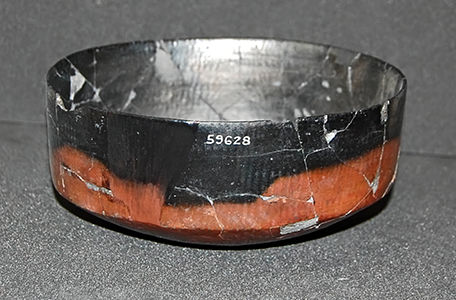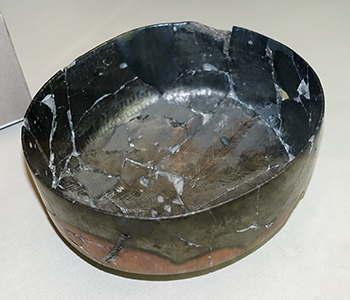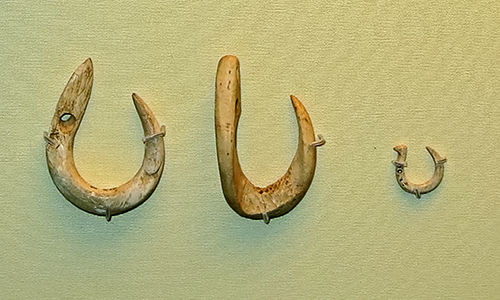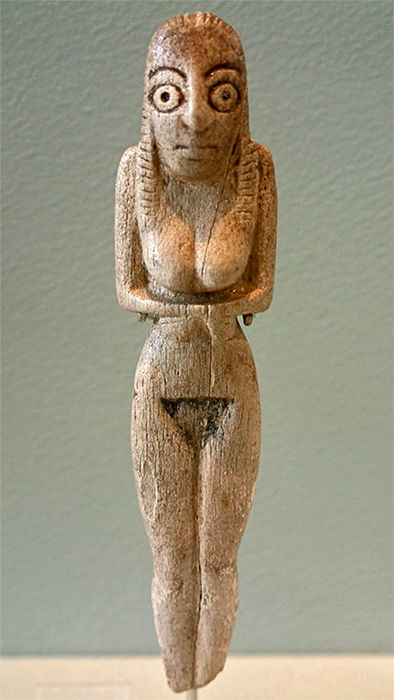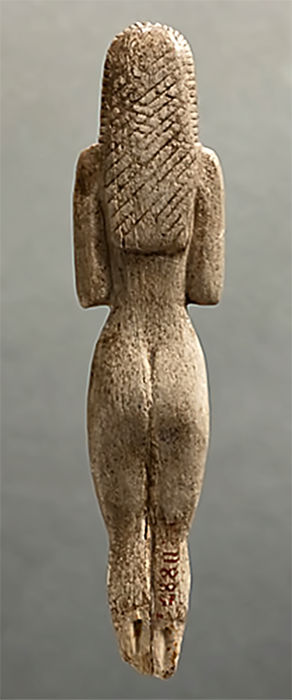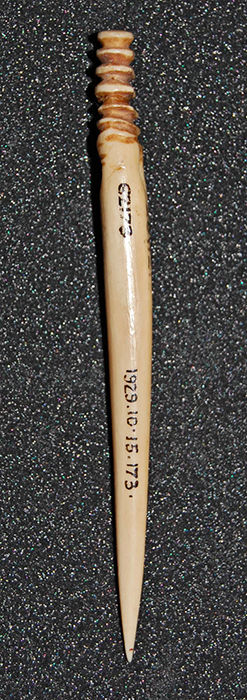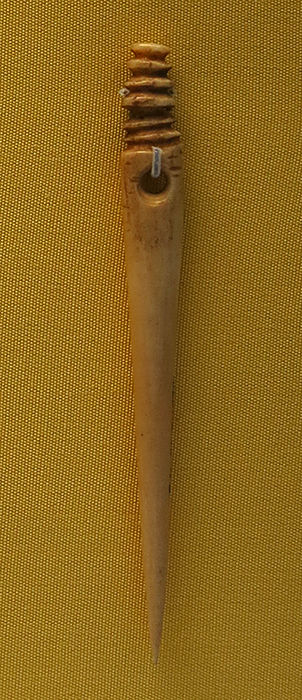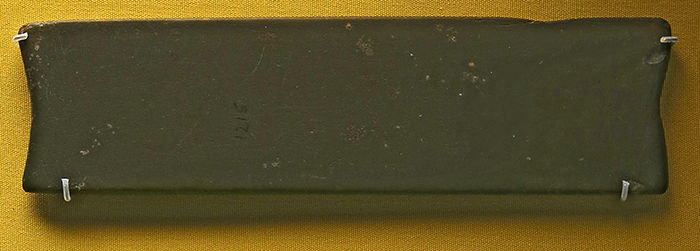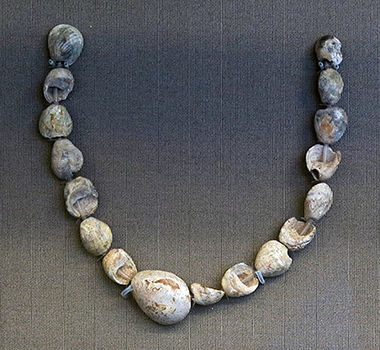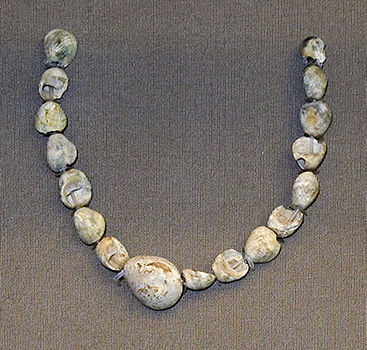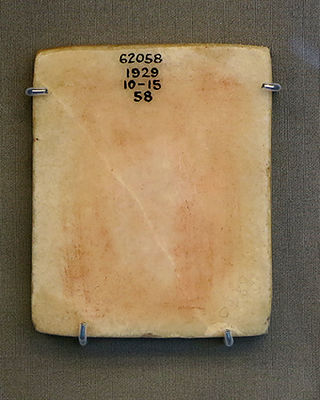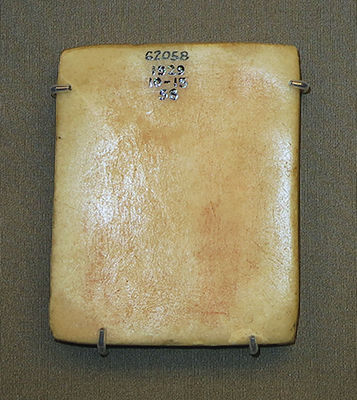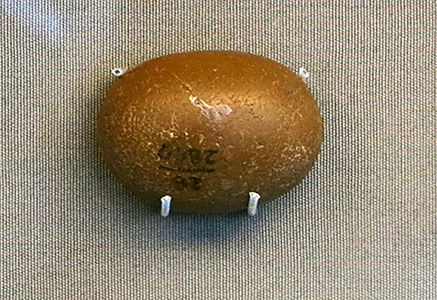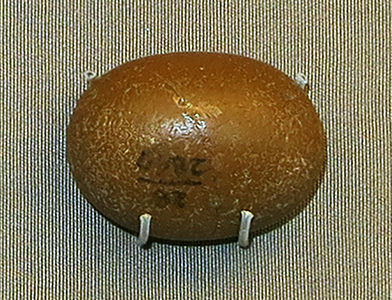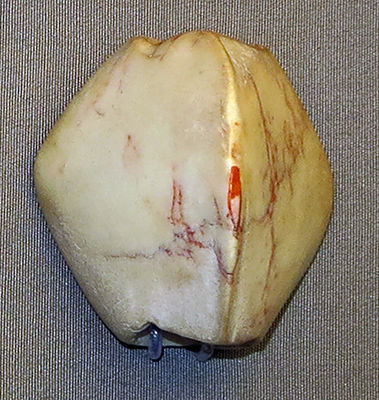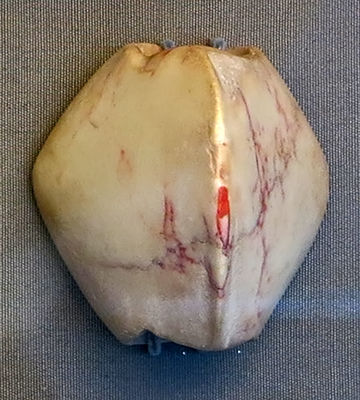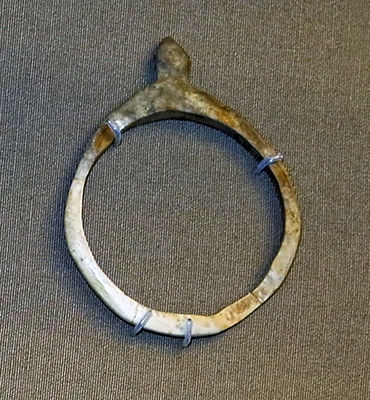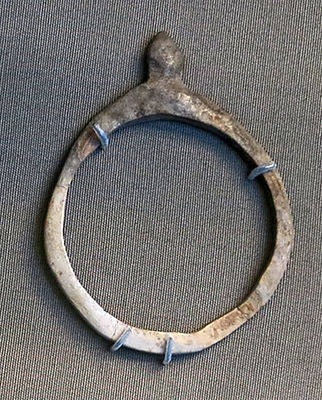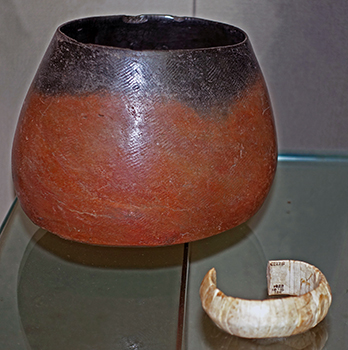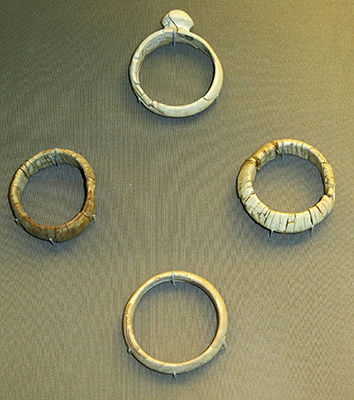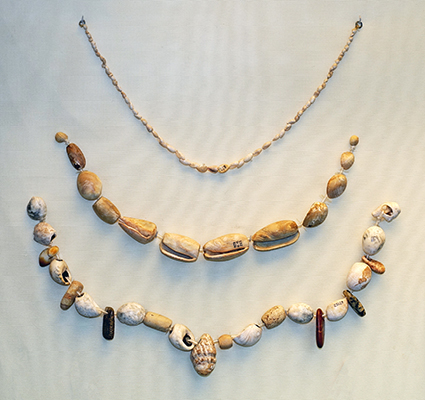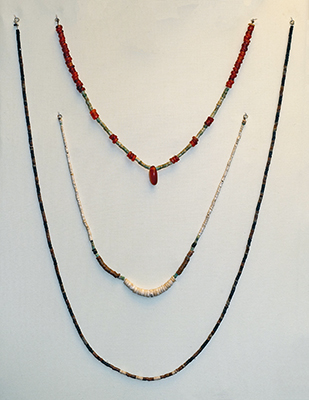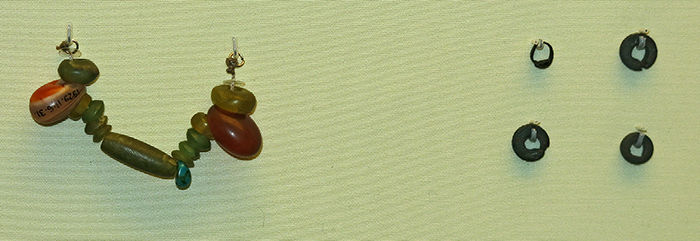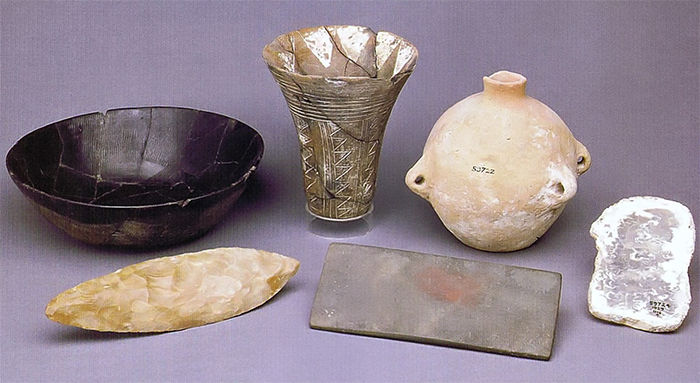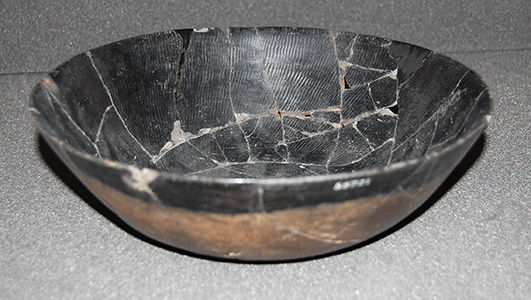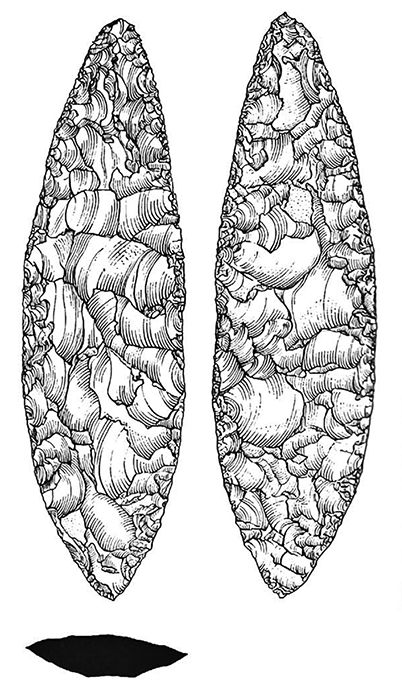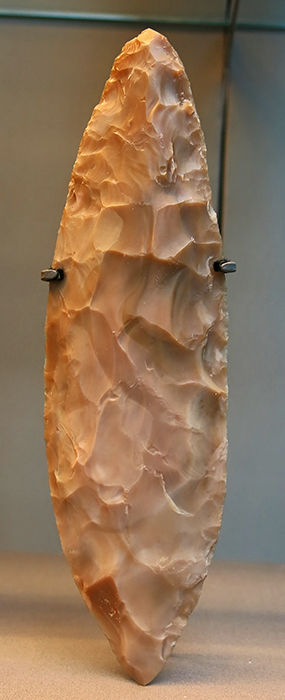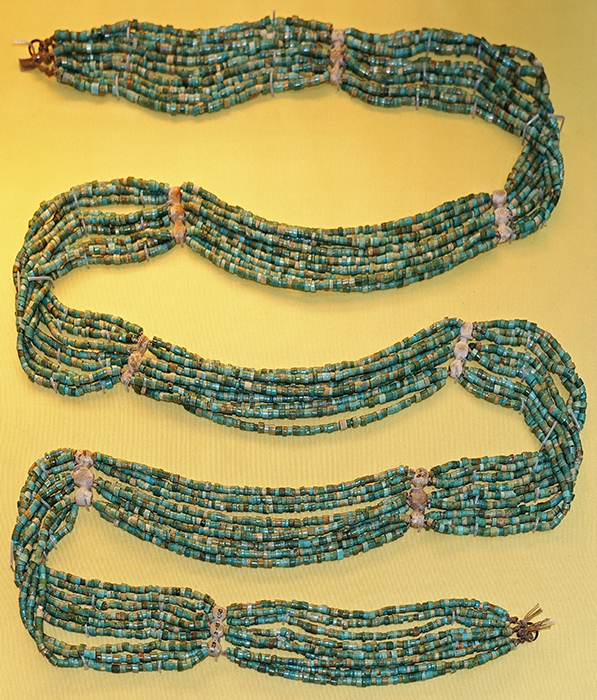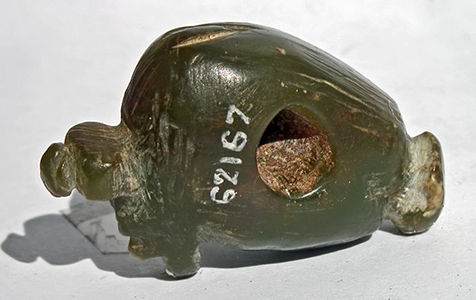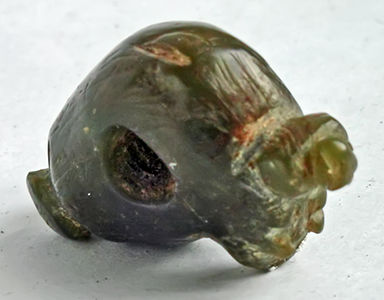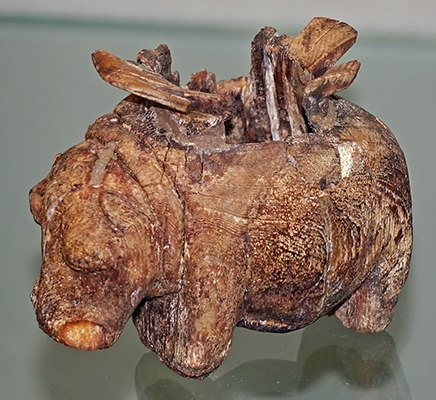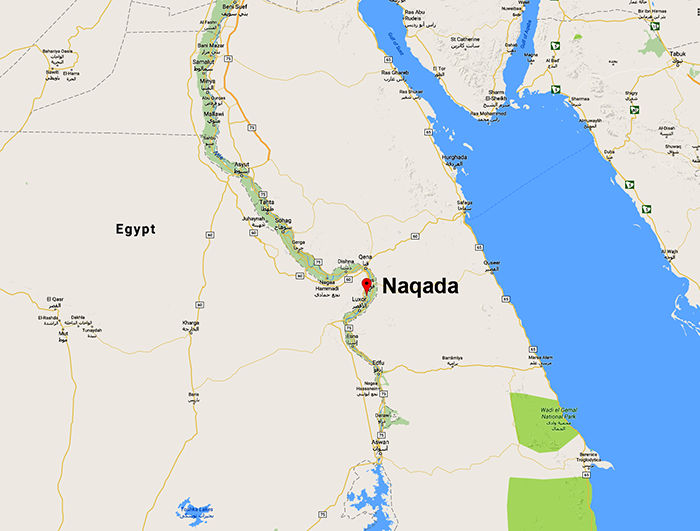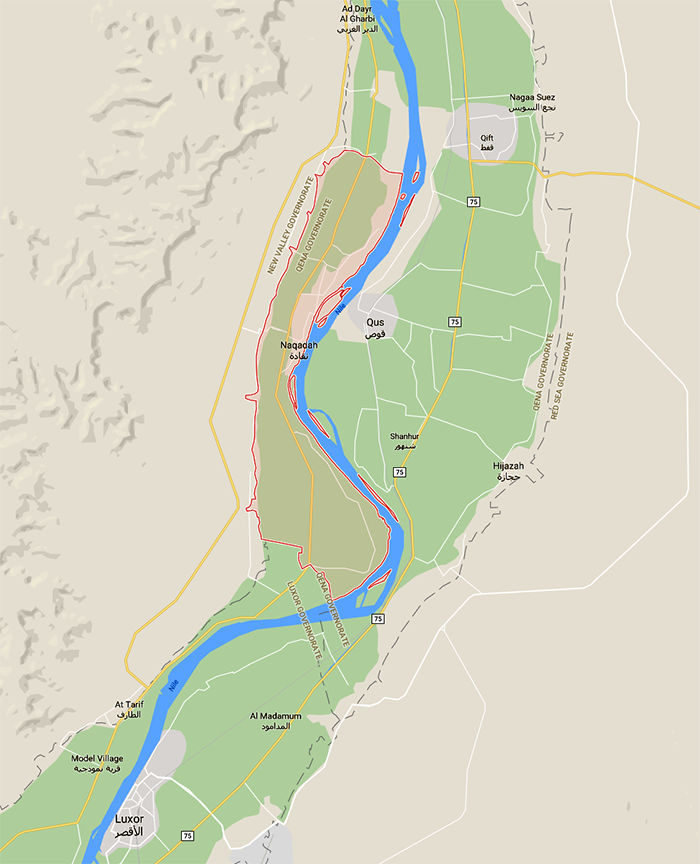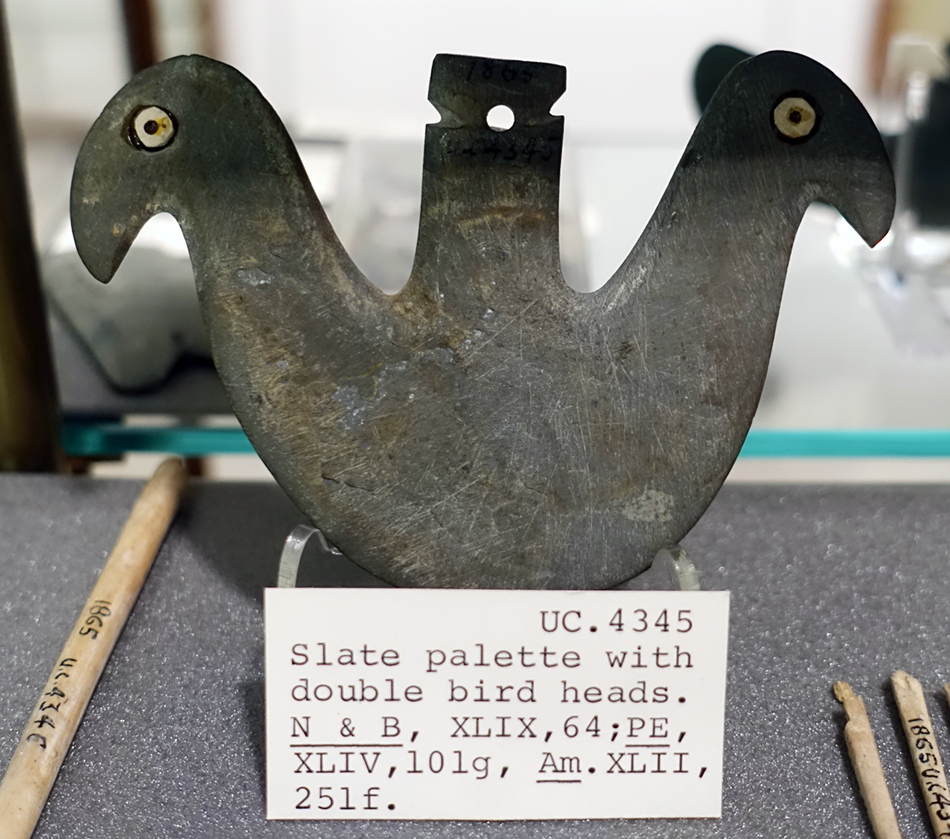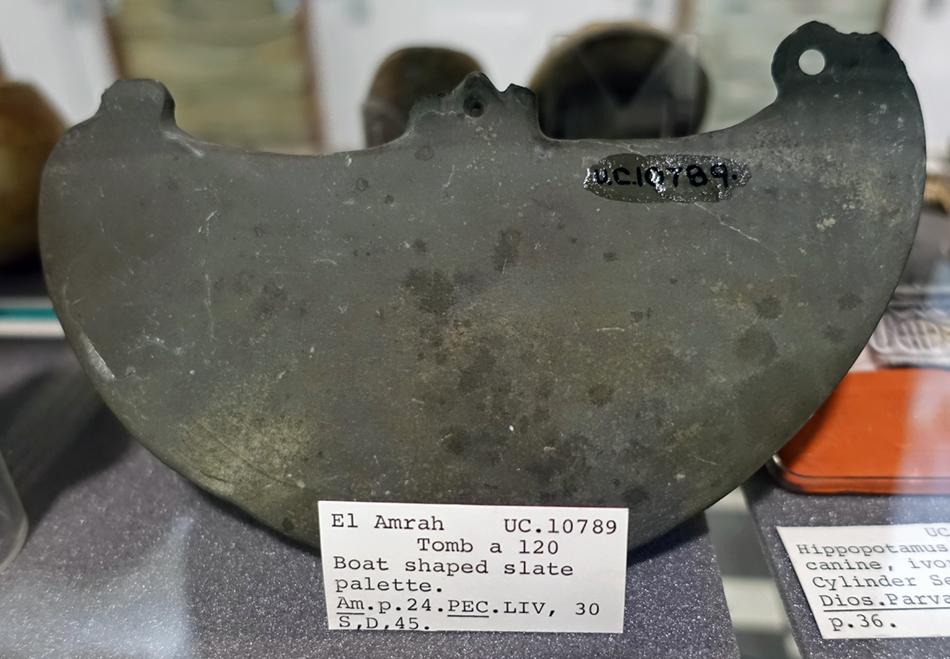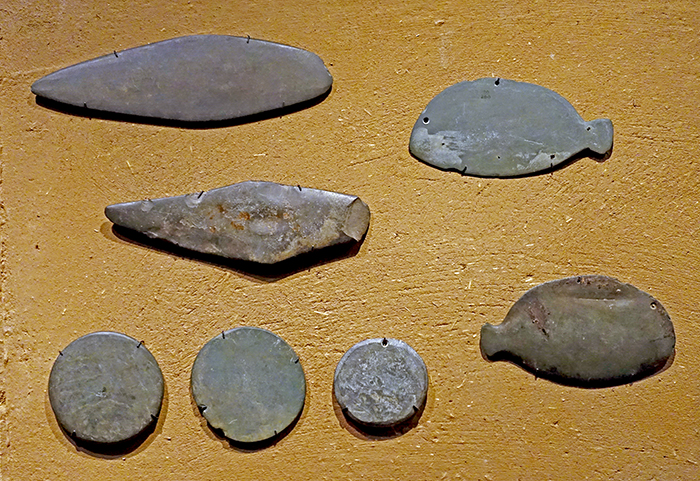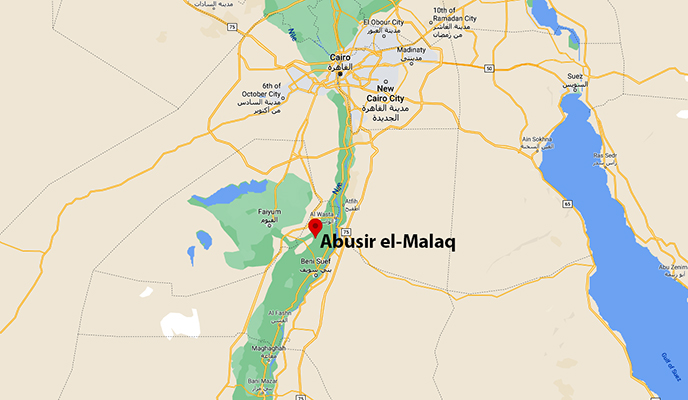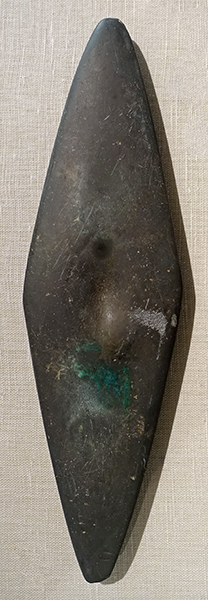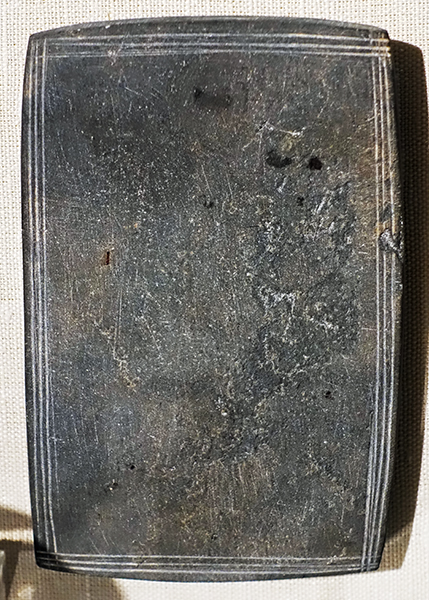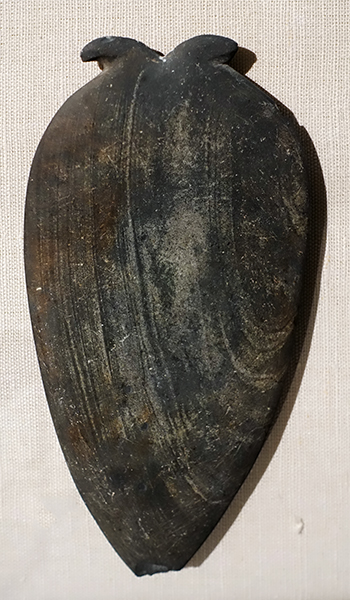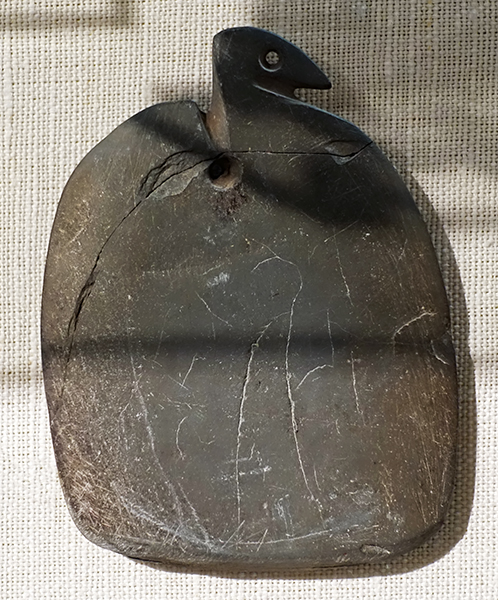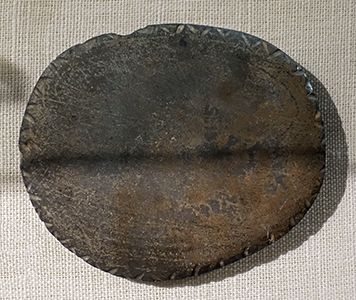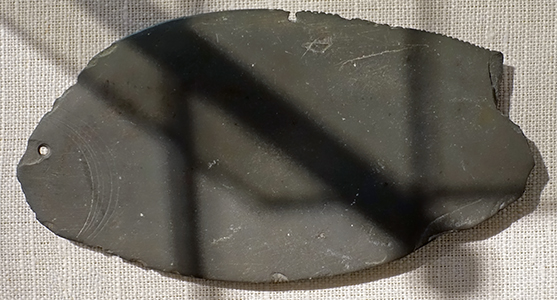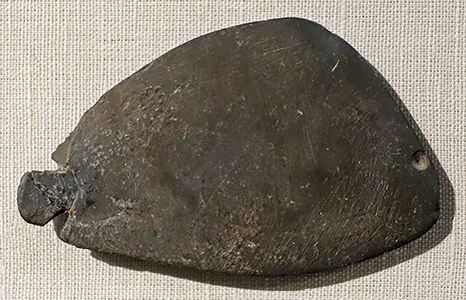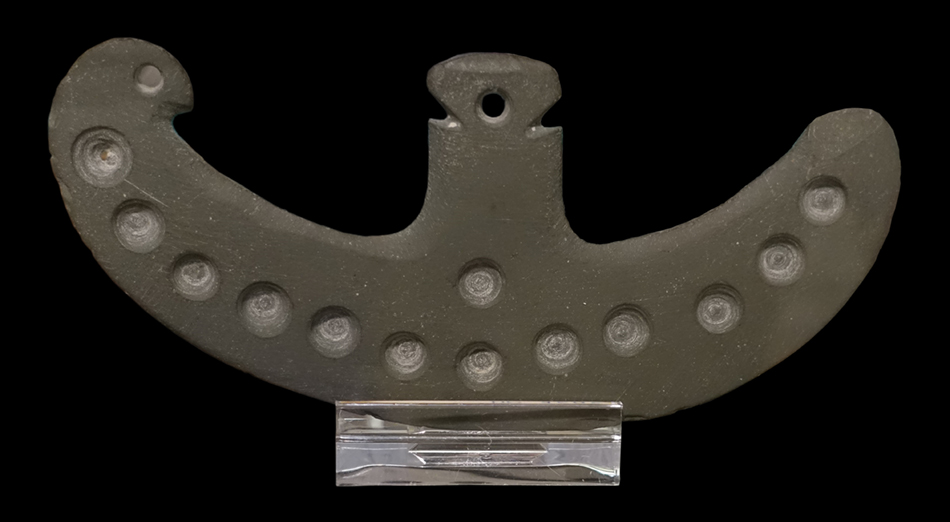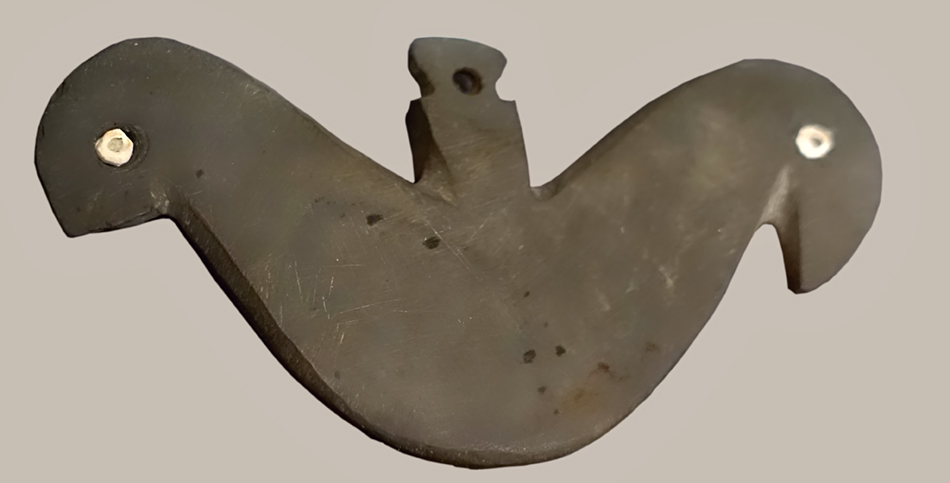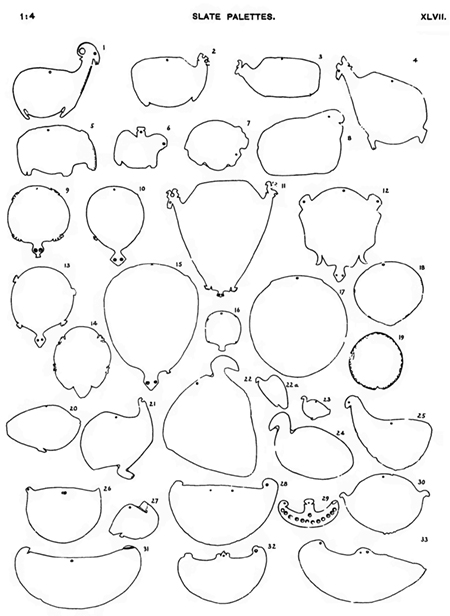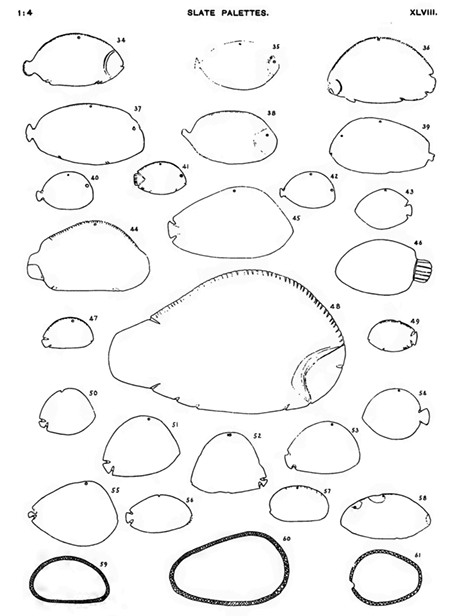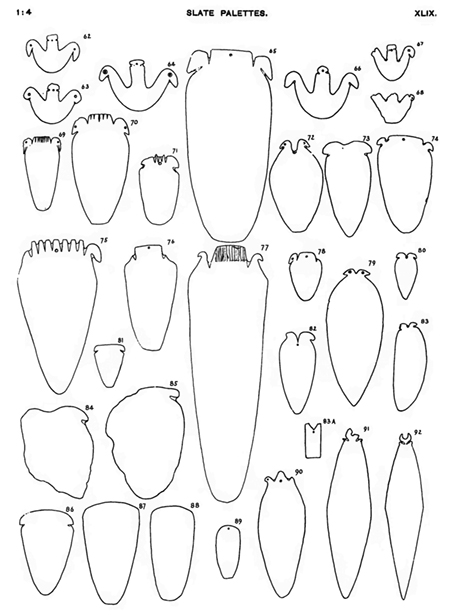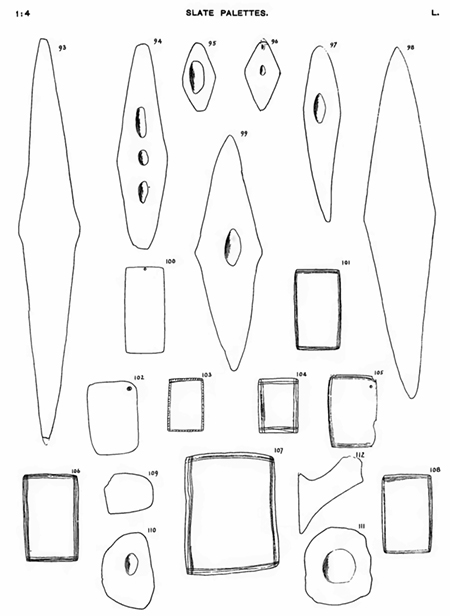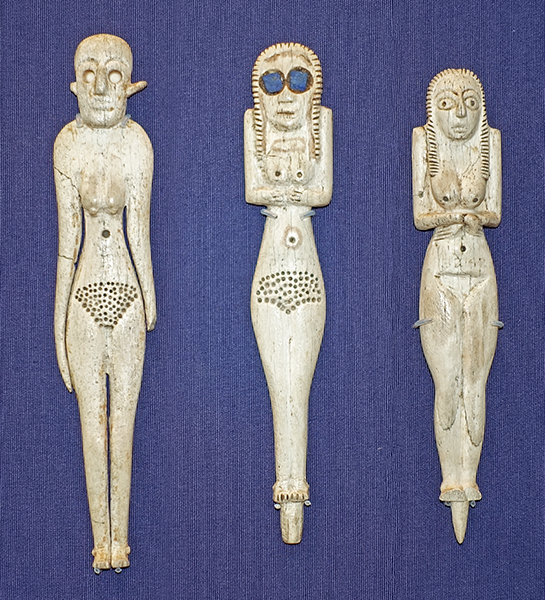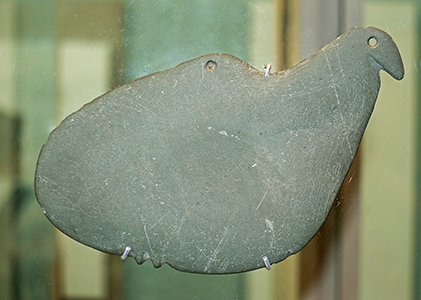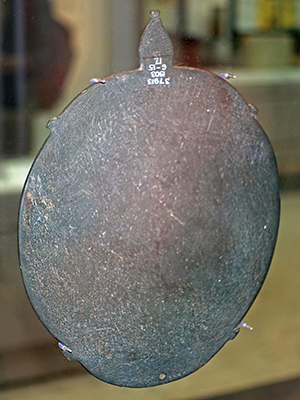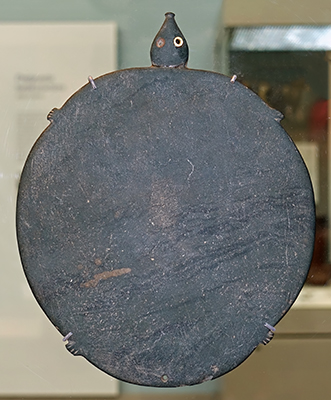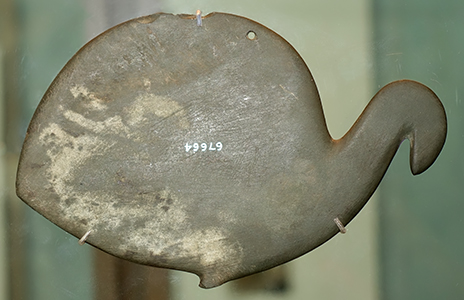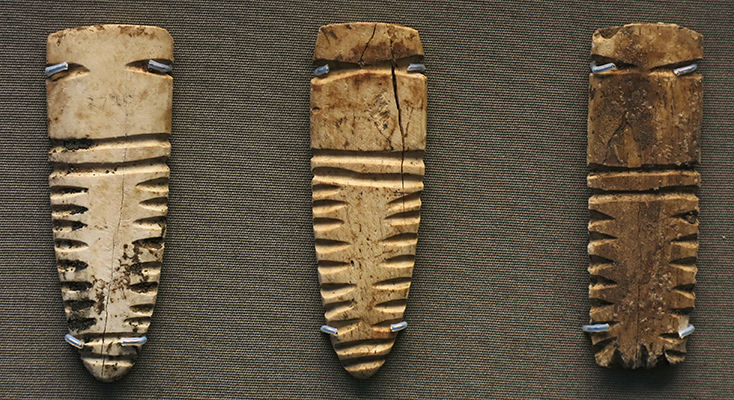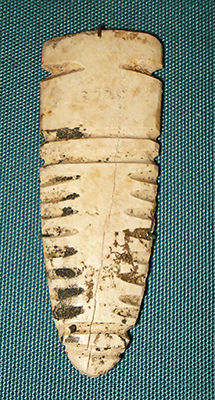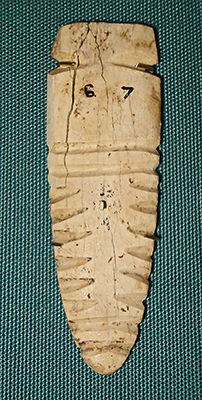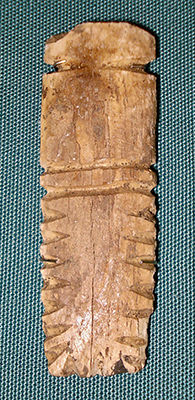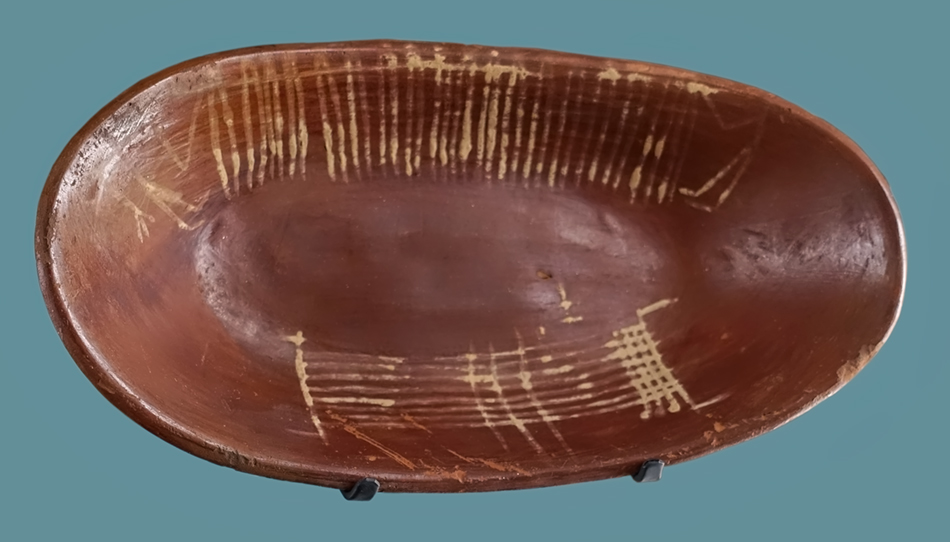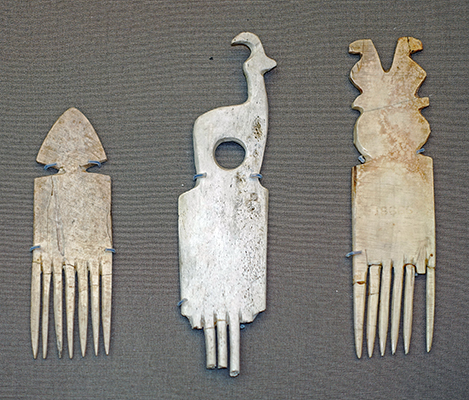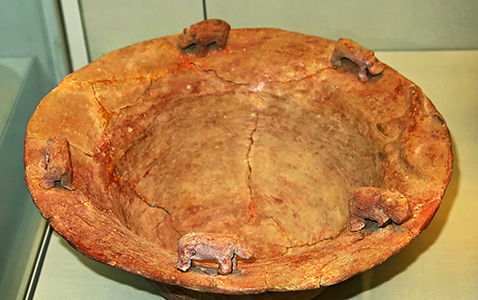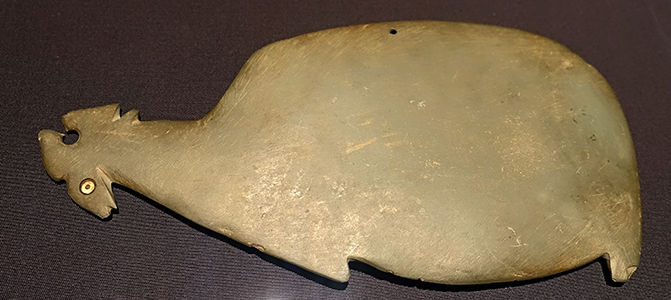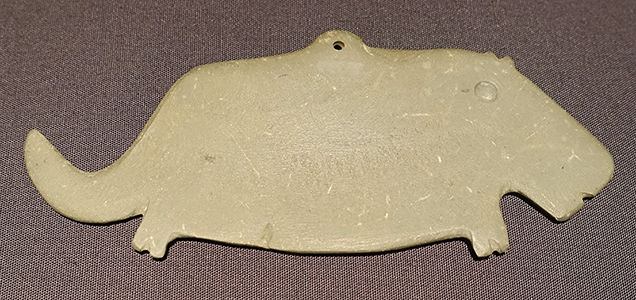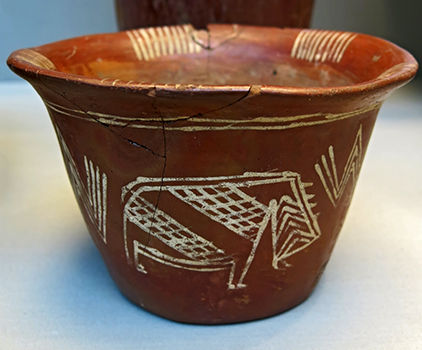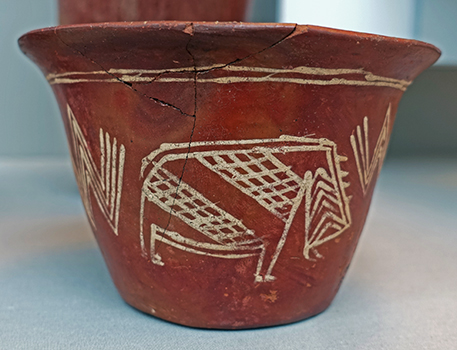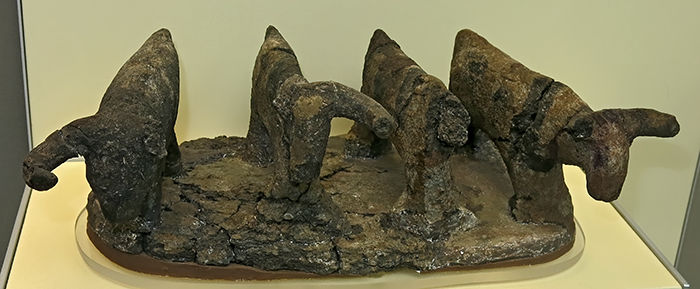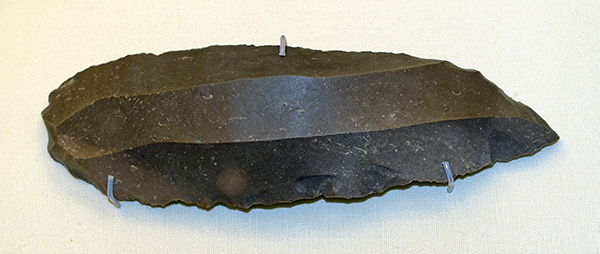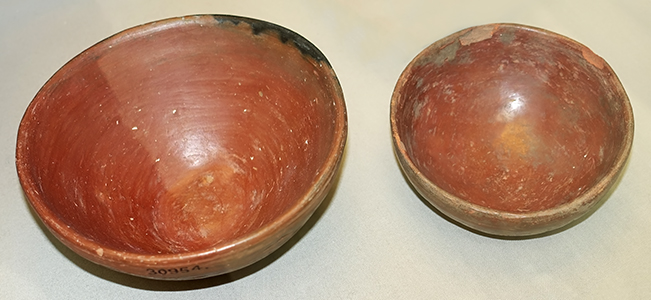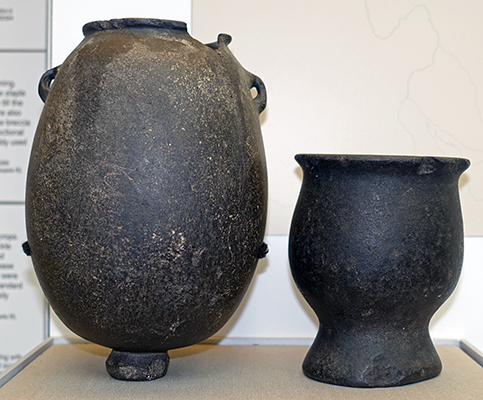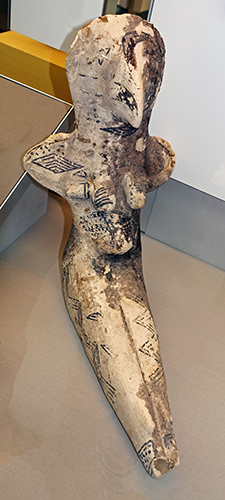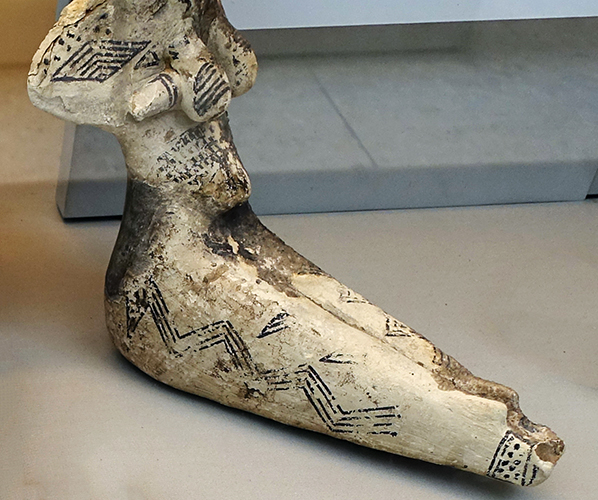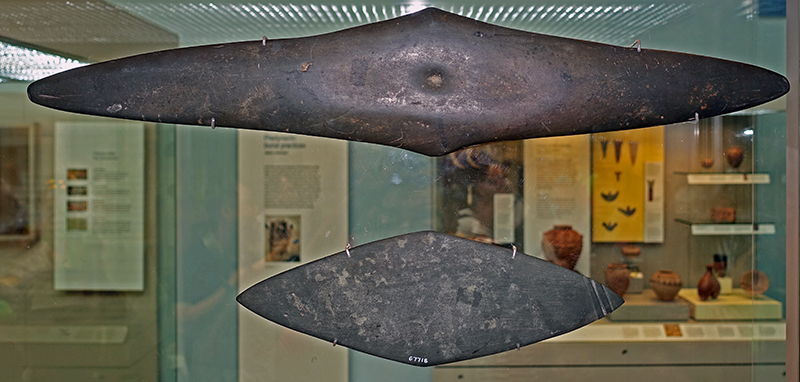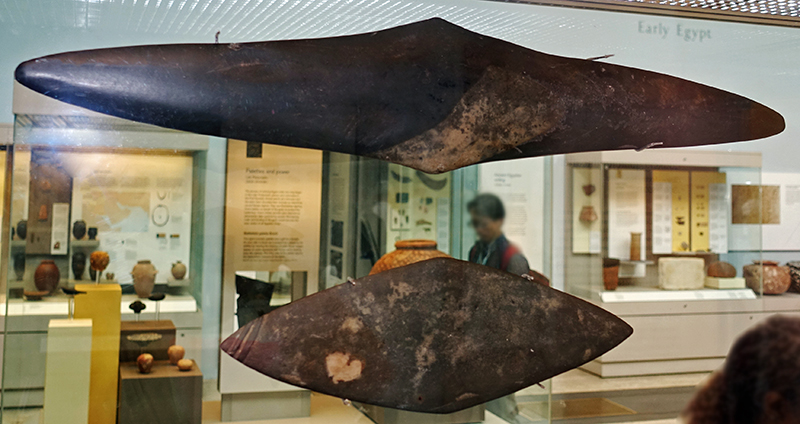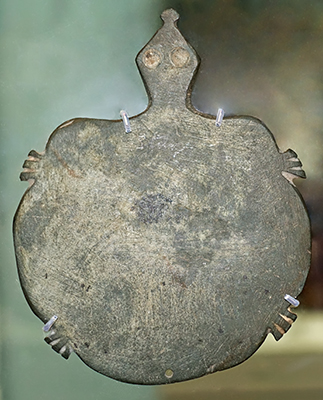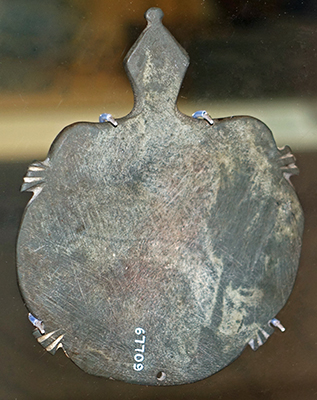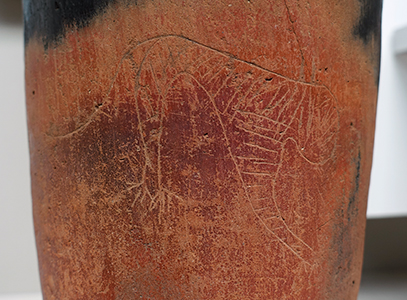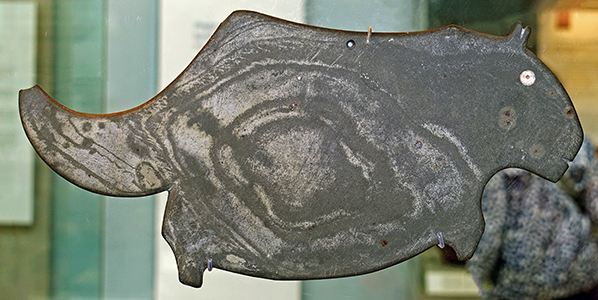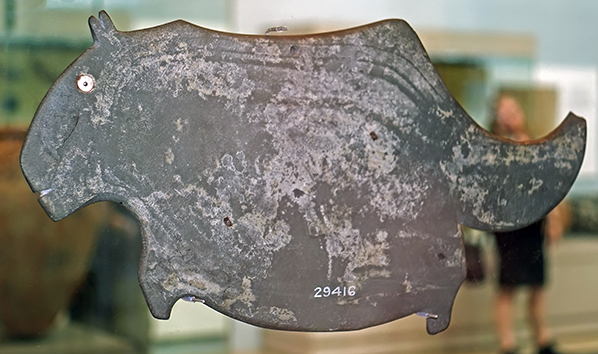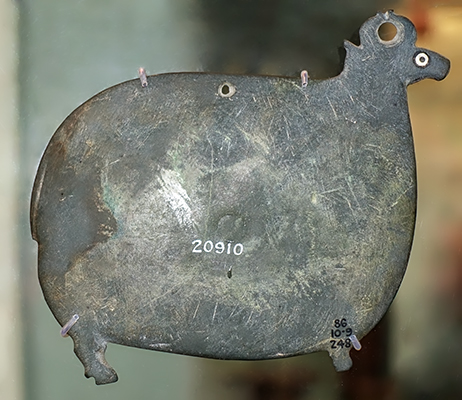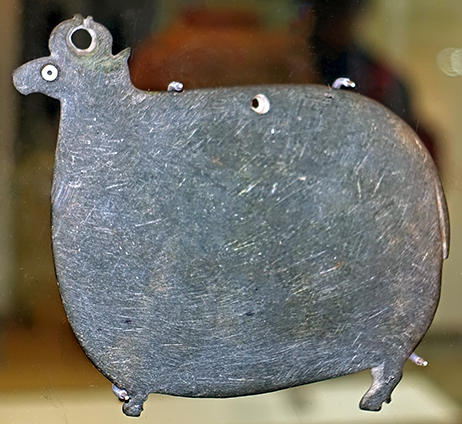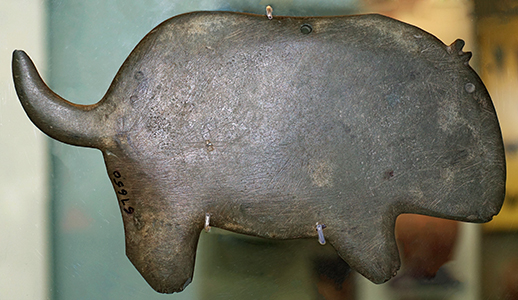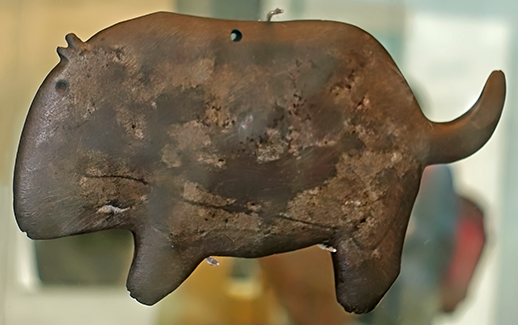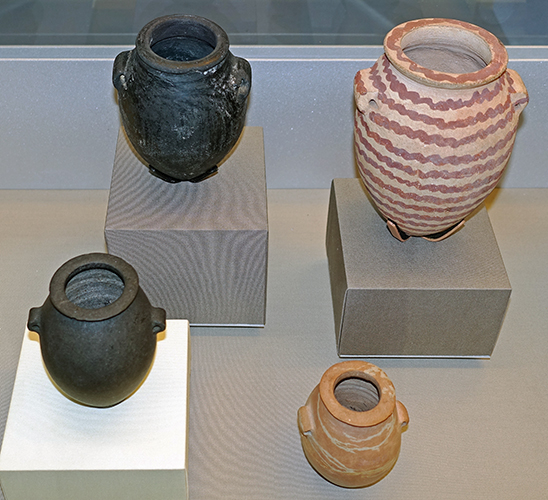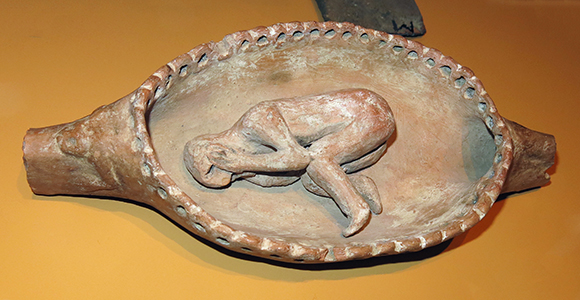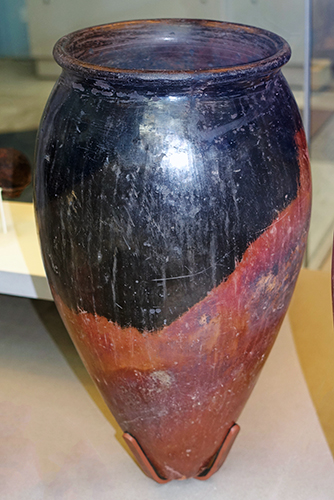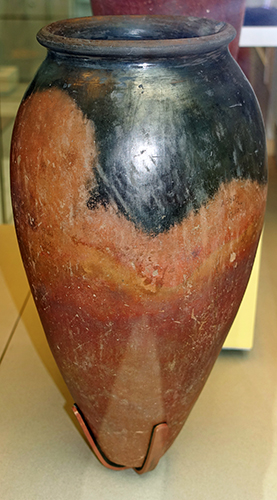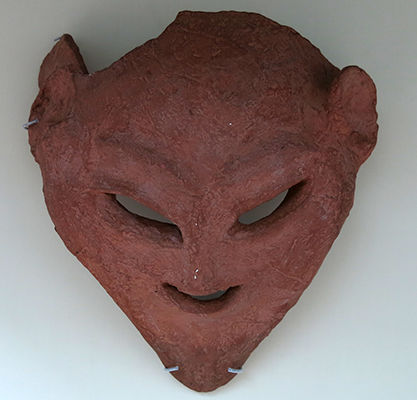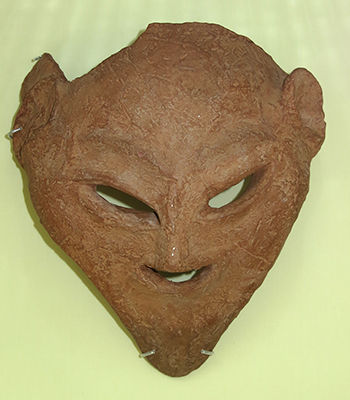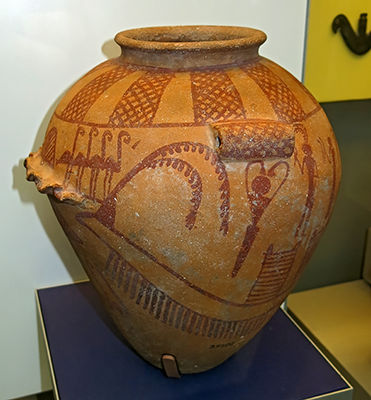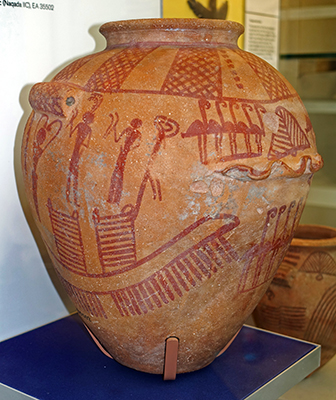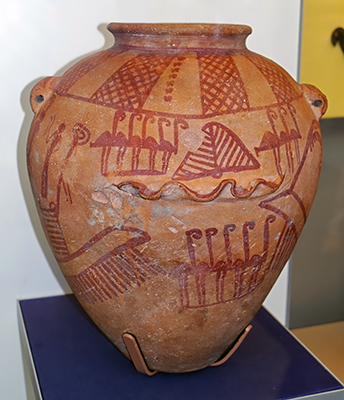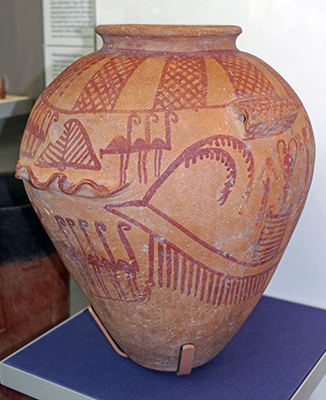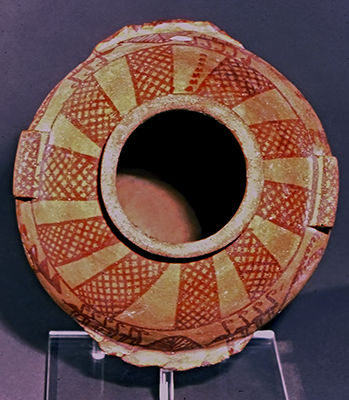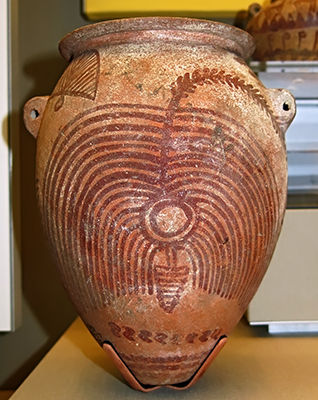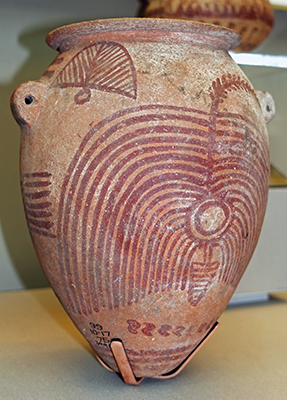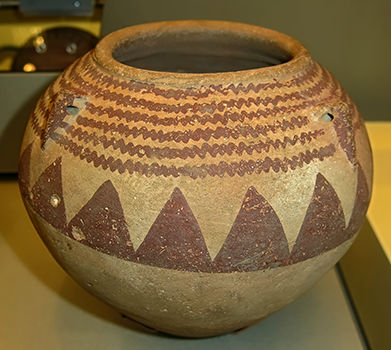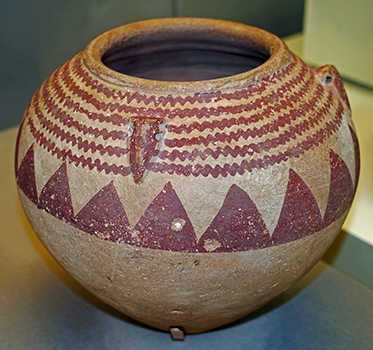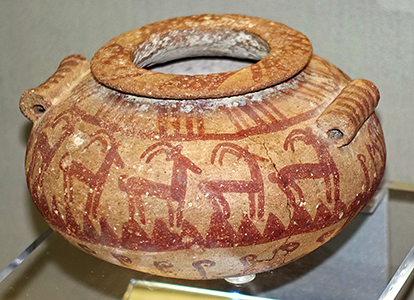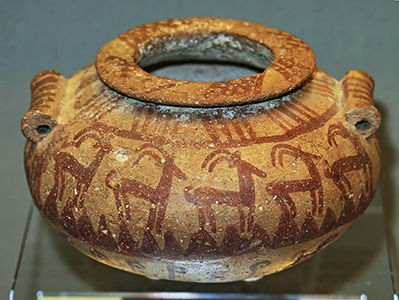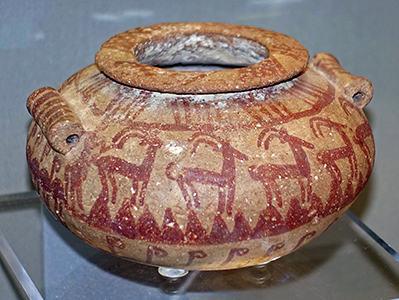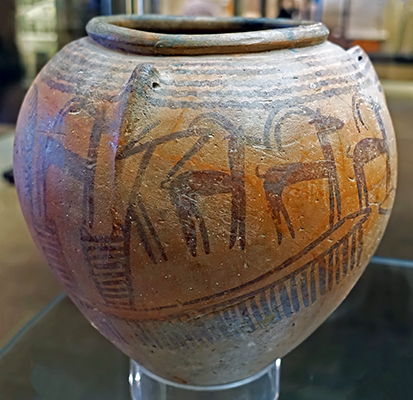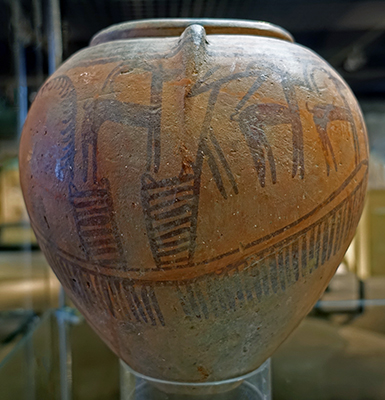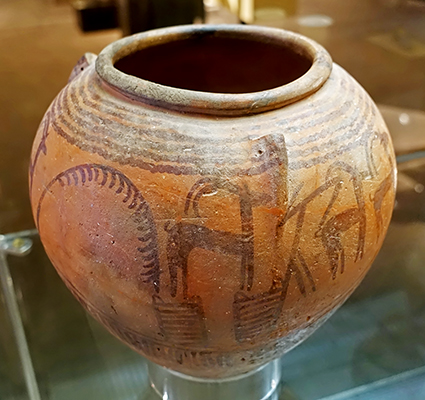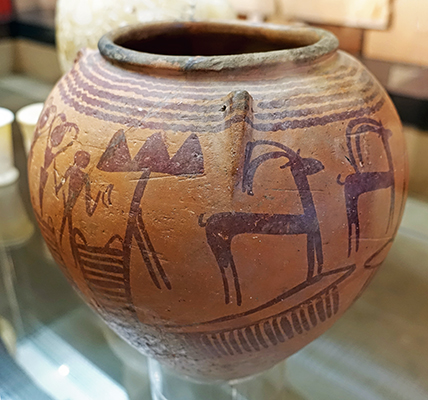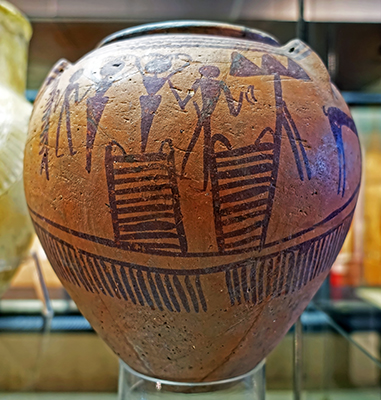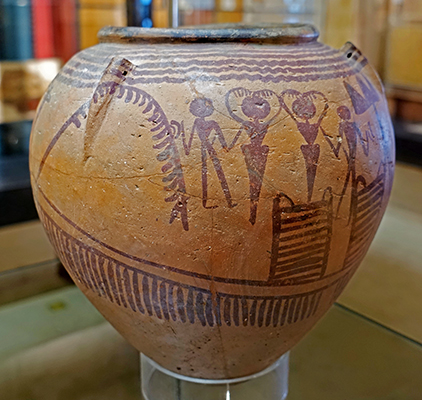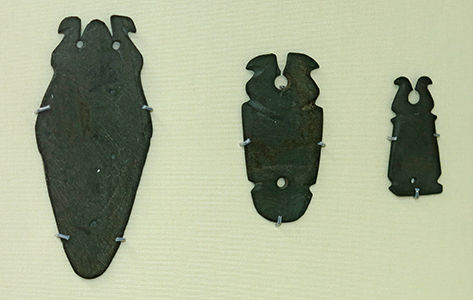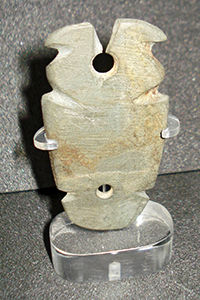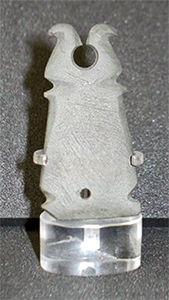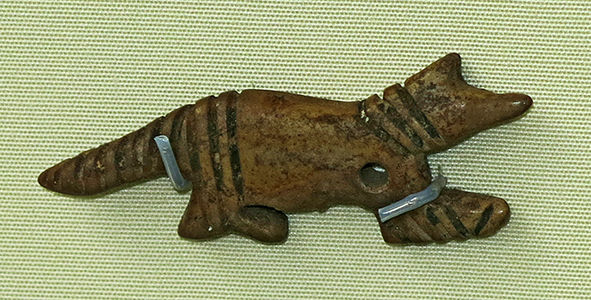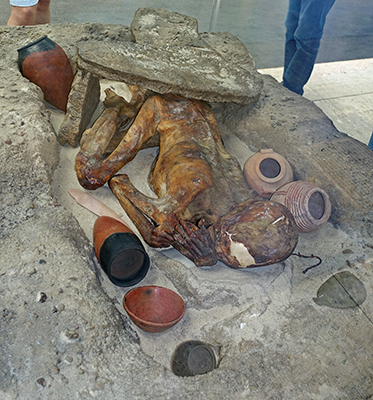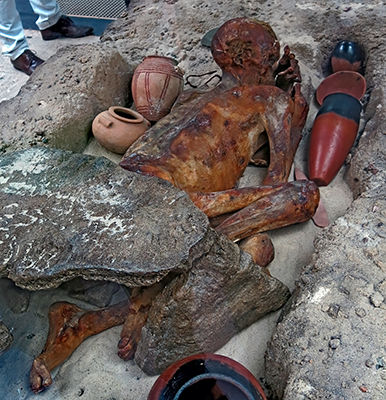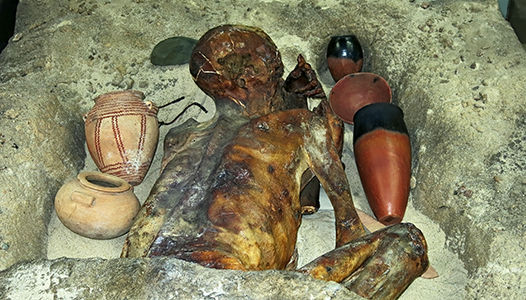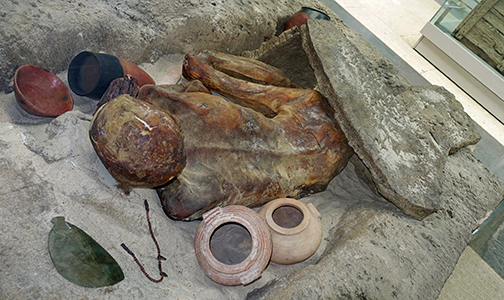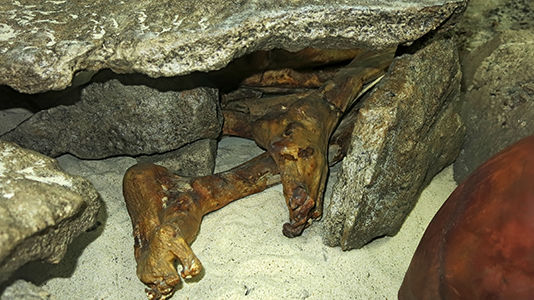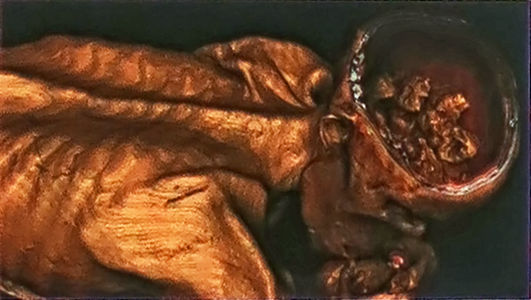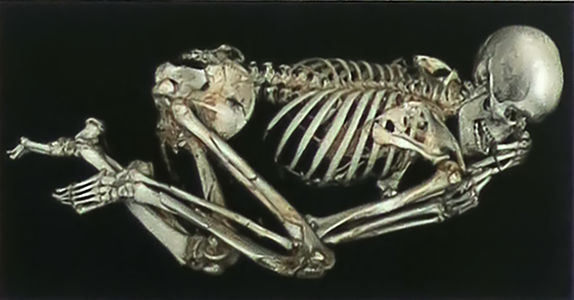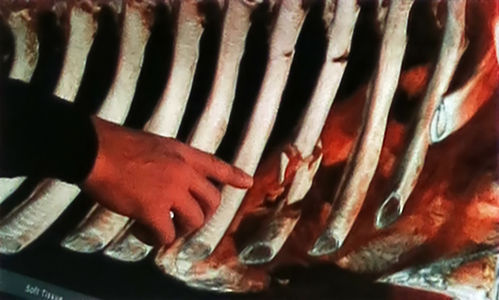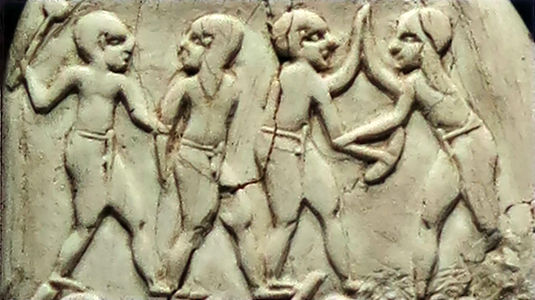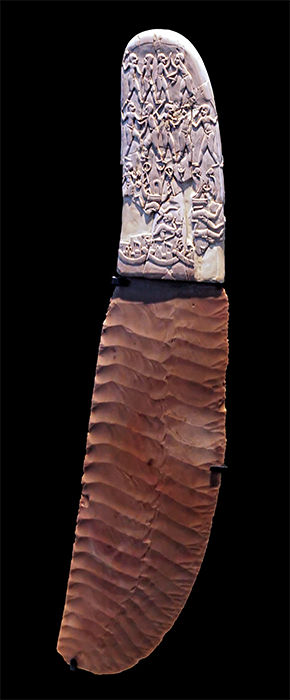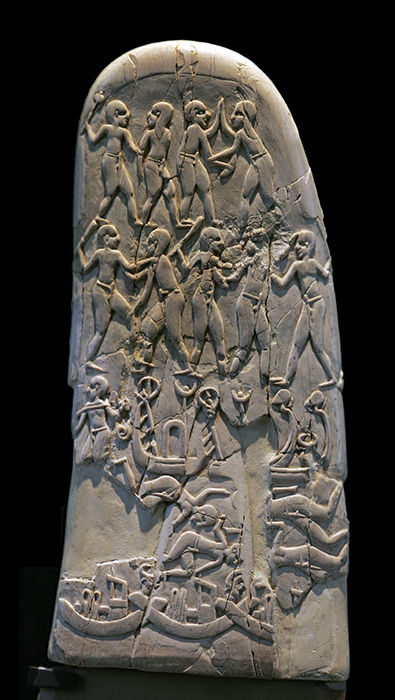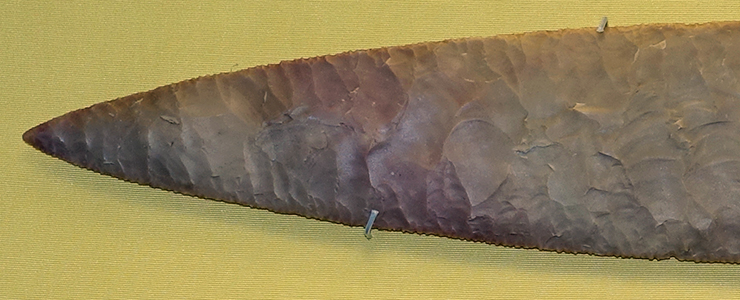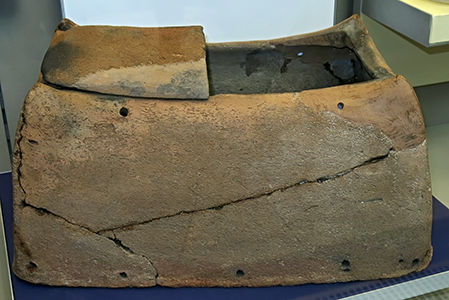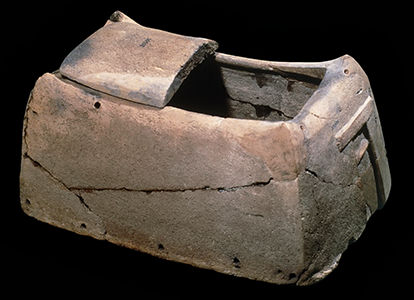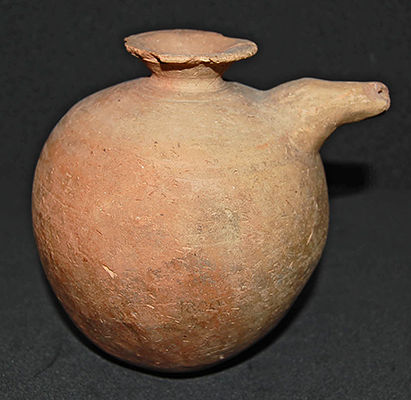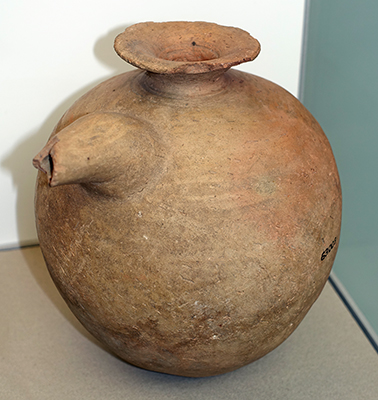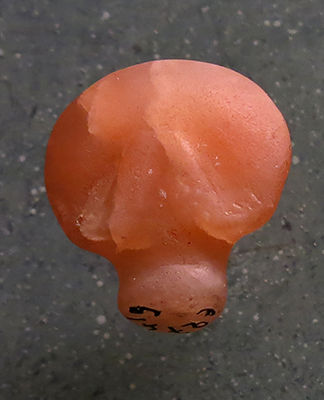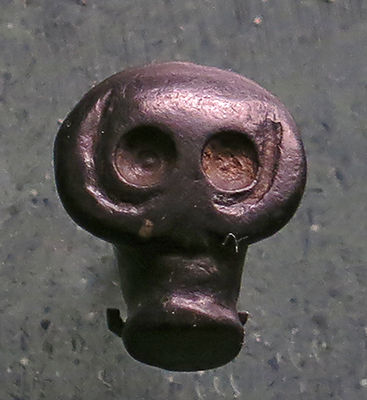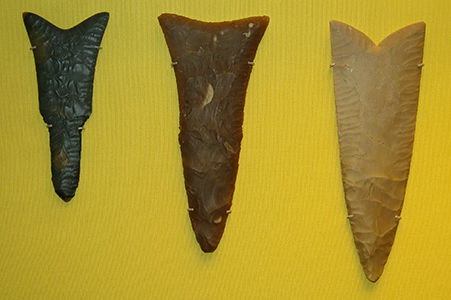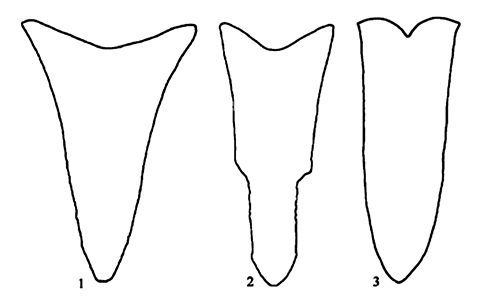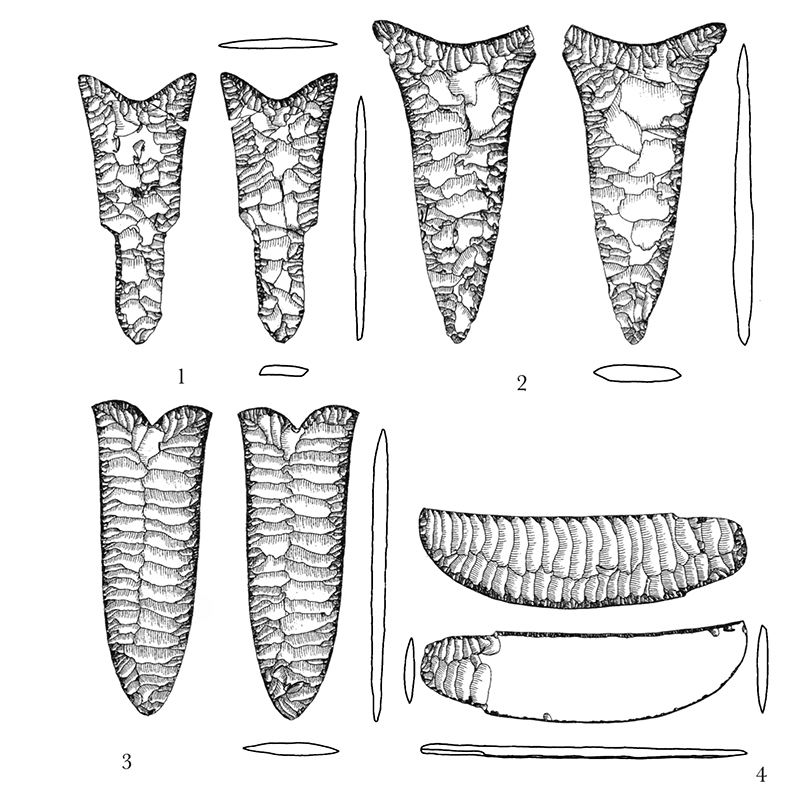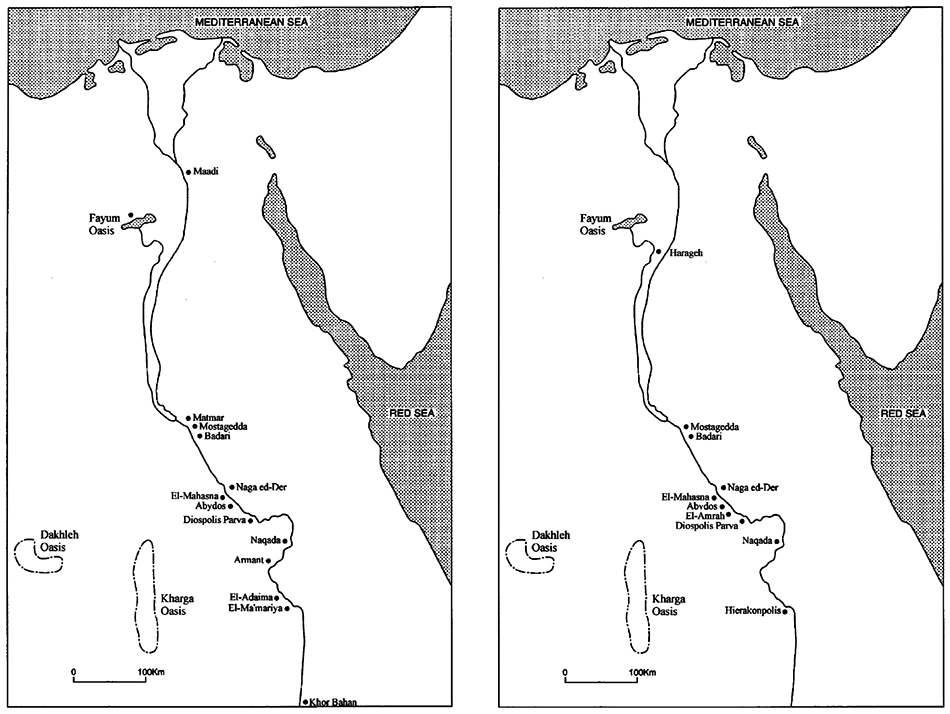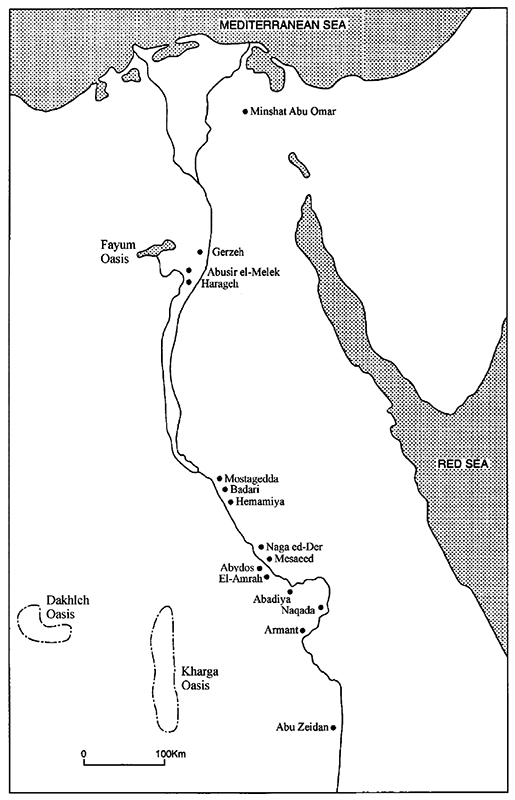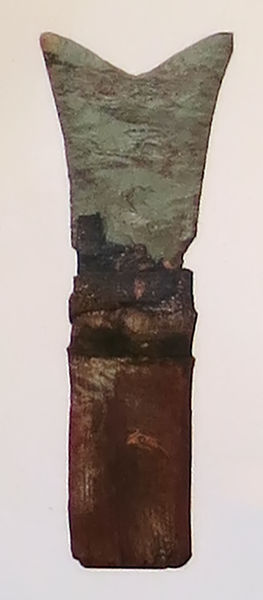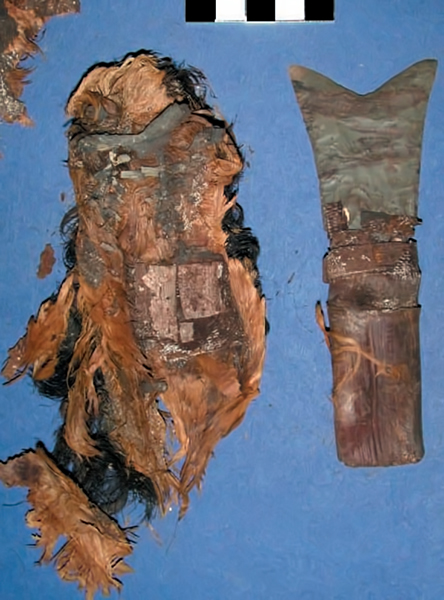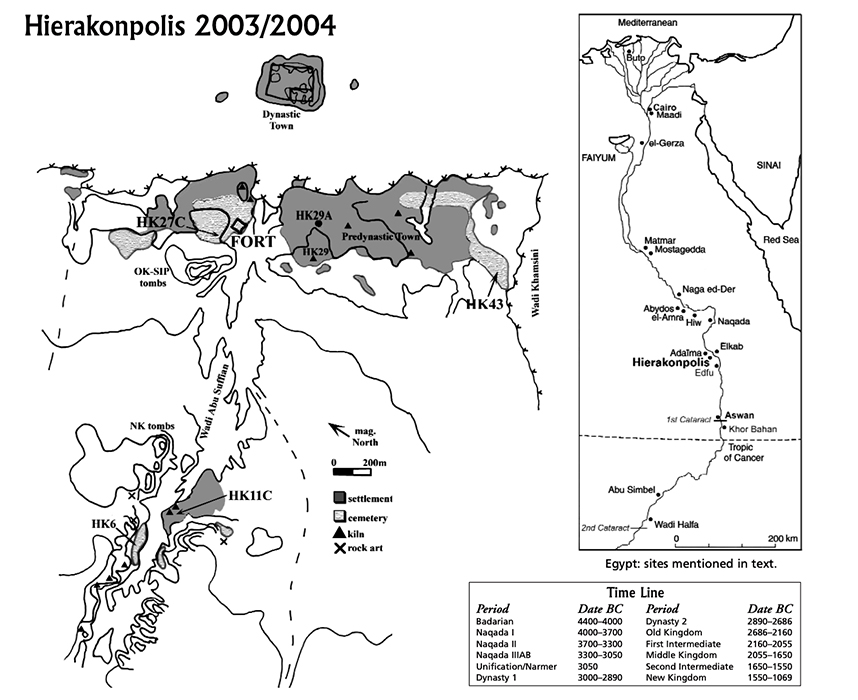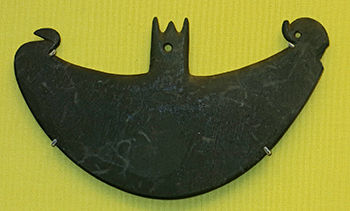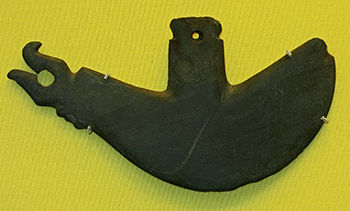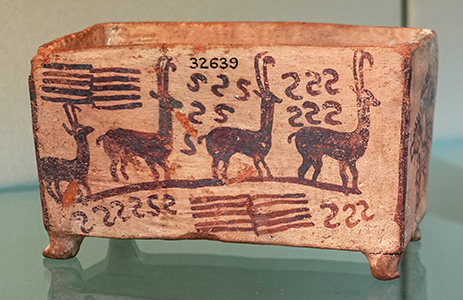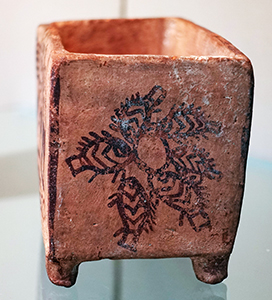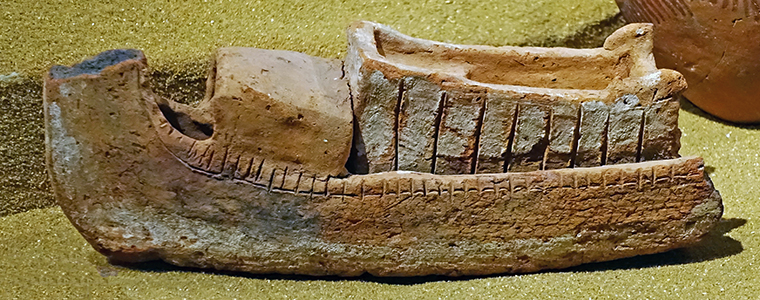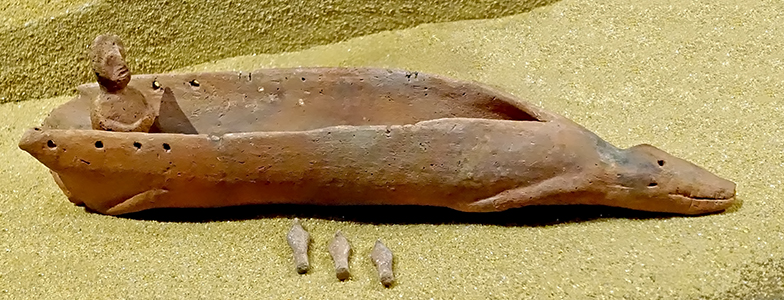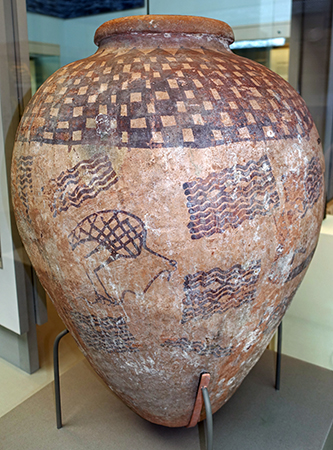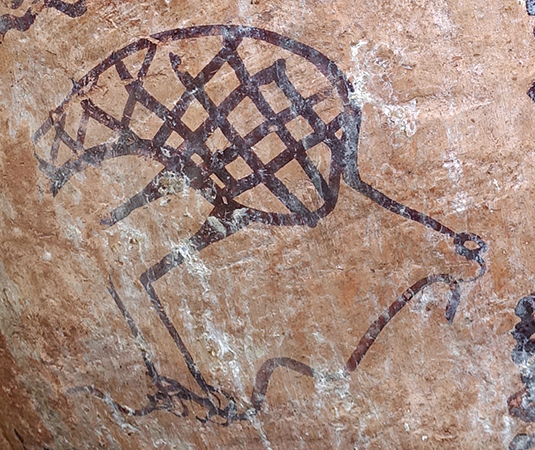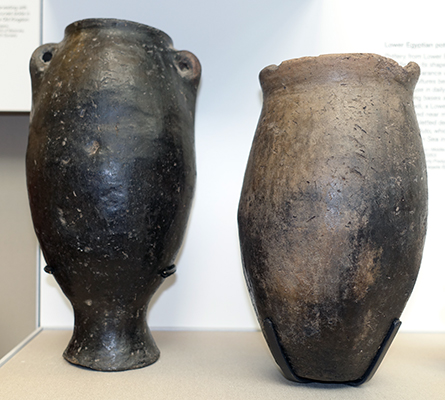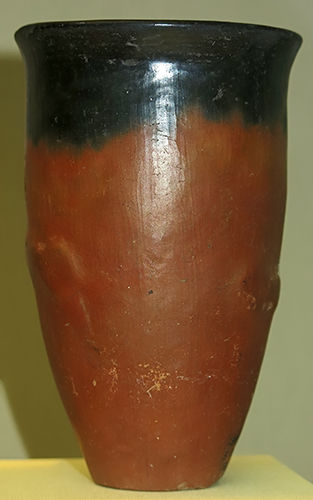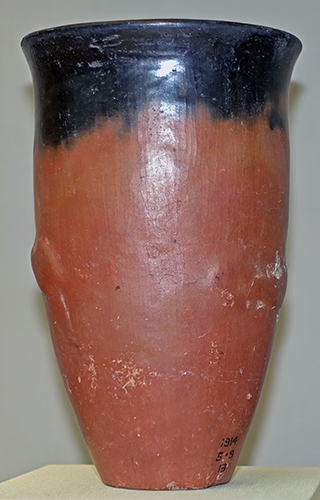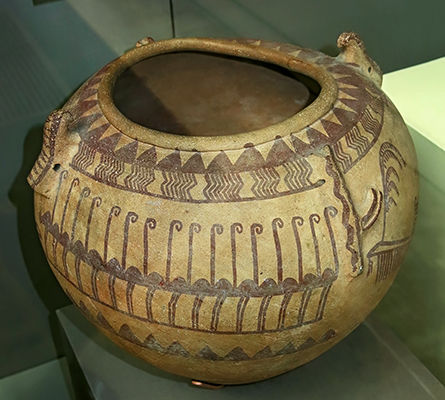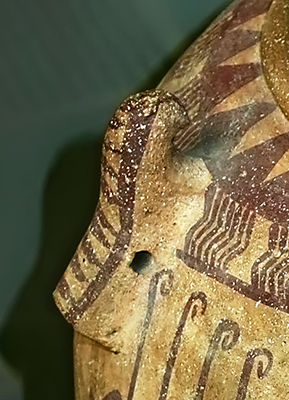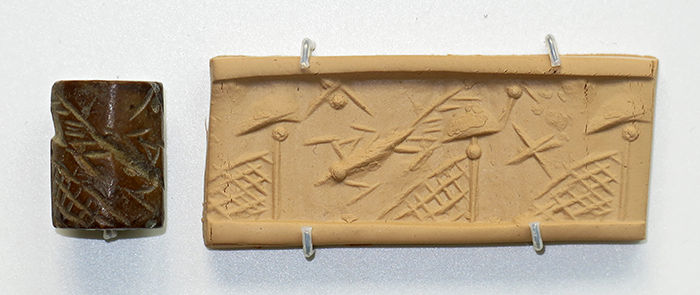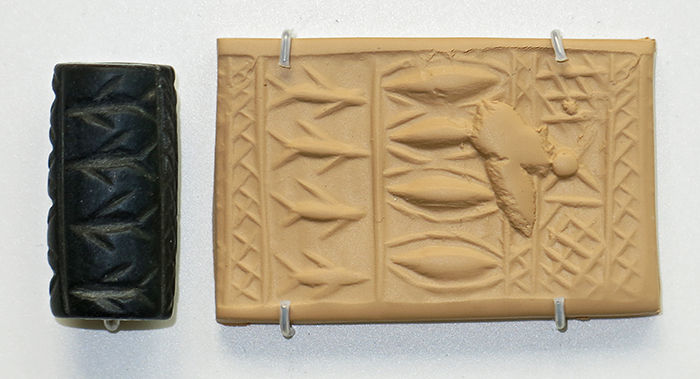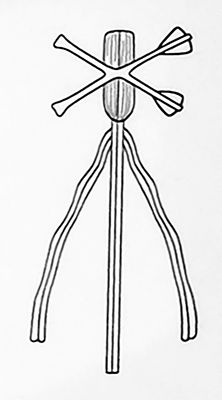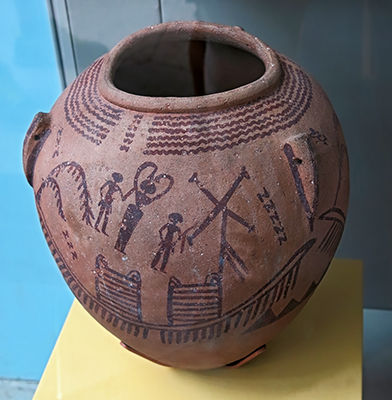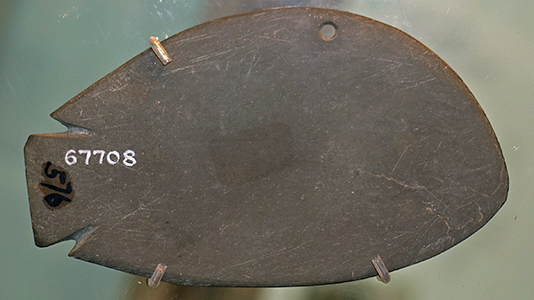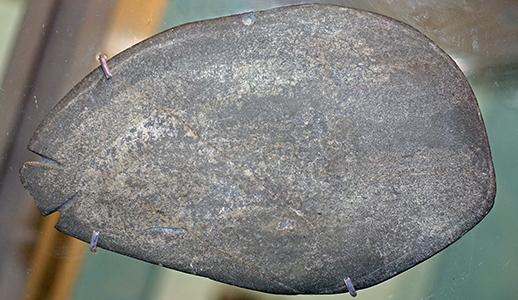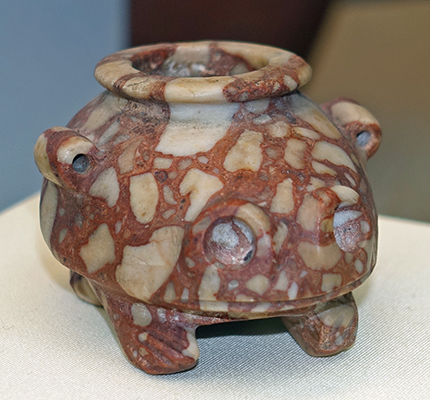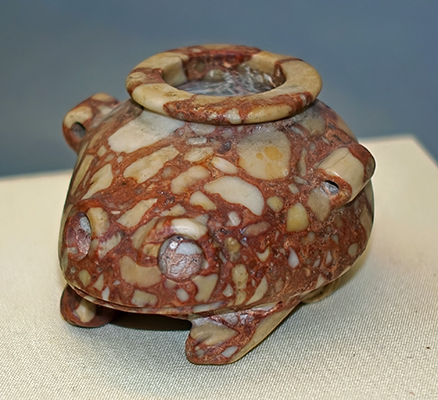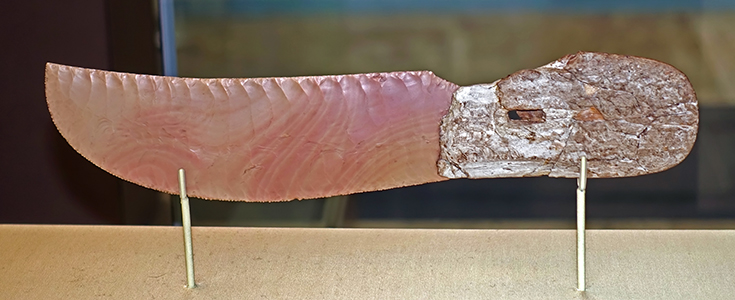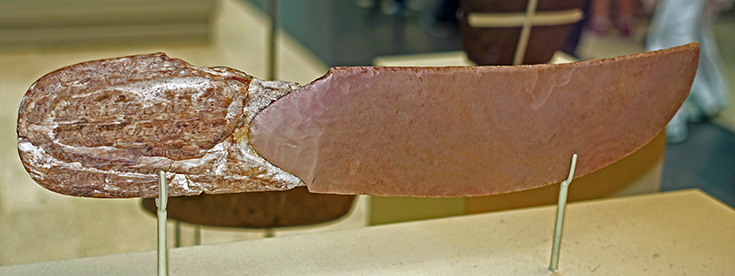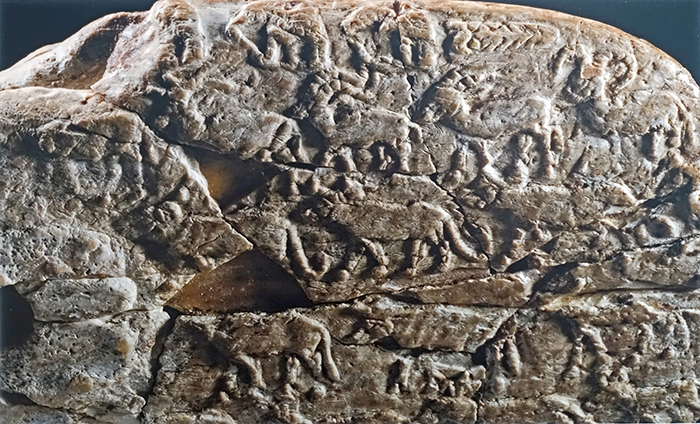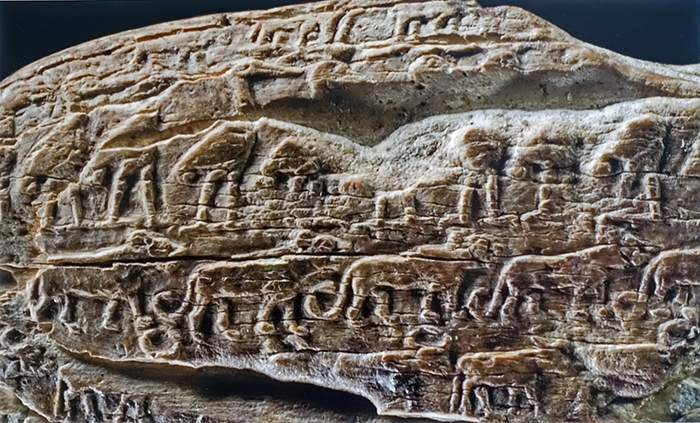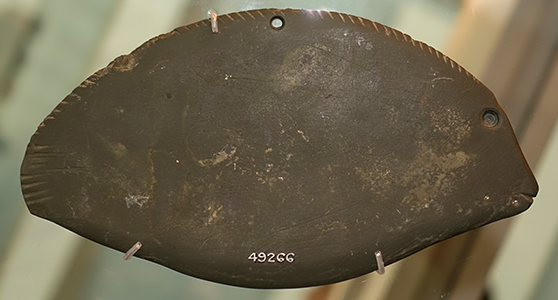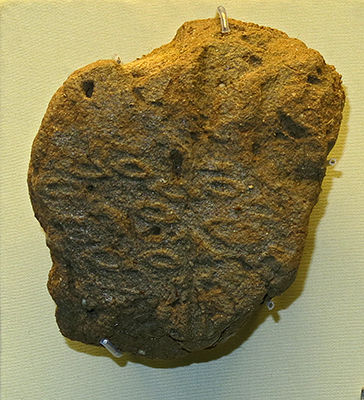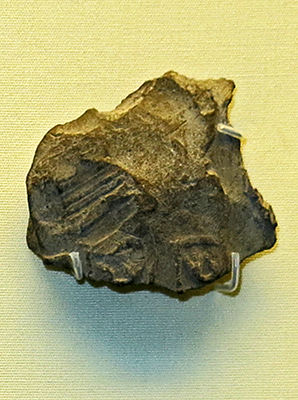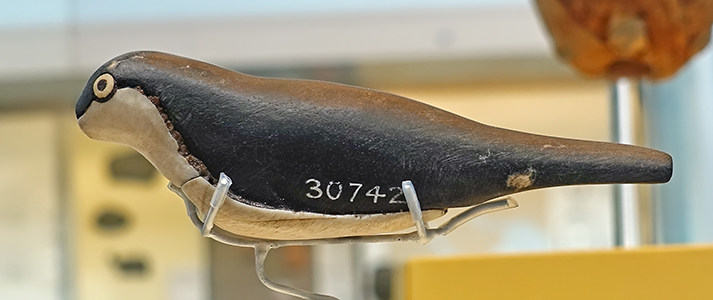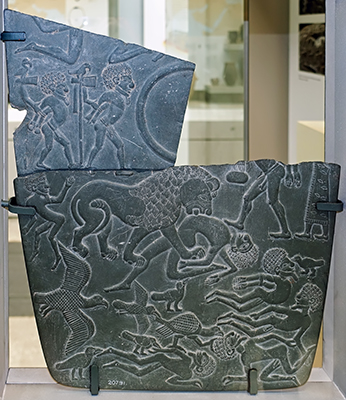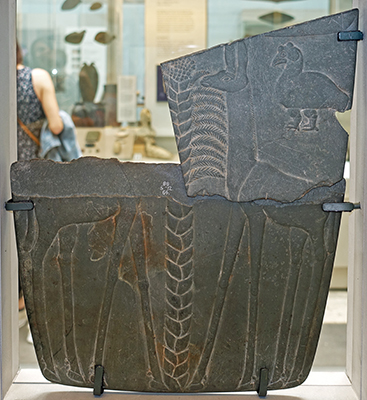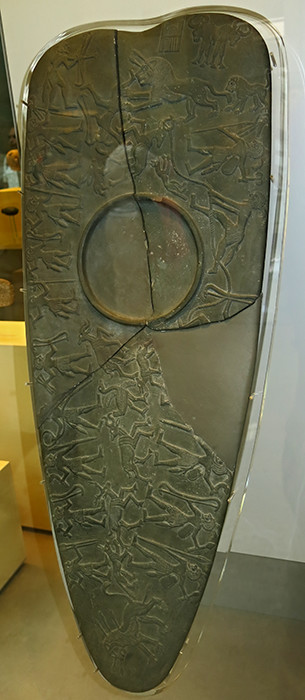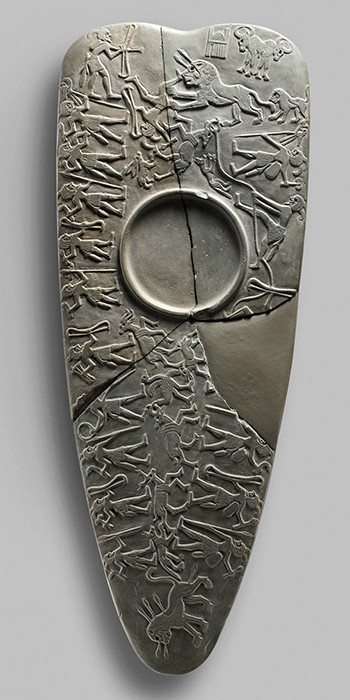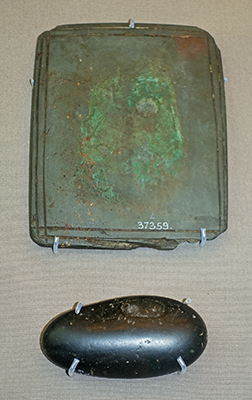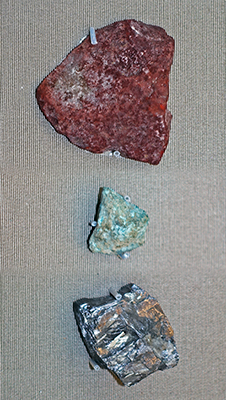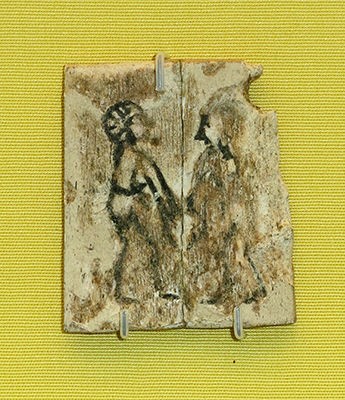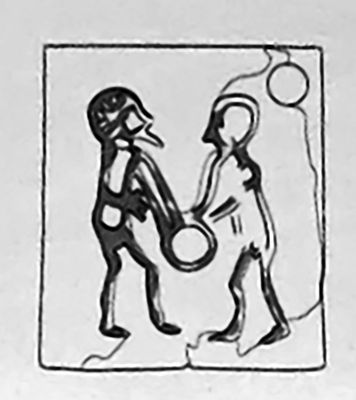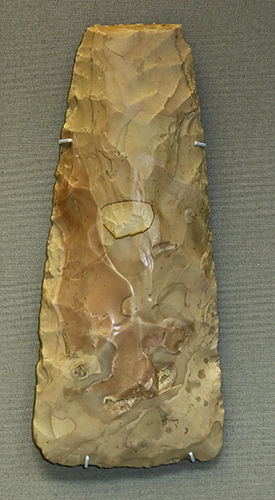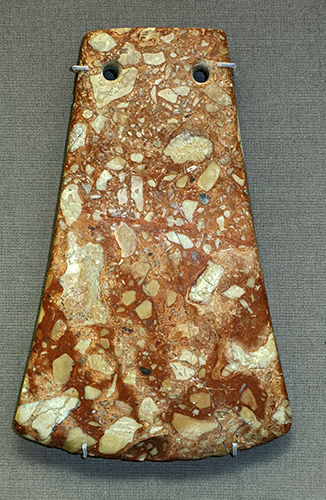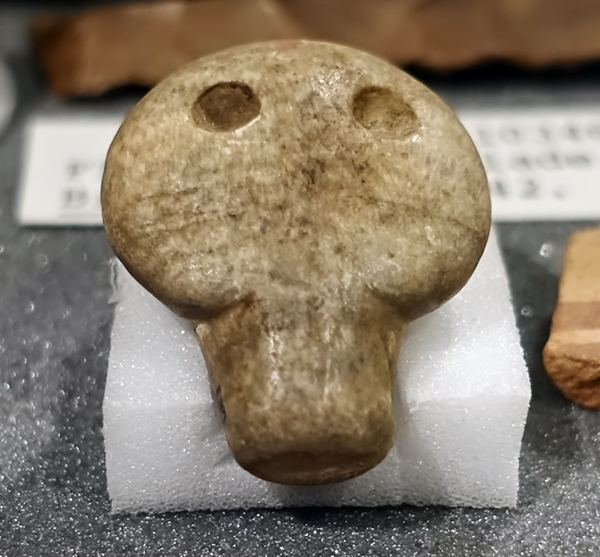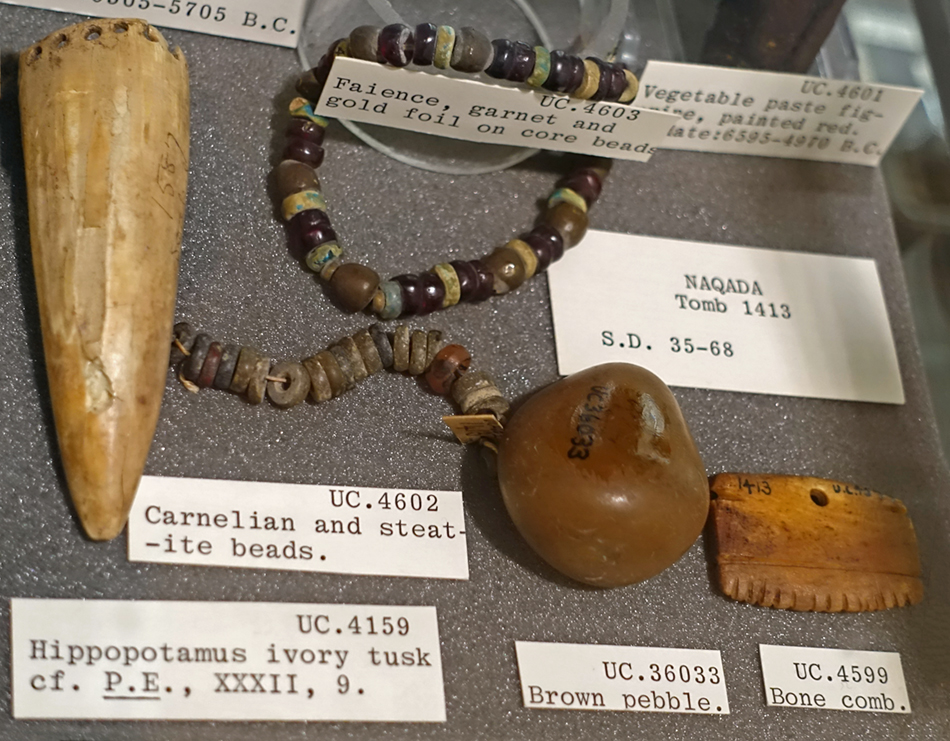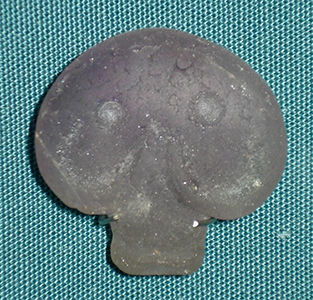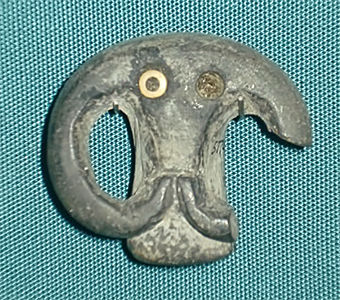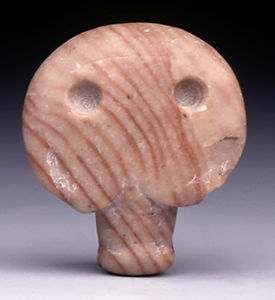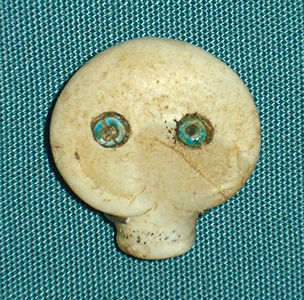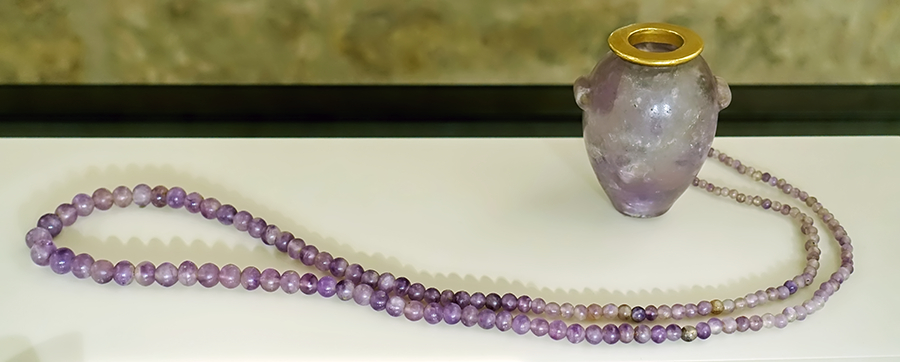Back to Don's Maps
 Back to Archaeological Sites
Back to Archaeological Sites
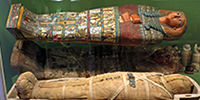 Back to Egypt Index Page
Back to Egypt Index Page
Ancient Egyptian Culture, Mummies, Statues, Burial Practices and Artefacts
The early beginnings of Ancient Egyptian culture to just before the First Dynasty.

In shape Egypt is like a lily with a crooked stem. A broad blossom terminates it at its upper end; a button of a bud projects from the stalk a little below the blossom, on the left-hand side. The broad blossom is the Delta, extending from the mouth of the Nile to Cairo, a direct distance of more than two hundred kilometres.
The bud is the Fayoum, a natural depression in the hills that shut in the Nile valley on the west, which has been rendered reliably cultivable for many thousands of years by the introduction into it of the Nile water, through a canal known as the 'Bahr Yussef'. Before this canal was dug, the Fayoum only filled at times of exceptionally high floods.
The long stalk of the lily is the Nile valley itself, which is a ravine scooped in the rocky soil for 1 100 km from the First Cataract to the apex of the Delta. The Nile's average discharge per day is 300 million cubic metres, and the Nile is usually 8 to 11 metres deep. After Aswan the width is averages 3 km. The widest part of the Nile is at Edfu, where it is 7.5 km wide, and the minimum width is at Silwa Gorge, near Aswan, where it is only 350 metres wide.
No other country in the world is so strangely shaped, so long compared to its width, so straggling, so hard to govern from a single centre. At the first glance, the country seems to divide itself into two strongly contrasted regions; and this was the original impression which it made upon its inhabitants. The natives from a very early time designated their land as 'the two lands,' and represented it by a hieroglyph in which the form used to express 'land' was doubled. The kings were called 'chiefs of the Two Lands,' and wore two crowns, as being kings of two countries.
These 'two Egypts' or 'two lands' were, of course, the blossom and the stalk, the broad tract upon the Mediterranean known as 'Lower Egypt' or 'the Delta' and the long narrow valley that lies, like a green snake, to the south, which bears the name of 'Upper Egypt'. Nothing is more striking than the contrast between these two regions.
Entering Egypt from the Mediterranean, or from Asia by the caravan route, the traveller sees stretching before them an apparently boundless plain, wholly unbroken by natural elevations, generally green with crops or with marshy plants, and canopied by a cloudless sky, which rests everywhere on a distant flat horizon. An absolute monotony surrounds the viewer. No alternation of plain and highland, meadow and forest, no slopes of hills, or hanging woods, or dells, or gorges, or cascades, or rushing streams, or babbling rills, meet their gaze on any side; look which way they will, all is sameness, one vast smooth expanse of rich alluvial soil, varying only in being cultivated or else allowed to lie fallow.
Turning their back with something of weariness on the dull uniformity of this featureless plain, the wayfarer proceeds southwards, and enters, at a distance of 200 km from the coast, on an entirely new scene. Instead of an illimitable prospect meeting him on every side, he finds himself in a comparatively narrow vale, up and down which the eye still commands an extensive view, but where the prospect on either side is blocked at the distance of a few miles by rocky ranges of hills, white or yellow or tawny, sometimes drawing so near as to threaten an obstruction of the river course, sometimes receding so far as to leave some miles of cultivable soil on either side of the stream. The rocky ranges, as he approaches them, have a stern and forbidding aspect.
They rise for the most part, abruptly in bare grandeur; on their craggy sides grows neither moss nor heather; no trees clothe their steep heights. They seem intended to keep in the inhabitants of the vale within their narrow limits, and bar them from any commerce or acquaintance with the regions beyond.
Photo: NASA
Permission: public domain
Text: Adapted from Rawlinson (1886)
Egypt before the humans came
While Europe experienced the last of the ice age, from 20 000 years ago to 10 000 years ago, Egypt (as a direct result of the ice age) experienced extremely arid conditions, and was largely uninhabited.
(left) Grosser Aletschgletscher, view from Eggishorn (2 927 m), in the background Jungfrau (4 158 m), Jungfraujoch (3 454 m), Mönch (4 099 m), Trugberg and Eiger (3 970 m)
(right) Sand dune near 'Areg, Siwa depression, Egypt
Photo (left): Dirk Beyer, permission: GFDL and cc-by-sa-2.5
Photo (right): Roland Ungerr, permission: GNU Free Documentation License, Version 1.2 or any later version
During the latter part of the last ice age, between 20 000 and 10 000 years ago, the eastern Sahara was largely uninhabited, and extremely arid. During the final years of the ice age, intense winds blew across an extremely arid Sahara. Sand dunes stretched from central to northern Sudan. According to optical dates, from seventeen thousand to eleven thousand years ago (15 000 BC to 9 000 BC) the howling wind deposited sand in the region of the Selima Sand Sheet. Dunes formed at Nabta Playa, the Great Sand Sea, and Wadi Bakht in the Gilf Kebir. As a result, the environment changed drastically. River system were eradicated and the wind scoured out hollows in the land. However, at the end of the ice age, archaeological and geological evidence suggests wetter conditions began to prevail.
As the climate grew more humid around 8 000 BC, rainfall turned low-lying areas into lakes and playas. With the onset of this 'Neolithic pluvial', the region we now know as Egypt became an extension of the Sahelian savanna. The area offered pastoralists and animals new habitable lands. The area received a minimum of 280 mm (11 inches) of rain per year, and possibly as much as 610 mm (24 inches). Between 7 000 BC and 4 000 BC, when the leading edge of monsoon rains covered a significant portion of Africa's interior, a 'pluvial maximum' - when rainfall was at its peak - developed, turning the desert green with life.
Some records indicate that the onset of rains began at Bir Kiseiba around 10 000 BC, but in many other areas, including Abu Ballas in south-central Egypt, they came a thousand years later. Nonetheless, by 7 500 BC, rising water tables were able to support lakes in the Sudan. The Nile-fed lake of Birket Qarun rose during this period, and in southern Egypt basins filled with rainwater. Radiocarbon dated charcoal from prehistoric campfires attests to the increasing humidity and cooling temperatures.
By 7 300 BC, the Wadi Howar was active in northern Sudan and flowed into the Nile River. Near Gebel Rahib, conditions sustained cool, freshwater lakes with a depth of twelve to thirty feet. Nabta Playa also experienced a wet climate before 7 400 BC. Mud accumulated along the Wadi Tushka and at other locations in the Great Sand Sea south of Siwa. By 7 100 BC, springs and artesian lakes existed in Kharga and Dahkla.
Text above: Malkowski (2010)
Egyptian Chronology
| Egyptian Chronology | ||
|---|---|---|
| Date | Culture | Duration |
| 11 000 BC | Jebel Sahaba | |
| Before 8 000 BC - Palaeolithic in Europe and Northern Asia | ||
| 8 000 BC - Nominal end of the Ice Age | ||
| 8 600 - 4 400 BC | Nabta Playa Neolithic | 4 200 years |
| 6 100 - 5 180 BC | Qarunian (formerly known as Fayum B) | 920 years |
| 5 200 - 4 200 BC | Fayum A | 1 000 years |
| 4 800 - 4 200 BC | Merimde | 600 years |
| 4 600 - 4 400 BC | El Omari | 200 years |
| 4 400 - 4 000 BC | Badarian | 400 years |
| 4 000 - 3 300 BC | Maadi | 700 years |
| 3 900 - 3 650 BC | Naqada I | 250 years |
| 3 650 - 3 300 BC | Naqada II | 350 years |
| 3 300 - 2 900 BC | Naqada III | 400 years |
| 3 100 - 2 670 BC | Early Dynastic | 430 years |
| 2 670 - 2 181 BC | Old Kingdom | 489 years |
| 2 181 - 2 025 BC | First Intermediate Period | 156 years |
| 2 025 - 1 700 BC | Middle Kingdom | 325 years |
| 1 700 - 1 550 BC | Second Intermediate Period | 150 years |
| 1 550 - 1 077 BC | New Kingdom | 473 years |
| 1 077 - 664 BC | Third Intermediate Period | 413 years |
| 664 - 332 BC | Late Period | 332 years |
| 525 - 404 BC | First Persian Period | 121 years |
| 404 - 343 BC | Late Dynastic Period | 61 years |
| 343 - 332 BC | Second Persian Period | 11 years |
| 332 - 305 BC | Macedonian Period | 27 years |
| 305 - 30 BC | Ptolemaic Period | 275 years |
| 30 BC - 395 AD | Roman Period | 425 years |
| 395 AD - 640 AD | Byzantine Period | 245 years |
| 640 AD - 1517 AD | Islamic Period | 877 years |
| 1517 AD - 1867 AD | Ottoman Period (French Occupation 1798-1801) |
350 years |
| 1867 AD - 1914 AD | Khedival Period | 47 years |
| 1914 AD - 1922 AD | Sultanate under Hussein Kamel, as a British Protectorate |
8 years |
| 1922 AD - 1953 AD | Monarchy | 31 years |
| 1953 AD - Present Day | Republic | |
The vast majority of Predynastic archaeological finds have been in Upper Egypt, because the silt of the Nile River was more heavily deposited at the Delta region, completely burying most Delta sites long before modern times.Text above: Wikipedia
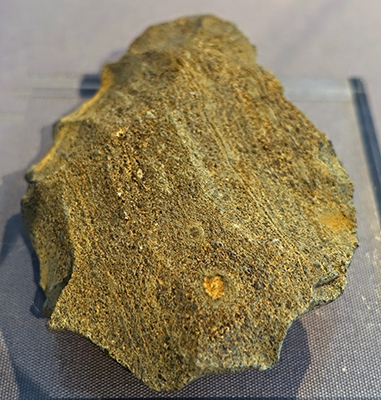
1 400 000 BC - 200 000 BC
Faustkeil, Handaxe
This hand axe is of Acheulian culture, and is the oldest piece in the August Kestner Museum in Hannover.
( It appears to be of a material similar to silcrete, and is a coarse grained example with bedding lines and inclusions, only suitable for crudely made large tools such as this handaxe or chopping tool. - Don )
Catalog: Eastern Sahara / Bayuda desert in present day Sudan
Photo: Don Hitchcock 2018
Source and text: Original, Museum August Kestner, Hannover
Retouched flint flake, handaxe?, Abydos
Age 400 000 BP - 350 000 BP.
Length 98 mm, width 63 mm.
Accession Number LDUCE-UC75136
Photo: Don Hitchcock 2015
Source: Original, Petrie Museum, London, England
Text: Card / online catalogue, the Petrie Museum, © 2015 UCL. CC BY-NC-SA license.
Flint handaxe, Acheulean; with cortex butt. From El Amrah, Nile level.
Age 400 000 BP - 350 000 BP.
Length: 135 mm
Accession Number LDUCE-UC13575
Photo: Don Hitchcock 2015
Source: Original, Petrie Museum, London, England
Text: Card / online catalogue, the Petrie Museum, © 2015 UCL. CC BY-NC-SA license.
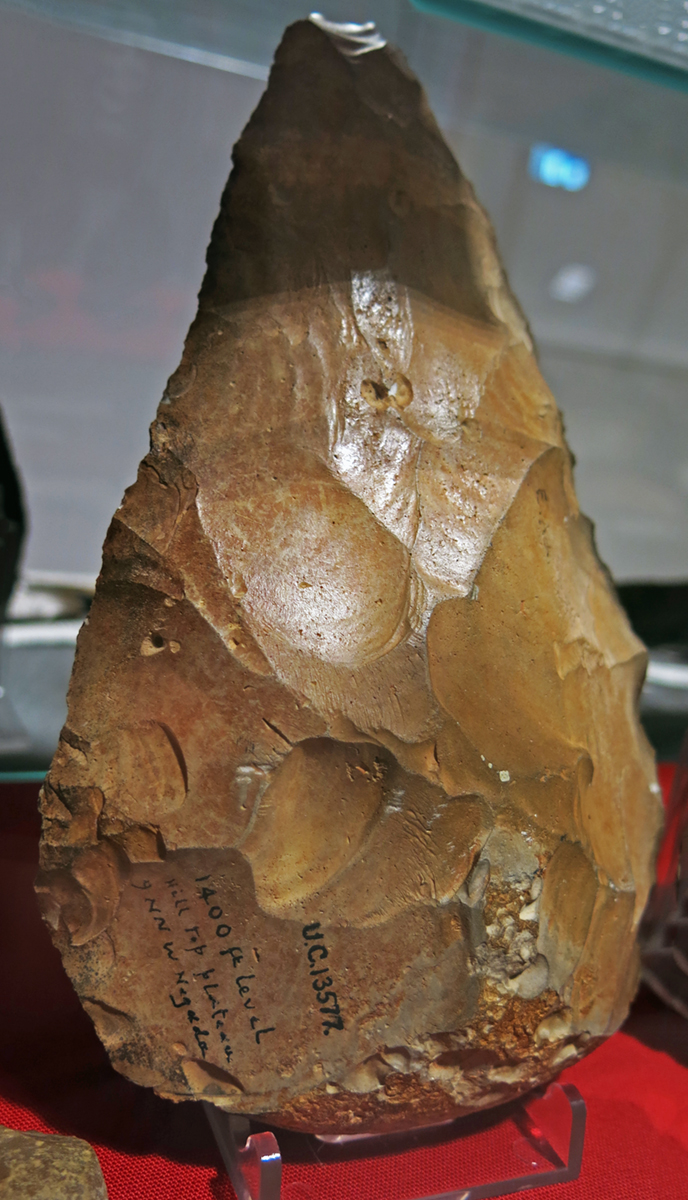
Acheulian Handaxe
(Acheulian - Old Palaeolithic : about 1800 000 BC - 200 000 BC; typical are large bifacially flaked handaxes, picks and cleavers; people lived as gatherers of wild plants and scavengers/hunters of animals)
Age of this specimen 400 000 BP - 350 000 BP.
Flint handaxe, developed Acheulean, with cortex butt. Found 9 miles NNW of Naqada at 1400 ft above sea-level, on a hill-top plateau.
Lanceolate bifaces like this one are the most aesthetically pleasing and became the typical image of developed Acheulean bifaces. Their name is due to their similar shape to the blade of a lance. Bordes defined a lanceolate biface as elongated (l/m > 1.6 , i.e. maximum length / maximum width > 1.6) with rectilinear or slightly convex edges, acute apex and rounded base, 2.75 < l/a < 3.75. L/a is maximum length / distance from point of maximum width to base and expresses the position of maximum width in relation to the length.
They are often globular to the extent that it is not a flat surface, at least in its basal zone, with m/e < 2.35 , m/e meaning the ratio of maximum width / maximum thickness and expresses the thickness relative to width, or 'refinement' of the axe.
They are usually balanced and well finished, with straightened edges. They are highly characteristic of the latter stages of the Acheulean – or the Micoquian, as it is known – and of the Mousterian in the Acheulean Tradition (closely related to the Micoquian bifaces).
Length 174 mm
Accession Number LDUCE-UC13577
Photo: Don Hitchcock 2015
Source: Original, Petrie Museum, London, England
Text: Card / online catalogue, the Petrie Museum, © 2015 UCL. CC BY-NC-SA license.
Flint handaxe, developed Acheulean, with cortex butt one side.
Lanceolate bifaces like this one are the most aesthetically pleasing and became the typical image of developed Acheulean bifaces. Their name is due to their similar shape to the blade of a lance. Bordes defined a lanceolate biface as elongated (l/m > 1.6 , i.e. maximum length / maximum width > 1.6) with rectilinear or slightly convex edges, acute apex and rounded base, 2.75 < l/a < 3.75. L/a is maximum length / distance from point of maximum width to base and expresses the position of maximum width in relation to the length.
They are often globular to the extent that it is not a flat surface, at least in its basal zone, with m/e < 2.35 , m/e meaning the ratio of maximum width / maximum thickness and expresses the thickness relative to width, or 'refinement' of the axe.
They are usually balanced and well finished, with straightened edges. They are highly characteristic of the latter stages of the Acheulean – or the Micoquian, as it is known – and of the Mousterian in the Acheulean Tradition (closely related to the Micoquian bifaces).
Found by Seton-Karr at a low level at al-Ga'ara SE of Dendera.
Length 151 mm, Accession Number LDUCE-UC13579.
Photo: Don Hitchcock 2018
Source: Original, Petrie Museum, London, England
Text: Card / online catalogue, the Petrie Museum, © 2015 UCL. CC BY-NC-SA license.
Additional text: Wikipedia, ikarusbooks.co.uk/resources/Lsarc.pdf
70 000 BC - 7 000 BC
Faustkeile, Handaxes
Left: from the Bissing collection.
Catalog: Flint, Thebes, ÄS 1211, ÄS 1489
Photo: Don Hitchcock 2018
Source: Original, Ägyptischen Museum München
Text: Museum card, © Ägyptischen Museum München
Tortoise core.
A tortoise core is a style of core typical of flintworking in the Levallois technique where the aim is to produce large oval flakes with a sharp edge all round. This results in a core that has one flattish face and a low domed back that, overall, resembles a tortoise.
Unstained flint tortoise core: Thebes, found on surface of gravel, 'Wadi Mermus', Thebes. From the C.G. Seligman Collection.
Length 120 mm, Accession Number LDUCE-UC13543
Photo: Don Hitchcock 2018
Source: Original, Petrie Museum, London, England
Text: Card / online catalogue, the Petrie Museum, © 2015 UCL. CC BY-NC-SA license.
Map of Egypt and of Wadi el-Sheikh, a major source of flint for Egypt since Palaeolithic times.
The red rectangle on the left shows the location of Wadi el-Sheikh in Middle Egypt. The map on the right shows Wadi el-Sheikh and its surroundings; red triangles indicate localities surveyed by the University of Vienna Middle Egypt Project until 2015.
Wadi el-Sheikh in Egypt is a major source for the acquisition of chert, often also referred to as flint or silex. This is the raw material used primarily for the manufacture of tools and implements during the prehistoric and Pharaonic periods at least until the end of the 2nd Millennium BC, i.e. over many thousands of years, before metal fully replaced stone on a larger scale. Wadi el-Sheikh was first discovered by the British officer-cum-adventurer Haywood W. Seton-Karr in 1896 who conducted two expeditions and subsequently distributed his numerous surface finds to museum collections world-wide. He already recognised the importance of this discovery for ancient chert mining.
A few archaeologists have visited and briefly surveyed the Wadi in the following century; each time, they essentially concurred with Seton-Karr on the significance of this area, but no systematic archaeological investigation has ever taken place. Also, those few who did visit the Wadi engaged in relatively superficial examinations of limited areas. While being valuable studies in their own right, such research has only ever provided a snap shot of activities that have taken place there and have not done justice to the size and complexity of this area as a whole.
This changed recently when the University of Vienna Middle Egypt Project set out to survey substantial portions, excavate select areas and to design a long-term research project for the Wadi with the aim to scientifically investigate this area using a thorough and systematic approach. This article covers fieldwork conducted over three brief seasons of different research activities during 2014 and 2015. As a result of this recent research, it is now possible to provide a more comprehensive assessment of the archaeological evidence and to demonstrate its great potential for archaeological research on ancient Egyptian resource acquisition, economy and lithic technology.
Photo: E. C. Köhler
Source and text: University of Vienna Middle Egypt Project, Köhler et al. (2017)
70 000 BC - 7 000 BC
Faustkeile, Handaxes
(left) Catalog: Flint, Wadi el-Sheikh, collection of Seton-Karr, ÄS 1219
(centre) Catalog: Flint, Thebes, ÄS 1494
(right) Catalog: Flint, Thebes, ÄS 1453
Photo: Don Hitchcock 2018
Source: Original, Ägyptischen Museum München
Text: Museum card, © Ägyptischen Museum München
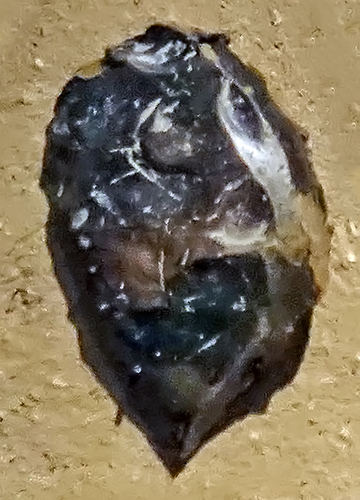
70 000 BC - 7 000 BC
Schaber, scraper
Scrapers are used to scrape off meat and fat on skins and to work on wood and bone. The earliest examples are made similarly to handaxes, but have a longer edge compared to the grip.
( This appears to be a sidescraper. The scraping surface is on the left, the grip or handle is on the right. Sidescrapers are the norm for early scrapers. Later, with blade technology, the scraper (grattoir), was on one or both ends of a long blade, a much better design, since it uses less flint, has more leverage, is very much faster to knap, and is suitable for both coarse and fine work - Don )
Catalog: Flint, Thebes, ÄS 1490
Photo: Don Hitchcock 2018
Source: Original, Ägyptischen Museum München
Text: Museum card, © Ägyptischen Museum München
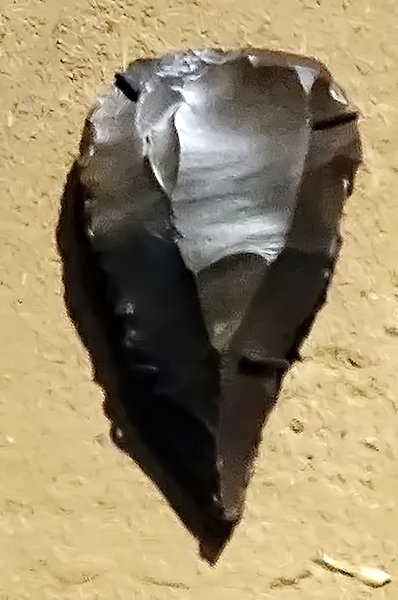
70 000 BC - 7 000 BC
Bohrer, drill
Early drills look very similar to handaxes, but have a long sharp tip.
( This flint appears to be of exceptionally fine quality - Don )
Catalog: Flint, Thebes, ÄS 1491
Photo: Don Hitchcock 2018
Source: Original, Ägyptischen Museum München
Text: Museum card, © Ägyptischen Museum München
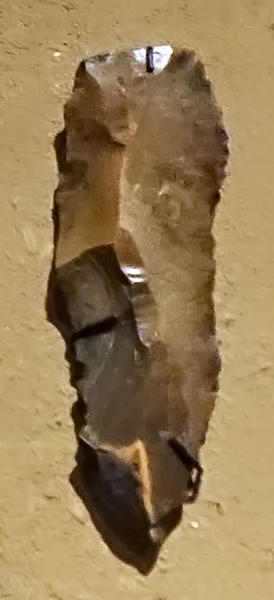
15 000 BC - 7 000 BC
Schaber, scraper
( This scraper has been made on a blade, and is very long for its width. It is probably a Mesolithic example, circa 15 000 BC or later, when the technology had improved greatly. The scraping surface is on the right, the grip or handle is on the left. It appears to have been made from a flake, rather than directly from the reduction of a core. The scraping edge on the right has been carefully retouched.
Some scrapers, such as this one, are designed with convex, concave, and straight sections of the edge for different tasks with the same tool - Don )
Catalog: Flint, Thebes, ÄS 1491
Photo: Don Hitchcock 2018
Source: Original, Ägyptischen Museum München
Text: Museum card, © Ägyptischen Museum München
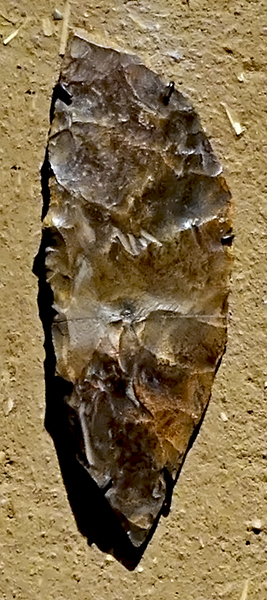
15 000 BC - 7 000 BC
Messer, knives
In the course of time, the shape of the blades became more and more specialised. Mesolithic knives are long, with a straight edge and a rounded back so that they fit better in the hand. The knives of this period do not yet have an additional handle of wood, bone, leather or antler.
( These 'backed' knives were designed to be held in the hand, with the index finger pushing on the blunted back of the knife during use - Don )
Catalog: Flint, Wadi el-Sheikh, collection of Seton-Karr, ÄS 1015, ÄS 1228, ÄS 1227, ÄS 1877
Photo: Don Hitchcock 2018
Source: Original, Ägyptischen Museum München
Text: Museum card, © Ägyptischen Museum München
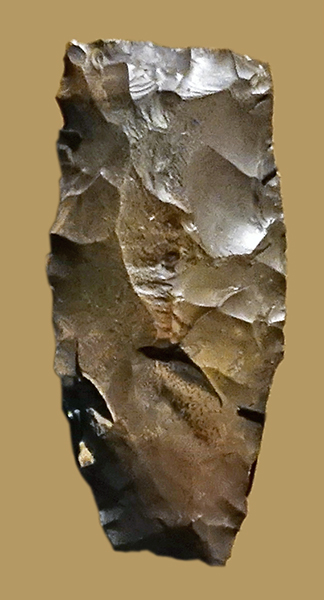
70 000 BC - 7 000 BC
Axtklinge, axe head
Axe blades of this shape were shafted in wooden handles. In Egypt, stone axes have been found in the Palaeolithic, disappear in the course of the Mesolithic and reappear in the Neolithic. They are also documented in the Early Period, after which they are gradually replaced by metal axe blades.
Catalog: Flint, Wadi el-Sheikh, collection of Seton-Karr, ÄS 1221
Photo: Don Hitchcock 2018
Source: Original, Ägyptischen Museum München
Text: Museum card, © Ägyptischen Museum München
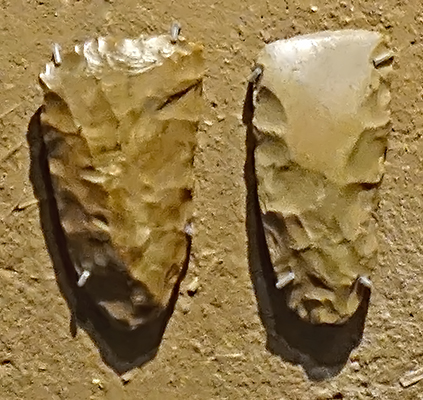
70 000 BC - 7 000 BC
Axtklingen, axe heads
These small axe blades were probably used for woodworking rather than for felling trees.
( These examples may well have been used transversely, as adzes, which are very useful woodworking tools.
Note also that the axeblade on the right has had its working edge smooth and sharp - Don )
Catalog: Flint, Wadi el-Sheikh, collection of Seton-Karr, ÄS 1427, ÄS 1428
Photo: Don Hitchcock 2018
Source: Original, Ägyptischen Museum München
Text: Museum card, © Ägyptischen Museum München
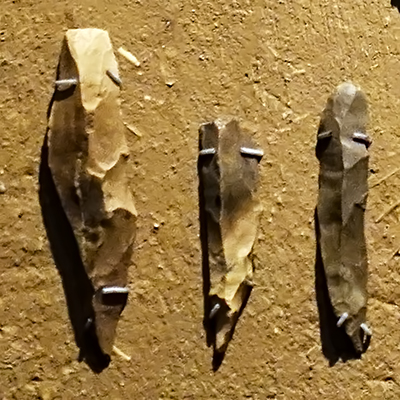
70 000 BC - 7 000 BC
Ahlen, awls
These long blades with a thin point were used to pierce holes in thin material such as fur.
Catalog: Flint, Wadi el-Sheikh, collection of Seton-Karr, ÄS 1222, ÄS 1224, ÄS 1225
Photo: Don Hitchcock 2018
Source: Original, Ägyptischen Museum München
Text: Museum card, © Ägyptischen Museum München
Palaeolithic: 50 000 BC - 3 000 BC
Stone Age Tools
1 - Hunter-gatherers of the Palaeolithic
(bottom left) At first, the desert was still a fertile savannah. On the mountain slopes behind Thebes there are thousands of tools of the hunters who lived there at that time.
The tools shown are of lint, from Thebes, and are of the Mousterian culture.
Circa 50 000 BC - 30 000 BC
2 - Hunter-gatherers of the Sebilian culture.
(bottom right) Small flints serve as arrowheads, harpoons, or scrapers.
Flint, near Kom Ombo (Sebilian) circa 12 000 BC - 10 000 BC.
The culture is known by the name given by Edmond Vignard to finds he located at Kom Ombo on the banks of the river Nile from 1919 continuing into the 1920s.
Nine sites were found by A. Marks in the area of the Wadi Halfa; Wendorf located three approximately 10 kilometres from Abu Simbel. The culture is located in its entirety only in proximity to the Nile, ranging from Wadi Halfa to Qena.
3 - Farmers and fishermen in the Fayum
(top left) Characteristic are the arrowheads with hollow bases.
The arrowheads are made of flint, circa 5 000 BC - 4 000 BC.
(Fayum-culture)
4 - A city of farmers
(top right) Maadi (12 km upstream from modern Cairo) was already a real city with hundreds of houses and an extensive cemetery.
The tools are of flint, circa 4 000 BC - 3 000 BC.
(Maadi culture)
Cartographer: Unknown
Rephotography: Don Hitchcock 2014
Source: Poster, Rijksmuseum van Oudheden, National Museum of Antiquities, Leiden.
Jebel Sahaba: A violent death
Life was difficult around 11 000 BC. Glaciers over Europe made the Nile Valley cold and dry, while the river was high and wild. Resources must have been scarce. Competition for food may explain why in one cemetery near Jebel Sahaba (northern Sudan) 45% of the men, women and children died of inflicted wounds. Remnants of stone weapons, and cut marks on the bones, provide the earliest evidence in history for large scale violent conflict.
Text above: Poster, British Museum © Trustees of the British Museum, CC BY-NC-SA 4.0
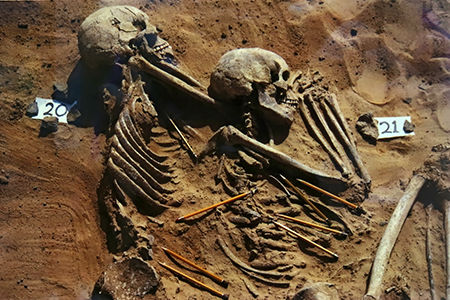
Photograph of Burials 20 and 21 when excavated in 1964.
The pencils point to the location of stone chips.
Photo and text: Poster, British Museum © Trustees of the British Museum, CC BY-NC-SA 4.0
Rephotography: Don Hitchcock 2015
Location of Jebel Sahaba, now submerged in Lake Nasser.
Photo: Drawn by D. Usai
Source: Usai (2020)
Burials 20 and 21 at Cemetery 117
Two of the victims are shown as they were buried with weapon fragments in position (on red discs). Both were adult men.
Catalog: Jebel Sahaba 117, Epi-Palaeolithic, EA77840, EA77841, EA81433 - EA81449, EA82050 - EA82055
Photo: Don Hitchcock 2015
Source: Original, British Museum
Text: Poster, British Museum © Trustees of the British Museum, CC BY-NC-SA 4.0
Burials 20 and 21 at Cemetery 117
Cuts on the legs of one skeleton (see red triangular pointers) were probably made by arrows shot at high velocity. The other man had six chert fragments in his abdomen, lower arms and one in his neck.
Catalog: Jebel Sahaba 117, Epi-Palaeolithic, EA77840, EA77841, EA81433 - EA81449, EA82050 - EA82055
Photo: Don Hitchcock 2015
Source: Original, British Museum
Text: Poster, British Museum © Trustees of the British Museum, CC BY-NC-SA 4.0
Burials 20 and 21 at Cemetery 117
Clusters of stone chips found within one skeleton give evidence of wounds to his chest, legs, arms and head. Several more chips are also embedded in his bones.
Catalog: Jebel Sahaba 117, Epi-Palaeolithic, EA77840, EA77841, EA81433 - EA81449, EA82050 - EA82055
Photo: Don Hitchcock 2015
Source: Original, British Museum
Text: Poster, British Museum © Trustees of the British Museum, CC BY-NC-SA 4.0
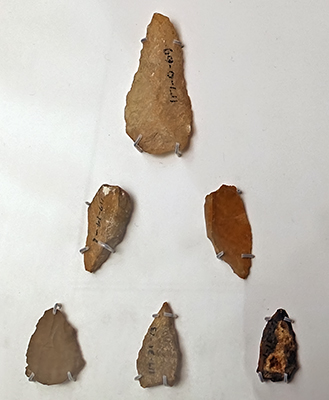
Weapons used at Jebel Sahaba
These stone pieces are some of the larger remnants of the weapons found at Jebel Sahaba graves. Most were small flakes of chert called microliths that were originally assembled together on wooden shafts to make arrows or other weapons.
Tools constructed in this way were used by the hunter-gatherer cultures across North Africa and Europe during the late Palaeolothic. Clusters of stone chips found in the Jebel Sahaba bodies probably derive from weapons fitted with several microliths. Some shattered on impact with the bones, or detached from the shaft. Either way, they remained in the soft tissue when the arrow was removed.
( which would have meant that even if the person injured by an arrow or spear survived the initial thrust, they would have succumbed to the resulting trauma later. No tissue around the microliths could heal and in the body’s attempt to rid itself of the foreign object the body's defence forces would rage forming an abscess. Every time the victim moved the microlith's rough edges would inflame and aggravate the injury and eventually lead to a fatal infection - Don )
Catalog: Jebel Sahaba 14, 29, 31, Epi-Palaeolithic, EA87057ab, EA82063a, EA82064ad, EA82288
Photo: Don Hitchcock 2018
Source: Original, British Museum
Text: Poster, British Museum © Trustees of the British Museum, CC BY-NC-SA 4.0
Additional text: https://allthingsliberty.com/2013/05/battle-wounds-never-pull-an-arrow-out-of-a-body/

Bone harpoon, replica, from the Mesolithic, 10 800 - 7 000 years ago.
This harpoon is a fine example of the use of microliths. Their use was not because of a lack of good flint, but because they were far more effective at dropping prey, owing to the shock they provided from the wound they made. The wound was large and lacerated, and the blood loss and associated organ damage disabled even large prey.
Although this was labelled as a harpoon, points of similar construction were used fixed to spear/arrow shafts.
Photo: Don Hitchcock 2014
Source: Rijksmuseum van Oudheden, National Museum of Antiquities, Leiden.
Map of Cemetery 117 at Jebel Sahaba
The burials with evidence for violence are highlighted in red. A violent death is indicated by the presence in the graves of stone chips and flakes, which are the remnants of composite weapons, and cut marks on the bones, made by arrows or knives. The victims displayed here were buried near the centre of the cemetery.
At least 61 individuals, comprising men, women and children, were buried at Jebel Sahaba. Some were buried alone, some in groups. All were placed in shallow graves capped with sandstone slabs. The bodies were interred in a tightly flexed position, lying on their left side, their heads to the south, facing east. No grave goods were put in the graves, but the standard position of the bodies indicates belief in an afterlife. Over time the site was used, probably by one tribe or extended family, as the designated place for burial. This makes it one of the earliest cemeteries in the world.
Photo: https://blog.britishmuseum.org/tag/jebel-sahaba/ © Trustees of the British Museum, CC BY-NC-SA 4.0
Text: Card at the British Museum, © Trustees of the British Museum, CC BY-NC-SA 4.0
Violence at Jebel Sahaba
Raids and skirmishes must have been common in the period of climate change around 11 000 BC. Conflict was brutal; not even women and children were spared. Healed injuries on some of the bones are the result of earlier violent encounters.
These bones are from the forearms (ulnae) of two different individuals. The top ulna has a fully healed fracture, in contrast to the normal ulna below it. This type of injury is called a parry fracture. It typically occurs when the arm is lifted to protect the head and deflect a powerful blow.
The fractured ulna is from a female, age 50+, stature 1610 ± 34 mm. The lower ulna is from the male whose mandible is shown below.
Catalog: Jebel Sahaba 31 and 26, Epi-Palaeolithic, EA77846, EA77850
Photo: Don Hitchcock 2015
Source: Original, British Museum
Text: Card at the British Museum, http://www.britishmuseum.org/, © Trustees of the British Museum, CC BY-NC-SA 4.0
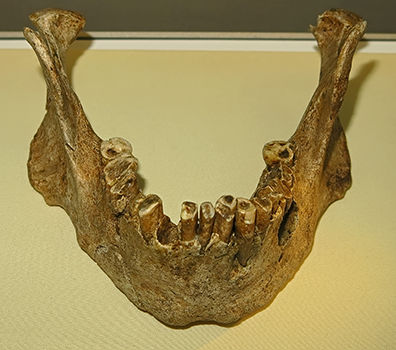
The people of Jebel Sahaba
People at Jebel Sahaba were very well-built and robust. Despite the violence they endured, many lived into adulthood, with some surviving beyond 50 years of age. They hunted, fished and collected wild plants for food.
The coarse diet wore away their teeth, as shown in this lower jaw (mandible) belonging to an older man. Once the crowns had worn down, the pulp was exposed to bacteria. This led to infections, creating abscesses. The large holes below the first molars are examples of dental abscesses. These must have caused the man severe discomfort.
Human skeletal remains. Male, age 50+ years; stature 1723 +/-39 mm (R femur). The skull was exceptionally preserved except for a damaged right temporal. Dentition-permanent 30. Dental disease: Heavy dental wear, tooth 23 crowded lingually by 22 and 24; abscess at 3, 12, 19, 22 and 30.
Trauma: Exostosis on right femur (3rd trochanter) with healed wound on central shaft. Fracture right elbow? Healed cut fracture on head of left MC1; ridge of bone on left talar articular facet due to impaction injury that is not completely healed. Osteoarthritis: Right elbow; distal articular surface of left fibula; osteophytosis and collapse of at least 3 of cervical vertebrae (Anderson 1968: 997 states '4 vertebrae'). Cutmarks: Healed cutmark on midshaft of right humerus; cutmark on anterior left iliac blade.
Catalog: Jebel Sahaba 31, Epi-Palaeolithic, EA77850
Photo: Don Hitchcock 2015
Source: Original, British Museum
Text: Card at the British Museum, http://www.britishmuseum.org/, © Trustees of the British Museum, CC BY-NC-SA 4.0
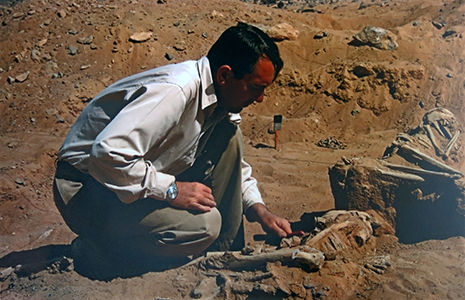
Fred Wendorf examining burials at Jebel Sahaba in 1965.
The discovery of Jebel Sahaba Cemetery 117 at Jebel Sahaba is a significant discovery for two reasons: it is one of the oldest formal burial grounds in the world, and it contained the earliest known evidence for inter-communal violence. Dr Fred Wendorf carried out systematic excavations here in 1965 as part of his mission to rescue early sites due to be flooded because of the Aswan High Dam. In 2002 Dr Wendorf donated his scientific collections and archives to the British Museum. This material is a unique resource for understanding the early inhabitants of the Nile valley and how they dealt with environmental change.
Photo and text: Poster, British Museum, Wendorf Archive (British Museum), © Trustees of the British Museum, CC BY-NC-SA 4.0
Rephotography: Don Hitchcock 2015
When the desert was green
8600-4400 BC
Today the Sahara is one of the driest places on earth, but it was not always that way. The end of the last ice age (about 10 000 BC) released moisture into the atmosphere and summer rain fell on the desert. Seasonal lakes (playas) formed, supporting enough grass and scrubland to make life possible during the summer months.
Gradually the climate turned dry and by 4400 BC people began to abandon the desert to settle in oases and by the river. There, they took up farming, an innovation from the Levant, triggering social and technological developments that led directly to the beginning of Egyptian civilisation at about 3100 BC. Nabta Playa, in southern Egypt, shown on the map at left, was one of the largest of these playa lakes.
Excavations by Dr Fred Wendorf and the Combined Prehistoric Expedition revealed that nomadic people lived by its shores sporadically for over 4000 years. In 2002 Dr Wendorf donated excavated material to the British Museum. This enables us to glimpse the lives of these early desert dwellers and learn how they coped with the precarious environment.
Photo: Poster, British Museum © Trustees of the British Museum, CC BY-NC-SA 4.0
Rephotography: Don Hitchcock 2015
Text: poster at the Museum © Trustees of the British Museum, CC BY-NC-SA 4.0
A portrait of Fred Wendorf, left, and Fred Wendorf at Nabta Playa.
In the early 1960s, archaeological monuments in Lower Nubia were threatened with obliteration from construction of the Aswan High Dam in the Nile River Valley of Egypt.
UNESCO launched an international salvage operation in an effort to save the region’s rich archaeological heritage.
In response to the UNESCO appeal, in 1962 Wendorf invited teams of scientists from Great Britain, France, Belgium, Poland and Egypt to participate in the rescue of the Nubian prehistoric monuments that would disappear under the waters of Lake Nasser with the completion of the new dam. This multinational research body became the Combined Prehistoric Expedition, which Wendorf directed until 1999, along with his collaborator Romuald Schild, professor at the Institute of Archaeology and Ethnology at the Polish Academy of Sciences (whom Wendorf affectionately referred to as his 'brother').
The Nubian Campaign made possible the discovery and rescue of hundreds of prehistoric sites along the Nile in the stretch extending on both sides of the river between Tushka in Upper Egypt to the southern end of the Second Cataract in Sudan. The Expedition has continued to carry out researches in Upper and Lower Egypt, the Western Desert of Egypt, Sudan, Ethiopia and Sinai.
'The Combined Prehistoric Expedition, under Fred Wendorf’s direction, became the most enduring prehistoric expedition in the history of African archaeology, covering in its field work and subsequent publications almost the entire chronological expanse of prehistory from the Early Stone Age to the late predynastic and Bronze Age times', said Schild. 'The work of the Expedition over the past half century has provided comprehension as never before of human settlement, beliefs, social interaction and adaptation to the natural environments along the main Nile Valley, the deserts of eastern Sahara and Sinai, as well as the rift valleys of Ethiopia.'
Fred Wendorf died on the 15th of July 2015.
Photo: https://www.smu.edu/News/2015/fred-wendorf-dies-15july2015
Source and text: https://www.smu.edu/News/2015/fred-wendorf-dies-15july2015
Nabta PlayaText above: Wikipedia
Archaeological discoveries reveal that these prehistoric peoples led livelihoods seemingly at a higher level of organisation than their contemporaries who lived closer to the Nile Valley. The people of Nabta Playa had above-ground and below-ground stone construction, villages designed in pre-planned arrangements, and deep wells that held water throughout the year.
Findings also indicate that the region was occupied only seasonally, most likely only in the summer period, when the local lake filled with water for grazing cattle. Comparative research indicated that the indigenous inhabitants may have a significantly more advanced knowledge of astronomy and mathematics than previously thought possible.
Map of Egypt with the approximate location of Nabta Playa circled near the bottom.
Photo: Dutch version of Public Domain Map, permission granted here, by the University of Texas at Austin.
Source: Map from The University of Texas at Austin: Egypt: Country Map.
Map reduced in size, and "Legend" and "Scale" moved up, to conserve space. Also approximate position of Nabta Playa noted: Latitude 22° 32' 00" North; Longitude 30° 42' 00" East.
Subsequently translated to Dutch from the aforementioned source from English Wikipedia.
Permission: Public Domain
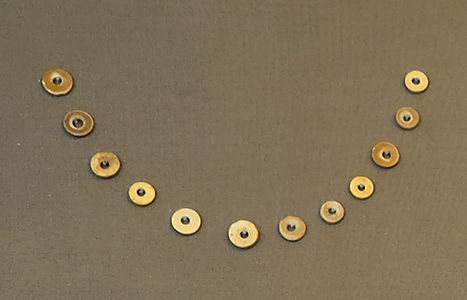
Ostrich eggshell beads, 8 000 BC - 6 750 BC
Making beads out of ostrich eggshell was one of the favourite pastimes of the inhabitants of Nabta Playa. All steps in the process have been preserved, along with the tools that were used to form and finish them.
Catalog: Nabta E79-8, Early Neolithic, EA81426
Photo: Don Hitchcock 2015
Source: Original, British Museum
Text: Card at the British Museum © Trustees of the British Museum, CC BY-NC-SA 4.0
Bead making: Step 1 (left)
First, the eggshells were collected, probably from abandoned nests, and roughly broken down to a usable size.
Bead making: Step 2 (right)
The edges of the eggshell fragments were then rounded by careful chipping, probably with a stone cobble.
Catalog: Nabta E79-8, Early Neolithic, EA81431, Nabta E79-8, Early Neolithic, EA81428
Photo: Don Hitchcock 2018
Source: Original, British Museum
Text: Card at the British Museum © Trustees of the British Museum, CC BY-NC-SA 4.0
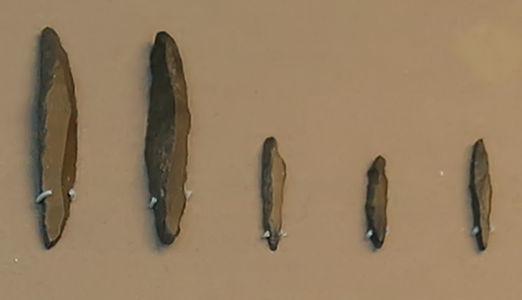
Flint tools were used as awls for the next step, the drilling of the holes.
Catalog: Nabta E75-6, Early Neolithic, EA82307 - EA82311
Photo: Don Hitchcock 2015
Source: Original, British Museum
Text: Card at the British Museum © Trustees of the British Museum, CC BY-NC-SA 4.0
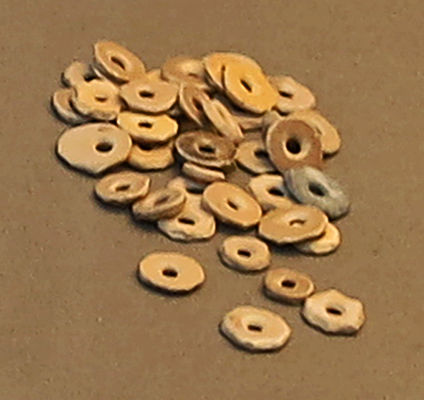
Bead making: Step 3
Next, a hole was drilled with one of the specially prepared flint perforators displayed above. These were probably mounted on a stick and rotated between the palms of the hand to make the hole in the centre of the eggshell disk.
Catalog: Nabta E79-8, Early Neolithic, EA81429
Photo: Don Hitchcock 2015
Source: Original, British Museum
Text: Card at the British Museum © Trustees of the British Museum, CC BY-NC-SA 4.0
Bead making: Step 4
In the final step, the edges of the bead were smoothed and polished by rubbing against a block of fine sandstone.
Drilling was the most difficult part of the operation, and many beads broke at this point, as shown on the upper right of this photo. An innovation of the Middle Neolithic period was to drill the hole first, and shape the bead later, saving time and effort, as shown on the lower right of this photo.
Catalog: Nabta E79-8, Early Neolithic, EA81426, Nabta E79-8, Nabta E79-8, Early Neolithic, EA81432, Nabta E79-8, Middle Neolithic, EA81427
Photo: Don Hitchcock 2015
Source: Original, British Museum
Text: Card at the British Museum © Trustees of the British Museum, CC BY-NC-SA 4.0
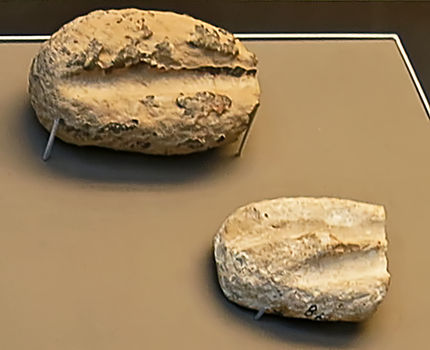
The smoothing and polishing action wore away the stone and produced grooves as seen in these polishers.
Catalog: Nabta E79-8, Early Neolithic, EA82294-5
Photo: Don Hitchcock 2015
Source: Original, British Museum
Text: Card at the British Museum © Trustees of the British Museum, CC BY-NC-SA 4.0
(front) Ostrich egg. The ostrich lays the largest egg in nature. The shells of these eggs were important materials for the early nomadic people living in the desert. Complete egg shells were used as containers for water or other liquids and some were etched with intricate designs. They were probably carried in slings of leather or rope. Eggshell fragments were also shaped into beads and tools.
Catalog: EA22554
(back) Decorated basket. This oval basket was found within a silo. It is one of the oldest preserved baskets from Egypt. The vertical stripes woven into the sides were originally dark red. From the pattern we gain a rare glimpse into the artistic world of the Fayum dwellers not seen in their drab pottery.
Catalog: Fayum Kom K, Silo 55, Fayum Neolithic, EA58696
Photo: Don Hitchcock 2018
Source: Original, British Museum
Text: Card at the British Museum © Trustees of the British Museum, CC BY-NC-SA 4.0
Pottery in the Fayum was purely functional. In contrast to the cultures in the desert and Upper Egypt, little care was taken in shaping and decoration. The coarse clay was left plain or coated with a red slip and lightly polished. Bowls were the most common shape. Small cups with knobbed feet (bottom centre) were rare and might have been lamps.
Catalog: Fayum Kom W, Fayum Neolithic, EA58690, EA58692
Fayum Kom K, Silos 60 and 64, Fayum Neolithic, EA58693, EA58694
Photo: Don Hitchcock 2018
Source: Original, British Museum
Text: Card at the British Museum © Trustees of the British Museum, CC BY-NC-SA 4.0
Desert beginnings
Desert Neolithic of Nabta Playa, 8 600 BC - 4 400 BC
The origins of Egyptian civilisation can be traced back to early hunting and gathering herders who colonised the desert from about 8 600 BC, until the climate forced them to the Nile 4 000 years later. The first people to reach Nabta Playa brought with them some of the earliest pottery in Africa, and possibly Africa's first tamed cattle. Used for their milk and blood, rather than their meat, these cattle supplemented a diet of game and wild grasses.
Text above: Card at the British Museum © Trustees of the British Museum, CC BY-NC-SA 4.0
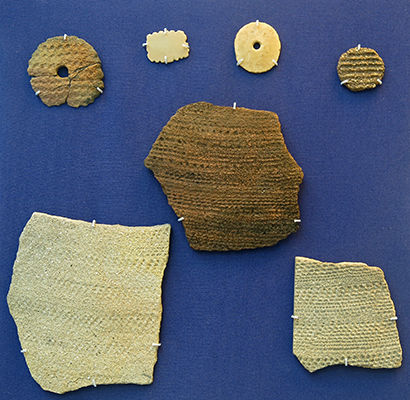
First pottery, 8 600 BC.
The early inhabitants of Nabta made large pottery bowls from local clays, covering the entire surface with impressed decorations using various tools.
The notched rectangle of eggshell shown second from the left in the top row was pressed into the wet clay and pivoted over the pot's surface to create a dotted design.
Perforated pottery disks, often with notched edges, could also be mounted on a stick and rolled over the clay. The designs imitate basketry. The pots must have been important for display or rituals, ( or storage - Don ) as no evidence of cooking can be seen.
Catalog: Nabta E79-8, E80-4, Early Neolithic, EA76847, EA76848, EA82302
Nabta E75-9, E91-1, Early Neolithic, EA76925, EA76942
Nabta E00-1, E79-6, Early Neolithic, EA81424, EA81423
Photo: Don Hitchcock 2015
Source: Original, British Museum
Text: Card at the British Museum © Trustees of the British Museum, CC BY-NC-SA 4.0
Early Neolithic Climatic Optimum, 7 050 BC - 6 100 BC
For more than 1 000 years arid conditions made life in the desert difficult, but at about 7 050 BC, the climate became ideal for settlement. With a permanent water supply and fertile grasslands, people could stay in the desert all year round. They built huts, dug wells and made storage pits to hold a variety of wild grasses. Some grasses, like sorghum, they may even have cultivated.
Text above: Card at the British Museum © Trustees of the British Museum, CC BY-NC-SA 4.0
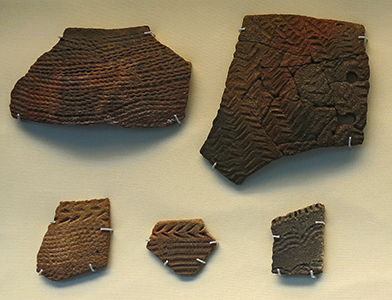
Pottery bowl fragments, 7 050 BC - 6 100 BC
Pottery was more common during the Early Neolithic wet phase. It was still valued as the holes for mending show. Decorative bands, with designs similar to ostrich eggshell containers, were now added around the rim. The dotted wavy line pattern indicates contact with early cultures in the Sudan, where this design was widespread.
Catalog: Nabta E75-6, Early Neolithic EA76916
Nabta E91-1, Early Neolithic, EA76946, EA76941, EA76943, EA76944
Photo: Don Hitchcock 2015
Source: Original, British Museum
Text: Card at the British Museum © Trustees of the British Museum, CC BY-NC-SA 4.0
Ostrich eggshell containers, 7 050 BC - 6 100 BC
Once carefully emptied, ostrich eggs made light but strong containers and canteens. They were used frequently by these mobile people, especially in the Early Neolithic period. Some eggshell containers were etched with intricate designs that were copied in pottery.
Catalog: Nabta E79-8, Early Neolithic, EA81422
Photo: Don Hitchcock 2015
Source: Original, British Museum
Text: Card at the British Museum © Trustees of the British Museum, CC BY-NC-SA 4.0
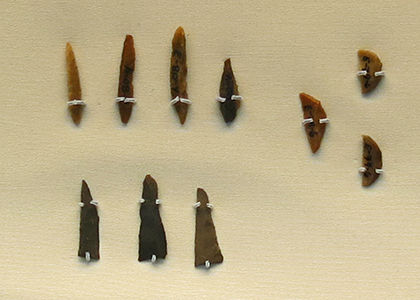
Flint implements, 7 050 BC - 6 100 BC
Tiny triangles, semi-circles and trapezoids of flint were fitted into wooden handles to make a variety of composite tools. Their standard size and shapes meant they could be re-arranged or replaced when dull or broken. Microlithic technology was used across North Africa for more than 10 000 years and continued at Nabta Playa until the late phase.
Catalog: Nabta E80-4, E79-6, E75-6, Early Neolithic, EA82315, EA82325, EA82328
Photo: Don Hitchcock 2015
Source: Original, British Museum
Text: Card at the British Museum © Trustees of the British Museum, CC BY-NC-SA 4.0
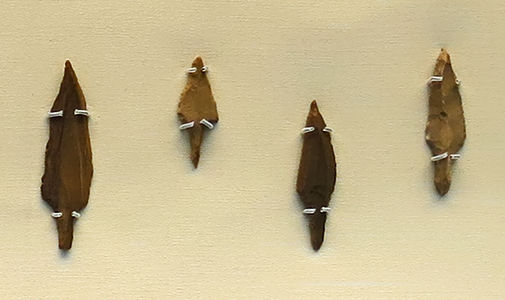
Arrowheads, 7 050 BC - 6 100 BC
Hunted animals were an important part of the diet. Special types of full-sized arrowheads, called Ounan points, ( or rather Ounanian-Harifian points, see the explanation below - Don ) were developed at this time specifically for hunting. The pointed tang allowed them to be rapidly inserted into a reed shaft when the need arose.
Catalog: Nabta E94-4, Early Neolithic, EA82303-EA82306
Photo: Don Hitchcock 2015
Source: Original, British Museum
Text: Card at the British Museum © Trustees of the British Museum, CC BY-NC-SA 4.0
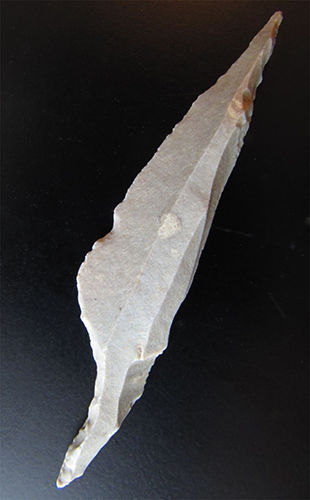
Ounan Point
This is a classic Ounan point from northern Mali (8 cm long).
The Ounanian point was first recognised by Breuil in 1930 at Ounan to the south of Taodeni in northern Mali from a surface collection of tools made from quartzite, which he ascribed to the Epi-Palaeolithic.
Made on blades, these specialised tools have had the proximal end modified by steep retouch to form a narrow perçoir - like tang or shank and shoulders, or more usually a single shoulder. Very often, this tang is incurved towards the shouldered edge of the tool.
Since the distal end is generally pointed, either naturally or by retouch, the tool is more probably a specialised form of projectile point rather than a perçoir, and the pointed tang would have served as an aid to hafting or perhaps in the case of the incurved examples as some kind of barb. Ounanian Points are the hallmark of the Epipaleolithic in the central Sahara, the Sahel and northern Sudan, and are dated between 8 000 BC and 4 000 BC.
Photo: © Katzman, Aggsbach's Paleolithic Blog
Source and text: http://www.aggsbach.de/2012/04/ounan-points-revisited/
The story of Ounan points is a little more complicated than the display at the British Museum has space to elucidate. I am indebted to Katzman, of Aggsbach's Paleolithic Blog, for explaining to me (P.C., 2016 ) the subtleties of the situation.
The 'Ounan' points from Nabta Playa are in fact a melding of the characteristics of the Harifian Points and the Ounan Points, known as Ounanian-Harifian points, see below.
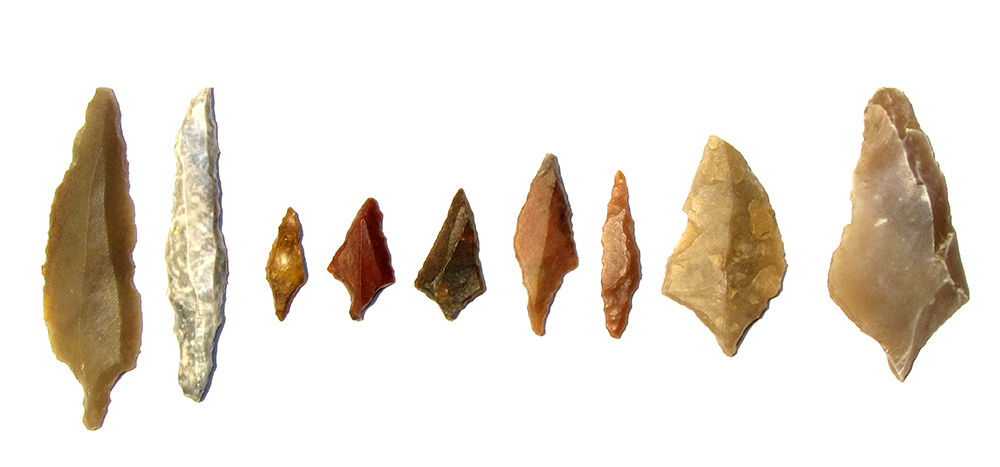
Two classic Ounanian points from the Western Sahara on the left side, two classic Harifian Points from the Sinai on the right side, and in between some Ounanian-Harifian Points from Egypt
Photo: by courtesy of © Katzman, Aggsbach's Paleolithic Blog
Middle Neolithic, 6 000 BC - 5 500 BC
After a period of drought, people returned to Nabta with an important new addition: domestic sheep and goats. Introduced from the Near East, these animals eventually become the primary meat source. These herders lived in small, dispersed villages of round huts with slab lined walls. They moved over the course of the year to be close to water or other resources.
Text above: Card at the British Museum © Trustees of the British Museum, CC BY-NC-SA 4.0
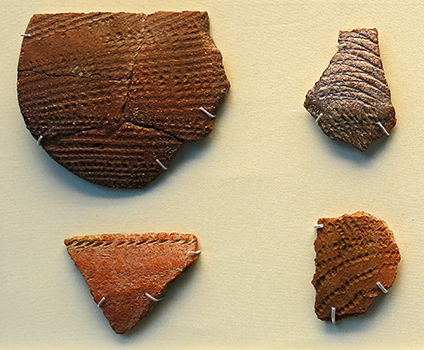
Pottery fragments, 6 000 BC - 5 500 BC
Interest in decorating pottery gradually diminished. Stamped designs became more widely spaced or were smoothed over to lessen their visual impact. Later on, the pottery became plain with decoration only at the rim.
Catalog: Nabta E75-E78, Middle Neolithic, EA76898, EA76900, EA76902, Nabta E00-1, Middle Neolithic EA76969
Photo: Don Hitchcock 2015
Source: Original, British Museum
Text: Card at the British Museum © Trustees of the British Museum, CC BY-NC-SA 4.0
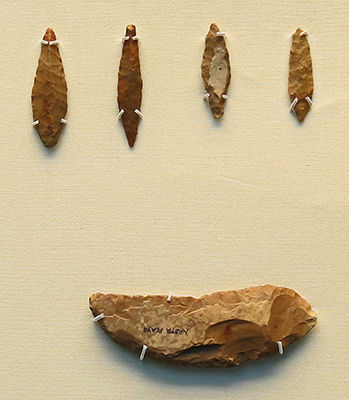
Flint implements, 6 000 BC - 5 500 BC
Along with sheep and goats, new ways of working flint were also introduced from the Near East. This new bifacial technique used pressure to remove flakes from both sides of tools, making them thin but strong.
Leaf -shaped arrowheads and knives made in this way became widespread in the northern Sahara, as microlithic technology was gradually abandoned.
Catalog: Nabta, Middle Neolithic, EA82314, EA82316,EA82317, EA82318, EA82322
Photo: Don Hitchcock 2015
Source: Original, British Museum
Text: Card at the British Museum © Trustees of the British Museum, CC BY-NC-SA 4.0
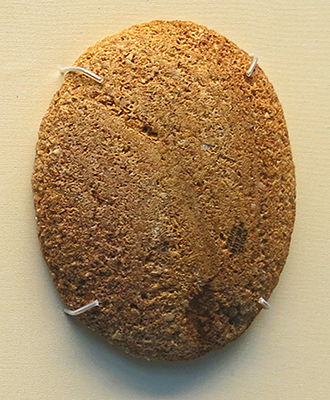
Grinding stones, 6 000 BC - 5 500 BC
Seeds and wild grasses were processed with round or oval grinders ( manos ) of hard quartzitic sandstone. These were rubbed against a larger mill stone to make flour. A depression in the lower stone' s surface prevented spillage The abundance of grinding stones shows that plant food made up a significant part of the diet at this time.
Catalog: Nabta E75, E76, Middle Neolithic, EA82298
Photo: Don Hitchcock 2015
Source: Original, British Museum
Text: Card at the British Museum © Trustees of the British Museum, CC BY-NC-SA 4.0
Late Neolithic, 5 400 BC - 4 400 BC
After another dry phase people returned to the desert, but the climate was becoming increasingly arid. This forced the herders to roam more widely and the large seasonal lake at Nabta Playa became a place where the dispersed groups gathered for ceremonies.
Stone alignments and calendar circles built for these events reflect the increased social organisation at this time of environmental stress.
Text above: Card at the British Museum © Trustees of the British Museum, CC BY-NC-SA 4.0
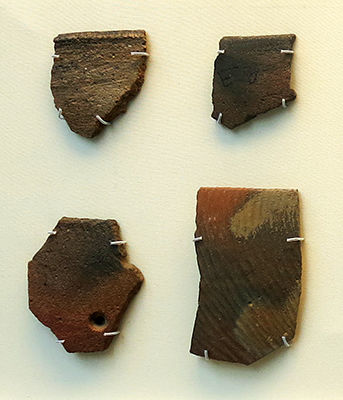
Late Neolithic Pottery, 5 400 BC - 4 400 BC
Pottery with blackened rims or rippled surfaces appeared in the last phases of habitation at Nabta. Ripples were made by combing the wet clay and then polishing the pot's surface. Incised decoration was now limited to elaborate tulip-shaped beakers which were placed with the dead in large family graves.
Catalog: Nabta E00-1, Late Neolithic, EA76973, EA76974, EA82300, Nabta E00-5 tumulus, Final Neolithic, EA82301
Photo: Don Hitchcock 2015
Source: Original, British Museum
Text: Card at the British Museum © Trustees of the British Museum, CC BY-NC-SA 4.0
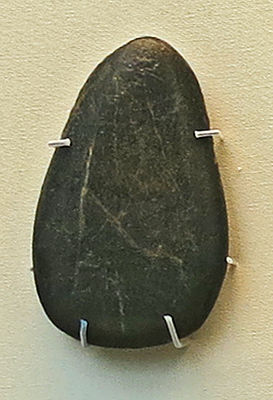
Ground stone axe, 5 400 BC - 4 400 BC
Hard stone cobbles were laboriously ground against an abrasive stone to shape and sharpen them for use as axes. They were then polished to increase mechanical strength.
Employed for chopping and cutting, these axes became important parts of the tool kit of later agricultural communities along the Nile.
Catalog: Nabta, Late Neolithic, EA82903
Photo: Don Hitchcock 2015
Source: Original, British Museum
Text: Card at the British Museum © Trustees of the British Museum, CC BY-NC-SA 4.0
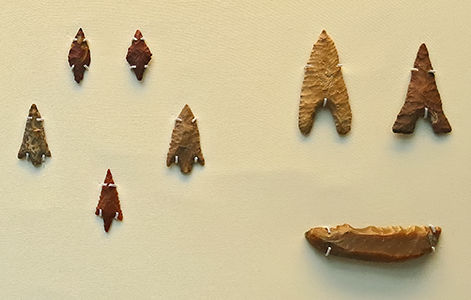
Arrowheads and knife, 5 400 BC - 4 400 BC
Hunting remained an important source of food for the desert herders. The quality and beauty of their hunting equipment was a matter of prestige.
Concave base arrowheads were probably invented in the Sahara, but gained popularity among later cultures in both Upper and Lower Egypt.
Catalog: Nabta, Late Neolithic, EA82312, EA82904, EA82902, EA82329, EA82313, EA82319, EA82321, EA82901
Photo: Don Hitchcock 2015
Source: Original, British Museum
Text: Card at the British Museum © Trustees of the British Museum, CC BY-NC-SA 4.0
The Fayum Neolithic
The beginnings of agriculture, 5 200 - 4 200 BC
The changing climate caused movements of people east and west. In the Fayum Oasis, those living around Lake Qarun (Birket-el-Qerun) absorbed elements from both directions.
From the Near East they adopted the cultivation of barley and emmer wheat, and were the first to do so in Egypt. From the desert they took innovations that helped them as mobile hunters and fishermen. Often shifting their location to exploit different resources, they stored their harvest and other possessions in basket-lined silos, grouped together on high ground. The contents of these silos give us insight into life in early Fayum.
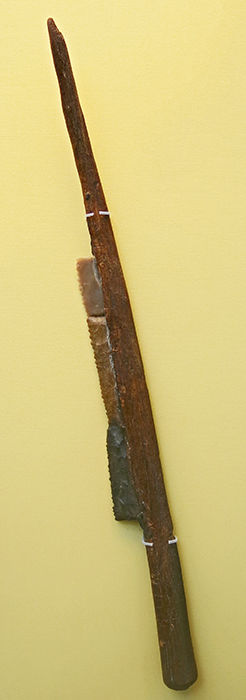
The Fayum Neolithic - Sickle with handle, 5 200 - 4 200 BC
The adoption of farming required new tools. The most important of these was the sickle for harvesting crops. This complete example was found within a storage silo.
The three blades are set into a groove in the wooden handle and held in place with resin. Two show signs of intensive usage. The uppermost blade is much less worn and must have been a replacement for one that had broken.
Catalog: Fayum Kom K, Silo 51, Fayum Neolithic, EA58701
Photo: Don Hitchcock 2015
Source: Original, British Museum
Text: Card at the British Museum © Trustees of the British Museum, CC BY-NC-SA 4.0
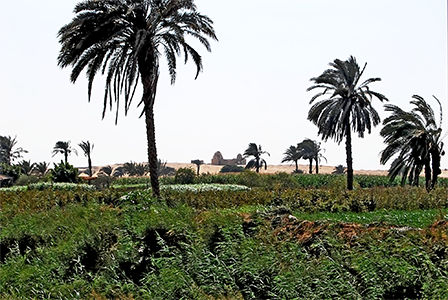
A scenic view of Faiyum Oasis in 2008
The city of Itj-tawy, which was the political and administrative capital during the Middle Kingdom period of Egypt, was located very close to this oasis.
Faiyum Oasis is located about 130 kilometres southwest of Cairo.
Photo and text: cynic zagor (Zorbey Tunçer)
Permission: Creative Commons Attribution-Share Alike 2.0 Generic license.
When the Mediterranean Sea was a hot dry hollow near the end of the Messinian Salinity Crisis in the late Miocene, Faiyum was a dry hollow, and the Nile flowed past it at the bottom of a canyon which was 2400 metres deep or more where Cairo is today. At the time, the Mediterranean Sea was a deep dry basin bottoming at some places 3 km to 5 km below sea level. After the Mediterranean reflooded at the end of the Miocene, 5.33 million years ago with the Zanclean flood, the Nile canyon became an arm of the sea reaching inland further than Aswan. Over geological time that sea arm gradually filled with silt and became the Nile valley.Text above: Wikipedia
Map sheet showing Fayyum Oasis, Egypt, 1953, and the lake which supplies its water, Birket-el-Qerun.
Eventually the Nile valley bed silted up high enough to let the Nile in flood overflow into the Faiyum hollow and make a lake in it. The lake is first recorded from about 3 000 BC, around the time of Menes (Narmer). However, for the most part it would only be filled with high flood waters. The lake was bordered by neolithic settlements, and the town of Crocodilopolis grew up on the south where the higher ground created a ridge.
In 2 300 BC, the waterway from the Nile to the natural lake was widened and deepened to make a canal which is now known as the Bahr Yussef. This canal fed into the lake. This was meant to serve three purposes: control the flooding of the Nile, regulate the water level of the Nile during dry seasons, and serve the surrounding area with irrigation. There is evidence of ancient Egyptian pharaohs of the twelfth dynasty using the natural lake of Faiyum as a reservoir to store surpluses of water for use during the dry periods.
Photo: US Army Map Service, Corps of Engineers
Permission: Public Domain
The immense waterworks undertaken by the ancient Egyptian pharaohs of the twelfth dynasty to transform the lake into a huge water reservoir gave the impression that the lake itself was an artificial excavation, as reported by classic geographers and travellers. The lake was eventually abandoned due to the nearest branch of the Nile dwindling in size from 230 BC.
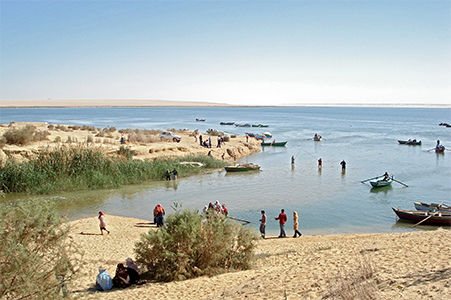
The lake at Fayum today, Lake Qarun (Birket-el-Qerun), much reduced from former times.
Photo: Hussain92
Permission: Creative Commons Attribution-Share Alike 3.0 Unported license.
Faiyum was known to the ancient Egyptians as the twenty-first nome of Upper Egypt, Atef-Pehu ('Northern Sycomore'). In ancient Egyptian times, its capital was Sh-d-y-t (usually written 'Shedyt'), called by the Greeks Crocodilopolis, and refounded by Ptolemy II as Arsinoe.
This region has the earliest evidence for farming in Egypt, and was a centre of royal pyramid and tomb-building in the Twelfth dynasty of the Middle Kingdom, and again during the rule of the Ptolemaic dynasty. Faiyum became one of the breadbaskets of the Roman world.
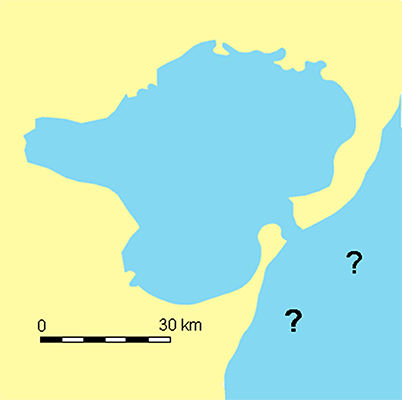
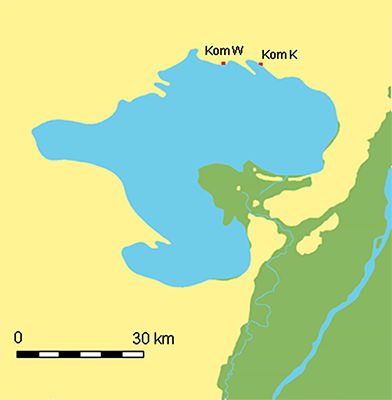
Map showing the extent of the lake in the Pleistocene (left) and during the Neolithic.
Photo after: Caton-Thompson and Gardner (1934)
Source: http://www.ucl.ac.uk/museums-static/digitalegypt/maps/fayum.html
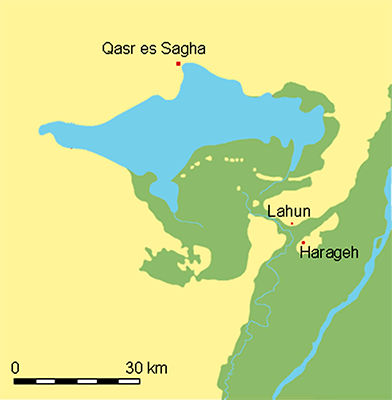
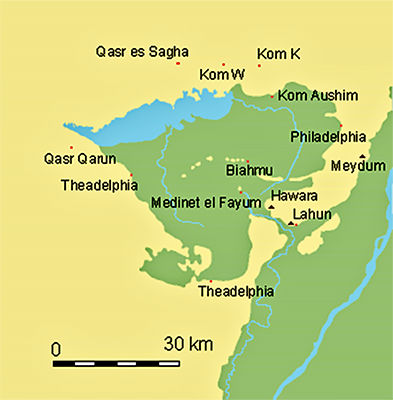
Map showing the extent of the lake in Dynastic times, left, and in 1925.
Photo after: Caton-Thompson and Gardner (1934)
Source: http://www.ucl.ac.uk/museums-static/digitalegypt/maps/fayum.html

The Fayum Neolithic - Beads, 5 200 - 4 200 BC
Beads from the Fayum Neolithic, including ostrich egg shell beads, amazon stone (green microcline feldspar, probably from Ethiopian deposits) and stone.
Catalog: Fayum Neolithic, UC2536, UC2544, UC2565, UC2565A, UC3747
Photo: Don Hitchcock 2015
Source: Original, Petrie Museum, London, England
Text: Card / online catalogue, the Petrie Museum, © 2015 UCL. CC BY-NC-SA license.
The Fayum Neolithic - Farming tools: hoes and axes, 5 200 - 4 200 BC
Along with wheat and barley, the tools for farming these crops were adopted from the Levant. These include the sickle for harvesting, the hoe for tilling the soil and the flint axe.
Their shape and appearance, painstakingly pressure-flaked on both sides, must have been a matter of prestige. Other tools were more economically made, used and then discarded.
Catalog: Fayum, Fayum Neolithic, EA58706, EA58710, EA58717
Photo: Don Hitchcock 2015
Source: Original, British Museum
Text: Card at the British Museum © Trustees of the British Museum, CC BY-NC-SA 4.0
The Fayum Neolithic - Sickle blades, 5 200 - 4 200 BC
Sickles were used to reap a variety of crops or wild grasses. The cutting edge was made fine or coarse depending on the intended purpose. The shiny area visible on the blade to the right is called sickle gloss.
It is a residue that has accumulated from cutting the stems of cereals and grasses that are rich in silica. ( not visible in my photo - perhaps they mean the one on the left, which exhibits sickle gloss - Don )
Catalog: Fayum, Fayum Neolithic, EA58715 - EA58716
Photo: Don Hitchcock 2018
Source: Original, British Museum
Text: Card at the British Museum © Trustees of the British Museum, CC BY-NC-SA 4.0
The Fayum Neolithic - Ground stone Celts, 5 200 - 4 200 BC
Celts or axes made of hard stones, ground to shape, were an important part of the tool kit. They were used for chopping and cutting wood, but could also till the soil.
The labour-intensive combination of chipping and polishing used to make these axes gave them great tensile strength. Such axes have a long history in North Africa.
Catalog: Fayum, Kasr el Sagha, Fayum Neolithic, EA58703, EA58704, EA58705
Photo: Don Hitchcock 2015
Source: Original, British Museum
Text: Card at the British Museum © Trustees of the British Museum, CC BY-NC-SA 4.0
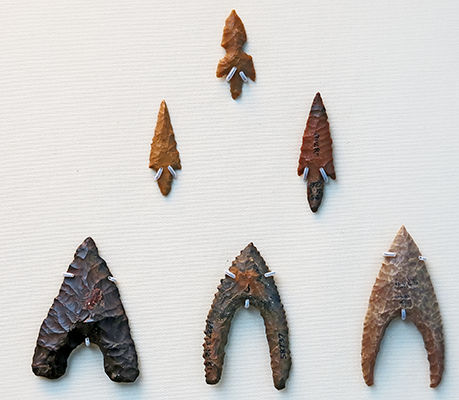
The Fayum Neolithic - Tools for hunting: arrowheads, 5 200 - 4 200 BC
Several types of arrowheads were used by the Fayum people. The point with notched edges was borrowed from the Levant. Tanged points were rare.
Most characteristic were those with concave bases. These were effective weapons. On the shores of the Fayum lake, examples were found embedded in the bones of a hippopotamus and elephant.
Catalog: Fayum, Fayum Neolithic, EA83063, EA58740, EA58744, EA58733, EA58736, EA58738
( note that the superb example in the middle of the bottom row is clearly marked as 58737 - Don )
Photo: Don Hitchcock 2015
Source: Original, British Museum
Text: Card at the British Museum © Trustees of the British Museum, CC BY-NC-SA 4.0
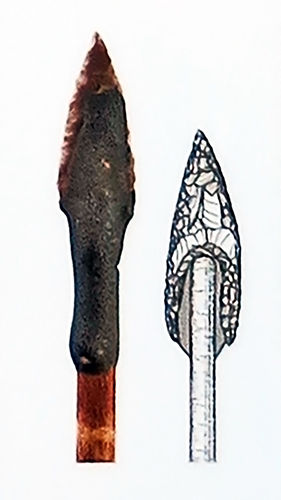
The Fayum Neolithic - Tools for hunting: arrowheads, 5 200 - 4 200 BC
Concave base arrowheads were attached to shafts using a resin adhesive.
The 'wings' at the base were intended to strengthen this join.
They were originally covered entirely by the adhesive, as shown at left.
Photo: © Ashmolean Museum, Oxford
Rephotography: Don Hitchcock 2015
Source: Poster, British Museum
Text: Poster at the British Museum © Trustees of the British Museum, CC BY-NC-SA 4.0, © Ashmolean Museum, Oxford
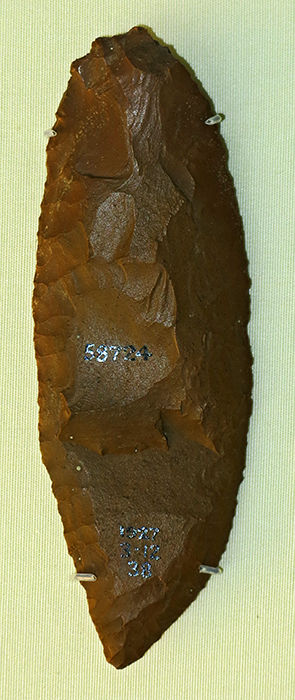
The Fayum Neolithic - Tools for hunting: knife for butchery, 5 200 - 4 200 BC
Knives for hunting and butchery were always in demand. This example has been worked to a fine edge on both sides.
Catalog: Fayum, Fayum Neolithic, EA58724
Photo: Don Hitchcock 2015
Source: Original, British Museum
Text: Card at the British Museum © Trustees of the British Museum, CC BY-NC-SA 4.0
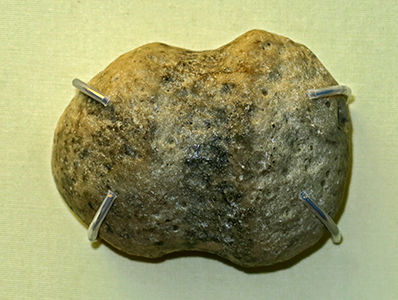
The Fayum Neolithic - Tools for hunting: a waisted stone, 5 200 - 4 200 BC
Small, oval-shaped pieces of limestone with a groove around the middle were numerous at Fayum sites. They may have been used as hammer stones or with sling shots.
( this waisted stone is exactly the right shape for a net weight, and its small size indicates that it (and many others) would have been used on the edges of a cast net (rather than a drag net, which needs heavier weights as well as floats) to catch fish from the nearby lake. They would have been used again and again, being transferred to a new net when the old one needed to be replaced.
The groove serves to accept a tightly knotted cord around the waist of the stone, which is then attached to the edge of the net. This is a standard design for a net weight, or, indeed, with a much larger rock and strong rope, as an anchor for a small boat.
A circular cast net cannot be used effectively in water that is deeper than its radius, but is ideal for catching small fish in up to waist deep water when the size of mesh is adapted for the intended catch. The fish can either be eaten or used as bait for larger fish using a rod and line - Don )
Catalog: Fayum, Kom K, Fayum Neolithic, EA58760
Photo: Don Hitchcock 2015
Source: Original, British Museum
Text: Card at the British Museum © Trustees of the British Museum, CC BY-NC-SA 4.0
Wooden netting needle, 138 mm.
Netting needles are essential for making nets for any purpose, whether for net bags or for fishing or bird nets.
From Lahun, which is a site beside the Bahr Yussef, the canal connecting Lake Qarun to the Nile. Fish nets used there would possibly have been placed across the entire narrow waterway to catch fish moving up or down the waterway.
Place: Lahun (Fayum (governorate) / Egypt D - K / Egypt)
Period: Late Middle Kingdom, circa 1850 BC - 1750 BC
Catalog: UC7264
Photo (upper): Don Hitchcock 2015
Photo (lower): © 2015 University College London. This work by the Petrie Museum of Egyptian Archaeology UCL is licensed under a CC BY-NC_SA licence.
Text: http://petriecat.museums.ucl.ac.uk/
Source: Original, Petrie Museum, London, England
Text: Card / online catalogue, the Petrie Museum, © 2015 UCL. CC BY-NC-SA license.
(left) Linen net from Lahun (Fayum governorate), late Middle Kingdom.
( this net seems to have been made using the classic sheet bend knot, except on what looks like the original edge of the net on the left of the image, where a different knot has been used. The size of mesh would have been ideal to catch larger fish, although the card with it says that it formed the base of a netting bag. A peg board would have had to have been used to create such a uniform net size - Don )
(right) A roll of linen net in good condition, also from Lahun, late Middle Kingdom.
Place: Lahun (Fayum (governorate) / Egypt D - K / Egypt)
Period: Late Middle Kingdom, circa 1850 BC - 1750 BC
Catalog: UC7512
Photo: Don Hitchcock 2015
Text: http://petriecat.museums.ucl.ac.uk/
Source: Original, Petrie Museum of Egyptian Archaeology, University College London
Valley of Sacrifices at Nabta Playa
4600 BC - 4400 BC
As the climate turned increasingly hostile, from about 4 600 BC, Nabta Playa became a ceremonial centre where scattered groups could gather. The wadi (valley) that fed rain water into the playa (seasonal lake) is called the Valley of Sacrifices. It contains a remarkable collection of stone monuments revealing the desert population's efforts to secure divine influence in their struggle for survival.
Erected near the centre of the wadi was a small ring of upright stones, with sets of larger slabs positioned to locate sunrise at the summer solstice. This was the beginning of the rainy season and probably signalled the start of the ceremonies.
To the north, stone mounds (tumuli) marked the burials of sacrificed animals. Further south, huge slabs were set up in long lines, possibly positioned to aid astronomical observations. Near them other clusters of megaliths may have commemorated the ancestral dead. This ceremonial complex reflects a structured society, with priests or shamans to lead the rituals and chiefs to command the labour.
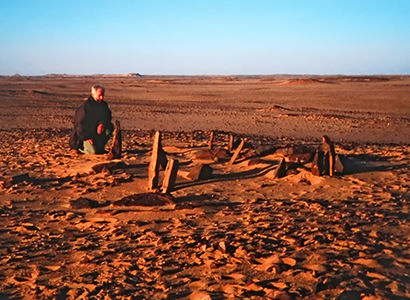
View of the calendar circle in situ at Nabta Playa.
Photo: Courtesy of the combined Prehistoric Expedition and Wendorf Archive (British Museum) © Trustees of the British Museum, CC BY-NC-SA 4.0
Source: Poster, British Museum © Trustees of the British Museum, CC BY-NC-SA 4.0
Rephotography: Don Hitchcock 2015
Text: poster at the Museum © Trustees of the British Museum, CC BY-NC-SA 4.0
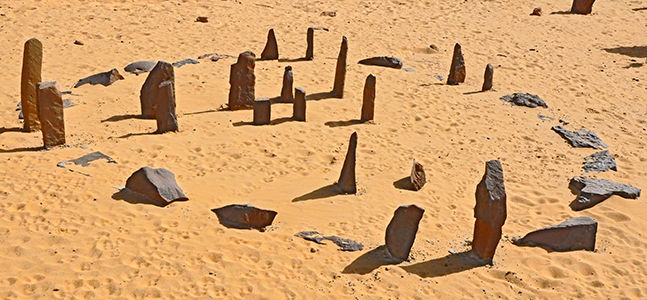
Nabta Playa Calendar Circle, reconstructed at Aswan Nubia museum.
Photo: Raymbetz
Permission: Creative Commons Attribution-Share Alike 3.0 Unported license.
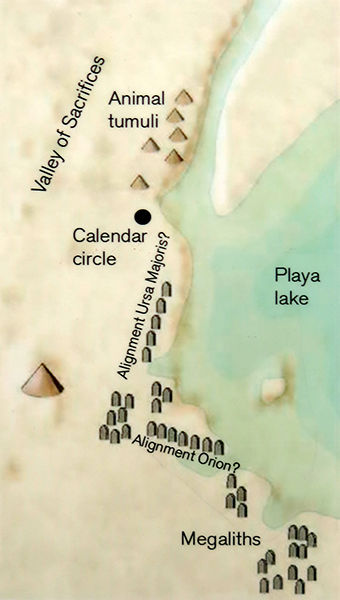
Map of the Valley of Sacrifices at Nabta Playa.
Archaeological discoveries reveal that these prehistoric peoples led livelihoods seemingly at a higher level of organisation than their contemporaries who lived closer to the Nile Valley. The people of Nabta Playa had above-ground and below-ground stone construction, villages designed in pre-planned arrangements, and deep wells that held water throughout the year.
Findings also indicate that the region was occupied only seasonally, most likely only in the summer period, when the local lake filled with water for grazing cattle.
Comparative research indicated that the indigenous inhabitants may have a significantly more advanced knowledge of astronomy and mathematics than previously thought possible.
By the 6th millennium BC, evidence of a prehistoric religion or cult appears, with a number of sacrificed cattle buried in stone-roofed chambers lined with clay. It has been suggested that the associated cattle cult indicated in Nabta Playa marks an early evolution of Ancient Egypt's Hathor cult.
By the 5th millennium BC these peoples had fashioned what may be among the world's earliest known archeoastronomical devices (roughly contemporary to the Goseck circle in Germany and the Mnajdra megalithic temple complex in Malta). These include alignments of stones that may have indicated the rising of certain stars and a 'calendar circle' that indicates the approximate direction of summer solstice sunrise. 'Calendar circle' may be a misnomer as the spaces between the pairs of stones in the gates are a bit too wide, and the distances between the gates are too short for accurate calendar measurements." An inventory of Egyptian archaeoastronomical sites for the UNESCO World Heritage Convention evaluated Nabta Playa as having 'hypothetical solar and stellar alignments.'
Claims for early alignments and star maps
Astrophysicist Thomas G. Brophy suggests the hypothesis that the southerly line of three stones inside the Calendar Circle represented the three stars of Orion’s Belt and the other three stones inside the calendar circle represented the shoulders and head stars of Orion as they appeared in the sky. These correspondences were for two dates—circa 4 800 BC and at precessional opposition - representing how the sky 'moves' long term. Brophy proposes that the circle was constructed and used circa the later date, and the dual date representation was a conceptual representation of the motion of the sky over a precession cycle.
Near the Calendar Circle, which is made of smaller stones, there are alignments of large megalithic stones. The southerly lines of these megaliths, Brophy shows, aligned to the same stars as represented in the Calendar Circle, all at the same epoch, circa 6 270 BC. The Calendar Circle correlation with Orion's belt occurred between 6 400 BC and 4 900 BC, matching the radio-carbon dating of campfires around the circle.
Photo: Courtesy of the combined Prehistoric Expedition and Wendorf Archive (British Museum) © Trustees of the British Museum, CC BY-NC-SA 4.0
Source: Poster, British Museum © Trustees of the British Museum, CC BY-NC-SA 4.0
Rephotography: Don Hitchcock 2015
Text: poster at the Museum © Trustees of the British Museum, CC BY-NC-SA 4.0
Additional text: Wikipedia
Beginnings in Upper Egypt
Badarian: 4 400 - 4 000 BC
The earliest agricultural society in Upper Egypt is called Badarian after sites excavated by a team part-sponsored by the British Museum in the 1920s.Text above: poster at the Museum © Trustees of the British Museum, CC BY-NC-SA 4.0
Badarian farmers lived in small villages and cultivated wheat, barley and flax. Using the desert's edge for burials, they placed distinctive pieces of 'rippled' pots and other objects in the graves. Their pottery and flint tools show links to earlier desert dwellers, while their burial practices and imagery anticipate the Predynastic period that followed.
El Badari contains an archaeological site with numerous Predynastic cemeteries (notably Mostagedda, Deir Tasa and the cemetery of El Badari itself), as well as at least one early Predynastic settlement at Hammamia. The finds from El Badari form the original basis for the Badarian culture, the earliest phase of the Upper Egyptian Predynastic period. The area stretches for 30 km along the east bank of the Nile, and was first excavated by Guy Brunton and Gertrude Caton-Thompson between 1922 and 1931. Most of the cemeteries in the Badarian region have yielded distinctive pottery vessels (particularly red-polished ware with blackened tops), as well as terracotta and ivory anthropomorphic figures, slate palettes, stone vases and flint tools. The contents of Predynastic cemeteries at El Badari have been subjected to a number of statistical analyses attempting to clarify the chronology and social history of the Badarian period.Text above: Wikipedia
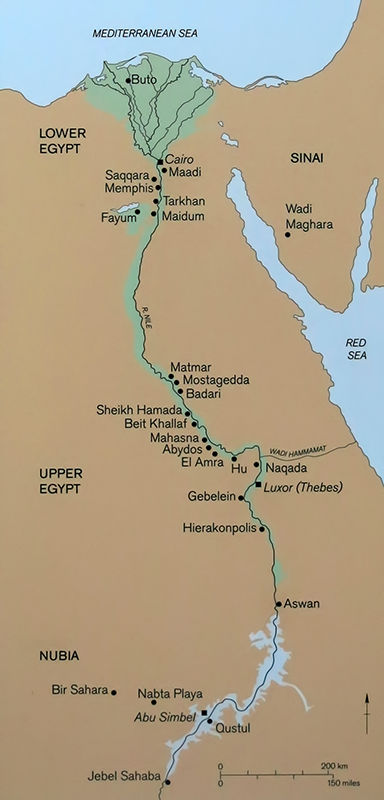
Map of the major sites and places in Early Egypt.
This map shows the position of the important Badarian sites of Mostagedda and Badari.
Photo: Poster, British Museum © Trustees of the British Museum, CC BY-NC-SA 4.0
Rephotography: Don Hitchcock 2015
Text: poster at the Museum © Trustees of the British Museum, CC BY-NC-SA 4.0
Despite the existence of some excavated settlement sites, the Badarian culture is mainly known from cemeteries in the low desert. All graves are simple pit burials, often incorporating a mat on which the body was placed. Bodies are normally in a loosely contracted position, on the left side, head to the south, looking west. Graves of very young children are lacking. There is sufficient evidence to show that these were buried within the settlement, or rather within parts of the settlements that were no longer used.Text above: Shaw (2000)
Analysis of Badarian grave goods demonstrates an unequal distribution of wealth. In addition, the wealthier graves tend to be separated in one part of the cemetery. This clearly indicates social stratification, which still seems limited at this point in Egyptian prehistory, but which became increasingly important throughout the subsequent Naqada Period.
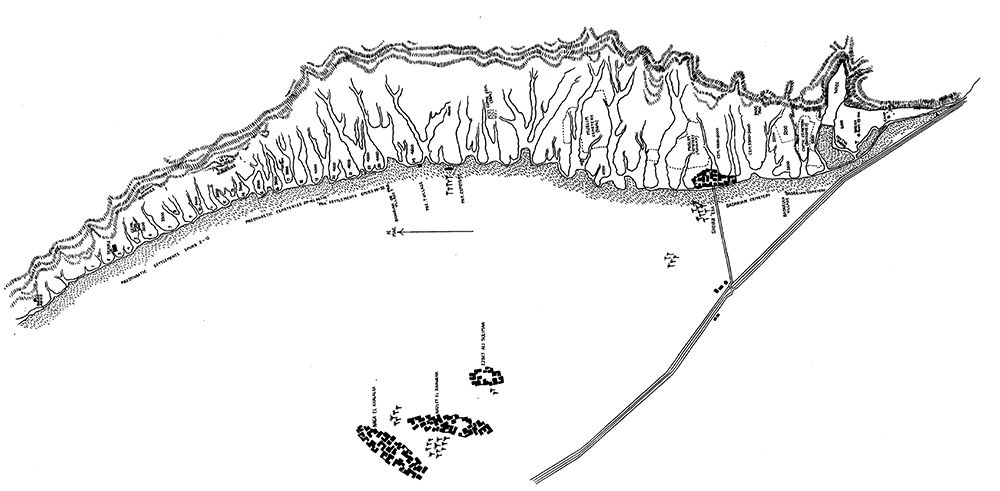
Sketch map of the Badari District.
Photo: Brunton and Caton-Thompson (1928)
The pottery that accompanies the dead in their graves is the most characteristic element of the Badarian culture. All pottery is made by hand, from Nile silts, which, except for the very fine wares, always has a very fine organic temper. This very characteristic temper is always finer than that used for the so-called rough ware during the Naqada Period. For their best products, the Badarian potters spared no efforts in refining the clay and obtaining very thin walls, which have never been equalled in any subsequent period of the Egyptian past.Text above: Brunton and Caton-Thompson (1928)
( All potters can understand this drive for thinness of the walls of vessels. It is an indicator of the skill of the potter, and has the advantage of using less materials, but more importantly of providing significantly different and valuable trade goods which are lighter to transport - Don )
Pottery shapes are simple, mainly comprising cups and bowls with direct rims and rounded base. A significant proportion of the vessels are black topped, but they generally have a more brownish surface than the Naqada I black-topped pottery. Red slip, with which the Naqada I black-topped pottery is covered, is far more exceptional for the Badarian. The most characteristic element of the Badarian pottery is the 'rippled surface' that is present on the finest pottery, meaning that the surface has been combed with an instrument and afterwards polished, resulting in a very decorative effect.
Carinated vessels (Carinate is a shape in pottery, glassware and artistic design usually applied to amphorae or vases. The shape is defined by the joining of a rounded base to the sides of an inward sloping vessel. Wikipedia) are also considered highly characteristic of the culture, but decorated pottery is rare: occasionally, incised, white-filled, geometrical motifs have been applied, perhaps imitating basketry.
The lithic industry is mainly known from settlement sites, although the finest examples have been found in graves. It is principally a flake and blade industry, to which a limited number of remarkable bifacial worked tools are added. Predominant tools are end-scrapers, perforators, and retouched pieces. Bifacial tools consist mainly of axes, bifacial sickles, and concave-base arrowheads. It should also be noted that the characteristic side-blow flakes were also present in the Western Desert.
Other products of the Badarian culture include such personal items as hairpins, combs, bracelets, and beads in bone and ivory. The repertoire of greywacke cosmetic palettes was at this date limited to long rectangular or oval shapes, but they would later become very characteristic aspects of the Naqada culture, when they were produced in a great variety of shapes. A few clay and ivory female statuettes have been found, varying immensely in style from fairly realistic examples to others that are highly stylised. It should also be noted that hammered copper was present in limited quantities.
For a long time it was thought that the Badarian culture remained restricted to the Badari region. However, characteristic Badarian finds have also been made much further to the south, at Mahgar Dendera, Armant, Elkab, and Hierakonpolis, and also to the east, in the Wadi Hammamat.
Originally, the Badarian culture was considered a chronologically separate unit, out of which the Naqada culture developed. However, the situation is certainly far more complex. For instance, the Naqada period seems to be poorly represented in the Badari region; therefore, it has been suggested that the Badarian was largely contemporary with the Naqada I culture in the area to the south of the Badari region. How- ever, since a limited number of Badarian or Badarian-related artefacts have also been discovered south of Badari, it might instead be argued that the Badarian culture was present between at least the Badari region and Hierakonpolis.
Unfortunately most of these finds are very limited in number, and a comparison with the lithic industry or the settlement ceramics from the Badari area is in most cases impossible or has not yet been published. The Badarian culture may, therefore, have been characterised by regional differences, the unit in the Badari region itself being the only one that has so far been properly investigated or attested. On the other hand, a more or less 'uniform' Badarian culture may have been represented over the whole area between Badari and Hierakonpolis, but, since the development of the Naqada culture took place more to the south, it seems quite possible that the Badarian survived for a longer time in the Badari region itself. The origins of the Badarian are equally problematic, having been sought in all directions. For a long time the Badarian was considered to have emerged from the south, because it was thought that the Badarians had 'poor knowledge' of chert, which would show that they came from the non-calcareous part of Egypt to the south; on the other hand, the origins of agriculture and animal husbandry were assumed to lie in the Near East. The theory that the Badarian originated in the south is, however, no longer accepted.
The selection of chert is perfectly logical for the Badarian lithic technology, which seems to show links with the Late Neolithic from the Western Desert. Rippled pottery, one of the most characteristic features of the Badarian, probably developed from burnished and smudged pottery, which is present both in late Sahara Neolithic sites and from Merimda in the north down to the Khartoum Neolithic sites in the south. Rippled pottery may thus have been a local development of a Saharan tradition. It seems obvious that the Badarian culture did not appear from a single source, although the Western Desert was probably the predominant one. On the other hand, the provenance of domesticated plants remains controversial: an origin in the Levant, via the Lower Egyptian Faiyum and Merimda cultures, might be possible. Evidence from Badarian settlements shows that the economy of the culture was primarily based on agriculture and husbandry. Among the contents of storage facilities, wheat, barley, lentils, and tubers have been found.
A number of circular constructions at Hamrnamiya, previously identified as houses, most probably represent small animal enclosures. In some of them, 20-30 cm thick layers of sheep or goat droppings have been found. Furthermore, fishing was certainly very important, and may have been the principal economic activity during certain periods of the year. Hunting, on the other hand, was apparently only of marginal importance.
Settlement sites in the Badari region show a pattern of small villages or hamlets, which seem to have moved horizontally after fairly short periods of occupation. Storage pits and vessels are the most obvious features in these sites, which is, of course, partially due to their preferential preservation. The constructions are all very light and seem in most cases to have been temporary. Indeed, it is quite possible that the settlements on low desert spurs that are attested in the Badari region are only marginal outliers or seasonal encampments.
On that basis, the larger, permanent settlements would have been closer to the flood- plain and would have long ago either been washed away by the Nile or covered with alluvium, thus remaining unknown. The temporary character of Badarian settlements is confirmed at Mahgar Dendera, about 150 km. to the south of Badari. The site was seasonally used from the end of the low-water season onwards, at the moment when the harvest was finished and when areas of land suitable for herding had to be looked for along the Nile, within the alluvial plain.
Besides herding, the second economic activity at Mahgar Dendera was fishing, which was practised in the main channel of the Nile, while it was at its lowest level. At Mahgar Dendera, the alluvial plain is very small; therefore, the site is both close to the Nile and out of reach of the inundation, allowing people to stay at the same place when the inundation started and even at its highest point.
During this period, when the living conditions reached an annual low, a part of the flock, mainly young males, seems to have been butchered. People had left Mahgar Dendera before the alluvial plain became fordable, because at that time they had to start working the fields, which cannot have been situated at Mahgar Dendera because of the limited floodplain. Only limited information is available concerning the foreign contacts of the Badarian culture. Relations with the Red Sea are attested through the presence of Red Sea shells in graves, while copper ore may have come from the Eastern Desert or the Sinai. The latter may also have already been the source of turquoise but recently the identification of turquoise from Badarian contexts was shown to be erroneous. If there were contacts between the Badari region and the Sinai, they most probably passed through the Eastern Desert rather than Lower Egypt, where there appear to be no indications of the Badarian culture. This possibility of Badari - Sinai links through the Eastern Desert may eventually be confirmed by reported finds from the Wadi Hammamat, which unfortunately are still not fully published.
Badarian: 4 400 BC - 4 000 BC
Pottery
These three pottery cups were joined by a cross-bar. A cross line design in dark red paint on pinky buff ground has been used to decorate the cups. One cup which has broken off has had its edges filed in ancient times. Another cup is broken, with rough broken edges. From tomb 23/1649.
( I have been unable to find out what rite this piece was used for - Don )
Accession Number LDUCE-UC9506
Photo: Don Hitchcock 2018
Source: Original, Petrie Museum, London, England
Text: Card / online catalogue, the Petrie Museum, © 2015 UCL. CC BY-NC-SA license.
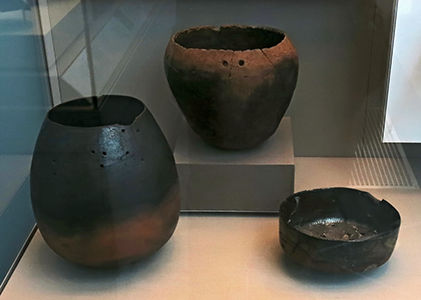
Badarian: 4 400 BC - 4 000 BC
Pottery
Some pots were used for cooking, but for serving food the Badarians made some of the finest pottery ever produced in Egypt. Formed by hand, the walls are eggshell thin. The best were lightly combed and then polished with a pebble to create a lustrous rippled appearance.
To blacken the top, the pot was placed in a bonfire upside down, with the rim buried in ashes. A few were also embellished with designs made with the polishing pebble. These motifs anticipate the decoration on the painted pottery of the Early Predynastic period.
Catalog: EA59691, EA62321, EA59628
Photo: Don Hitchcock 2015
Source: Original, British Museum
Text: Card at the British Museum, http://www.britishmuseum.org/, © Trustees of the British Museum, CC BY-NC-SA 4.0
Badarian: 4 400 BC - 4 000 BC
Pottery
Polished black-topped brown ware pottery jar with rounded base and in-drawn wall. Repaired in antiquity with 11 drilled holes flanking cracks on the upper body.
Height 230 mm, diameter 195 mm, weight 1008 grams
Catalog: El-Badari area 5100, Badarian, EA59691
Photo: © Trustees of the British Museum, CC BY-NC-SA 4.0
Source: Original, British Museum
Text: Card at the British Museum, http://www.britishmuseum.org/, © Trustees of the British Museum, CC BY-NC-SA 4.0
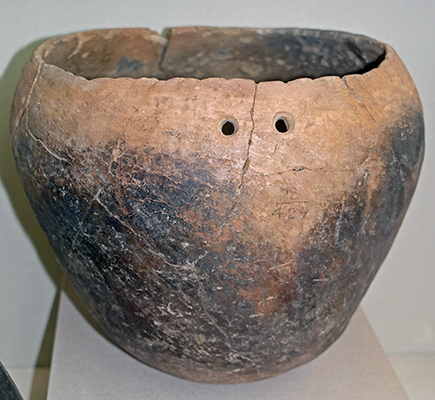
Badarian: 4 400 BC - 4 000 BC
Pottery
Blackened polished brown ware pottery jar with two mending-holes near the rim.
Height 182 mm, width 180 mm (rim)
Catalog: Mostagedda Grave 429, Badarian, EA62321
Photo: Don Hitchcock 2015
Source: Original, British Museum
Text: Card at the British Museum, http://www.britishmuseum.org/, © Trustees of the British Museum, CC BY-NC-SA 4.0
Badarian: 4 400 BC - 4 000 BC
Pottery
Badarian polished black-topped redware pottery bowl with radiating palm-leaf design in burnish on interior base. Vessel walls rippled vertically on the interior and exterior. Repaired from fragments.
The decoration is burnished as a fine line on the otherwise dull, unpolished interior surface on the base. Diameter 170 mm, height 70 mm, weight 366 grams. Made of very fine Nile Silt A.
Catalog: el-Badari Grave 4803, Badarian, EA59628
Photo: (left) © Trustees of the British Museum, CC BY-NC-SA 4.0
Photo: (right) Don Hitchcock 2018, showing the palm-leaf design on the interior base
Source: Original, British Museum
Text: Card at the British Museum, http://www.britishmuseum.org/, © Trustees of the British Museum, CC BY-NC-SA 4.0
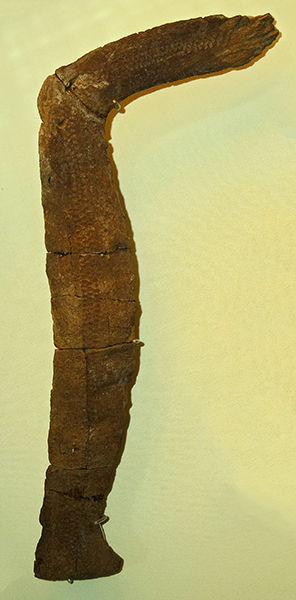
Badarian: 4 400 BC - 4 000 BC
Daily life: hunting
Throw stick
Hunting was an important activity for the Badarians. This wooden throw stick might have been used for hunting birds or antelopes. Down its centre is a pattern of dots, and carved chevrons appear at the handle.
Length: 380 mm, width 140 mm, thickness 22 mm.
Catalog: el-Badari 5716, Badarian, EA59703
Photo: Don Hitchcock 2015
Source: Original, British Museum
Text: Card at the British Museum, http://www.britishmuseum.org/, © Trustees of the British Museum, CC BY-NC-SA 4.0
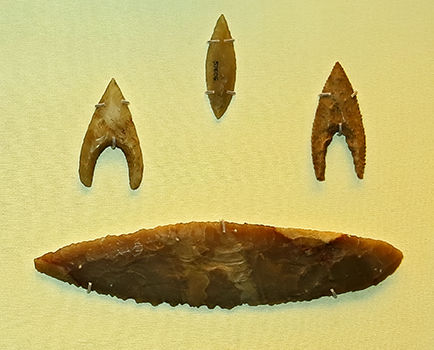
Badarian: 4 400 BC - 4 000 BC
Daily life: hunting
Arrowheads and knife
Larger animals were hunted with arrows, spears, and knives. These well-crafted weapons were socially significant and their quality reflected on the prestige of the hunter. The leaf-shaped arrow is one of the finest tools known from the Badarian culture. Concave-base arrows were more typical and varied.
(upper left) Flint arrow-head, concave or 'hollow' - based with incurving barbs, bifacially worked.
Length 50 mm, width 28 mm, thickness 10 mm, weight 5 grams.
Catalog: El-Badari, Grave 5120, EA59659
(upper centre) Leaf-shaped arrowhead of pale translucent flint, pointed at both ends. Carefully retouched bifacially.
Width 13 mm, length 45 mm.
Called a lens-shaped arrow-head by D. Holmes in Holmes (1989), this arrowhead and the three others like it found in the same tomb (see EA59650, EA59652) were considered to be amongst the finest examples of Badarian flint work known to the excavator.
Catalog: El-Badari Tomb-Group 5116, Badarian, EA57606
(upper right) Arrow-head of beige flint with concave or 'hollow' base with incurving barbs.
Length 50 mm, width 25 mm, thickness 6 mm, weight 5 grams.
Catalog: El-Badari, Grave 5148, EA59673<
(lower centre) Blade of a flint knife, worked both sides, with serrated edges, point broken.
Width 38 mm, length 154 mm.
Catalog: Mostagedda, Badarian, Tomb 468, EA62128
Photo: Don Hitchcock 2015
Source: Original, British Museum
Text: Card at the British Museum, http://www.britishmuseum.org/, © Trustees of the British Museum, CC BY-NC-SA 4.0
Badarian: 4 400 BC - 4 000 BC
Daily life: hunting
Fish hooks
Fish were an important part of the diet. Hooks made of shell were used to catch large deep-water fish, such as Nile perch or catfish. Smaller species were gathered mainly with nets or baskets.
Catalog: Mostagedda 474A, Badarian, EA62015, EA62016, Matura 2508, Badarian, EA63405
Photo: Don Hitchcock 2015
Source: Original, British Museum
Text: Card at the British Museum, © Trustees of the British Museum, CC BY-NC-SA 4.0

Badarian: 4 400 BC - 4 000 BC
Daily life: farming
Sickle blades
Badarian sickle blades typically have a tooth-like cutting edge. They were fitted into a wooden handle for use. Most other tools were simply made, but the effort taken to work both sides of these sickle blades shows how important the harvest was for survival.
In this well organised display, the sickle blades have been placed by Museum staff in a schematic handle and support, to show how they might have been used.
Catalog: Badari area 5773, Badarian, EA59713, EA59714, EA59715
Photo: Don Hitchcock 2015
Source: Original, British Museum
Text: Card at the British Museum, © Trustees of the British Museum, CC BY-NC-SA 4.0
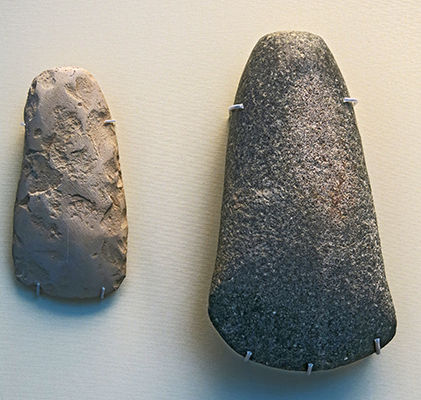
Badarian: 4 400 BC - 4 000 BC
Daily life: farming
Stone celts
Ground stone axes or 'celts' were used as hoes or in wood-working. The limestone celt on the left was probably made locally, but the large dark igneous rock example may have been imported from the deserts to the south east.
Catalog: Mostagedda area 1000, Badarian, EA62019, Matmar area 2718, Badarian, EA63404
Photo: Don Hitchcock 2015
Source: Original, British Museum
Text: Card at the British Museum, © Trustees of the British Museum, CC BY-NC-SA 4.0
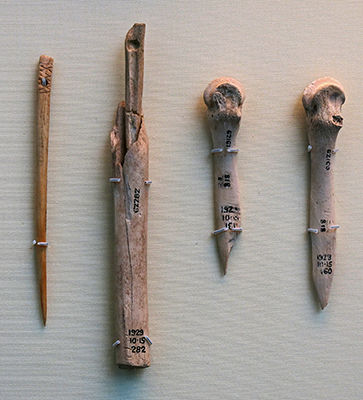
Badarian: 4 400 BC - 4 000 BC
Daily life: farming
Bone needles and awls
Needles and awls crafted from animal bone were used for sewing clothing made of hides or linen. Such tools were often found in the graves of men.
Bone needle on left: Mostagedda, EA62202, height 104 mm, width 5 mm, depth 5 mm.
Tubular bone needle-case second from left: Mostagedda, 100, EA62282, length: 103 mm, width 17 mm, depth 10 mm, weight 16 grams.
Bone needle in needle-case second from left: Mostagedda, 2712, EA62269, length 86 mm, width 7 mm, depth 5 mm.
Bone awl second from right: Mostagedda, 818, EA62161, length 78 mm, width 16 mm, depth: 12 mm.
Bone awl on far right: Mostagedda, 818, EA62160, length: 90 mm, width 18 mm, depth 12 mm, weight 5 grams.
Photo: Don Hitchcock 2015
Source: Original, British Museum
Text: Card at the British Museum, http://www.britishmuseum.org/, © Trustees of the British Museum, CC BY-NC-SA 4.0
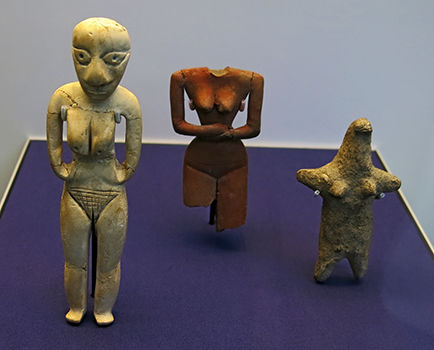
Badarian: 4 400 BC - 4 000 BC
Female figurines
These figurines are among the oldest known Egyptian sculptures of the human form. They began a long tradition of representing naked women with accentuated feminine attributes. Such statuettes were probably intended to provide magical support for rebirth in the afterlife. Boldly carved from hippopotamus ivory, or modelled from clay, they range from elegant to basic in style and achievement.
Catalog: Badari 5107, Badarian, EA59648
Badari 5227, Badarian, EA59679
Mostagedda area 2200, Badarian, EA62211
Photo: Don Hitchcock 2015
Source: Original, British Museum
Text: Card at the British Museum, © Trustees of the British Museum, CC BY-NC-SA 4.0
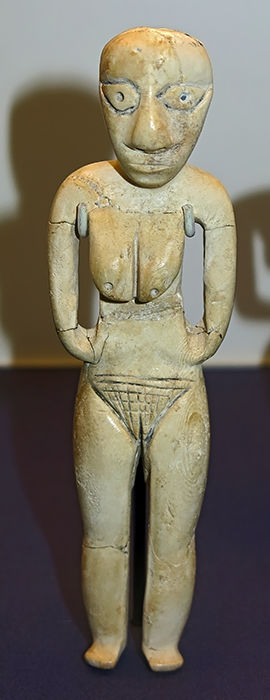
Badarian: 4 400 BC - 4 000 BC
Female figurine
Hippopotamus ivory figure of woman. Incised eyes and pubic triangle.
Height 140 mm, width 38 mm, depth 22 mm, weight 114 grams
This very remarkable female statuette is from the plundered grave 5107. No bones remained in the grave. Loose in the filling, in addition to the ivory figure, were a polishing pebble and a few cylinder beads of steatite and turquoise.
Catalog: el Badari 5107, Badarian, EA59648
Photo: Don Hitchcock 2015
Source: Original, British Museum
Text: Card at the British Museum, http://www.britishmuseum.org/, © Trustees of the British Museum, CC BY-NC-SA 4.0
Additional text: Brunton and Caton-Thompson (1928)
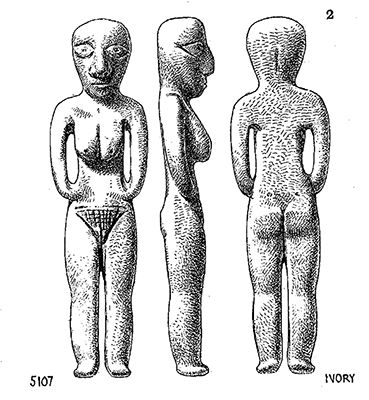
Badarian: 4 400 BC - 4 000 BC
Female figurine
This valuable drawing by the discoverer of the venus from grave 5107 shows front, back, and side views.
Photo: Brunton and Caton-Thompson (1928)
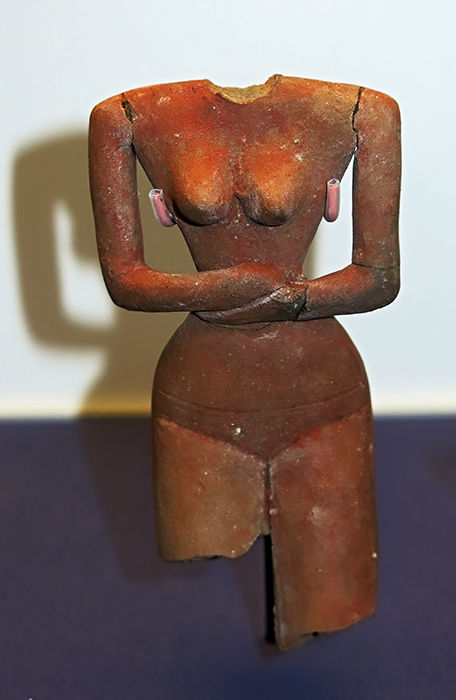
Badarian: 4 400 BC - 4 000 BC
Female figurine from the plundered grave 5227.
Terracotta female figure. Head and legs lost.
Height 93 mm, width 50 mm, thickness 45 mm, weight 62 grams
Catalog: el Badari 5227, Badarian, EA59679
Photo: Don Hitchcock 2015
Source: Original, British Museum
Text: Card at the British Museum, http://www.britishmuseum.org/, © Trustees of the British Museum, CC BY-NC-SA 4.0
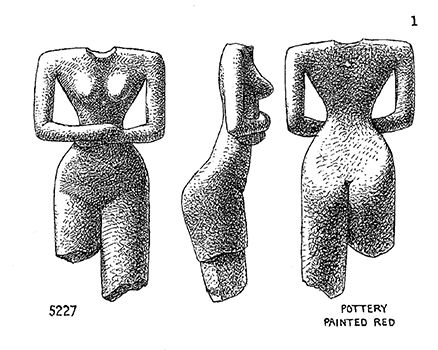
Badarian: 4 400 BC - 4 000 BC
Female figurine
This drawing by the discoverer of the venus from grave 5227 shows front, back, and side views, and displays the exaggerated hip to waist ratio of the original pottery figurine.
Photo: Brunton and Caton-Thompson (1928)
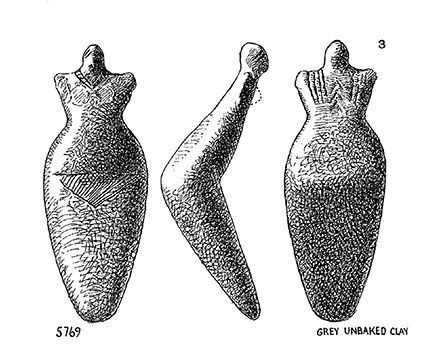
Badarian: 4 400 BC - 4 000 BC
Female figurine
This drawing by the discoverer of the venus from grave 5769 shows front, back, and side views.
This venus is more schematic in dimensions, and, like some totally unrelated palaeolithic venuses from Europe, shows the figure as being bent forwards.
The venus is in unfired clay, and the breasts have been knocked or rubbed off, the approximate outline being shown in the side view. It was found wrapped in cloth in a small pot.
Photo: Brunton and Caton-Thompson (1928)
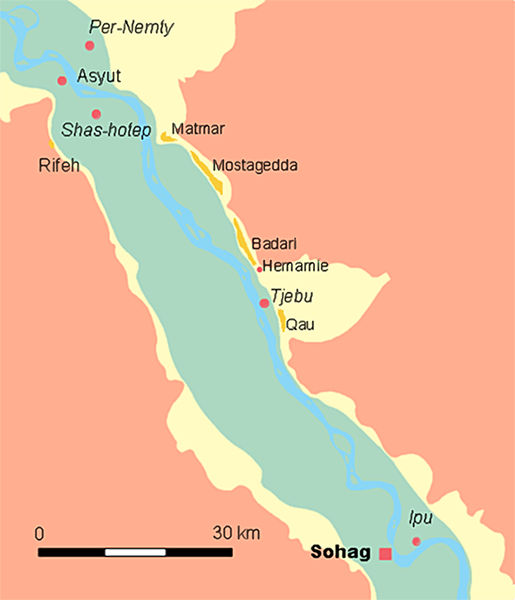
Map of the Matmar - Mostagedda - Badari - Qau area
Photo: http://www.ucl.ac.uk/museums-static/digitalegypt//maps/assiut-achmim.html
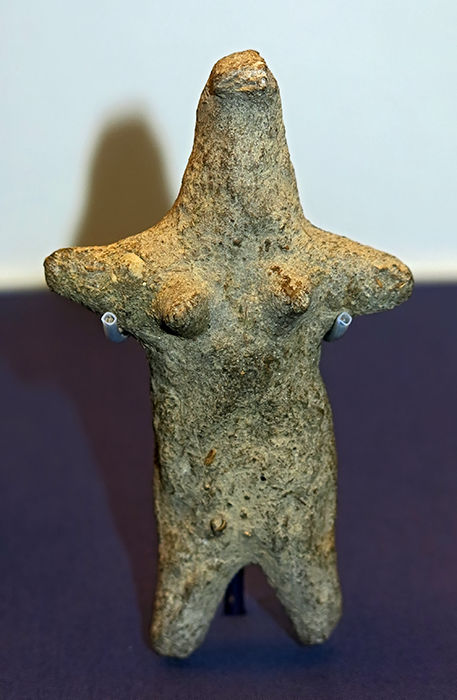
Badarian: 4 400 BC - 4 000 BC
Female figurine in pottery
Height 90 mm, width 53 mm, depth 25 mm, weight: 44 grams
Catalog: Mostagedda area 2200, Badarian, EA62211
Photo: Don Hitchcock 2015
Source: Original, British Museum
Text: Card at the British Museum, http://www.britishmuseum.org/, © Trustees of the British Museum, CC BY-NC-SA 4.0
Badarian: 4 400 BC - 4 000 BC
Ivory female figurine displayed in Musée du Louvre.
Height 87 mm
( note that this piece is very naturalistic, apart from the exaggeration of the size of the head and features of the face such as the eyes and eyebrows. The view of the back of the figure could be sculpted from life of a young woman acting as a model for the sculptor - Don )
Catalog: E 11887
Photo (left): Guillaume Blanchard
Permission: Creative Commons Attribution-Share Alike 1.0 Generic license
Photo (right): http://cartelen.louvre.fr/
Source: Original, Musée du Louvre
Text: http://cartelen.louvre.fr/
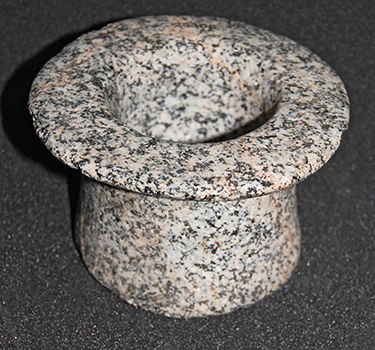
Badarian: 4 400 BC - 4 000 BC
Stone Jar
( This jar made of diorite with a ledge rim, while basic in shape, represents a big step forward in technology, since the methods required are sophisticated and demanding. The techniques were not fully developed until the Early Dynastic Period. - Don )
Height 90 mm, diameter 150 mm, weight 1730 grams
Catalog: EA29306
Photo: © Trustees of the British Museum, CC BY-NC-SA 4.0
Source: Original, British Museum
Text: http://www.britishmuseum.org/, © Trustees of the British Museum, CC BY-NC-SA 4.0
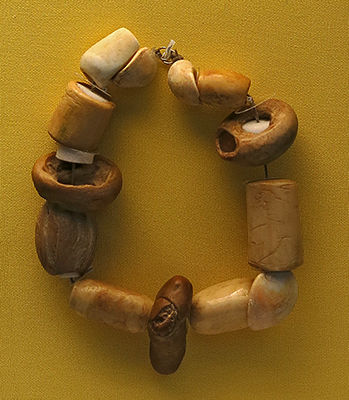
Badarian: 4 400 BC - 4 000 BC
Grave of a man
Bracelet consisting of two large cylinders and three barrel beads, all of bone, three flint pebbles, three Nerita and one Conus shell, and one long melon bead with ribbed surface, of ivory. The bone beads have a very wide boring. The largest barrel is slightly 'collared' at the ends.
Jewellery, pottery, and cosmetic palettes were buried with both men and women.
Found at Mostagedda, Grave 1215, in the position where the hands would have been in a male burial.
Length 170 mm, width: 20 mm, depth 20 mm
Catalog: Mostagedda, Grave 1215, Badarian, EA62171
Photo: Don Hitchcock 2015
Source: Original, British Museum
Text: Card at the British Museum, http://www.britishmuseum.org/, © Trustees of the British Museum, CC BY-NC-SA 4.0
Badarian: 4 400 BC - 4 000 BC
Grave of a man
Bone needles.
Bone needles and other tools were more often given to men than to women.
(left) Length 87 mm, width 8 mm, depth 7 mm weight 4 grams.
( note that the left hand image of a 'needle', as classified in the online catalog, does not have an eye. It looks more like an awl - Don )
Catalog (left): Mostagedda, Grave 1215, Badarian, EA62173
Photo (left): © Trustees of the British Museum, CC BY-NC-SA 4.0
Catalog (right): Unknown, this needle does have an eye. It was in the group labelled EA62170-3 on the museum card.
Photo (right): Don Hitchcock 2015
Source: Original, British Museum
Text: Card at the British Museum, http://www.britishmuseum.org/, © Trustees of the British Museum, CC BY-NC-SA 4.0
Badarian: 4 400 BC - 4 000 BC
Grave of a man
Rectangular grey siltstone cosmetic palette, with smooth surfaces and slightly concave ends.
Length 140 mm, width 38 mm, thickness 6 mm.
Catalog: Mostagedda, Grave 1215, Badarian, EA62172
Photo: Don Hitchcock 2015
Source: Original, British Museum
Text: Card at the British Museum, http://www.britishmuseum.org/, © Trustees of the British Museum, CC BY-NC-SA 4.0
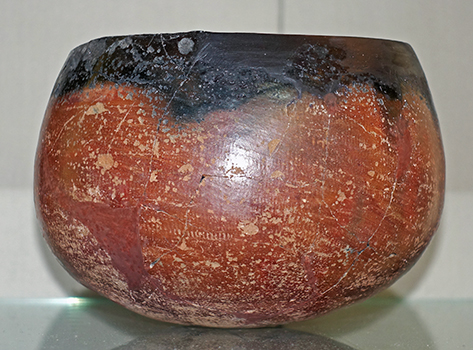
Badarian: 4 400 BC - 4 000 BC
Grave of a man
Black-topped brown ware pottery bowl with a faint ripple.
Height 95 mm, diameter 125 mm, weight 268 grams.
( note that this bowl was in the same display case as the palette, needle and bracelet above, and apparently from the same grave, but is listed on the British Museum catalog as being from grave 1214, not 1215 - Don )
Catalog: Mostagedda, Grave 1214, Badarian, EA62170
Photo: Don Hitchcock 2018
Source: Original, British Museum
Text: Card at the British Museum, http://www.britishmuseum.org/, © Trustees of the British Museum, CC BY-NC-SA 4.0
Badarian: 4 400 BC - 4 000 BC
Grave of a woman and child
String of seventeen Nerita shells.
Nerita is a genus of medium-sized to small sea snails with a gill and an operculum, marine gastropod molluscs in the family Neritidae, the nerites. Species of Nerita can be found worldwide in tropical waters in the middle and upper intertidal zones. They are gregarious herbivores.
Length 135 mm, thickness 10 mm.
In this intact burial, a tiny child was found within its mothers arms. The child wore a knobbed ivory bracelet and a necklace of exotic Nerita shells. The woman had a travertine cosmetic palette stained red and green, and a pebble for grinding the pigments. A large triangular limestone bead was her only jewel. The cooking pot was placed between her knees.
Length 140 mm, width 38 mm, thickness 6 mm.
Catalog: Mostagedda, Grave 2840, Badarian, EA62064
Photo: Don Hitchcock 2015
Source: Original, British Museum
Text: Card at the British Museum, http://www.britishmuseum.org/, © Trustees of the British Museum, CC BY-NC-SA 4.0

Badarian: 4 400 BC - 4 000 BC
String of beads
One carnelian cylinder bead (75P22), eighteen carnelian barrel beads (78D22, F11, H18), one spheroid crumb bead (82F8), black limestone carinated ring bead (86D8), garnet ring bead (86L14), a few green glazed steatite ring beads (86R15), amethyst barrel bead (86F11), two faience(?) drop beads (88K7), one carnelian drop bead (88H8), and one copper(?) spheroid bead. From Badari 6008. Xia Nai catalogue number 115
Materials: carnelian, limestone, garnet, steatite, amethyst, faience, copper.
Publications: Brunton, Guy. Qau and Badari I. pl. XI. pl. XVII. 75P22
Catalog: Badarian, UC27376
Photo: Don Hitchcock 2015
Source: Original, Petrie Museum, London, England
Text: Card / online catalogue, the Petrie Museum, © 2015 UCL. CC BY-NC-SA license.

Badarian: 4 400 BC - 4 000 BC
String of beads
Beads, string, marine shell and soapstone (steatite).
Catalog: Badari, Badarian Period, Tomb 25/5732, UC9092A
Photo: Don Hitchcock 2015
Source: Original, Petrie Museum
Text: Card at the Petrie Museum, http://petriecat.museums.ucl.ac.uk/, © 2015 UCL. CC BY-NC-SA license.

Badarian: 4 400 BC - 4 000 BC
String of beads
Ancillaria shell, stone, carnelian, glazed steatite.
String; 1 shell: Ancillaria (Olive snail, on right end), 1 barrel bead: grey limestone; 1 pebble: grey limestone, flattened barrel; 1 spheroid bead: carnelian; blue glazed steatite; ring-beads: soapstone and shell; calcite; very small.
Catalog: Badari, Badarian Period, Badari tomb 25/5718, UC9253
Photo: Don Hitchcock 2015
Source: Original, Petrie Museum
Text: Card at the Petrie Museum, http://petriecat.museums.ucl.ac.uk/, © 2015 UCL. CC BY-NC-SA license.
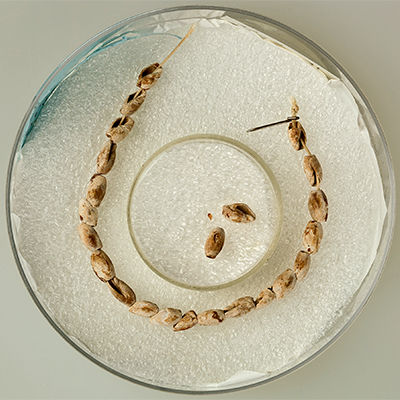
Badarian: 4 400 BC - 4 000 BC
String of Ancillaria shells
Length 160 mm.
Catalog: Matmar, Cemetery 3100, thrown out of grave, BSAE/Brunton excavations, 1931, 32.2.31
Photo: © The Metropolitan Museum of Art, NYC.
Source: http://www.metmuseum.org/art/collection/search/557617

Badarian: 4 400 BC - 4 000 BC
Man's Belt
Man's Belt; small turquoise or green glazed steatite beads.
Publications: Friedman, F.D.. Gifts of the Nile Ancient Egyptian Faience. Cat. No.1, p.74
Catalog: Badari, Badarian Period, from tomb 5735. Xia Nai catalogue number 1, UC9250
Photo: Don Hitchcock 2015
Source: Original, Petrie Museum, London, England
Text: Card / online catalogue, the Petrie Museum, © 2015 UCL. CC BY-NC-SA license.
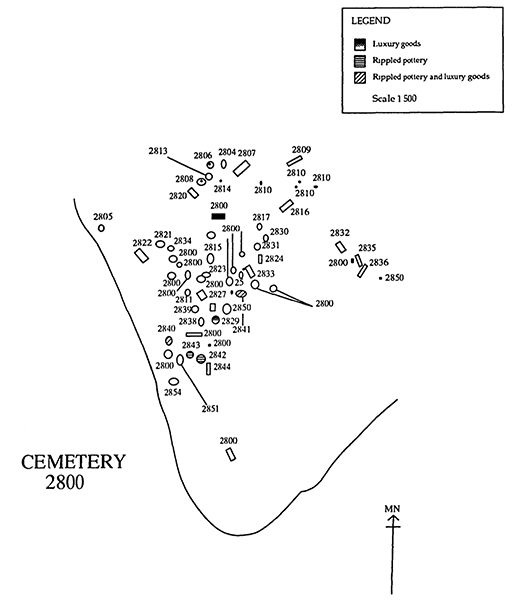
Mostagedda South: Map of the distribution of rippled pottery and luxury goods, including Grave 2840.
Photo: Anderson (1989)
Badarian: 4 400 BC - 4 000 BC
Grave of a woman and child
Travertine cosmetic palette stained red and green.
Length 72 mm, width 62 mm, thickness 13 mm, weight 137 grams
Catalog: Mostagedda, Grave 2840, Badarian, EA62058
Photo: Don Hitchcock 2015
Source: Original, British Museum
Text: Card at the British Museum, http://www.britishmuseum.org/, © Trustees of the British Museum, CC BY-NC-SA 4.0
Badarian: 4 400 BC - 4 000 BC
Grave of a woman and child
Brown stone pebble, used on the palette above to grind pigments.
Width 21 mm, length 29 mm.
Catalog: Mostagedda, Grave 2840, Badarian,EA62061
Photo: Don Hitchcock 2015
Source: Original, British Museum
Text: Card at the British Museum, http://www.britishmuseum.org/, © Trustees of the British Museum, CC BY-NC-SA 4.0
Badarian: 4 400 BC - 4 000 BC
Grave of a woman and child
Large stone convex biconical bead, with triangular section and wide longitudinal perforation.
Length 48 mm, width 39 mm
Catalog: Mostagedda, Grave 2840, Badarian, EA62059
Photo: Don Hitchcock 2015
Source: Original, British Museum
Text: Card at the British Museum, http://www.britishmuseum.org/, © Trustees of the British Museum, CC BY-NC-SA 4.0
Badarian: 4 400 BC - 4 000 BC
Grave of a woman and child
Hippopotamus ivory bangle. Slightly oval in shape, with a single knob in the form of a serpent's head. The outer rim of the bangle is bevelled in places but is not completely even, and the inner face is flat.
DimensionsDiameter: 4 centimetres (internal)Diameter: 4.7 centimetres (without knob)Height: 1.3 centimetres (knob)Thickness: 1 centimetresDiameter: 4.5 centimetres (min)Diameter: 6 centimetres (max)
Diameter 47/40 mm (external/internal), height 13 mm.
(knob) thickness 10 mm, diameter 60 mm/45 mm max/min.
Catalog: Mostagedda, Grave 2840, Badarian, EA62062
Photo: Don Hitchcock 2015
Source: Original, British Museum
Text: Card at the British Museum, http://www.britishmuseum.org/, © Trustees of the British Museum, CC BY-NC-SA 4.0
Badarian: 4 400 BC - 4 000 BC
Grave of a child
These ivory bangles were found on the arm of a three year old child. Heron feathers were put in his hair. By his face were pieces of sweet smelling resin and a rippled bowl similar to the one displayed here, EA62163.
The bangle in the photo on the left is EA62226 - an ivory bangle, oval in shape, broken vertically into many sections. A small portion is still missing. The outer face is bevelled, the inner is straight.
Width 7 mm, diameter 54mm / 32 mm (external / internal), depth 20 mm.
Catalog: EA62223 at top, EA62221 at centre left, EA62222 at centre right, EA62224 at centre bottom (Math, 2014)
Catalog: Mostagedda 2211, Badarian, EA62221-6 (EA62225 was not on display at the time of the photograph)
Mostagedda 1006, Badarian, EA62163
Photo: Don Hitchcock 2015, 2018
Source: Original, British Museum
Text: Card at the British Museum, http://www.britishmuseum.org/, © Trustees of the British Museum, CC BY-NC-SA 4.0
Extra reference: Math (2014)
Badarian: 4 400 BC - 4 000 BC
Jewellery and trade
The Badarians were fond of exotic materials for their jewellery. Most popular were brightly coloured shells gathered from the Red Sea, over 150 miles away.
A variety of decorative stones came from the desert in between, while turquoise originated from Sinai. These items may have been obtained by special expeditions, or by trade with nomadic people living in the deserts.
Shell beads (top three necklaces)
Seashells were especially favoured by women and children, and worn as necklaces, bracelets and anklets. The most common shell types were Ancillaria, Conus, Nerita, Oliva and Nautica. These were sometimes mixed with beads and pendants of stone and bone.
Catalog: Mostagedda 463, Badarian, EA62125
Mostagedda 2229, Badarian, EA62253
Mostagedda 595, Badarian EA62152
Carnelian beads
Carnelian (brownish-red mineral commonly used as a semi-precious gemstone) was available in the deserts, but is very hard and therefore difficult to work. As a result, it was rare in the Badarian period and is found mainly in wealthy burials. This necklace of carnelian and glazed steatite (green-blue beads) belonged to a man.
Catalog: Badari 5449, Badarian, EA59687
Steatite beads
Steatite is a form of talc found in Egypt's Eastern Desert. Soft and easily carved, it was a popular material for beads.
When heated it becomes hard and grey, but if fired in a bed of natron salt and malachite, it takes on a green-blue glaze.
Catalog: Mostagedda 2201, Badarian, EA62214
Mostagedda 472b, Badarian, EA62131
Photo: Don Hitchcock 2018
Source: Original, British Museum
Text: Card at the British Museum, http://www.britishmuseum.org/, © Trustees of the British Museum, CC BY-NC-SA 4.0
Badarian: 4 400 BC - 4 000 BC
Turquoise beads
Turquoise was a rare commodity, and came from southern Sinai. The single small bead near the centre of this strand of decorative stone beads was probably obtained by trade with desert peoples.
Catalog: Badari 5111, Badarian, EA59649
Copper beads
Copper was used by the Badarians, but little of it survives. They may have discovered it in the Eastern Desert as a naturally usable ore. These copper beads were hammered and rolled to shape from sheets, or twisted into spirals from wire.
Catalog: Mostagedda 596, Badarian, EA62158
Photo: Don Hitchcock 2015
Source: Original, British Museum
Text: Card at the British Museum, http://www.britishmuseum.org/, © Trustees of the British Museum, CC BY-NC-SA 4.0
Badarian: 4 400 BC - 4 000 BC
Grave of a trader
Contacts from far afield are illustrated by the objects found in one grave near Badari. The owner may have been a well-travelled trader, or a wealthy man with a taste for the exotic.
Photo: Friedman (1999)
Source: Original, British Museum
Text: Card at the British Museum, © Trustees of the British Museum, CC BY-NC-SA 4.0
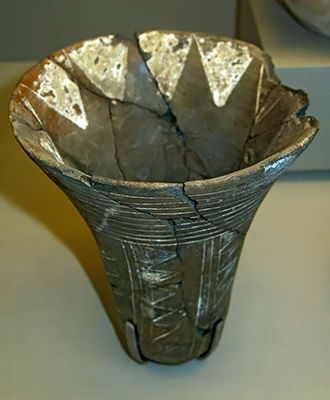
Badarian: 4 400 BC - 4 000 BC
Grave of a trader - Incised beaker
Contacts from far afield are illustrated by the objects found in one grave near Badari. The owner may have been a well-travelled trader, or a wealthy man with a taste for the exotic.
Beakers of this type were once thought to belong to the Tasian period, a time before the Badarian. Recent discoveries have shown that similar beakers were used by many peoples living in Nubia and the Egyptian deserts, with whom the Badarians interacted.
Brownware pottery beaker, incised decoration filled with white on exterior and interior, repaired from fragments.
Height 160 mm, diameter 138 mm
Catalog: Badari 569, Badarian, EA59723 (also recorded as EA59728 by Friedman (1999))
Photo: Don Hitchcock 2015
Source: Original, British Museum
Text: Card at the British Museum, http://www.britishmuseum.org/, © Trustees of the British Museum, CC BY-NC-SA 4.0
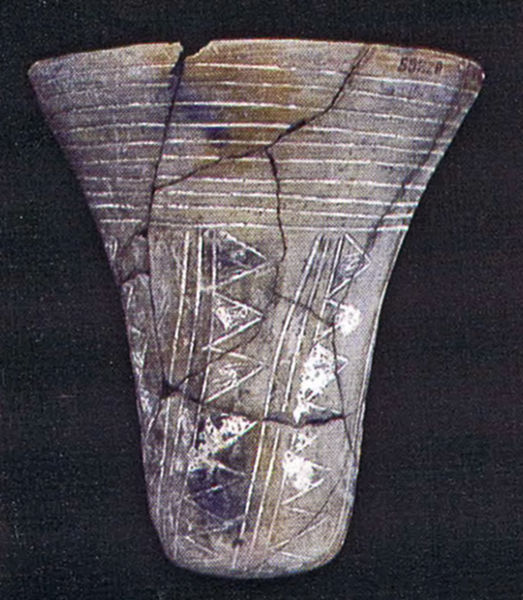
Badarian: 4 400 BC - 4 000 BC
Grave of a trader - Incised beaker
Based on his later work in Middle Egypt, Brunton (1929) identified another early ceramic producing culture in Upper Egypt that preceded the Badarian. He called it the Tasian. According to him this phase was characterised by two classes of pottery. One was comprised of deep biconical bowls with brown or greyish surfaces and the other of a series of flaring - lipped caliciform beakers made of black pottery decorated with incised designs filled with white pigment, the so-called Tasian beaker.
Finds made by Brunton and subsequent excavators leave little doubt that the beakers are contemporary with the Badarian period. Yet whether they are indicators of a separate culture or of a temporal phase, as Brunton claimed, has been a matter of dispute from the beginning. Brunton noted that there were two types of beaker. One type has a less flaring rim that is undecorated, a carination near the base, two holes pierced through the body near the rim, and an often sinuous decorative scheme of incised bands with dots as filler.
The other type is made of micaceous Nile silt with minor and probably natural organic inclusions. The rims of most examples are widely flaring and the bodies slope smoothly to a rounded base upon which they will not stand.
Photo and text: Friedman (1999)
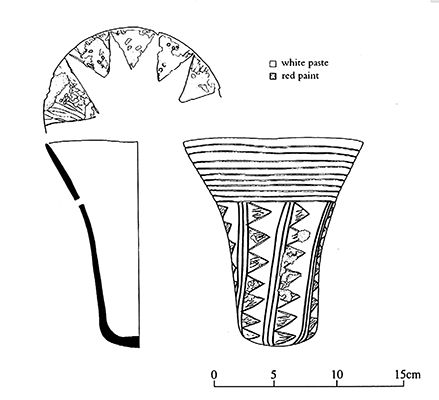
This example from grave 569 is one of the least graceful in proportions. Relatively short in comparison to the other reconstructible examples, it stands 164 mm high, with an orifice diameter of 140 mm and base diameter of 60 mm.
As is usual, only a single hole, pierced through the body from the exterior, is placed at the waist or junction of the body and the flaring rim. On all of the excavated examples, incised designs adorn the interior of the flaring rim and the whole of the exterior. These incisions were made after the clay was pebble burnished. The design is almost always composed of horizontal zones in which there is a succession of triangles or van dykes.
The vessel from grave 569 and another from area 3500 (Brunton and Morant,1937) are the only exceptions in that they have a vertical decorative scheme. Pendant triangles are found incised on the interior of the rim on all the excavated examples.
Photo and text: Friedman (1999)
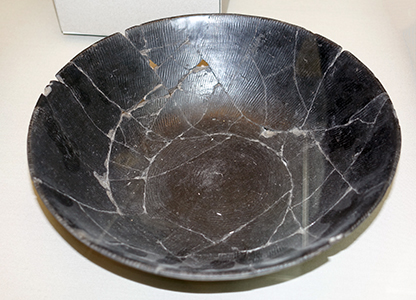
Badarian: 4 400 BC - 4 000 BC
Grave of a trader - Rippled bowl
This bowl has rippling on both surfaces and notches along the rim. It is a fine example of the skill of the Badarian potters. Rippled pottery is a legacy from the earlier people living in Nubia and the southeastern part of the Sahara Desert, who were probably the Badarians' forebears.
Catalog: Badari 569, Badarian, EA59721
Photo: Don Hitchcock 2018
Source: Original, British Museum
Text: Card at the British Museum, © Trustees of the British Museum, CC BY-NC-SA 4.0
Badarian: 4 400 BC - 4 000 BC
Grave of a trader - Rippled bowl
Black-topped brownware pottery bowl, with rippled surfaces. Repaired.
Diameter 238 mm, height 70 mm, weight 530 grams.
Catalog: Badari 569, Badarian, EA59721
Photo: © Trustees of the British Museum, CC BY-NC-SA 4.0
Source: Original, British Museum
Text: Card at the British Museum, http://www.britishmuseum.org/, © Trustees of the British Museum, CC BY-NC-SA 4.0
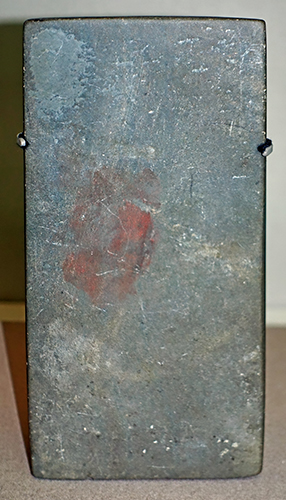
Badarian: 4 400 BC - 4 000 BC
Grave of a trader - Cosmetic Palette
Rectangular mudstone cosmetic-palette. One side has slight depression surrounded by crescent-shaped peck marks, while the other side has the stain of red pigment, probably ochre, but no signs of wear.
Dimensions: length 197 mm, thickness 5 mm, width 89 mm, weight 329 grams.
Catalog: El Badari, Badari Grave Group 569, Badarian, EA59726
Photo: Don Hitchcock 2018
Source: Original, British Museum
Text: Card at the British Museum, © Trustees of the British Museum, CC BY-NC-SA 4.0
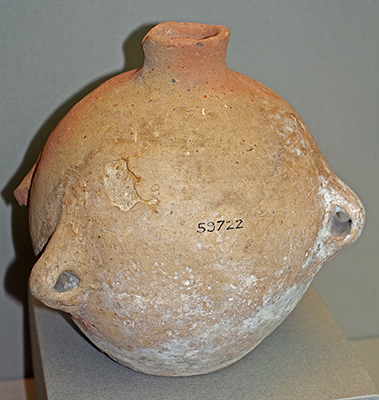
Badarian: 4 400 BC - 4 000 BC
Grave of a trader - Four-handled jar
This four-handled jar came from southern Canaan. Originally it had a funnel shaped neck, but this was lost and the rim ground down. It is one of the earliest imports from such a distance to reach Upper Egypt, and may have arrived via the Delta or through Sinai. The dot of red paint at the base of each handle is typical for this type of Canaanite pottery, but is not visible in this image.
Catalog: Badari 569, Badarian, EA59722
Photo: Don Hitchcock 2018
Source: Original, British Museum
Text: Card at the British Museum, http://www.britishmuseum.org/, © Trustees of the British Museum, CC BY-NC-SA 4.0
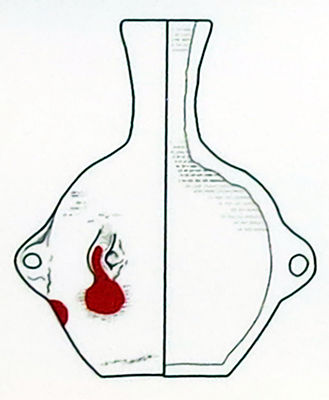
Badarian: 4 400 BC - 4 000 BC
Grave of a trader - Four-handled jar
Artist's reconstruction of the imported Canaanite jar, showing the original funnel shaped neck, and where the dot of red paint is usually placed.
Catalog: Badari 569, Badarian, EA59722
Photo: Poster/card at the British Museum, © Trustees of the British Museum, CC BY-NC-SA 4.0
Rephotography: Don Hitchcock 2015
Text: Poster/card at the British Museum, http://www.britishmuseum.org/, © Trustees of the British Museum, CC BY-NC-SA 4.0
Badarian: 4 400 BC - 4 000 BC
Grave of a trader - Leaf-shaped knife
This knife is an exceptionally good example of the abilities of the Badarian flint workers. It is made of fine grained beige flint typical of the period, and has been skilfully flaked and retouched on both sides.
Measuring 226 mm long, 62 mm wide and 16 mm thick (max) this symmetrical knife is bifacially retouched all around, although on the reverse side of the butt, which is slightly blunter and thicker, the retouch is somewhat haphazard. The material, a fine-grained beige flint, is also typical for the period.
Catalog: Badari 569, Badarian, EA59725
Photo (left, rotated 180°): Friedman (1999)
Photo (right): Don Hitchcock 2015, face corresponding to the face on the left of the drawing
Source: Original, British Museum
Text: Friedman (1999), card at the British Museum, © Trustees of the British Museum, CC BY-NC-SA 4.0
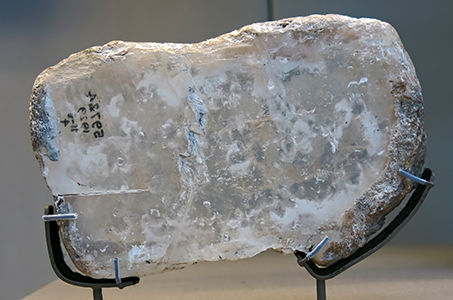
Badarian: 4 400 BC - 4 000 BC
Grave of a trader - Slab of selenite
How the Badarians used this natural slab of selenite, or crystallised gypsum, is uncertain. Its translucent qualities were obviously attractive. Plates and disks made of this material are known from the early cultures to the north, in Lower Egypt. This slab may have originated from there.
On other side, which we can see through the semi-transparent slab, the marking reads: 59724 1929 (indecipherable) 4
Catalog: Badari 569, Badarian, EA59724
Photo: Don Hitchcock 2015
Source: Original, British Museum
Text: Card at the British Museum, http://www.britishmuseum.org/, © Trustees of the British Museum, CC BY-NC-SA 4.0
Badarian: 4 400 BC - 4 000 BC
Grave of an important man - Beads
Belts made of thousands of bright blue glazed steatite beads were worn by men as symbols of authority. This rare example belonged to a man laid to rest with a goat skin blanket and a fine black-topped brown bowl similar to the one here.
Catalog: Mostagedda 592, Badarian, EA62150
Photo: Don Hitchcock 2018
Source: Original, British Museum
Text: Card at the British Museum, http://www.britishmuseum.org/, © Trustees of the British Museum, CC BY-NC-SA 4.0
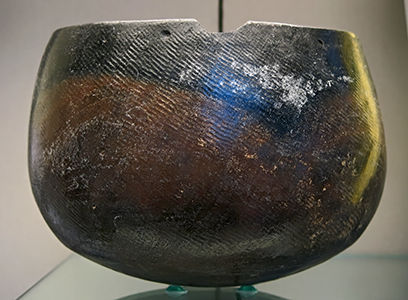
Badarian: 4 400 BC - 4 000 BC
Grave of an important man - Bowl
In the grave was a fine black-topped brown bowl similar to the one here.
( Any modern potter would be proud to have produced a work of this quality - Don )
Catalog: Mostagedda 1258, Badarian, EA62210
Photo: Don Hitchcock 2015
Source: Original, British Museum
Text: Card at the British Museum, http://www.britishmuseum.org/, © Trustees of the British Museum, CC BY-NC-SA 4.0
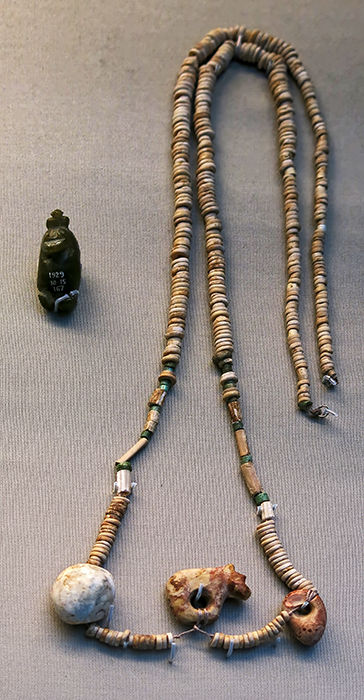
Badarian: 4 400 BC - 4 000 BC
Hippopotamus figures
Animal carvings are rare in Badarian culture. Only hippopotami and gazelles are depicted, and both are associated with cosmetics and magical protection.
On the left is a chrysoprase amulet, in the form of a hippopotamus, pierced transversely.
Length 31 mm, width 20 mm.
On the right is a necklace of shell, coral, bone and ivory, date circa 4 000 BC.
The hippopotamus amulet attached to the shell, coral, bone and ivory necklace is a very early example of representational art in Egypt, and may be an early personification of the goddess Tawaret, as the female hippopotamus was commonly associated with the protection of pregnant women. (Koen, 2008)
The necklace with the bound hippo carving was buried with a child, probably as a protective amulet.
Catalog: Green amulet, Mostagedda 1208, Badarian, EA62167
Necklace of shell and coral, Badari 5740, Badarian, EA59704
Photo: Don Hitchcock 2015
Source: Original, British Museum
Text: Card at the British Museum, http://www.britishmuseum.org/, © Trustees of the British Museum, CC BY-NC-SA 4.0
Additional text: Koen (2008)
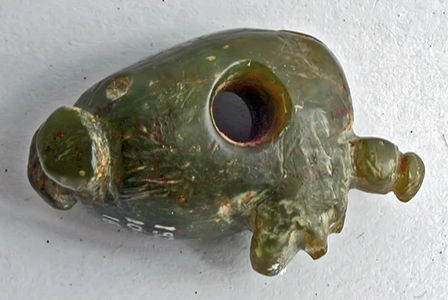
Badarian: 4 400 BC - 4 000 BC
Chrysoprase Hippopotamus
Chrysoprase is a green gemstone, a variety of chalcedony that contains nickel. The piercing of the piece allowed it to be worn as an amulet on a cord around the neck.
( I must admit that I find it difficult to interpret this shape as a hippopotamus - Don )
Length 31 mm, width 20 mm.
Catalog: Green amulet, Mostagedda 1208, Badarian, EA62167
Photo: © Trustees of the British Museum, CC BY-NC-SA 4.0
Source: Original, British Museum
Text: Card at the British Museum, http://www.britishmuseum.org/, © Trustees of the British Museum, CC BY-NC-SA 4.0
Badarian: 4 400 BC - 4 000 BC
Cosmetic-jar
Elephant ivory cosmetic-jar in the form of a hippopotamus.
Height 60 mm, length 75 mm, depth 45 mm, weight 89 grams.
Catalog: Mostagedda, 3522, Badarian, EA63057
Photo: Don Hitchcock 2018
Source: Original, British Museum
Text: Card at the British Museum, http://www.britishmuseum.org/, © Trustees of the British Museum, CC BY-NC-SA 4.0
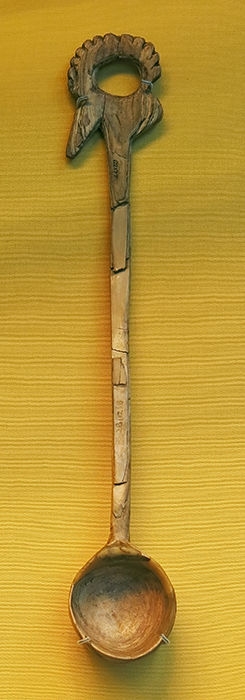
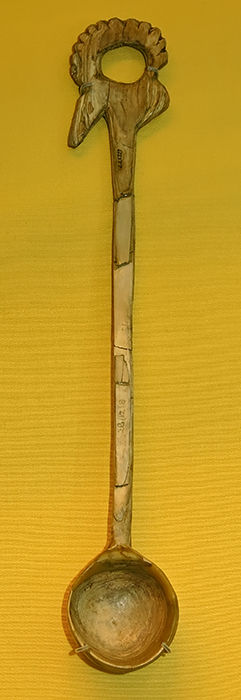
Badarian: 4 400 BC - 4 000 BC
Ivory spoon
This spoon was used for mixing cosmetics. It is carved with the stylised head of a gazelle, the horns forming a loop so it could be hung.
The decoration on such objects shows that cosmetics had ritual significance.
Catalog: Mostagedda, 1218, Badarian, EA62177
Photo: Don Hitchcock 2015
Source: Original, British Museum
Text: Card at the British Museum, http://www.britishmuseum.org/, © Trustees of the British Museum, CC BY-NC-SA 4.0
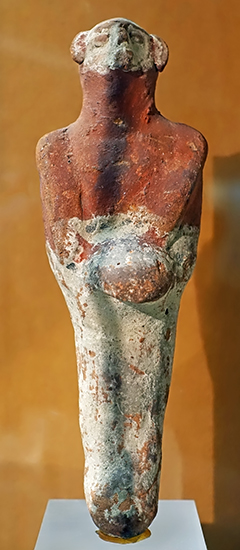
4 000 BC - 3 000 BC
Male Figure
This ceramic, painted sculpture, 175 mm high cannot be classified with any certainty, as only three closely comparable parallels have been found so far without any indication of origin.
A thermoluminescence test, however, proved its great age. The erect phallus can be understood as a figurative evocation of ever-renewing procreative power.
It can be taken for granted that the physical aspects of earthly and otherworldly existence, which repeatedly come to the fore in this art, do not exclude a spiritualised counter-image as a possibility.
Catalog: Ceramic, origin unknown, Inv. no. 1935.200.39
Photo: Don Hitchcock 2018
Source and text: Original, Museum August Kestner, Hannover
Additional text: Paper Catalogue, Museum August Kestner, Hannover
A desert enigma
4 000 BC - 2 800 BC
By 4 000 BC the Eastern Sahara was a dry and inhospitable place. Yet 1 000 years later nomads still roamed even its farthest reaches. They left behind conical cylinders of pottery, called Clayton rings after the desert explorer Peter Clayton. Carefully placed near rocky outcrops, pending their owners' return, some rings even bear personal symbols. They have been found alone, or buried together in groups.
Archaeologists are still trying to determine the rings' function, and whether this was in herding, hunting or food preparation. We still do not know, and these objects remain a desert enigma.
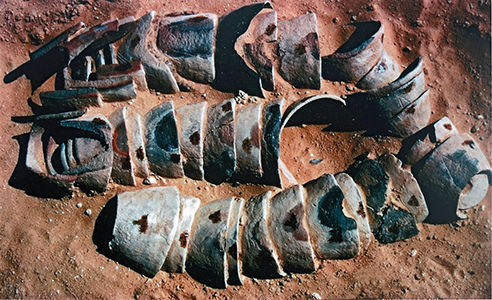
Large cache of Clayton rings at Bir Sahara, Site BS-22, 4 000 BC - 2 800 BC. (Gatto, 2001-2002).
Bir Sahara is a small desert oasis located 350km west of the Nile. Here two deposits of Clayton rings were discovered by Fred Wendorf in 1973. One set, displayed below, contained Egyptian pottery dating to the Early Dynastic period, about 2900 BC. The other deposit, the largest ever found, was made up of 36 rings carefully stacked together, as shown in the photograph.
Photo: Wendorf Archive (British Museum) © Trustees of the British Museum, CC BY-NC-SA 4.0
Source: Poster, British Museum © Trustees of the British Museum, CC BY-NC-SA 4.0
Rephotography: Don Hitchcock 2015
Text: poster at the Museum © Trustees of the British Museum, CC BY-NC-SA 4.0
An unpublished report on the discovery of the items in BS-21 and BS-22 reads in part:
BS-21 is located at the base of an erosional surface, 100 metres west of Bir Sahara well. The site, measuring 90 x 50 cm (the main part) and 40 cm x 50 cm (the annex part), consists of a cache of ceramic vessels. The pottery probably had a highly specialised function.
BS-22 is located 200 m from the well. It is situated on an erosional knoll, 2 metres above the plain. The site, measuring 100 cm x 100 cm, consists of a cache of open-ended ceramic vessels. It is very similar to the previous one, except for the lack of true jars and bowls.
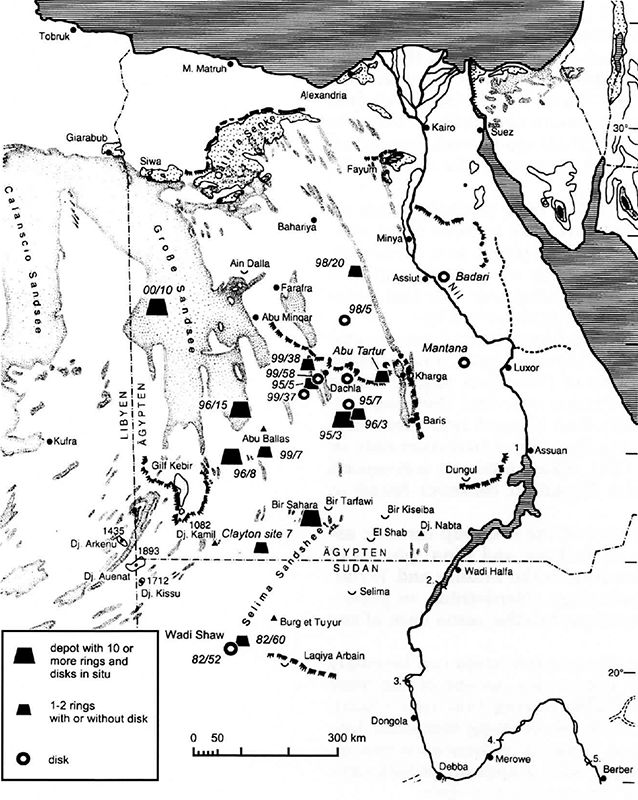
Distribution of 'Clayton rings' and disks in the Western Desert and location of Bir Sahara, 4 000 BC - 2 800 BC.
Site BS-21: In this cache true pottery vessels, jars and bowls were found, together with strange ceramic truncated cones, open at both ends, which are known in literature with the name of 'Clayton rings' (Riemer and Kuper, 2000). Together with them ceramic disks are always found.
Site BS-22: In this cache only Clayton rings and disks were found (Fig. 9). All of the 35 rings, recorded in the picture, were fitted the one into the other and each one seems to have a corresponding disk inside or close to it. This time, the rings were badly preserved in the upper part, due to a possible open-air exposure.
That was not the case of the BS-21 material which was perfectly preserved, probably because it was buried into the ground. Many of the BS-22 rings show incised potmarks. In two cases there is an upside-down V-like motif while in two more examples there is an upside-down V-like shape obtained with three parallel lines on the sides and a long straight line in the middle.
Clayton rings and disks are made with a coarse fibre tempered fabric, very porous and soft in consistence, due to the burning of fibres during the firing. Most of them have potmarks (incised marks) on the surface.
Potmarks
Many Bir Sahara Clayton rings and disks, as well as several from the other recorded sites, are decorated with incised marks on the surface. Here, as elsewhere, all the marks seem to be engraved after firing (Riemer and Kuper, 2000). According to Adams and Porat (1996) and to Riemer and Kuper (2000), there might be a correlation between these marks and the contents or utilisation of the vessel. However, unfortunately at the moment we do not know the use of Clayton rings and disks, and potmarks do not seem to help us in this respect.
Photo: Riemer and Kuper (2000)
Proximate source and text: Gatto (2001-2002)
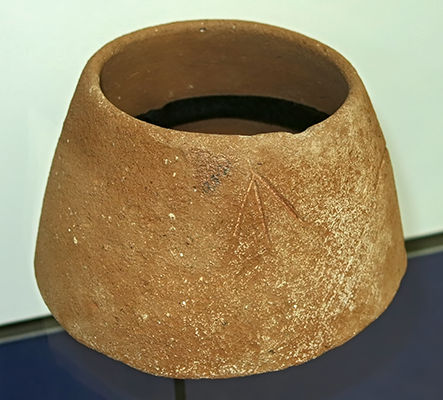
Clayton ring, 4 000 BC - 2 800 BC.
Clayton rings are always roughly the same size. They could be custom-made from local desert clay, or cut down from old Egyptian jars as is the case here.
The arrow-like mark scratched on this ring is identical to one on the base of the spouted bowl shown below and may denote ownership.
Catalog: Bir Sahara BS-21, Early Dynastic, EA76813
Photo: Don Hitchcock 2015
Source: Original, British Museum
Text: Card at the British Museum © Trustees of the British Museum, CC BY-NC-SA 4.0
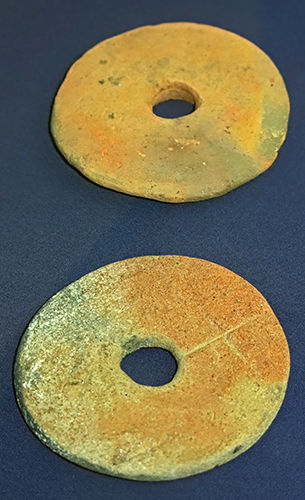
Clayton discs, 4 000 BC - 2 800 BC.
Disks always accompany the Clayton rings and are often found inside them.
Upper example, EA76814: Hand-made pottery disk in rough ware with soft porous vegetal tempered fabric. Surfaces brown smoothed.
Predynastic (A-Group) from Bir Sahara, BS-21
Diameter: 85 mm (exterior), diameter: 20 mm (interior), thickness 3 mm (exterior), thickness 4 mm (interior)
Made from flat lumps of clay (as in the lower example, EA76815), they seem to have broken frequently, so spares were made from reworked potsherds (upper example, EA76814). The disks, consistently smaller than the ring's openings, are perforated with a hole that is usually 15 mm in diameter. Like the rings, their function is unknown.
Catalog: Bir Sahara BS-21, Early Dynastic, EA76814, EA76815
Photo: Don Hitchcock 2015
Source: Original, British Museum
Text: Card at the British Museum, http://www.britishmuseum.org/, © Trustees of the British Museum, CC BY-NC-SA 4.0
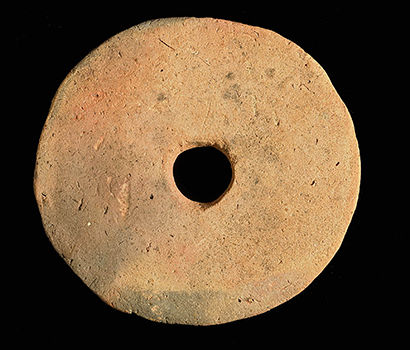
Clayton disc, 4 000 BC - 2 800 BC.
Hand-made pottery disk in rough ware with soft porous vegetal tempered fabric. Surfaces brown smoothed.
Culture/period: Predynastic (A-Group), Bir Sahara, BS-21
Diameter 85 mm (exterior), diameter 20 mm (interior), thickness 3 mm (exterior), thickness 4 mm (interior)
Catalog: Bir Sahara BS-21, Early Dynastic, EA76814
Photo: © Trustees of the British Museum, CC BY-NC-SA 4.0
Source: Original, British Museum
Text: http://www.britishmuseum.org/, © Trustees of the British Museum, CC BY-NC-SA 4.0
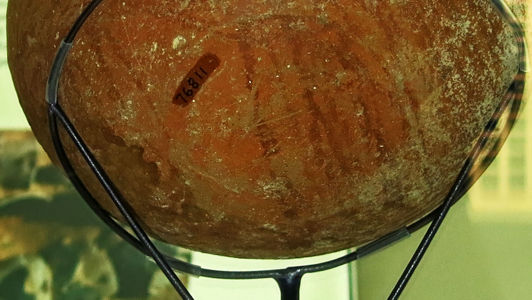
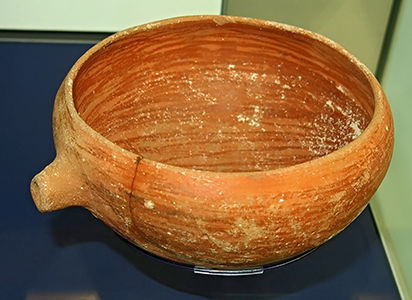
Spouted bowl, 4 000 BC - 2 800 BC.
This bowl was made in Egypt, and was probably traded to the desert nomads, who found the spouted shape useful. Many similar vessels are known from desert deposits.
On its base is the same arrow-like mark as on the Clayton ring with which it was found.
Catalog: Bir Sahara BS-21, Early Dynastic, EA76811
Photo: Don Hitchcock 2015
Source: Original, British Museum
Text: Card at the British Museum, http://www.britishmuseum.org/, © Trustees of the British Museum, CC BY-NC-SA 4.0
Predynastic burial practices 3900 - 3100 BC
In the time before the pharaohs, the Predynastic people living in Upper Egypt buried their dead at the desert's edge. The shallow graves were often lined with reed mats, arranged like bedding. The deceased were laid out in a flexed position, usually on their left side. They faced west, towards the land of the dead, where they would be reborn.
Covered with linen, animal skins or matting, they were supplied with necessities for the afterlife, especially pottery to hold and serve food. With time, wood lining and mud bricks were introduced. These provided more protection for graves and the increasing number of objects they contained. Gradually, the tomb was transformed from a bed into a house for eternity.
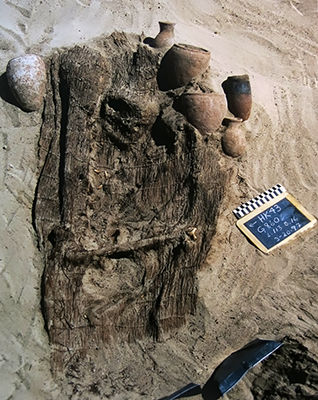
Predynastic burial at Hierakonpolis from about 3 600 BC
Photo: Poster © Trustees of the British Museum, CC BY-NC-SA 4.0, Courtesy of the Hierakonpolis Expedition
Rephotography: Don Hitchcock 2015
Text: poster at the Museum © Trustees of the British Museum, CC BY-NC-SA 4.0
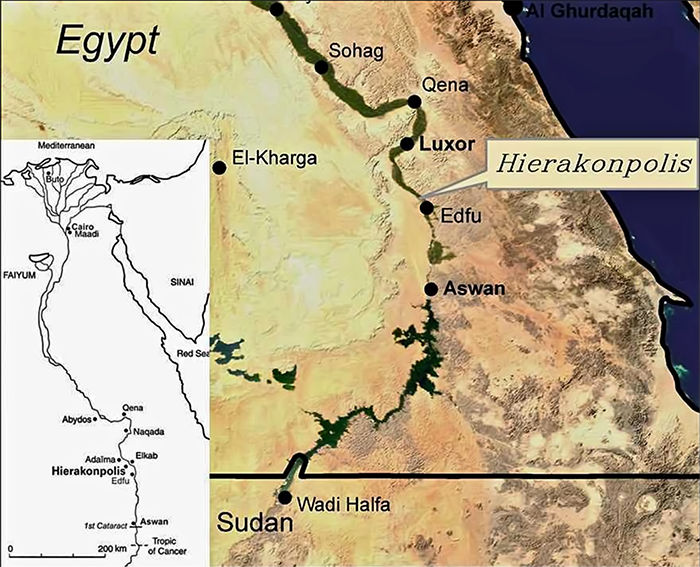
Map showing the position of Hierakonpolis.
Photo: http://jandyongenesis.blogspot.com.au/2014/05/why-nekhen-is-anthropologically.html
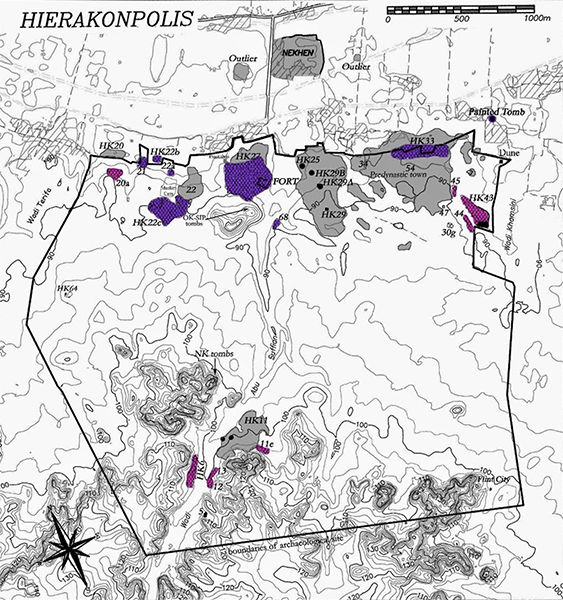
Map showing pre-dynastic cemeteries of Hierakonpolis.
Photo: http://egitalloyd.blogspot.com.au/2014/05/new-discovery-edfu-pre-dynastic-tomb.html
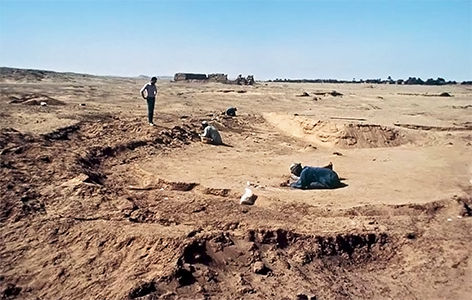
View of Hierakonpolis from the ceremonial centre at Hk29A, located in the midst of the Predynastic town, with the enclosure of King Khasekhemwy (end of Dynasty 2, circa 2 649 BC) in the distance.
Text and photo: Patch et al. (2011)
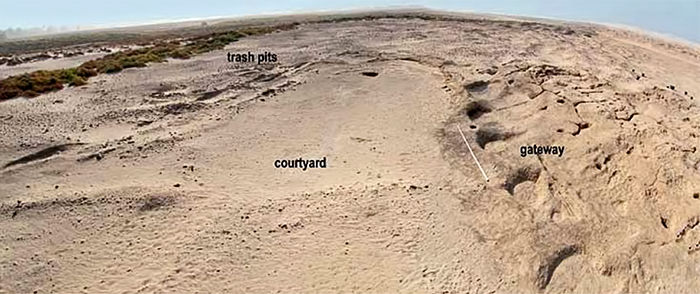
View of the ceremonial centre at Hk29A, whose open courtyard was entered via a monumental wood gateway.
Refuse from the ceremonies conducted there, deposited in pits around the periphery, has provided unparalleled insight into cultic practices in Naqada IIb - III, circa 3 550 BC - 3 100 BC.
Text and photo: Patch et al. (2011)
The Naqada Region
Whilst the Hierakonpolis region seems to have been at the forefront of state formation, another site has emerged as the leading Upper Egyptian centre in earlier Predynastic times. This is Naqada, located on the west bank of the Nile, opposite the entrance to the Wadi Hammamat.
The wadi, one of the relatively few direct and well watered accesses to the Red Sea coast, afforded easy access to the gold reserves of the eastern desert. Moreover, the bend in the Nile as it flows through the Naqada region brings the river closer to the Red Sea than at any other point in its course. Both these geographic factors would have made Naqada (and Coptos, on the opposite bank of the Nile) an ideal centre for the Predynastic gold trade.
After the early First Dynasty the major focus of population moved northwards to a new location, the town of Nubt. During the course of the Early Dynastic period, this too declined in importance, as Naqada was relegated to a position of provincial obscurity. The eclipse of Naqada was accompanied by the rise of Dendera, some 25 kilometres to the north, and perhaps of Thebes, a similar distance to the south. This is probably no coincidence, and may be part of a more widespread phenomenon in which the role of provincial capital was transferred from the traditional centre - in many cases an important Predynastic settlement to a new town.
Map: Google maps
Text: Wilkinson (2002)
Timeline Naqada period
Naqada I (about 3 900 BC – 3 650 BC)
• black-topped and painted pottery
• trade with Nubia, Western Desert oases, and Eastern Mediterranean
• obsidian from Ethiopia
Naqada II (about 3 650 BC – 3 300 BC)
• represented throughout Egypt
• first marl pottery, and metalworking
Naqada III (about 3 300 BC – 2 900 BC)
• more elaborate grave goods, first Pharaohs
• cylindrical jars
• writing
The Naqada region is outlined in red on this close up map of the area.
Coptos, Hu and the rise of Dendera
Just why Naqada — rather than Coptos, located directly at the mouth of the Wadi Hammamat —came to dominate the surrounding region in the Predvnastic period is not clear. It is a curious fact that all the most important centres of late Predynastic and Early Dynastic Upper Egypt were located on the west bank of the river (with the possible exception of Elephantine, an island in the Nile). Whether this is pure coincidence, or whether the west bank had a natural advantage, is difficult to say.
In Upper Egypt today, the expanse of floodplain is wider on the west bank than on the east bank, but this may not have been the case in the fourth millennium BC. The Coptos colossi indicate that this site was an important cult centre from late Predynastic times, and the symbols carved on these statues suggest that Coptos was a centre of long-distance trade in artefacts from the Red Sea coast; but it never seems to have become a major regional focus of population.
At the beginning of the Old Kingdom, both Coptos and the neighbouring site of Hu/Abadiya were displaced as important provincial centres by Dendera: the titles borne by the early Fourth Dynasty administrators of Dendera refer to a grouping of three adjacent districts, Coptos, Dendera and Hu. The centralisation of power which seems to have occurred at the beginning of the Old Kingdom and which is most spectacularly attested by the pyramids of the Fourth Dynasty was achieved partly by means of a fundamental reorganisation of economic and administrative structures.
The evidence from sites such as Dendera suggests that another plank of this programme was a conscious policy to integrate the provinces of Upper Egypt by removing the reins of power from the hands of the traditional ruling families (which may have retained significant influence over their communities during the Early Dynastic period). Centres such as Hierakonpolis, Naqada, Coptos and Hu had risen to great prominence during the Predynastic period. Following the formation of the Egyptian state, regional capitals would have served as key nodes in the national administrative apparatus. The transfer of this role from traditional centres to new towns would have been an effective means of bypassing pre-existing regional power structures and exerting central control.
Map: Google maps
Text: Wilkinson (2002)
Predynastic Period
Harpoon
Bone harpoon, from hole 35 = 1606, Badari Pl.XXXIV, 6; Pl.LIV, 2
Collector Guy Brunton, Caton-Thompson, Gertrude, Hemamieh, Tomb 1606, 44-63(?)
Collected at Badari, Accession Number LDUCE-UC9497
Photo: Don Hitchcock 2018
Source: Original, Petrie Museum, London, England
Text: Card / online catalogue, the Petrie Museum, © 2015 UCL. CC BY-NC-SA license.
Naqada Period
Siltstone Amulet
Siltstone amulet/tag type 101G, eyes inlaid with ivory (?) discs. From Naqada Tomb 1865.
( Note that the distinction between palette and amulet appears to depend on size, since a larger but similar object would no doubt have been identified as a palette. The museum card calls it a palette, while the online catalog identifies it as an amulet. In addition, this is properly called siltstone, since it does not exhibit the fissility of slate, despite the identification on the museum card - Don )
Height 66 mm, width 87 mm, Accession Number LDUCE-UC4345
Photo: Don Hitchcock 2018
Source: Original, Petrie Museum, London, England
Text: Card / online catalogue, the Petrie Museum, © 2015 UCL. CC BY-NC-SA license.
Naqada I: 3 900 BC - 3 650 BC
Siltstone palette
Boat-shaped siltstone palette. Type 30. From el Amrah tomb alpha120.
Width 170 mm, Accession Number LDUCE-UC10789.
Photo: Don Hitchcock 2018
Source: Original, Petrie Museum, London, England
Text: Card / online catalogue, the Petrie Museum, © 2015 UCL. CC BY-NC-SA license.
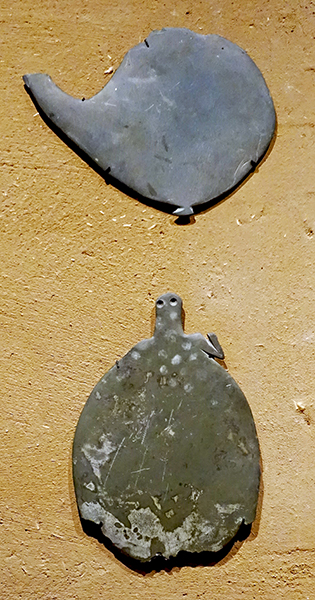
Naqada I-III: 3 900 BC - 2 900 BC
Naqada culture Palettes (4th millennium BC)
Makeup palettes are a characteristic group of artefacts. As precious personal possessions, they were eventually also placed in the grave. Almost exclusively slate (mudstone) was used as the material for the flat tablets. The palettes were used to grind and mix make-up obtained from minerals.
Eye makeup of green or black colour was used in cults (painting the cult image, i.e. the statue of the gods), but also for the daily bodily care (or as protection against eye diseases) of men and women. Some palettes show clear signs of use in the form of small depressions.
Photo: Don Hitchcock 2018
Source: Original, Ägyptischen Museum München
Text: Museum card, © Ägyptischen Museum München
Naqada I-III: 3 900 BC - 2 900 BC
Cosmetic palettes (seven are shown below) from Abusir el-Malaq and other necropolises.
( Note that the Museum August Kestner labels these as having the dates 4 000 BC - 3 000 BC - Don )
Abusir el-Malaq is situated half way between the Faiyum Oasis and the Nile.
Naqada I-III: 3 900 BC - 2 900 BC
Naqada I-III: 3 900 BC - 2 900 BC
(left) Number 11, rhomboid palette.
Inv. No. 1935.200.1 (350 x 96 mm)
(right) Number 15, rhomboid palette.
Inv. No. 1921.2.25 (168 x 104 mm)
Naqada I-III: 3 900 BC - 2 900 BC
(left) Vitrine no. 16, falcon palette
Inv. No. 1935.200.2 (226 x 108 mm)
(right) Vitrine no. 17, falcon palette
Inv. No. 1935.200.7 (106 x 87 mm)
Naqada I-III: 3 900 BC - 2 900 BC
(left) Vitrine No. 18, 'neutral' palette
Inv. No. 1952.149 (130 x 80 mm)
(right) Vitrine no. 12, fish palette
1935.200.3 (148 x 78 mm))
Naqada I-III: 3 900 BC - 2 900 BC
Vitrine no. 19, fish palette
Inv. No. 1967.46 (150 x80 mm)
Even in the early tombs of the Naqada period, palettes for putting on makeup were an integral part of the equipment of women and men, for the green colour application had not only the task of decoration, the thick paste, applied to the eyelids, granted effective protection against glaring sunlight. At the same time, as the colour of sprouting plants, green has the function of an amulet.
The oldest rhomboids (no. 11) and the 'neutral' ones (no. 15, 18) are joined by forms with the outlines of sacred animals (falcon: no. 13, 16, 17, 20, gazelle: no. 14), remarkably also those which later, as dark powers of prehistory, are largely suppressed from the official cults: Tortoise and fish (nos. 12 and 19).
Towards the end of the Naqada culture, palettes, because of their smooth surfaces and because they had always been sacred utensils, also became carriers of images and inscriptions of mythical and historical events and one of the most important sources for historical research. The most famous example is the palette of King Narmer (Cairo Museum).
Catalog: Slate and greywacke, Abusir el-Malaq, and other necropolises.
Vitrine no., Inv. no., dimensions: (11) 1935.200.1 (350 x 96 mm), (12) 1935.200.3 (148 x 78 mm), (13) 1921.2.23 (254 x 148 mm), (14) 1967.45 (220 x 97 mm), (15) 1921.2.25 (168 x 104 mm), (16) 1935.200.2 (226 x 108 mm), (17) 1935.200.4 (107 x 82), (18) 1935.200.7 (106 x 87 mm), (19) 1952.149 (130 x 80 mm), (20) 1967.46 (150 x80 mm)
Photo: Don Hitchcock 2018
Source and text: Original, Museum August Kestner, Hannover
Additional text: Paper Catalogue, Museum August Kestner, Hannover
Naqada Period
Cosmetic palette, siltstone, type 31D., from Naqada Tomb 171.
Diameter 117 mm, height 53 mm, Accession Number LDUCE-UC4690
Number 29 of the sketches below.
Photo: Don Hitchcock 2018
Source: Original, Petrie Museum, London, England
Text: Card / online catalogue, the Petrie Museum, © 2015 UCL. CC BY-NC-SA license.
Naqada Period
Siltstone palette, type 101R, double bird motif, one beak broken; with inlaid eyes. From Naqada Tomb 10. Height 59 mm, width 115 mm.
Photo: Don Hitchcock 2018
Source: Original, Petrie Museum, London, England
Text: Card / online catalogue, the Petrie Museum, © 2015 UCL. CC BY-NC-SA license.
Accession Number (from the online catalog) LDUCE-UC4518. Note that there is a typo on the Museum Card, it reads UC5418.
Strange forms of slate have been found in Egypt for some years past; but no account of their source was known, and their age and purpose were quite uncertain. The cemeteries of the New Race have explained the whole subject; the slates were placed in the graves, and their purpose was for grinding malachite, and occasionally hematite, probably for face-paint. That such forms should be used for palettes may seem almost beyond belief; but the evidence of the patches of malachite on them, and the worn hollows for grinding, are found on every class.
The monstrous rhombs (93-99) have been quoted as impossible for merely grinding a little patch of face-paint, and have been suggested for shields. But the inexorable evidence is as plain on these as on any other forms ; the patches of malachite are on them, and on some the deeply hollowed grinding-places (94-97, 99) stained with haematite and malachite, prove that the colour was not merely casual or ornamental, but had been ground on them for years during the life of the owner.
They run through all the periods of the New Race burials, both early, middle, and late. The general division is that the well-formed animal figures and the rhombs are of the earlier age, while the worst of the animal figures, 7, 53, 59, 60, 70, 82, 83, 86, and the squares, are of the later age, with late pottery and cylinder jars. Associated with the slates are continually found selected yellow flint pebbles for using as mullers in grinding the colour.
The forms are very varied. Of quadrupeds there are the ibex or the mouflon, indistinct species of deer (9-4), elephant (5-8), and turtle (9-19). Birds are common (20-27), and a curious double-bird occurs in several forms (28-33). Fish are very common (36-61).
The double-bird is made in an anchor form, with a long handle above (62-68), and also in a long form (69-92), in which the heads become lessened until, in 91 and 92, occurs in several forms (28-33). Fish are very common (36-61). The double-bird is made in an anchor form, with a long handle above (62-68), and also in a long form (69-92), in which the heads become lessened until, in 91 and 92, the outline is almost rhombic. This passes into the rhombs (93-99). The squares arc sometimes plain (100,102), but more often scored around the edge with lines (101, 103-108). And many rough unshaped pieces are found (109-111). The degradation of many of the types is remarkable, especially the tortoise, where it acquires deers' heads for feet (11, 12) or loses almost all trace of feet (17, 18) ; the double-bird which becomes the shape of the pelta (32, 33), or a rhomb (92); and the fish, which become mere ovals 59-61.
The total numbers of the various classes (including rude ones and fragments) are: ibex or moufflon, 1; deer, 3; elephant, 4 ; turtle, 13; bird, 11; double-birds, 6o; fishes, 130; rhombs, 99; squares, 28; rough, 37.
At Ballas the types belonged to the later styles, agreeing with most of that cemetery being of late New Race. There were 12 animals and tortoises, 39 fish, 14 double-birds, and 31 rhombs and squares.
Source and text: Petrie & Quibell, (1895)
Naqada Period
Looking good for the afterlife
Early- Middle Predynastic, 3900 - 3300 BC
Early Egyptians cared about their appearance for the afterlife. Before burial hair was carefully arranged, dyed to cover grey strands, and occasionally hair extensions were added. Beards were trimmed and fingernails cleaned and filed. Jewellery was donned, sometimes more than could be comfortably worn in life. Selected individuals were also equipped with palettes and pebbles to grind cosmetic pigments. Makeup was applied to the eyes and body, ensuring magical and medicinal protection and affirming social status.
Text above: Poster at the British Museum, http://www.britishmuseum.org/, © Trustees of the British Museum, CC BY-NC-SA 4.0
Naqada I: 3 900 BC - 3 650 BC
Ivory figurines
The idealised image of feminine beauty - embodied in these rare ivory figurines - changed little over time for the ancient Egyptians. Qualities included a mature but lithe figure, large alluring eyes and a full head of hair.
Originally, the bald example probably had a wig of clay or paste. Lapis lazuli inlays create the central figurine's eyes, but are thought to be modern additions.
( note that the two examples on the right have a peg for attachment to (presumably) a board - Don )
Left: Bone figure of a woman.
Height 120 mm, width 24 mm, thickness 8 mm, weight 13 grams
Catalog: Naqada I, bone, EA32139
Centre: Bone figure of a standing woman; the lapis lazuli inlays in the eyes were probably added in modern times.
Height: 114 mm, width: 21 mm, depth 6 mm, weight 11 grams.
Catalog: Naqada I, bone, inlaid, EA32141
Right: Bone figure of woman.
Height 107 mm, width 22 mm, depth 13 mm, weight 22 grams.
Catalog: Naqada I, bone, EA32142
Photo: Don Hitchcock 2018
Source: Original, British Museum
Text: Card at the British Museum, http://www.britishmuseum.org/, © Trustees of the British Museum, CC BY-NC-SA 4.0
Naqada I: 3 900 BC - 3 650 BC
Palette in the shape of a bird.
Mudstone (greywacke) palette carved in the shape of a bird.
Length 97 mm, width 166 mm, thickness 7 mm, weight 200 gm.
Birds were considered a positive force connected with fertility. They appear on many types of personal items, such as palettes, combs, and hairpins. Most of these objects seem to have been owned by women of status or with special magical or medicinal knowledge.
This is the reverse side to that displayed in the BM catalog.
Catalog: Egypt, Naqada I, EA66707
Photo: Don Hitchcock 2018
Source: Original, British Museum.
Text: Card at the British Museum, http://www.britishmuseum.org/, © Trustees of the British Museum, CC BY-NC-SA 4.0
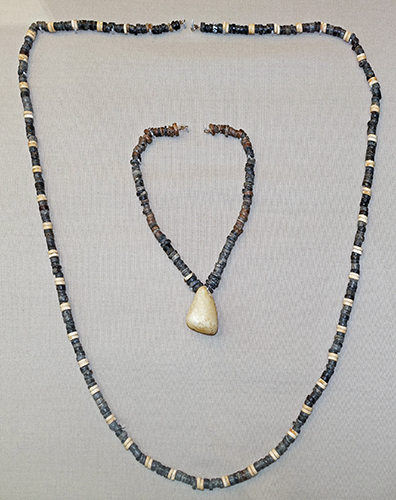
Naqada I: 3 900 BC - 3 650 BC
Beads
Beads were worn by men and women at the neck, wrists, ankles, across the hips or forehead. Materials were chosen for their beauty, but fashion and technology also played a role. Popular resources initially included soft travertine, seen here in the bracelet's pendant, and ostrich eggshell and steatite in the beads of the necklace.
EA63085: A string of disc and short barrel beads of black limestone and brown steatite and a large drop pendant of calcite with a roughly flat and circular base.
Diameter 5 mm (max), height of pendant 18 mm, length 260 mm.
Strings of limestone and steatite are usually found at the neck, and although this particular string was found at the wrists the excavators believed it might have been placed there after death. On the other hand, calcite pendants seem to have been found exclusively at the wrists. However, there is no evidence in the primary report that the two alabaster drops found at the wrists in this burial were attached to the string in question. Indeed, the other drop pendant was on its own string. Consequently, although the calcite pendant in this entry entered the collection already strung with the beads, there is no clear evidence that it was so discovered.
EA63077: A long string of cylinder and barrel disc beads made of ostrich shell and dark-grey steatite, a few of light-brown semi-translucent steatite and three of very dark-red jasper. The shell beads are of uniform diameter but the others are all smaller and of various diameters.
Diameter 6 mm, length 750 mm.
Catalog: Mostagedda, EA63085, EA63077
Photo: Don Hitchcock 2018
Source: Original, British Museum
Text: Card at the British Museum, http://www.britishmuseum.org/, © Trustees of the British Museum, CC BY-NC-SA 4.0
Naqada I: 3 900 BC - 3 650 BC
Turtle-shaped cosmetic palette
Mudstone cosmetic-palette in the form of a turtle. Inlaid bone eyes (one lost).
Height 202 mm, width 162 mm, thickness 7 mm, weight 390 gm.
Catalog: EA37913
Photo: Don Hitchcock 2018
Source: Original, British Museum
Text: Card at the British Museum, http://www.britishmuseum.org/, © Trustees of the British Museum, CC BY-NC-SA 4.0
Naqada I: 3 900 BC - 3 650 BC
Palette in the shape of a bird.
Mudstone (greywacke) palette carved in the shape of a bird with a single piercing.
Length 155 mm, width 97 mm, thickness 6 mm.
Catalog: Thebes, Naqada I, EA67664
Photo: Don Hitchcock 2018
Source: Original, British Museum. This is the reverse side to that displayed in the BM catalog
Text: Card at the British Museum, http://www.britishmuseum.org/, © Trustees of the British Museum, CC BY-NC-SA 4.0
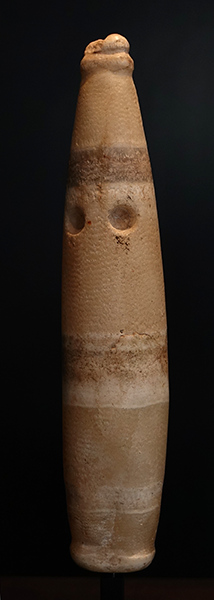
Naqada I: 3 900 BC - 3 650 BC
Abstract female figure
Stylised female figure , Kalzitalabaster, Predynastic Time, Naqada I-II, around 4 000 - 3 000 BC.
Height 137 mm.
Naqada lies on the west bank of the Nile, downstream from Luxor (ancient Thebes), midway between Qurna and Dendara, and opposite Qena where the Nile bends. It stood opposite the entrance to the Wadi Hammamat, one of the relatively few direct accesses to the Red Sea coast and the gold reserves of the eastern desert. Naqada and Koptos on the opposite bank were thus in good position to be the centres of Predynastic gold trade in the region.
The majority of Predynastic sites in the Naqada region belong to this culture. The sites range in area from a few thousand square meters to 3 hectares. The settlements probably housed 50 to 250 persons. Small postholes and the wooden stub of a post suggest flimsy wickerwork around a frame of wooden posts. Many dwellings were probably constructed from Nile mud and desert surface rubble.
Catalog: Calcite alabaster - a very fine calcite that resembles European alabaster, ÄS 6981
Photo: Don Hitchcock 2018
Source: Original, Ägyptischen Museum München
Text: © Ägyptischen Museum München
Additional text: http://www.leben-in-luxor.de/luxor_lexikon_museen_smaek2.html, http://www.touregypt.net/featurestories/naqada.htm
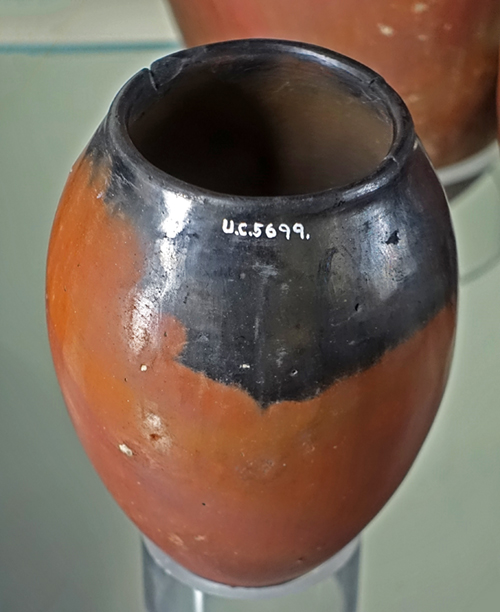
Naqada I: 3 900 BC - 3 650 BC
Black top pot
Black top pot, type B 58c, From Naqada Tomb 1817.
Height: 119 mm, diameter 84 mm, Accession Number LDUCE-UC5699.
Photo: Don Hitchcock 2018
Source: Original, Petrie Museum, London, England
Text: Card / online catalogue, the Petrie Museum, © 2015 UCL. CC BY-NC-SA license.
Above text from Patch et al. (2011)
Tusk and Tag figurines
The largest number of male figurines belong to one of two groups of radically abbreviated works, often referred to as "tags" and "tusks." The tusk figurines were probably always male, whereas tag figurines represent both sexes and in some cases may have been made without a designated gender (it could also be that we now lack the knowledge to recognise the gender cues present in these examples).
Tusk figurines exploit the natural shape of hippo ivory, and it is difficult to imagine that the resulting sculptures were meant to be anything other than phallic symbols. This interpretation is made explicit in a photograph from the excavation at el-Mahasna by Edward Ayrton and Leonard Loat in which four tusk figures are displayed in the company of the realistic male ivory figure discussed above: the objects virtually radiate male sexuality The el-Mahasna tusks represent a very abbreviated shape, but most tusk figurines exhibit some features carved into the pointed tip that transform them into human images.
This was done in one of two ways. The least elaborate involved the addition of two eyes and sometimes pairs of lines that intersect below where the chin would be. In the more sophisticated version, the tip of the tusk was carved into a ring, with a face and shoulders fashioned below. The opposite end was then turned into a base with a slight rim around the edge, as seen in this superbly finished example in the Metropolitan Museum. Although the eyes are indicated by simple incised outlines with dots for pupils, the large nose and mouth are well modelled.
These features, along with the more fleshed-out figure, are more akin to the late Naqada II realistic figurines than the simpler tusk figures and, accordingly, should perhaps be dated somewhat later than the first style, into the beginning of the late Naqada II period.
For tag figurines, the ancient artisan typically chose a small flat or slightly rounded piece of ivory, bone, graywacke, or Egyptian alabaster, fashioning a head at one end and a rectangular torso with a deep groove and two notches at the end where legs would be expected. Some examples arc also pierced.
Tag figurines generally have a complement of facial features comparable to those of the early Naqada standing realistic figurines of men and women, including disk beads for eyes. The features of the ivory examples are highlighted with black paste. Because the chin is difficult to distinguish from a beard, these figurines are generally identified as men, which is quite likely whenever the chin is elongated or has incised lines around the edges to indicate the beard.
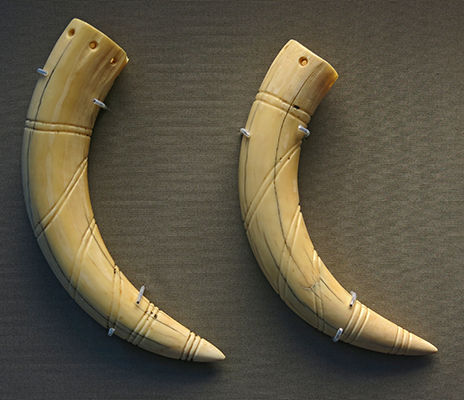
Tusks and tags
Rounded tusks and flat tags made of ivory or bone mimic the lethal incisor teeth of the hippopotamus, and like them are often found in pairs. Their purpose was to repel evil by turning the power of the animal against itself. The holes and notches at their base were for tying on a leather strap to enable handling during rituals, and to control their power.
This pair of small tusks made of hippopotamus incisor are pierced around the top for attachment, and have incised detail with remnants of black pigment in the incisions.
EA30728: Small tusk (hippopotamus incisor); pierced around the top for attachment; incised detail with remnants of black pigment in incisions. One of a pair with EA30729.
Length 175 mm, width 35 mm (max)
EA30729: Small tusk (hippopotamus incisor); pierced around the top for attachment; incised detail with remnants of black pigment in incisions. One of a pair with EA30728.
Length 163 mm, width 33 mm (max)
Catalog: Upper Egypt, Early Predynastic, EA30728, EA30729
Photo: Don Hitchcock 2015
Source: Original, British Museum
Text: Card at the British Museum © Trustees of the British Museum, CC BY-NC-SA 4.0
Naqada I: 3 900 BC - 3 650 BC
Tags
Left to right:
EA63416: Bone 'tag' with notches, Naqada I period, from Matmar.
Height 63 mm, width 23 mm, thickness 5 mm.
EA63417: Bone 'tag' with notches, Naqada I period, from Matmar.
Height 64 mm, width 20 mm, thickness 5 mm.
EA63418: Bone 'tag' with notches, Naqada I period, from Matmar.
Height 60 mm, width 21 mm, thickness 5 mm.
Catalog: Early Predynastic, EA63416, EA63417, EA63418
Photo: Don Hitchcock 2015
Source: Original, British Museum
Text: Card at the British Museum © Trustees of the British Museum, CC BY-NC-SA 4.0
Naqada I: 3 900 BC - 3 650 BC
Tags
Bone tags as above, but showing the reverse side of EA63417 in the centre.
Catalog: Early Predynastic, EA63416, EA63417, EA63418
Photo: © Trustees of the British Museum, CC BY-NC-SA 4.0
Source: Original, British Museum
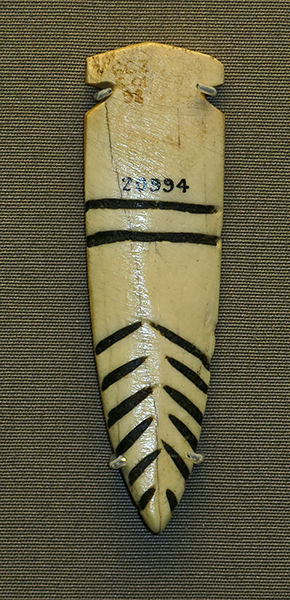
Naqada I: 3 900 BC - 3 650 BC
Tags
Bone tag from the Naqada I period.
Length 68 mm, width 21 mm, thickness 8 mm.
Catalog: Naqada I, EA20994
Photo: Don Hitchcock 2015
Source: Original, British Museum
Text: Card at the British Museum, http://www.britishmuseum.org/, © Trustees of the British Museum, CC BY-NC-SA 4.0
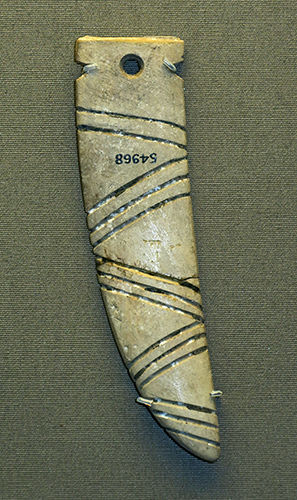
Naqada I: 3 900 BC - 3 650 BC
Bone Tusk
Bone object in form of tusk, with incised decoration, from the Naqada I period.
Length 97 mm, width 31 mm, thickness 5 mm.
Catalog: Naqada I, EA54968
Photo: Don Hitchcock 2015
Source: Original, British Museum
Text: Card at the British Museum, http://www.britishmuseum.org/, © Trustees of the British Museum, CC BY-NC-SA 4.0
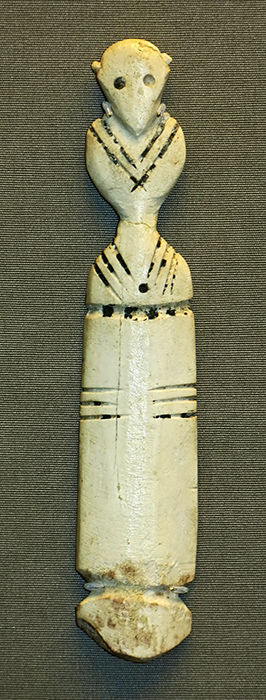
Naqada I: 3 900 BC - 3 650 BC
Tag
Tag with human form from Matmar.
The bone figure shown here is either a woman wearing necklaces or a man with a long pointed beard. Such ambiguity may have been intentional.
Tags with human attributes symbolised victory over the hippopotamus and other dangers. This tag belonged to a set of four found in a wooden box in a man's grave. When they were excavated, traces of leather remained in the notches.
Height 122 mm, width 25 mm, thickness 6 mm.
Catalog: Naqada I, EA63413
Photo: Don Hitchcock 2015
Source: Original, British Museum
Text: Card at the British Museum, http://www.britishmuseum.org/, © Trustees of the British Museum, CC BY-NC-SA 4.0
Naqada I: 3 900 BC - 3 650 BC
Amulets
These hippopotamus shaped amulets were originally created as matching pairs. Like the tusks and tags, they were probably used in rituals of protection.
Such figurines were often carved from pink limestone, intended to imitate the rosy tint of hippopotamus skin. In life, this colour is caused by viscous sweat, which protects the animals from sunburn and infection.
Left to right: EA43066, EA43067, EA57741, EA57742
EA43067: Pink limestone figure of a hippopotamus with projection emerging from its back. Ears, eyes and nostrils are represented by small protuberances; the muzzle is long and thin. A longitudinal groove forms the mouth. The projection on the back is hollowed out, square in shape and pierced by 4 holes. It is one of pair with EA43066.
Culture/period Predynastic (Naqada IC - IIB)
Length 73 mm, height 56 mm, width 20 mm
Naqada I: 3 900 BC - 3 650 BC
Bowl
Pottery bowl, white cross-lined. Yellow-white decoration on polished red background, with an image of a loom (?) being laid out - if so, the earliest depiction of a loom.
On this decorated dish may be seen two stick figures standing on either side of what has been identified as a loom for making textiles. If this is a representation of a loom, it is the earliest example known in the world.
Painted pottery appeared for the first time in the Naqada I period.
From Badari, Tomb 24/3802, Accession Number LDUCE-UC9547.
From the Naqada IC period, circa 3 700 BC.
Photo: Don Hitchcock 2018
Source: Original, Petrie Museum, London, England
Text: Card / online catalogue, the Petrie Museum, © 2015 UCL. CC BY-NC-SA license.
Naqada I: 3 900 BC - 3 650 BC
Amulets

Naqada I: 3 900 BC - 3 650 BC
String of Beads
String of beads, brown steatite and soap stone pendant, white with brown bands (zeolite).
String of beads: length 310 mm, pendant: length 33 mm, width 15 mm.
Catalog: Abadiyeh tomb C14, Naqada I, UC10826
Photo: Don Hitchcock 2015
Source: Original, Petrie Museum
Text: Card at the Petrie Museum, http://petriecat.museums.ucl.ac.uk/, © 2015 UCL. CC BY-NC-SA license.

Naqada I: 3 900 BC - 3 650 BC
String of beads
String of beads of clay, ivory, agate, and steatite discs.
Catalog: Naqada I, Naqada Tomb 1613, UC4215
Photo: Don Hitchcock 2015
Source: Original, Petrie Museum, London, England
Text: Card / online catalogue, the Petrie Museum, © 2015 UCL. CC BY-NC-SA license.

Naqada I: 3 900 BC - 3 650 BC
Strings of beads
Top: UC4196: String of beads: red corals, discs of steatite and soapstone.
Centre: UC4197: String of beads; red coral (Tubipora musica, see below).
Bottom: UC4198: String of beads; discs of steatite and soapstone.
( note that Petrie seems to distinguish between steatite and soapstone, which generally refer to the same talc mineral - Don )
Catalog: Naqada I, Naqada Tomb 1503, UC4196
Catalog: Naqada I, Naqada Tomb 1503, UC4197
Catalog: Naqada I, Naqada Tomb 1503, UC4198
Photo: Don Hitchcock 2015
Source: Original, Petrie Museum, London, England
Text: Card / online catalogue, the Petrie Museum, © 2015 UCL. CC BY-NC-SA license.
Naqada I: 3 900 BC - 3 650 BC
Combs
Hair and hair dressing were important to the early Egyptians. Combs with decorative or protective designs were carved from bone or ivory. These were used to groom and ornament the hair.
Left to right: EA63075, EA63406, EA18666.
EA63075: Ivory comb, Naqada I, findspot Mostagedda
Height 87 mm, thickness 5 mm, width 27 mm.
EA63406: Ivory comb, Naqada I, findspot Matmar
Height 125 mm, thickness 10 mm, width 34 mm.
EA18666: Ivory comb, Naqada I, findspot Akhmim
Height 121 mm, thickness 5 mm, width 34 mm, weight 14 gm.
Catalog: EA63075, Matmar 2632, Early Predynastic (Naqada I), EA63406, Early Predynastic (Naqada I), EA18666, Early Predynastic (Naqada I)
Photo: Don Hitchcock 2018
Source: Original, British Museum
Text: Card at the British Museum, http://www.britishmuseum.org/, © Trustees of the British Museum, CC BY-NC-SA 4.0
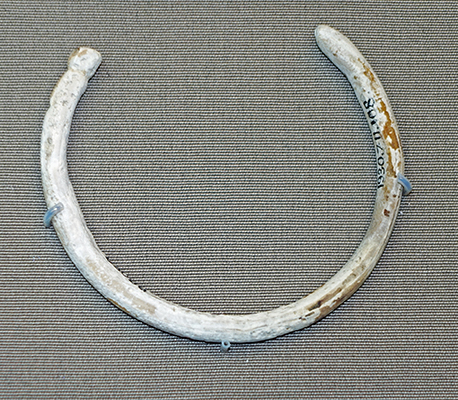
Naqada I: 3 900 BC - 3 650 BC
Forehead pendant
Hook-shaped seashells have been found in burials, on the foreheads of both men and women. They were worn as ornaments, perhaps to express social rank. It is unlikely that they were used to hold a veil, as some have suggested.
Catalog: Mostagedda 1890, Early Predynastic (Naqada I), EA63088
Photo: Don Hitchcock 2018
Source: Original, British Museum
Text: Card at the British Museum, http://www.britishmuseum.org/, © Trustees of the British Museum, CC BY-NC-SA 4.0
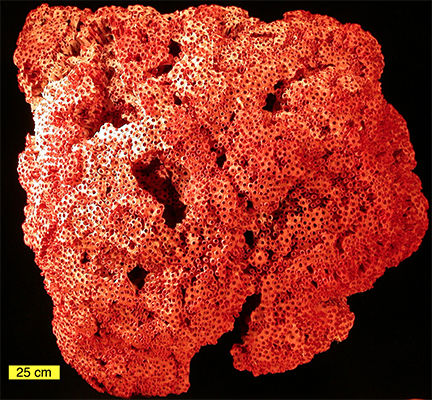
The Organ pipe coral (Tubipora musica) is an alcyonarian coral native to the waters of the Indian Ocean and the central and western regions of the Pacific Ocean. It is the only known species of the genus Tubipora. This species is a soft coral but with a unique, hard skeleton of calcium carbonate that contains many organ pipe-like tubes.
Photo: Mark A. Wilson (Department of Geology, The College of Wooster).
Permission: Public Domain
Text: Wikipedia

Naqada I: 3 900 BC - 3 650 BC
String of beads
String of beads, coral tubes.
Length 914 mm.
Catalog: Naqada I, Naqada Tomb 1789. Xia Nai catalogue number 95, UC5000
Photo: Don Hitchcock 2015
Source: Original, Petrie Museum, London, England
Text: Card / online catalogue, the Petrie Museum, © 2015 UCL. CC BY-NC-SA license.

(top) Naqada II: 3 650 BC - 3 300 BC
(bottom) Naqada I: 3 900 BC - 3 650 BC
String of beads
Top, UC9588: String of beads from Badari. 3 big and 4 small pendants: alabaster; rings: soapstone and shell; corals; shells: 1 Conus, 1 Nerita.
Length 343 mm.
Publications: Brunton, Guy. Badarian Civilisation and predynastic remains near Badari. pl. L 89 b3, b12, Pl. L 86 k16, p4; Pl. L 86 c6, c8, m10, m22, r4
Bottom, UC9589: String of beads from Badari; rings: carnelian, calcite and black limestone.
Length 406 mm.
Publications: Brunton, Guy. Badarian Civilisation and predynastic remains near Badari. Pl. L 86 12, p2, t6, m8
Catalog: From tomb 24/1664. Xia Nai catalogue number 6, UC9588
Catalog: From tomb 24/1664. Xia Nai catalogue number 7, UC9589
Photo: Don Hitchcock 2015
Source: Original, Petrie Museum, London, England
Text: Card / online catalogue, the Petrie Museum, © 2015 UCL. CC BY-NC-SA license.

Naqada I: 3 900 BC - 3 650 BC
Naqada II: 3 650 BC - 3 300 BC
String of beads
UC5001, Naqada I, Beads, two carnelian, barrel and ring shaped, one glazed composition, faience.
Publications: Kaczmarczyk,. Ancient Egyptian faience: an analytical survey of Egyptian faience from predynastic to Roman times.
UC5002, Naqada II, String of beads, glazed steatite, cylindrical.
Length 178 mm
UC5003, Naqada II, String of beads, clay, double cone, one pottery disc.
Diameter 30 mm, length 305 mm
Catalog: Naqada I, Naqada Tomb 1330. Xia Nai catalogue number 53, UC5001
Catalog: Naqada II, Naqada Tomb 1589. Xia Nai catalogue number 49, UC5002
Catalog: Naqada II, Naqada Tomb 518. Xia Nai catalogue number 74, UC5002
Photo: Don Hitchcock 2015
Source: Original, Petrie Museum, London, England
Text: Card / online catalogue, the Petrie Museum, © 2015 UCL. CC BY-NC-SA license.
Naqada I: 3 900 BC - 3 650 BC
Bowl
Bowl with Hippopotami and crocodile.
The hippopotami and crocodile (in low relief on the right of the image) on the rim of this bowl portray the dangers along the Nile's banks. Both animals were feared, but also admired as good mothers.
Their qualities would later be embodied in the goddess Tawaret, depicted as part hippo and part crocodile. Her role as protector of pregnant mothers and young children may explain the presence of this bowl in the grave of a woman and infant.
Redware pottery bowl, five figures of hippopotami and one crocodile on rim.
Height 138 mm, diameter 295 mm, weight 1670 grams.
Catalog: Matmar 2646, Early Predynastic (Naqada IIA), EA63408
Photo: Don Hitchcock 2015
Source: Original, British Museum
Text: Card at the British Museum, http://www.britishmuseum.org/, © Trustees of the British Museum, CC BY-NC-SA 4.0
Naqada I: 3 900 BC - 3 650 BC
Cosmetic Palette
Mudstone cosmetic-palette carved in the form of a gazelle(?) Inlaid ivory annules on both sides represent the eyes. Single piercing.
This palette was used as a mortar to grind pigments for cosmetics. As climate change gradually turned the Sahara from a relatively lush savannah into an arid desert, people became restricted to the more fertile valley of the Nile, which was an important source of food.
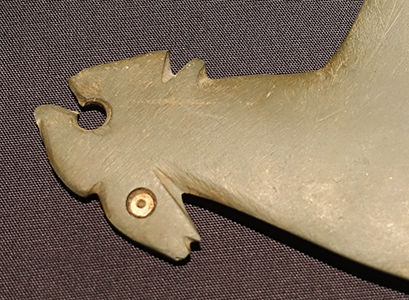
Close up of the head of the animal above.
Palettes were often made in the form of animals, representing the varied fauna of the Nile valley in Egypt. The presence of these cosmetic palettes in graves illustrates the Egyptian beliefs that appearance continued to be of importance in the afterlife.
Length 286 mm, width 143 mm, thickness 13 mm
Catalog: Predynastic (Naqada II-III), EA35049, 1871,0619.425
Photo: Don Hitchcock 2017
Text: Card, http://www.britishmuseum.org/, © Trustees of the British Museum, CC BY-NC-SA 4.0
Source: Exhibition by the British Museum at the National Museum of Australia, Canberra
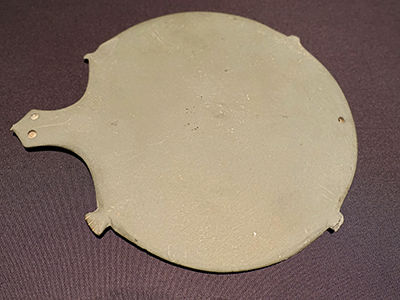
Naqada I: 3 900 BC - 3 650 BC
Cosmetic Palette
Mudstone cosmetic-palette in the form of a turtle.
Height 187 mm, width 213 mm, thickness 12 mm, weight 600 gm.
Catalog: Predynastic (Naqada I) EA36367
Photo: Don Hitchcock 2017
Text: Card, http://www.britishmuseum.org/, © Trustees of the British Museum, CC BY-NC-SA 4.0
Source: Exhibition by the British Museum at the National Museum of Australia, Canberra
Naqada I: 3 900 BC - 3 650 BC
Cosmetic Palette
Mudstone cosmetic-palette in the form of a hippopotamus.
Height 170 mm, width 75 mm, thickness 4 mm, weight 86 gm.
Catalog: Predynastic (Naqada I) EA58336
Photo: Don Hitchcock 2017
Text: Card, http://www.britishmuseum.org/, © Trustees of the British Museum, CC BY-NC-SA 4.0
Source: Exhibition by the British Museum at the National Museum of Australia, Canberra
Naqada I: 3 900 BC - 3 650 BC
Bowl with painted hippopotami
The hippopotamus is commonly shown on the white on red pottery of the Early Predynastic period. Belligerent in the water and destructive on land, where they come to feed, angry hippos were much feared. Here they are shown at peace in their natural setting, surrounded by stylised plants. On other pots they are shown being hunted and controlled.
Redware pottery bowl, with a flat base and sides widened to an everted rim, chipped. Brown slip and motifs and stylised hippopotami rendered in cream lines. Height 95 mm, diameter 153 mm, weight 597 grams, probably from Naqada, Early Predynastic (Naqada I).
Catalog: EA53882
Photo: Don Hitchcock 2015, 2018
Source: Original, British Museum
Text: Card at the British Museum, http://www.britishmuseum.org/, © Trustees of the British Museum, CC BY-NC-SA 4.0
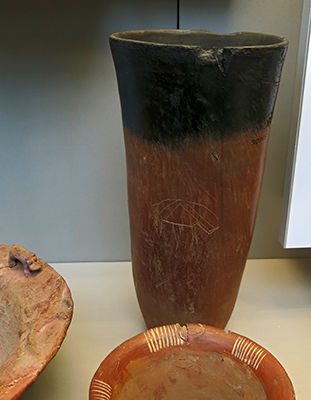
Naqada I: 3 900 BC - 3 650 BC
Black topped beaker with pot mark
The drawing of the hippopotamus was scratched onto this pot after firing. It may denote the owner's name, or could be a protective device.
Catalog: Hiw / Hu, Early Predynastic (Naqada I - IIA) EA30965
Photo: Don Hitchcock 2015
Source: Original, British Museum
Text: Card at the British Museum, http://www.britishmuseum.org/, © Trustees of the British Museum, CC BY-NC-SA 4.0
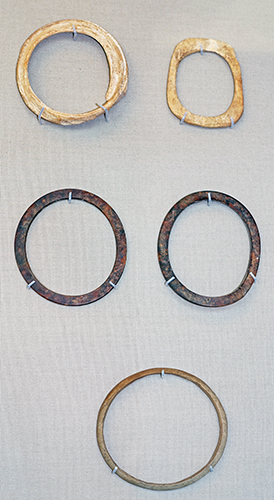
Naqada I: 3 900 BC - 3 650 BC
Bangles
Bangles were always popular with women and children, but tastes changed. Bangles cut from bone, ivory or conch shells were in style from early times, but gradually lighter weight models in brown horn were preferred. Desirable in the First Dynasty, bangles chipped from flint may have conferred protection.
(Top left) EA57582: A roughly shaped shell bangle of uneven circumference. The surface is ridged and pitted, partly through wear and partly because the natural contours of the shell have not been smoothed away.
Diameter 51 mm external, 40 mm internal, height 10 mm.
Catalog: Naqada I, Qaw el-Kebir, Grave register pl. XXXI, EA57582
( note that the physical museum tag gives the identification Badari 1743, Early Predynastic (Naqada IIA), EA57582 - Don )
(Top right) EA63083: A bangle cut from a solid piece of bone. Its profile is slightly concave on one side and convex on the other. It is roughly rectangular in shape with rounded corners and an oval inner circumference.
Height 49 mm external, width 38 mm internal, thickness 5 mm.
Catalog: Mostagedda 1887, Early Predynastic (Naqada I), EA63083
(middle left) EA38345: A thin, flat, oval-shaped tortoise-shell bangle.
Diameter 61 mm (external), width 5 mm, depth 3 mm.
Said to be from Saqqara by the Revd. Greville J. Chester, but the provenance is unlikely. His statements of the origin of pieces sold or presented by him to the British Museum are often based on where he acquired them. His 'provenances' are frequently plausible but should always be treated with caution.
It is noticeable that all excavated examples of tortoise-shell bangles which can be dated firmly to the Predynastic Period are open hoops, often with extensive overlapping of the ends. Moreover, the open-ended form continued to be used by the C-Group people of Nubia.
Catalog: Saqqara (Memphis) (?), Naqada II (?), EA38345
(middle right) EA38346: A flat, thin, oval tortoise-shell bangle distorted by damp.
Diameter 63 mm (external), width 5 mm, depth 3 mm.
Said to be from Saqqara by the Revd. Greville J. Chester.
Catalog: Saqqara (Memphis) (?), Naqada II (?), EA38346
(lowest) EA67631: A thin bracelet of brown chert, roughly rounded on the outer edge and flat on the inside.
Diameter: 65 mm, thickness 6 mmm.
Catalog: Tarkhan 149, First Dynasty, EA67631
Photo: Don Hitchcock 2018
Source: Original, British Museum
Text: Card at the British Museum, http://www.britishmuseum.org/, © Trustees of the British Museum, CC BY-NC-SA 4.0
The growth of a belief in the after life
( The grave a23 at El Amrah, excavated in 1901, shows that even graves dug in the ground were furnished with grave goods similar to those in later, more elaborate, and expensive burial places such as rock tombs, and clearly demonstrates the role of magic in the life envisaged for the loved one after death - Don )
Naqada I: 3 900 BC - 3 650 BC
Mace
This model mace is about the same size as a real one. The mud handle was formed over a core of reeds and painted with red stripes to imitate leather bindings, which improved strength and grip. Black paint on the head was meant to replicate diorite, the hard black and white stone favoured for conical mace heads.
Catalog: El Amrah a23, Naqada I, EA66222
Photo: Don Hitchcock 2018
Source: Original, British Museum
Text: Card at the British Museum, http://www.britishmuseum.org/, © Trustees of the British Museum, CC BY-NC-SA 4.0
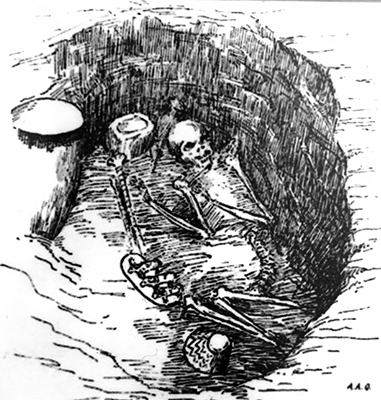
Drawing showing the model mace (above) with model cows (below) as found in grave a23 at El Amrah in 1901.
Rephotography: Don Hitchcock 2018
Drawing: Egypt Exploration Society, London
Source: British Museum
Text: Card at the British Museum, http://www.britishmuseum.org/, © Trustees of the British Museum, CC BY-NC-SA 4.0
Naqada I: 3 900 BC - 3 650 BC
Model cattle
Cattle were used to pull the plough and shoulder other burdens. Their meat was a luxury and the size of the herd was an indication of wealth. This clay model of four cows, originally painted black and white, was placed in a grave to provide its owner with all the benefits of a large herd in the afterlife. The same grave contained a model mace.
A fired clay model of four cows standing in a row and all facing in the same direction. The head of one is missing, two others lack one horn and most of one horn is also missing from a third figure. The legs of the animals have been simplified into single supports at front and back, with no attempt to distinguish right and left legs.
The model was made from low-fired clay, which has remained dull grey in colour and is friable. Traces of linen textile adhere to the surface as well as faint traces of black and white paint. Repaired from several pieces, with a small collection of loose fragments not incorporated.
Height 107 mm, width 297 mm, depth 205 mm, weight 2040 grams.
Catalog: circa 3500 BC, El Amra, grave a23. Early Predynastic (Naqada I) EA35506
Photo: Don Hitchcock 2015
Source: Original, British Museum
Text: Card at the British Museum, http://www.britishmuseum.org/, © Trustees of the British Museum, CC BY-NC-SA 4.0
The important discovery and excavation of 'the Hunter's Grave'
el-Mahasna H23,
Naqada I: 3 900 BC - 3 650 BC
( This grave is important because it is such a complete record of an inexpensive grave, dug in the ground rather than part of a large stone tomb, from the Early Predynastic, and it is not of a priest or high official. It shows the growth of a belief in the after life, and has many of the accoutrements of later graves in well made and expensive tombs, such as facsimiles of grave goods including an ersatz mace head and food. It is a more elaborate and well furnished version of the grave at El Amra, grave a23 from Naqada I, described immediately above.
- Don )
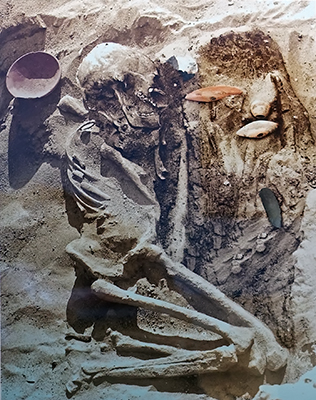
Naqada I: 3 900 BC - 3 650 BC
Hunter's Grave
Modified photograph of a hunter's grave, el-Mahasna H23, circa 3 700 BC, when excavated in 1902, based on excavation records of the Egypt Exploration Society, London.
Most graves of the Early Predynastic period contain a standard range of goods giving us few clues about their owners. Grave H23 at Mahasna is an exception. The objects show that the occupant was a hunter.
A copper harpoon and several stone maces, or clubs, were found in front of his face. By his feet lay his two hunting dogs. Imitation mud maces were provided so that he could hunt even if his weapons were lost or stolen. There were also models of garlic and dates to provide a magical supply of food.
Rephotography: Don Hitchcock 2018
Source: British Museum
Text: Card at the British Museum, http://www.britishmuseum.org/, © Trustees of the British Museum, CC BY-NC-SA 4.0
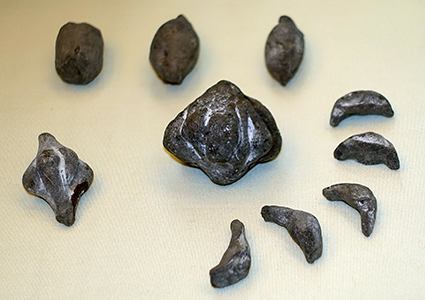
Naqada I: 3 900 BC - 3 650 BC
Hunter's Grave - Models of food
Mud models of dates and garlic heads, with individually formed cloves, were buried with the hunter. These magical substitutes would always be fresh. Despite their humble material, such models were placed in only the richest tombs.
Catalog: el-Mahasna H23, EA49013
Rephotography: Don Hitchcock 2018
Source: British Museum
Text: Card at the British Museum, http://www.britishmuseum.org/, © Trustees of the British Museum, CC BY-NC-SA 4.0
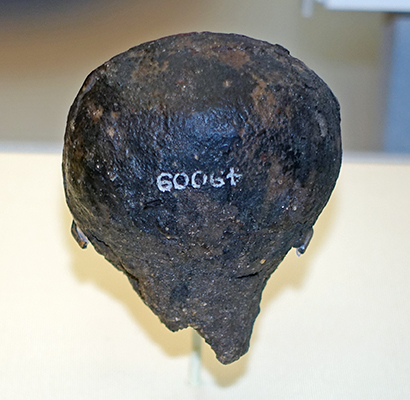
Naqada I: 3 900 BC - 3 650 BC
Hunter's Grave - Model of a mace
Model of a piriform or 'pear-shaped' mace-head made of unfired Nile clay.
Diameter 45 mm.
This object originally had a wooden handle, and may have been painted, although no trace of pigment survives. A real stone mace of the same shape was found in the same tomb (EA 49004).
Catalog: el-Mahasna H23, EA49009 (note that the catalog number is upside down in this view)
Photo: Don Hitchcock 2018
Source: British Museum
Text: Card at the British Museum, http://www.britishmuseum.org/, © Trustees of the British Museum, CC BY-NC-SA 4.0
Text above: poster at the British Museum, © Trustees of the British Museum, CC BY-NC-SA 4.0
The Hunter's maces
Stone mace heads were fitted onto wooden handles. They were used in hunting and warfare to dispatch the fallen prey or enemy. In the Predynastic period, hunting became a sport for the elite, who captured animals for ceremonies and ritual feasts. The mace then became a status symbol, and changed its form over time.
Initially, mace heads were conical or disk-shaped. Later they became pear shaped or spherical. Double pointed maces were in vogue for only a short time in the Early Predynastic period. It is unusual to have this number and variety of maces in one grave.
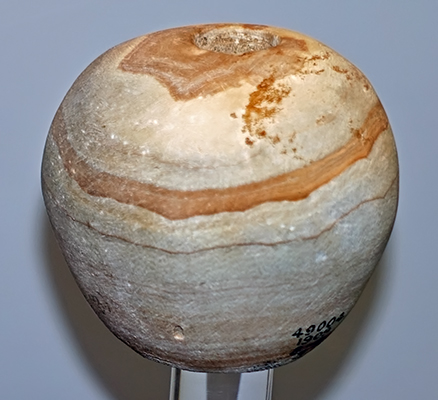
Naqada I: 3 900 BC - 3 650 BC
Hunter's Grave - mace
Pear-shaped mace-head of banded limestone with central boring and part of the wooden haft.
Diameter 60 mm, height 55 mm, length of wooden handle (not shown) 45 mm, weight 168 gm.
Catalog: el-Mahasna H23, EA49004
Photo: Don Hitchcock 2018
Source: British Museum
Text: Card at the British Museum, http://www.britishmuseum.org/, © Trustees of the British Museum, CC BY-NC-SA 4.0
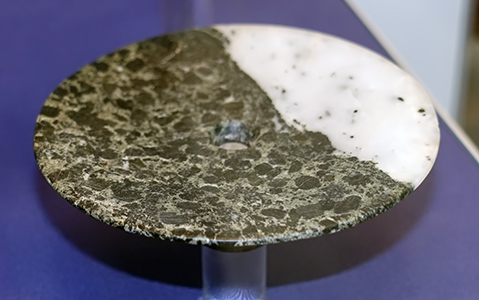
Naqada I: 3 900 BC - 3 650 BC
Hunter's Grave - mace
Disk shaped mace-head of black and white diorite, with a slightly convex upper surface. The lower surface is shown in this image.
Diameter 93 mm, height 48 mm, weight 140 gm.
When found before the face of the man in the grave, the mace-head had remnants of its wooden handle preserved.
Catalog: el-Mahasna H23, EA49003
Photo: Don Hitchcock 2018
Source: British Museum
Text: Card at the British Museum, http://www.britishmuseum.org/, © Trustees of the British Museum, CC BY-NC-SA 4.0
Naqada I: 3 900 BC - 3 650 BC
Hunter's Grave - mace
Elongated biconical mace-head, pointed at each end, made of pink limestone.
Height 186 mm, width 55 mm, depth 37 mm, weight 322 gm.
When found before the face of the man in the grave, the mace-head had remnants of its wooden handle preserved.
Catalog: el-Mahasna H23, EA49005
Photo: Don Hitchcock 2018
Source: British Museum
Text: Card at the British Museum, http://www.britishmuseum.org/, © Trustees of the British Museum, CC BY-NC-SA 4.0
Naqada I: 3 900 BC - 3 650 BC
Hunter's Grave - mace
Biconical mace-head, pointed at each end, made of banded limestone, centrally bored.
Length 120 mm, width 37 mm, depth 40 mm, weight 44 gm.
( I am not sure about the weight given by the online catalog. Using those dimensions and comparing it to those of the 322 gm mace above, this one should have been about half its weight, or about 150 gm, on a very rough estimate - Don )
When found before the face of the man in the grave, the mace-head had remnants of its wooden handle preserved.
Catalog: el-Mahasna H23, EA49005
Photo: Don Hitchcock 2018
Source: British Museum
Text: Card at the British Museum, http://www.britishmuseum.org/, © Trustees of the British Museum, CC BY-NC-SA 4.0
Naqada I: 3 900 BC - 3 650 BC
Hunter's Grave - flint blade
Flint knife with some retouch ( mostly inverse retouch - Don ) on one side.
Length 122 mm.
Flint tools for daily life tasks were often fashioned economically in contrast to ritual tools which were more lavishly made. This simple blade was probably designed for hunting, but had many uses.
Catalog: el-Mahasna H23, EA49002
Photo: Don Hitchcock 2018
Source: British Museum
Text: Card at the British Museum, http://www.britishmuseum.org/, © Trustees of the British Museum, CC BY-NC-SA 4.0
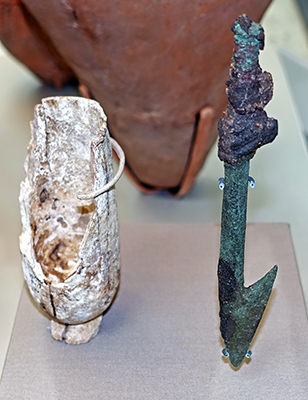
Naqada I: 3 900 BC - 3 650 BC
Hunter's Grave - ivory jar and copper harpoon
The footed cylindrical ivory jar with a small ledge rim, EA49011, was made from the tusk of a large hippopotamus, perhaps one the hunter had caught himself, using the copper harpoon found in his grave. Hippopotamus hunting required bravery and was imbued with religious significance. Tools and weapons were made of copper at this time, but were rarely put in tombs.
Diameter 45 mm, height 117 mm, weight 110 gm.
The vase originally had two small loop handles. The walls are thin and well cut. Pieces probably belonging to this vessel are registered as EA 49012.
The copper alloy harpoon, EA49007, was originally wrapped in cloth, a trace of which still adheres to the barb. The point is sharpened on both sides. The harpoon head was embedded in a shaft and at the junction was the end of a thick cord tied around the copper, remnants of which still survive. The cord may have bound the head to the shaft or more likely, the head was not firmly fixed to the shaft and would detach when the barb struck the prey (fish or hippo) but could be found by use of the cord and a float.
Height 151 mm, width 17 mm and 26 mm, weight 78 gm.
Catalog: el-Mahasna H23, EA49011, EA49007
Photo: Don Hitchcock 2018
Source: British Museum
Text: Card at the British Museum, http://www.britishmuseum.org/, © Trustees of the British Museum, CC BY-NC-SA 4.0
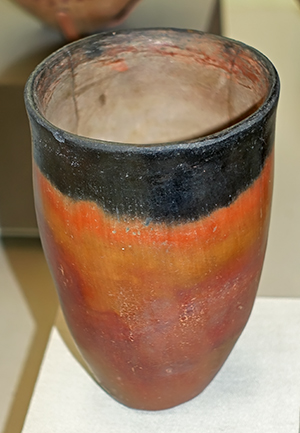
Naqada I-II: 3 900 - 3 300 BC
Pots similar to those found in the Hunter's Grave
These red bowls and the black-topped jar are similar to those found with the hunter.
Only finely polished pottery for serving food was placed in graves during Early Predynastic times. The lack of cooking and storage vessels suggests that the family was responsible for providing meals for the deceased.
Catalog: Naqada I-II, EA58211, EA30954, EA49023
Photo: Don Hitchcock 2018
Source: British Museum
Text: Card at the British Museum, http://www.britishmuseum.org/, © Trustees of the British Museum, CC BY-NC-SA 4.0
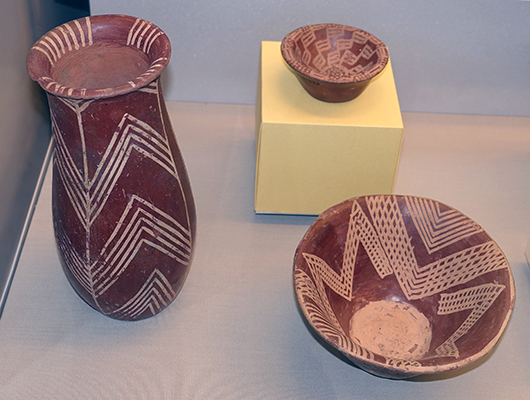 Naqada I-II: 3 900 - 3 300 BC
Naqada I-II: 3 900 - 3 300 BC
White painted pottery
The geometric designs painted in white were probably meant to imitate basketry. In this way, a fragile material was transformed into a long lasting one, enabling its permanent use in the grave.
(left) EA58199: Slender jar of Nile silt pottery with flat base, slight belly in lower part and out-curving rim, coated with red slip and burnished on the exterior and inside the rim. Decorated on the exterior in white paint with a series of chevrons divided by vertical lines. Groups of diagonal strokes are painted on the interior rim.
Predynastic (Naqada I-IIA)
Diameter 80 mm, height 201 mm, weight 540 gm.
The design may be a reflection of basketry or might evoke vegetation. The fine lines of the paint work suggest the vessel might originate from Naqada.
(front right) EA30987: Bowl of Nile silt pottery with flat base, flaring sides and everted rim, coated with red slip and burnished. Interior decorated in creamy-white pigment with chevrons and cross-hatched geometric motifs.
(Naqada I-IIA)
Diameter 140 mm, height 70 mm, weight 270 gm.
(back centre) EA57523: Badari 1743, Early Predynastic (Naqada IIA), white cross-line ware, small polished red pottery bowl of Nile silt clay, with flat bottom, flaring sides and everted rim, coated with red slip, burnished, and decorated on the interior in yellow-white paint with a radial design of stepped, hatched rectangles. At the rim the space between the rectangles is filled with dots, and a dot-filled circle occupies the tondo (circular work of art). The design may imitate basketry.
Predynastic (Naqada IIA, excavated at Qaw el-Kebir (Hemamieh).
Diameter 76 mm, height 35 mm, weight 81 gm.
Photo: Don Hitchcock 2018
Source: British Museum
Text: Card at the British Museum, http://www.britishmuseum.org/, © Trustees of the British Museum, CC BY-NC-SA 4.0
Naqada I-II: 3 900 - 3 300 BC
Basalt Jars
Geological analysis shows that these jars were made from basalt deposits found in Lower Egypt. Local artisans carved them into the distinctive shapes of pottery from Maadi. Basalt jars were traded to the Upper Egyptians from early times.
(left) Predynastic footed jar, basalt.
Dimensions: Diameter 100 mm, height 155 mm, weight 1200 grams (?).
Catalog: Karnak (Thebes) (?), EA43398
(right) Naqada I footed jar, basalt.
Dimensions: Diameter 82 mm, height 100 mm, weight 560 grams.
Catalog: EA26654
(centre right) Predynastic blackware pottery jar with foot and two handles.
Height: 215 mm.
Catalog: EA35353
(far right) Blackened polished brown ware pottery jar.
Catalog: Badarian culture, Mostagedda, EA62991
Photo: Don Hitchcock 2018
Source: Original, British Museum
Text: Card at the British Museum, © Trustees of the British Museum, CC BY-NC-SA 4.0
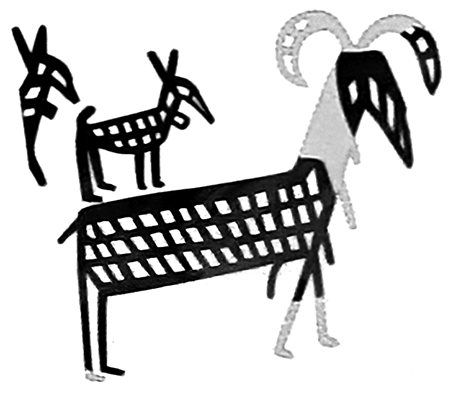
Naqada I-II: 3 900 - 3 300 BC
Painted Female Statuette
Pigments ground on palettes were applied to the body of this statuette. On the front of her body are elements of the fertile Nile valley including a hippopotamus on her belly and geometric symbols probably representing water and plants.
Green malachite surrounds her eyes. This pigment had medicinal qualities and was valued for its colour, evoking new growth. On her back, collared dogs hunt antelopes, as shown in the photo at left, from the museum card. They represent control over the dangers of the desert.
Her elaborate jewellery, including bracelets, anklets, and several necklaces in red, suggests a special occasion.
This statuette may represent a goddess, priestess or participant in a ritual ceremony.
The online catalog gives some more information:
Ceramic female figure in a seated position; beak-like face and hands to the breasts; black painted geometric decoration, green paint around eyes, red paint at neck. Composed of several fragments and heavily restored by dealer.
Height 312 mm, length: 250 mm, width: 174 mm, weight 2600 gm.
Catalog: EA58064
Photo: Don Hitchcock 2018
Source: Original, British Museum
Text: Card at the British Museum, © Trustees of the British Museum, CC BY-NC-SA 4.0
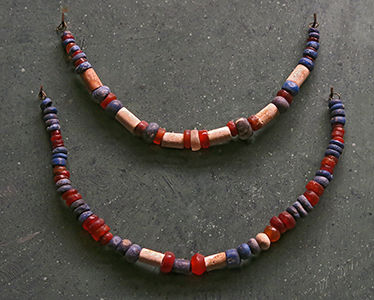
Naqada I - II: 3 900 - 3 300 BC
Bead Necklaces
Necklaces of beads in calcite, carnelian and lapis-lazuli from Cimetière de Zaouiet el-Maïetin.
Photo: Don Hitchcock 2015
Source: Original, Musée du Louvre
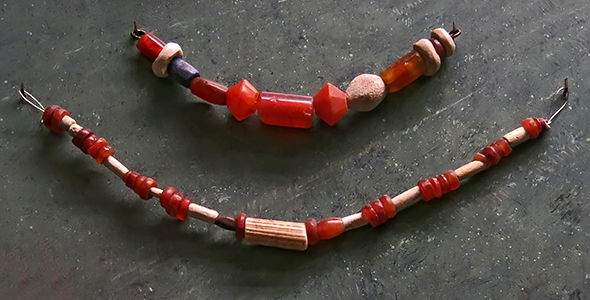
Naqada I - II: 3 900 - 3 300 BC
Bead Necklaces
Above: E11440, beads in decomposed faience, cornelian and lapis-lazuli, Naqada II, 3 500 - 3 100 BC, from Cimetière de Zaouiet el-Maïetin.
Below: E11439, beads in carnelian, calcite and shell, Naqada I - II, 3 800 - 3 100 BC, from Cimetière de Zaouiet el-Maïetin.
Photo: Don Hitchcock 2015
Source: Original, Musée du Louvre
Naqada I - II: 3 900 - 3 300 BC
Diamond-shaped palettes
Diamond-shaped or rhomboid palettes first appeared in the Early Predynastic period, about 3 800 BC, and often show signs of being well used. The depression in the centre of the large example was created through grinding cosmetic minerals. Some were also decorated, and on the smaller palette the two lines in raised relief may represent snakes.
Catalog: Early Predynastic (Naqada I - II) EA67725, EA67718
Photo: Don Hitchcock 2018
Source: Original, British Museum
Text: Card at the British Museum, http://www.britishmuseum.org/, © Trustees of the British Museum, CC BY-NC-SA 4.0
Naqada I - II: 3 900 - 3 300 BC
Turtle palette
Mudstone palette in the shape of a turtle with a single piercing at the rump.
The soft shelled turtle, Trionyx triunguis, inhabited the Nile's depths. Shadowy and secretive, it also had a nasty bite. It was later considered a symbol of evil and an enemy of the sun-god. Palettes in turtle form were used to repel the animal's influence and promote good health.
Softshell turtles are among the most bizarre living turtles, and can be easily distinguished from typical turtles by their flat shells, lack of scales, and highly modified skulls.
Length 122 mm, width 97 mm, thickness 7 mm.
Catalog: Early Predynastic (Naqada 1C - IIB), EA67709
Photo: Don Hitchcock 2018
Source: Original, British Museum
Text: Card at the British Museum, http://www.britishmuseum.org/, © Trustees of the British Museum, CC BY-NC-SA 4.0
Additional text: https://www.ncbi.nlm.nih.gov/pmc/articles/PMC3210987/
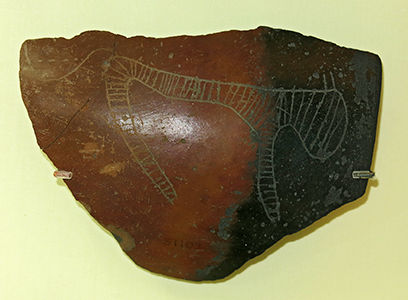
Naqada I - II: 3 900 - 3 300 BC
Sherd with incised cat
Broken pottery was used like note paper in ancient Egypt. This figure of a large cat was scratched onto a carefully chosen fragment to relay a message or perhaps to record a transaction. Although understood by its users, this form of visual communication did not lead directly to writing.
Two lip-fragments of a red and black vessel decorated with an incised lion on the exterior.
Height 112 mm, width 150 mm
Catalog: Abydos Early Predynastic (Naqada I - II) EA51103
Photo: Don Hitchcock 2015
Source: Original, British Museum
Text: Card at the British Museum, http://www.britishmuseum.org/, © Trustees of the British Museum, CC BY-NC-SA 4.0
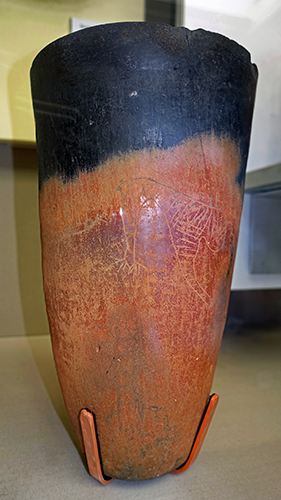
Naqada I - II: 3 900 - 3 300 BC
Jar with pot mark
Graphic communication began in Early Predynastic times with symbols, such as this lion, incised on pottery. Only a limited number of signs were used, suggesting that they conveyed specific meanings.
As the symbols do not refer to sounds of the spoken language, they are not considered true writing. The lion on this jar may indicate the owner's name.
Black-topped pottery beaker vase made of Nile silt clay, exterior coated with red and blackened slip and burnished. Incised on one side of the body is the schematic figure of a large cat, considered to represent a lion. On the other side the figure of a 'double-axe' has been incised.
Height 295 mm, diameter 170 mm (rim), diameter 153 mm (shoulder) diameter 95 mm (base), weight 1950 grams.
Catalog: Early Predynastic (Nagada I), Mahasna, Grave H10, EA49019
Photo: Don Hitchcock 2018
Source: Original, British Museum
Text: Card at the British Museum, http://www.britishmuseum.org/, © Trustees of the British Museum, CC BY-NC-SA 4.0
Predynastic temples
3 900 BC - 3 100 BC
Temples in Predynastic Egypt were pillared structures made of wood and reeds, with walls of decorative matting and painted plaster. They were erected to honour the gods as well as the spirits of deceased local rulers. This artist's reconstruction is based on foundations and other traces found during excavations at the site of Hierakonpolis.
Dating to about 3 700 BC, these finds provide the first evidence for the appearance of early temples. The influence of the ancient protoypes can be seen in all later structures. When new temples were built of mud brick and later in stone, the Egyptians used tiles and carvings to reproduce the original wood and matting.
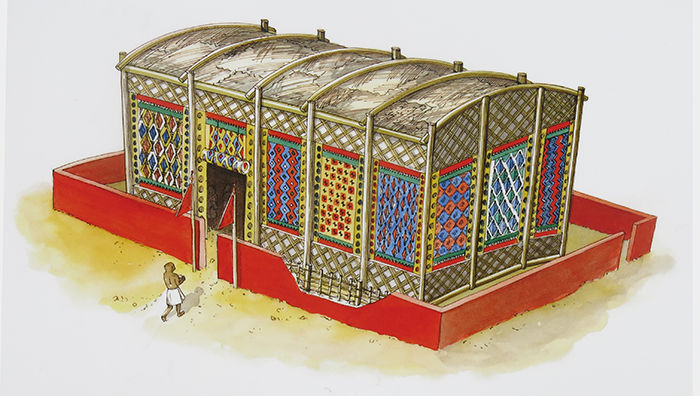
Artist's reconstruction of a Predynastic temple at Hierakonpolis
Photo: Unknown artist
Rephotography: Don Hitchcock 2015
Source: Poster, British Museum © Trustees of the British Museum, CC BY-NC-SA 4.0
Text: Card at the British Museum, © Trustees of the British Museum, CC BY-NC-SA 4.0
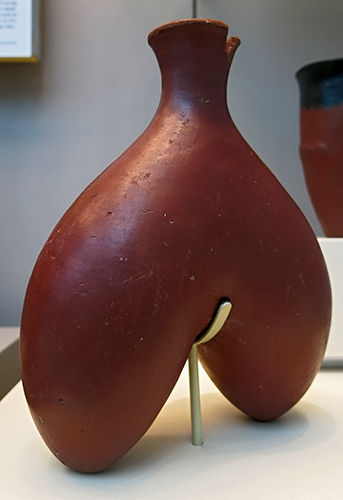
Early Predynastic (Naqada IIA)
Double flask circa 4 000 BC - 3 000 BC.
Death was believed to be a return to the womb to be reborn, and the ancient Egyptians took this idea literally. This flask has a single neck that divides into two containers that represent breasts. Such jars provided the newly reborn dead with the nurture and nourishment they needed to flourish in the afterlife.
Polished redware pottery jar. Handmade, with a turned (?) rim. There is a dark red slip on the exterior and inside the rim, and it is burnished vertically. The jar is of an unusual shape with two lobes dependent on a single neck.
Height 208 mm, width 165 mm, depth 95 mm, weight 712 grams.
Mostagedda, Grave 1697, Early Predynastic (Naqada IIA)
Catalog: EA62391
Photo: Don Hitchcock 2015
Source: Original, British Museum
Text: Card at the British Museum, http://www.britishmuseum.org/, © Trustees of the British Museum, CC BY-NC-SA 4.0
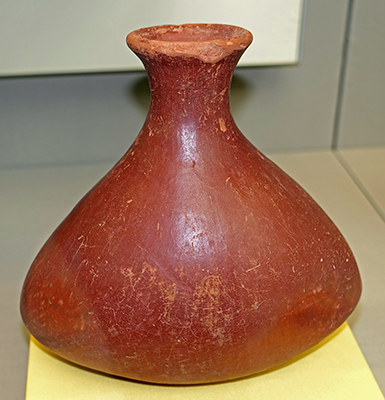
Early Predynastic (Naqada IIA)
Polished redware pottery jar of unusual shape, circa 4 000 BC - 3 000 BC.
Date is given as Naqada IIA from the museum card, but listed as Naqada I in the online catalog.
The shape of this jar probably imitates an animal skin churn used for making soft white cheese. Processing of dairy products was important for preventing spoilage and disease. Fresh milk, especially from cows, was considered a delicacy.
Height 162 mm, width 160 mm, depth 95 mm, weight 600 grams.
Mostagedda, Grave 1687, Early Predynastic (Naqada IIA)
Catalog: EA62390
Photo: Don Hitchcock 2018
Source: Original, British Museum
Text: Card at the British Museum, http://www.britishmuseum.org/, © Trustees of the British Museum, CC BY-NC-SA 4.0
Visions of the afterlifeText above: Poster at the British Museum, © Trustees of the British Museum, CC BY-NC-SA 4.0.
Early-Middle Predynastic
3 900 - 3 300 BC
People in Predynastic Upper Egypt saw death as a complex voyage to rebirth in the afterlife. From the beginning, the dangerous and destructive hippopotamus dominated the culture's imagery. The hazards of this world were believed to continue in the next, and protection was essential.
Later, depictions of life after death became more serene. Pottery made specifically for the grave was decorated with ideal landscapes and religious ceremonies. Such rituals may have been connected to funerals, or the annual Nile flood, which renewed the parched land. These rituals integrated the dead into the cosmic cycle of rebirth for eternity.
Emergence of the godsText above: Poster at the British Museum, © Trustees of the British Museum, CC BY-NC-SA 4.0.
Middle Predynastic— First Dynasty
3500-2890 BC
New shapes and symbols prefiguring the important gods of Egypt began to emerge toward the end of the Predynastic period. This was a time of change: the climate grew drier, social and political structures were being transformed. Attributing animal forms to the gods helped to explain these new realities. The emphasis was now on proactive power, a message that was later consolidated by the early kings, who saw themselves as the gods' representatives on earth.
Naqada II: 3 650 BC - 3 300 BC
Hippopotamus-shaped cosmetic palette
Mudstone cosmetic-palette in the form of a hippopotamus.
Height 140 mm, width 278 mm, weight 450 gm.
Photo: Don Hitchcock 2018
Source: Original, British Museum
Text: Card at the British Museum, http://www.britishmuseum.org/, © Trustees of the British Museum, CC BY-NC-SA 4.0
Naqada II: 3 650 BC - 3 300 BC
Ram-shaped cosmetic palette
Mudstone cosmetic-palette in form of ram with an inlaid shell eye.
Height 112 mm, width 133 mm, weight 250 gm.
Catalog: Early Predynastic, EA20910
Photo: Don Hitchcock 2018
Source: Original, British Museum
Text: Card at the British Museum, http://www.britishmuseum.org/, © Trustees of the British Museum, CC BY-NC-SA 4.0
Naqada II: 3 650 BC - 3 300 BC
Hippopotamus-shaped cosmetic palette
Mudstone palette in the form of a hippopotamus, with tail raised. Ears are indicated at the edge of the palette, with the eye shown by a partially drilled hole. There is a single perforation in the middle at the top.
Height 98 mm, width 184 mm, weight 260 gm.
Catalog: EA67650
Photo: Don Hitchcock 2018
Source: Original, British Museum
Text: Card at the British Museum, http://www.britishmuseum.org/, © Trustees of the British Museum, CC BY-NC-SA 4.0
Naqada II: 3 650 BC - 3 300 BC
Jars
(lower left) EA26356, Naqada IIC: Basalt jar with two pierced handles.
Diameter 79 mm, height 89 mm, weight 291 gm.
(upper left) EA35352, Naqada IIC: Polished blackware pottery jar with two small handles.
Diameter 78 mm, height 90 mm, weight 240 gm.
The shape and black colour of the pottery jar precisely imitates the basalt original below it. Basalt was one of the harder stones the Egyptians worked. Its hardness and durability made it a valuable material, both physically and spiritually.
(lower right) EA26356 Naqada IIC: Limestone jar with two pierced handles.
Height 72 mm, width 64 mm, depth 52 weight 173 gm.
(upper right) EA30917, Naqada IIC, Hiw(?):
Ovoid marl pottery jar with small flat base, convex sides, two pierced cylindrical handles on the shoulder and a flat ledge rim; decorated in red paint with wavy lines encircling the entire body.
Diameter 93 mm, height 128 mm.
The painted wavy lines on the pot simulate the texture of the limestone jar. Stone vessels and their contents were prestigious in the Predynastic period. Substitutions supplied for the grave allowed the owner to enjoy this status while protecting against the theft of a more valuable original.
Photo: Don Hitchcock 2018
Source: Original, British Museum
Text: Card at the British Museum, http://www.britishmuseum.org/, © Trustees of the British Museum, CC BY-NC-SA 4.0
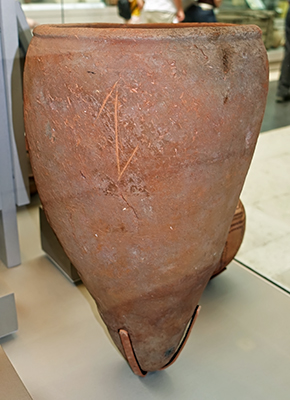
Naqada II: 3 650 BC - 3 300 BC
Ash Jar
Conical jars like this were used as cooking pots. In graves of the Middle Predynastic period, they are often found filled with ashes taken from the home hearth or the funeral feast. These remnants would magically provide a home cooked meal for the dead and make them self-sufficient in the grave.
This conical jar of rough straw-tempered Nile silt pottery has a rounded point base and rolled rim. Incised post-firing on one side with Z-shaped potmark. Below the rim on the other side is a horizontal mark made before firing by the potter’s finger.
Diameter 250 mm, height 432 mm.
Catalog: Hiw (Hu), Abadiya, Naqada IIA-D, EA30872
Photo: Don Hitchcock 2018
Source: Original, British Museum
Text: Card at the British Museum, http://www.britishmuseum.org/, © Trustees of the British Museum, CC BY-NC-SA 4.0
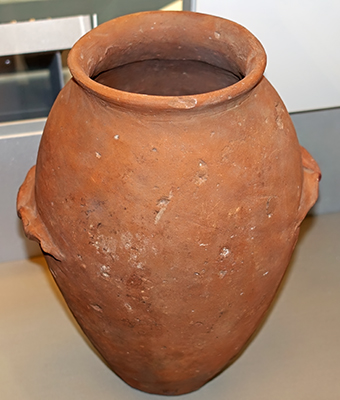 Naqada II: 3 650 BC - 3 300 BC
Naqada II: 3 650 BC - 3 300 BC
Jar
Wavy handled jar made of marl clay, with well formed wavy handles placed low on the shoulder on each side.
Diameter 70 mm (base), 100 mm (rim), 155 mm (shoulder), height 243 mm.
Jars with applied wavy handles originated in Canaan. They were imported to Egypt full of precious commodoties such as wine, olive oil, or scented fats. The Egyptians soon copied the distinctive shape in order magically to supply the contents. Over time the original was forgotten and the form narrowed. This evolution allows us to estimate when the pot was made.
Catalog: el-Mahasna H48, Naqada IIC-D, EA49040
Photo: Don Hitchcock 2018
Source: Original, British Museum
Text: Card at the British Museum, http://www.britishmuseum.org/, © Trustees of the British Museum, CC BY-NC-SA 4.0
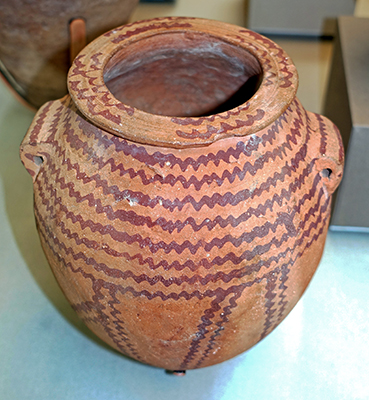
Naqada II: 3 650 BC - 3 300 BC
Decorated Jar
Wavy lines painted around the shoulder and diagonally down the sides of this jar mimic the nets or plaited reeds used to transport vessels. It may have held oils or lotions.
Marl pottery jar with ovoid body, small flat base, flat ledge rim and two cylindrical handles on shoulder. Exterior is decorated in red paint with horizontal wavy-lines on the upper body, and horizontal wavy lines around the base; a series of double wavy lines run diagonally over the body. Circa 3 300 BC.
Height 177 mm.
Catalog: Abados, Naqada IID, EA58526
Photo: Don Hitchcock 2018
Source: Original, British Museum
Text: Card at the British Museum, http://www.britishmuseum.org/, © Trustees of the British Museum, CC BY-NC-SA 4.0
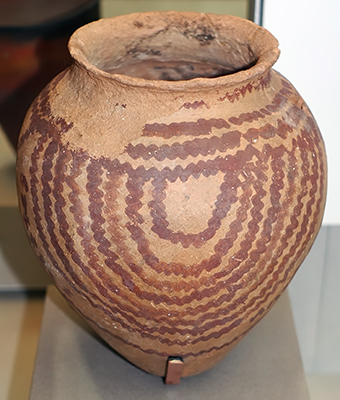
Naqada II: 3 650 BC - 3 300 BC
Decorated Jar
Marl pottery jar with small flat base, high shoulder, and a worn, everted rim. Decorated in red paint with wavy lines around the shoulder, concentric wavy lines in semi-circular pattern on opposing sides of the body, and single wavy lines arcing across the lower body with debased z-motifs. Circa 3 300 BC.
Height 140 mm.
Catalog: Abados, Naqada IID, EA58527
Photo: Don Hitchcock 2018
Source: Original, British Museum
Text: Card at the British Museum, http://www.britishmuseum.org/, © Trustees of the British Museum, CC BY-NC-SA 4.0
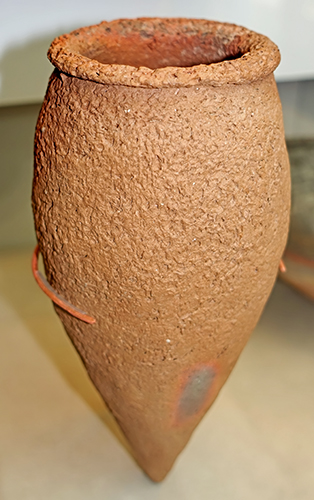
Naqada II: 3 650 BC - 3 300 BC
Pointed Jar
( note that the fashion in graves changed during the Middle Predynastic period, and instead of the family regularly bringing food offerings to the deceased, and only 'serving bowls' being needed in the grave, pots containing 'magical' food to feed the deceased were added to the sum of grave goods, in order to ensure a proper afterlife. I surmise that this was so that the dead could enjoy eternal life without needing food and supplies from the family, which service was dependent on their continuance as a functioning unit - Don )
As the number of pots needed for storing provisions in the grave grew, more pottery of the type used in daily life was included. In this Abydos woman's grave most of the pots were of rough straw-tempered ware, like this pointed jar, with tapered sides and a turned rim. This type of pottery was most prevalent in the contemporary settlements.
Height 213 mm, width 95 mm.
Catalog: Abados 1725, Naqada IID, EA58528
Photo: Don Hitchcock 2018
Source: Original, British Museum
Text: Card at the British Museum, http://www.britishmuseum.org/, © Trustees of the British Museum, CC BY-NC-SA 4.0
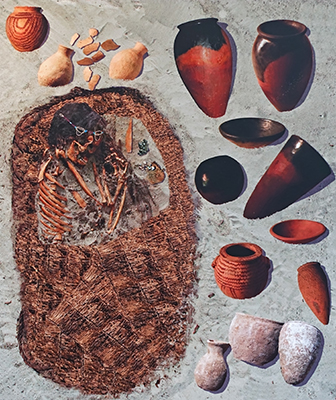
Naqada II: 3 650 BC - 3 300 BC
Woman's Grave
In the Middle Predynastic period, the dead needed to be self-sufficient in their tombs to ensure a proper afterlife. Amassing provisions became essential, and tombs were filled with jars to store food and drink, oils and lotions. This woman buried at Abydos had 15 pots, more than most people.
But what makes her special was the beaded diadem running across her forehead. This must have been her treasured possession, composed of minute beads of precious gold, garnet from the Easter Desert, and rare turquoise from southern Sinai. The diadem was said to hold the remnants of cloth found over her face, although there is little other evidence for veils in ancient Egypt.
Rephotography: Don Hitchcock 2018
Source: Poster, British Museum
Text: Card at the British Museum, http://www.britishmuseum.org/, © Trustees of the British Museum, CC BY-NC-SA 4.0
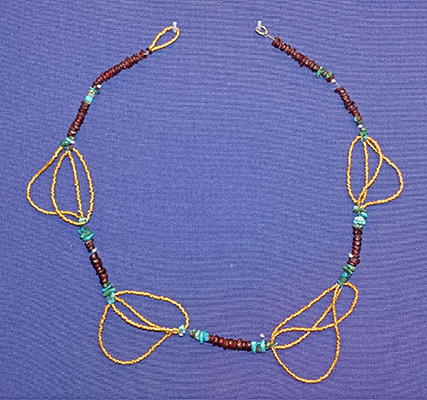
Naqada II: 3 650 BC - 3 300 BC
Woman's Grave, Diadem
Diadem composed of chips of turquoise, garnet, gold and malachite. The beads are arranged in ten sections. Five sections consist of a single string of stone beads and chips and these sections alternate with four sections consisting of four strings threaded entirely with minute gold beads. On one end there is a loop of gold beads.
The beads and chips of stone on the single string sections between the gold beads are arranged generally in the following order: turquoise, garnet, turquoise, but include beads and chips of malachite among the turquoise beads. There is an extra section of garnet beads at each end of the diadem. The gold beads are made from very narrow strips of metal turned up into rings. A few of these rings are soldered. Apart from the uneven chips of stone there are turquoise cylindrical disc beads, garnet cylindrical, truncated convex bicone and barrel beads and malachite cylindrical disc beads. Circa 3 300 BC.
Height 315 mm, width 30 mm, depth 6 mm, weight 9 gm.
This diadem was found still adhering to the head of the woman to whom it belonged. Frankfort (in 'Journal of Egyptian Archaeology' 16) remarks: 'At the back of the head there had been the string only, which disappeared under the tresses; the beaded part in front went from ear to ear, and seemed to hold a piece of cloth like a veil over the face of the woman.'
Catalog: Abados 1730, Naqada IID, EA37532
Photo: Don Hitchcock 2018
Source: Original, British Museum
Text: Card at the British Museum, http://www.britishmuseum.org/, © Trustees of the British Museum, CC BY-NC-SA 4.0
Naqada II: 3 650 BC - 3 300 BC
Funerary Boat
In this boat, a dead person sails to the afterlife. In front, and behind the boat is the body of a frog, the goddess of (re)birth.
The deceased also lies in the pose of an unborn child. The oval hull symbolises a womb.
( Note that this is an extension of the belief in an afterlife, with the deceased given a boat to transport them on their journey. There is no hint yet of the complex beliefs associated with the afterlife which are yet to come in Egypt - Don )
Catalog: Earthenware, Assiot (?)
Photo: Don Hitchcock 2014
Source: Original, Rijksmuseum van Oudheden, National Museum of Antiquities, Leiden.
Naqada II: 3 650 BC - 3 300 BC
Woman's Grave, Black-topped jars
Jars with long tapering bodies and pronounced rims were characteristic of the Middle Predynastic period, and remained popular until the production of black-topped pottery ceased about one hundred years later. The rim made it easy to cover, and the tapering shape facilitated pouring. These are in pristine condition, and were intended for use only by the deceased.
(Left) EA58522: Large red burnished vase with black top, flat base, convex sides and turned rim.
Circa 3 300 BC
Height 315 mm, width 177 mm.
Catalog: Abydos, 1730, Predynastic (Naqada IID), EA58522
(Right) EA58523: Tall red burnished vase with black top, flat base, convex sides (cracked) and turned rim.
Catalog: Abydos, 1730, Predynastic (Naqada IID), EA58523
Height 328 mm, width 171 mm.
Photo: Don Hitchcock 2018
Source: Original, British Museum
Text: Card at the British Museum, http://www.britishmuseum.org/, © Trustees of the British Museum, CC BY-NC-SA 4.0

Naqada II: 3 650 BC - 3 300 BC
Anthropoid staff-amulet with a bearded head.
Circa 3 500 BC
Worked ivory is known from the very earliest periods of Egyptian history, including the Predynastic and Early Dynastic periods. Sites such as Hierakonpolis have produced some notable finds, mostly made from that of hippopotamus tusks, though some elephants as well. Hippopotamus were a dangerous and feared animal and their herds were hunted, it seems, for various reasons from the earliest of times. They were a danger to the population as well as to crops in Egypt.
Elephants, on the other hand, had apparently disappeared from Egypt by the historical period. Nevertheless, some elephant ivory was brought into Egypt from Nubia, while a smaller portion was imported from Asia. Populations of both elephants and hippopotami survived in western Asia into the Late Bronze Age.
However, as ecological factors affected the northerly range of the elephant, ivory from elephants increasingly came from the more southerly regions, most probably from African savannas between the Nile and the Atbara Rivers. The use of elephant ivory increased over time, as the hippopotamus population decreased in Egypt. The use of elephant ivory probably reached its peak during the late 18th Dynasty, most likely during the reign of Amenhotep III, though its use is richly and well documented in the Amarna Letters dating to his son.
Catalog: Elephant ivory, ÄM 14208
Photo: Don Hitchcock 2015
Source: Original, Staatliche Museen zu Berlin, Neues Museum, Germany
Text: © Card at the Staatliche Museen zu Berlin, (CC BY-NC-SA 3.0 DE)
Additional text: http://www.touregypt.net/featurestories/ivory.htm
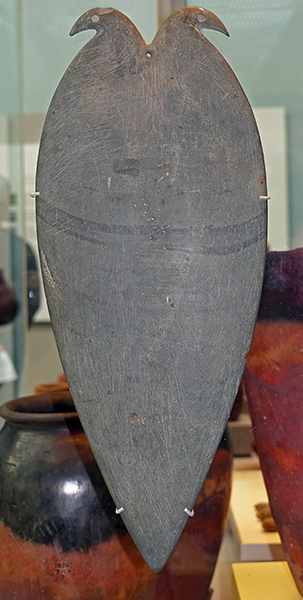
Naqada II: 3 650 BC - 3 300 BC.
Palette with birds.
Mudstone palette of a tall, shield shape with two schematic bird-heads at the top.
Length 340 mm, width 150 mm, thickness 18 mm.
This is the reverse side to that displayed in the BM catalog.
Catalog: Egypt, Naqada II, EA67688
Photo: Don Hitchcock 2018
Source: Original, British Museum.
Text: Card at the British Museum, http://www.britishmuseum.org/, © Trustees of the British Museum, CC BY-NC-SA 4.0
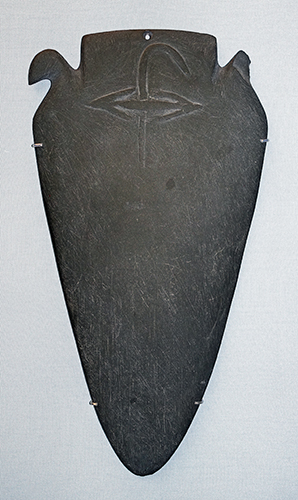
Naqada II: 3 650 BC - 3 300 BC
Palette with the symbol of Min
This greywacke cosmetic palette is carved in relief with the symbol of Min, a god of male virility and strength. He was also patron of the deserts and their important mineral resources. His emblem attached to a pole resembles a double-headed arrow, but it is probably a thunderbolt.
This distinctive symbol makes Min one of the earliest Egyptian gods we can identify by name.
Catalog: El Amra b62, Middle Predynastic (Naqada IID) EA35501
Photo: Don Hitchcock 2018
Source: Original, British Museum
Text: Card at the British Museum, © Trustees of the British Museum, CC BY-NC-SA 4.0
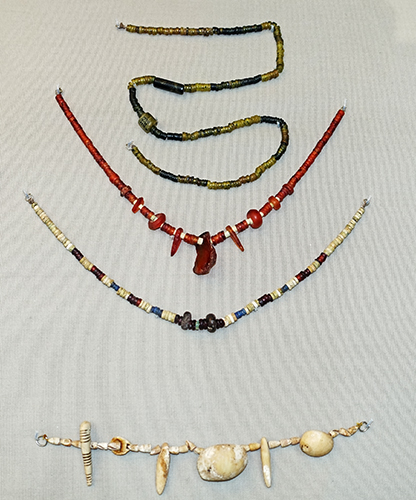
Naqada II: 3 650 BC - 3 300 BC
Beads
Jewellery from one tomb, Mostagedda 11757.
Technological advances in the Middle Predynastic period made it possible to use harder stones, while trade brought exotic materials. The diverse beads in this tomb include hard translucent green olivine and red carnelian from the Eastern Desert, as well as lapis lazuli from Afghanistan. Shells from the Red Sea accompany a rare ivory amulet of a falcon.
EA63100 (top): A string consisting of many cylindrical disc beads, one long cylinder and one short cylinder. The material is green, translucent olivine mottled with black, but whereas some beads are almost entirely green, others are almost entirely black in colour. The long cylinder is very black with little green; the short cylinder is almost all translucent green.
Diameter 10 mm, length 390 mm, weight 8 gm.
Brunton identified the material of the long cylinder bead as serpentine.
Mostagedda, Naqada II
EA63101 (second from top): A string comprising a few small cylindrical disc beads of green glazed steatite, many cornelian cylindrical disc beads of uniform diameter and five larger, short truncated convex bicone beads of cornelian. The string is completed by two long, flat drop pendants of cornelian, a broken triangular cornelian pendant and a large flake of cornelian as a pendant.
Naqada II
Length: 217 mm.
EA63102 (third from top): a collection of beads consisting of two large oblate beads of resin, a single disc bead of translucent, pale-green calcite and a number of disc beads, some of shell, many of garnet, a few of carnelian, many of green glazed steatite and eighteen tiny lapis lazuli discs.
Length: 210 mm
Mostagedda, Naqada II
EA63103 (bottom): A string composed of a number of tiny Conus shells, two Natica shells, one Nerita shell, two long pointed pendants of ivory and a crouching hawk amulet of ivory. The latter has incised lines, filled with a black material, cut across the shoulders, centre of the body and tail. The widest part of the bird's body is perforated. See the close up photograph immediately below.
Length 154 mm, width 30 mm, depth 20 mm, weight 8 gm.
Mostagedda, Naqada II
Catalog: Mostagedda 11757, EA63100 - 3
Photo: Don Hitchcock 2018
Source: Original, British Museum
Text: Card at the British Museum, http://www.britishmuseum.org/, © Trustees of the British Museum, CC BY-NC-SA 4.0
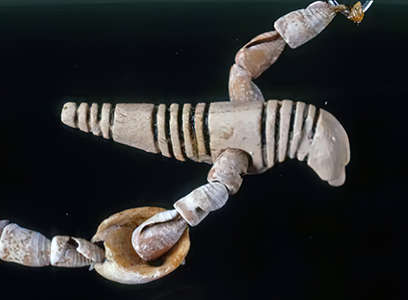
Naqada II: 3 650 BC - 3 300 BC
Falcon bead
This is a close up of the falcon bead which is part of the lowest string of beads above, showing its shape and decoration.
I am grateful to the British Museum for making this photograph available.
Catalog: Mostagedda 11757, EA63103
Photo: © Trustees of the British Museum, CC BY-NC-SA 4.0
Source: Original, British Museum
Text: Card at the British Museum, http://www.britishmuseum.org/, © Trustees of the British Museum, CC BY-NC-SA 4.0
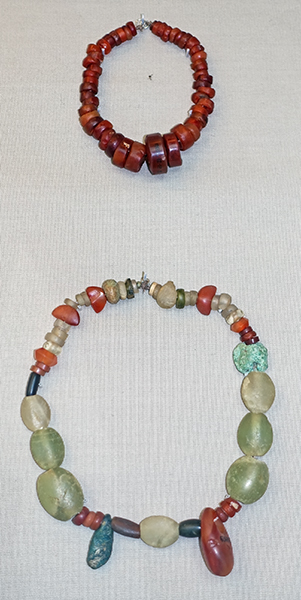 Naqada II: 3 650 BC - 3 300 BC
Naqada II: 3 650 BC - 3 300 BC
Anklets of a woman
Anklets seem to have been exclusively for women. These two were found around each ankle of a woman buried at Matmar.
One is made of large carnelian beads. The other is composed of beads of various shapes and stones, including two drop pendants and a good luck charm in the form of a tiny travertine hedgehog.
EA63695: An anklet composed of beads, an amulet and two pendants. One of the pendants, which is long and resembles an unmarked snake's head amulet, is of translucent dark sea-green olivine with black flecks; the other pendant is drop-shaped and made of cornelian. Seven of the beads are large, flat, lenticular and oval; two have distinct ridges along their edges. All are made of translucent green calcite or white calcite. A rectangular bead with rounded corners, flat underside and convex upper surface is of malachite. There are twenty discs, short cylindrical and short truncated convex bicone beads: nine are of rock crystal, eight of calcite, two of green fluorite and one of shell.
There is one oblate bead of faded green feldspar and one tiny disc bead of the same material. One long barrel is of mottled dark-green steatite, one long cylinder of black steatite and one flattened long cylinder of brown, semi-translucent steatite. The hedgehog amulet is made of calcite. Cornelian barrel and cylindrical disc beads, two much-faceted short truncated convex bicone beads and three semi-circular tabular beads make up the remainder of the anklet.
Catalog: Matmar, EA63695
Length of amulet 12 mm, length of anklet 295 mm, length of carnelian pendant 25 mm, length of olivine pendant 21 mm, width 30 mm, depth 20 mm, weight 38 gm.
Although uncommon at this early date, faceted beads are known from other sites. Brunton believes the feldspar bead to be 'turquoise', and the black steatite bead to be 'black limestone'.
Catalog: Matmar 5108, Middle Predynastic (Naqada IIC), EA63695, EA63696
Photo: Don Hitchcock 2018
Source: Original, British Museum
Text: Card at the British Museum, © Trustees of the British Museum, CC BY-NC-SA 4.0
Naqada II: 3 650 BC - 3 300 BC
Cast of a ceramic mask
Putting on a mask transformed the wearer into a spirit. Recent discoveries at Hierakonpolis of ceramic masks showing bearded male faces demonstrate that divine forces could take on human as well as animal form. This was an important concept as regional rulers sought to enhance their power in the altered social landscape of Late Predynastic Egypt.
Cast of original from Hierakonpolis, HK6 Tomb 16, Early Predynastic (Naqada II)
Catalog: AESAR 1175
Photo: Don Hitchcock 2015
Source: Original, British Museum
Text: Card at the British Museum, © Trustees of the British Museum, CC BY-NC-SA 4.0
Funerary jars decorated with boats became popular in the latter part of the period. Elaborate examples, like this one from the grave of a young woman, show figures involved in ritual activities. A woman dances with arms raised, as two men beat out the rhythm with sticks. She might represent a goddess or priestess, summoned from the boat to give her blessing for successful rebirth.
( note that the two men have erect phalluses and two women holding their arms above their heads are in a dancing pose.
The curators of the Museum August Kestner, Hannover, in describing a jug from the same genre, say that:
Since many images from graves in historical times have a double meaning, even if it is more strongly encoded (for example, a hunt in the papyrus swamps with a bow and arrow, often describes the process of procreation), a kind of 'holy wedding' can be inferred here.
In addition, the two men appear to be beating out a rhythm for the dancers with clapsticks. Since Egyptian ivory clapsticks were usually made from the lower canines of Hippopotami, which are curved, the clapsticks are also curved in these decorations on the jug - Don )
Pottery shouldered jar, circa 3 300 BC. Two pierced handles and two wavy ledge-handles, red painted representations of dancing figures, ostriches and many-oared boats.
( note that the birds identified by the British Museum as ostriches look more like flamingoes, which migrate to the Nile in Egypt every winter - Don )
Height 295 mm, diameter 225 mm, estimated weight 3 kg.
Catalog: El Amra b225, Middle Predynastic (Naqada IIC), EA35502
Photo (first four images): Don Hitchcock 2018, 2015 ( fortuitously, the jar had been rotated by a half turn in between the two visits! - Don )
Photo (overhead shot, lowest image): © Trustees of the British Museum, CC BY-NC-SA 4.0
Source: Original, British Museum
Text: Card at the British Museum, http://www.britishmuseum.org/, © Trustees of the British Museum, CC BY-NC-SA 4.0
Naqada II: 3 650 BC - 3 300 BC
Jar with Naqada plant from Hiw / Hu
An elaborate tree, called the Naqada plant, was a common motif on funerary jars, but its identity is still uncertain. One candidate is the Aloe vera which survives in the desert, seemingly without water. If so, it may have symbolised eternal life.
Alternatively, it may depict the date palm, which provided welcome shade and sweet fruit for the living and - it was hoped - for the dead.
Height 200 mm, width 163 mm, depth 150 mm, weight 874 grams.
Catalog: Hiw, B15, (Naqada II), EA30919
Photo: Don Hitchcock 2015, 2018
Source: Original, British Museum
Text: Card at the British Museum, http://www.britishmuseum.org/, © Trustees of the British Museum, CC BY-NC-SA 4.0
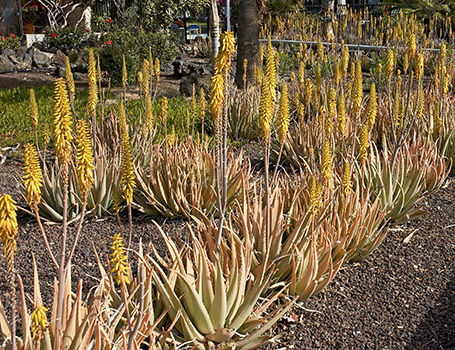
The plant shown on the jar above certainly bears some resemblance to the Aloe vera plants shown here, in particular to the flower spike which is very similar.
Photo: Wouter Hagens
Permission: Public Domain
Naqada II: 3 650 BC - 3 300 BC
Jar with mountains
The solid triangles on this pot represent the desert hills that flank the Nile valley. This was the place of burial. Wavy lines around the rim symbolise the river's life-giving waters. These dramatic contrasts in the landscape made a strong impression on the early Egyptians, who saw the world as sets of opposing elements that needed to be kept in balance.
Height 153 mm, diameter 175 mm, weight 1270 grams.
Pottery shouldered jar, three pierced lugs, red painted wavy lines and triangles.
Catalog: Hu / Hiw, B354, Middle Predynastic (Naqada II), EA30921
Photo: Don Hitchcock 2015, 2018
Source: Original, British Museum
Text: Card at the British Museum, http://www.britishmuseum.org/, © Trustees of the British Museum, CC BY-NC-SA 4.0
Naqada II: 3 650 BC - 3 300 BC
Jar with antelope, mountains, and ostriches
Wild antelopes were no longer important sources of food in the Middle Predynastic period. Instead, they became symbolic in rituals demonstrating control over nature. This jar shows them being herded, possibly for use in such rituals, while ostriches adorn the base. The ostrich was probably connected to rebirth by virtue of its large eggs, which were highly valued.
( note that the birds identified by the British Museum here as ostriches look more like flamingoes, which migrate to the Nile in Egypt every winter - Don )
This is a squat marl pottery jar with round base, two long pierced cylindrical handles on shoulder, and a flat ledge rim. It is decorated in red paint around the belly with a male figure following a row of ibexes standing above a band of connected solid triangle (mountains. On the base are rows of long-legged birds (ostriches) set in four groups, each standing above cross-hatched bands.
Catalog: Hu / Hiw, Middle Predynastic (Naqada II), EA65361
Photo: Don Hitchcock 2015, 2018
Source: Original, British Museum
Text: Card at the British Museum, http://www.britishmuseum.org/, © Trustees of the British Museum, CC BY-NC-SA 4.0
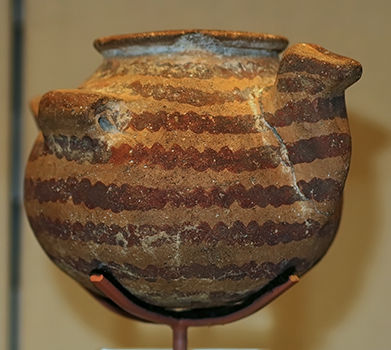
Naqada II: 3 650 BC - 3 300 BC
Jar with bird
This jar represents an aquatic bird on rippled water. Such vessels may have held precious oils or cosmetics. Various types of bird had significance in early Egypt, but over time many of their meanings changed or were lost.
This is a small globular jar of marl pottery with a round base, two pierced cylindrical handles on the shoulder and a flat ledge rim. It has been made into the form of a bird by the addition of a head and tail. It is decorated all over the body with horizontal wavy lines in red-brown paint.
Catalog: Middle Predynastic Naqada IIC, EA58340
Photo: Don Hitchcock 2015
Source: Original, British Museum
Text: Card at the British Museum, http://www.britishmuseum.org/, © Trustees of the British Museum, CC BY-NC-SA 4.0
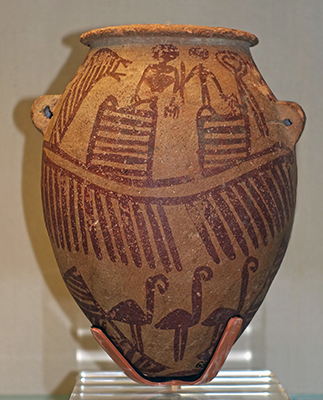
Naqada II: 3 650 BC - 3 300 BC
Jar with boats and figures
The ritual importance of women was emphasised by the larger size of their figures on funerary jars.
Here, the smaller male figure holds what may be an aardvark, as a token of control over untamed nature. Representations of aardvarks are very rare.
This is an ovoid marl pottery jar with a small flat base, two pierced cylindrical handles on the shoulder, and a flat ledge rim. It is decorated in brown-red paint with two representations of many-oared boats, above each are a pair of human figures, one of which is holding an object suggested to be an aardvark. Below the boats are long-legged birds and skin on a pole motifs.
( note that the boat is shown by the two parallel lines across the pot, with the oars shown below these lines. On top of the boat are two platforms as commonly depicted on boats, on which the figures are standing, as well as, on the left of this image, what may be an exaggerated prow. The long legged birds are probably flamingoes, which are not native to Egypt, but they migrate here every winter. - Don )
Catalog: Middle Predynastic Naqada IIC, EA65366
Photo: Don Hitchcock 2018
Source: Original, British Museum
Text: Card at the British Museum, http://www.britishmuseum.org/, © Trustees of the British Museum, CC BY-NC-SA 4.0
Naqada II: 3 650 BC - 3 300 BC
Vase of ships
Terracotta, height 222 mm, diameter 216 mm.
Circa 3500 to 3300 B.C.
The most vocal and informative evidence of the prehistoric period are vessels with decorations of figures, which allow a direct insight into cultic ideas.
Two boats (with many oars) are depicted, each with a double cabin.
( note that as in the jug EA65366 above, the boats are indicated by two parallel lines across the pot, with the oars shown below these lines. On top of the boat are two platforms in the form commonly depicted on boats of this period, on which the figures are (symbolically) standing - Don )
Above or on top of them are two men with erect phalluses and two women holding their arms above their heads in a dancing gesture. Since many images from graves in historical times have a double meaning, even if it is more strongly encoded (for example, a hunt in the papyrus swamps with a bow and arrow, often describes the process of procreation), a kind of 'holy wedding' can be inferred here.
The deceased (probably a member of the nobility) regenerates himself with a woman or goddess to ever new life and overcomes the 'second' death. That there are already connections to the cult of the great fertility god Amun-Min Ka-mut-ef, 'bull of his mother' can probably be inferred from the flags on the booths. In any case, the harpoon is the symbol of this god: the mountain range (symbol of the womb?) and the gazelles are also closely related to him.
Finally, the long branch - perhaps as a sign of greening and flourishing - is encountered as an ornament of the woman or goddess.
( note that the two men appear to be beating out a rhythm for the dancers with clapsticks. Since Egyptian ivory clapsticks were usually made from the lower canines of Hippopotami, which are curved, the clapsticks are also curved in these decorations on the jug - Don )
The three rudimentary cord eyelets obviously have only a decorative function.
Catalog: Terracotta, origin unknown, Inv. no. 1954.125
Photo: Don Hitchcock 2018
Source and text: Original, Museum August Kestner, Hannover
Additional text: Printed Catalogue, Museum August Kestner, Hannover

Naqada II: 3 650 BC - 3 300 BC
String of beads
Naqada II, string of beads, clay, biconical and barrel shaped, grey.
Length 1400 mm.
Catalog: Naqada Tomb 723. Xia Nai catalogue number 60, UC4994
Photo: Don Hitchcock 2015
Source: Original, Petrie Museum, London, England
Text: Card / online catalogue, the Petrie Museum, © 2015 UCL. CC BY-NC-SA license.
Palettes and tags with cow horns
The cow was long a symbol of fertility. On early palettes her horns were sometimes depicted as birds' heads, combining heaven and earth. Over time she gradually assumed the characteristic silhouette of the celestial cow goddess Bat, 'female spirit' who was later merged with Hathor.
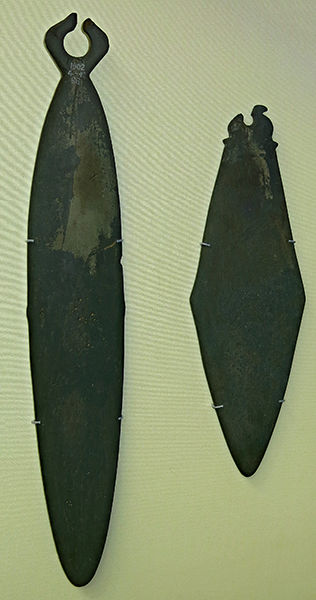
Naqada II: 3 650 BC - 3 300 BC
Cosmetic Palettes made of mudstone.
(left, EA36366) Length 359 mm, width 62 mm, thickness 12 mm, weight 330 grams.
Catalog: Early Predynastic (Naqada II) EA36366
Mostagedda 1825, EA63066
Photo: Don Hitchcock 2015
Source: Original, British Museum
Text: Card at the British Museum, http://www.britishmuseum.org/, © Trustees of the British Museum, CC BY-NC-SA 4.0
Naqada II: 3 650 BC - 3 300 BC
Cosmetic Palettes made of mudstone.
(left in left photo, EA63072): Height 87 mm, width 40 mm, thickness 5 mm, weight 23 grams.
(centre, and centre in left photo, EA21903) Mudstone palette, with rough birds' heads at top, from Gebelein.
Height 57 mm, width 28 mm, depth 20 mm, weight 9 grams
(right, and right in left photo, EA23421), mudstone palette, single piercing, ornate terminal, from Gebelein.
Height 42 mm, width 20 mm, depth 20 mm, weight 6 grams
Catalog: Mostagedda 1832, EA63072
Gebelein, Early - Middle Predynastic (Naqada II), EA21903, EA23421
Photo (left): Don Hitchcock 2015
Photo (centre and right): © Trustees of the British Museum, CC BY-NC-SA 4.0
Source: Original, British Museum
Text: Card at the British Museum, http://www.britishmuseum.org/, © Trustees of the British Museum, CC BY-NC-SA 4.0
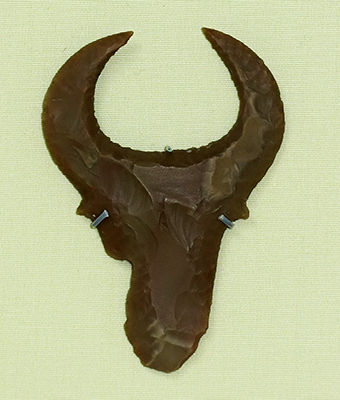
Naqada II: 3 650 BC - 3 300 BC
Flint bulls head
The bull embodied power and virility. Several deities took on its form and one of the early manifestations of the Egyptian king was as a mighty bull. This figurine skilfully chipped from flint was probably dedicated at an early temple.
Height 87 mm, width 40 mm, thickness 5 mm, weight 23 grams.
Catalog: EA32124
Photo: Don Hitchcock 2015
Source: Original, British Museum
Text: Card at the British Museum, http://www.britishmuseum.org/, © Trustees of the British Museum, CC BY-NC-SA 4.0
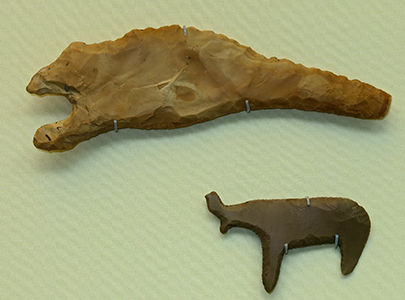
Naqada II: 3 650 BC - 3 300 BC
Flint animals
Chipping flint into the shape of wild animals goes back to the Predynastic period, when such figures were made for ritual purposes. Their presence at the Abydos temple is a mark of their ancient importance. In the changing times of the early dynasties, the past was often invoked to justify the present.
( note that this comment from the card at the British Museum is difficult to reconcile with a date of Naqada II. The artefacts from Abydos, Osiris Temple are generally dated to the Early Dynastic. Certainly the flint animals look like Naqada II artefacts, but the question remains - what are they doing in the Abydos, Osiris Temple in company with Early Dynastic objects? - Don )
EA37269: Flint figure of crocodile.
Height 46 mm, width 157 mm, thickness 7 mm, weight 62 grams.
EA30411: Flint figure of an ox.
Height 50 mm, width 74 mm, thickness 4 mm, weight 14 grams.
Photo: Don Hitchcock 2015
Catalog: Naqada II, EA37269
Catalog: Naqada II, EA30411
Source: Original, British Museum
Text: Card at the British Museum, http://www.britishmuseum.org/, © Trustees of the British Museum, CC BY-NC-SA 4.0
Naqada II: 3 650 - 3 300 BC
Jackal amulet
The jackal was associated with Anubis, the god who looked after the dead. A recumbent posture is typical of later depictions of Anubis. This amulet is one of a pair that was found on the chest of a child, invoking the god's protection.
Bone, paste. Length 47 mm, height 15 mm, thickness 5 mm.
Catalog: Mostagedda 1757, Middle Predynastic (IIC-D) EA62411
Date and extra information from Patch et al. (2011)
Photo: Don Hitchcock 2015
Source: Original, British Museum
Text: Card at the British Museum, http://www.britishmuseum.org/, © Trustees of the British Museum, CC BY-NC-SA 4.0
Gebelein man
Middle Predynastic, 3 500 BC
The man shown below died more than 5 500 years ago. He was buried at Gebelein in Upper Egypt, where he was found in a shallow grave covered with stone slabs, as partly reconstructed here. His body was naturally mummified by rapidly drying in the hot desert sand. This also preserved his hair, but its colour has probably faded with time.
Around him are objects typical of the Middle Predynastic period, about 3 500 BC, the time we think he lived. All are from Gebelein, and some may have come from his grave.
From CT scans we know he was a strong young man. He died from a stab wound in his left shoulder, rare evidence of violence at this time.
Naqada II: 3 650 BC - 3 300 BC
Gebelein Man, a natural mummy of the Predynastic period, circa 3 500 BC
Buried at about 3 400 BC, Gebelein Man takes his name from the place in Upper Egypt where he was found. Soon after death, he was laid in a shallow pit, in a typical contracted position. His body was in direct contact with the hot dry sand, and this preserved it naturally. Chance finds of such remains in ancient times might have promoted the belief that physical preservation was necessary for the afterlife, leading to the later development of artificial mummification.
Gebelein Man was discovered in 1896, and has been on display in the British Museum since 1900. He was examined via a CT scanner for the first time in 2012. Detailed three dimensional models created from the high resolution X-rays taken by the CT scanner have allowed us to look inside his body.
Catalog (mummy): Middle Predynastic (Naqada II), EA32751
Catalog (grave goods): Middle Predynastic (Naqada IIC), EA16936, EA22173, EA22446, EA30750, EA30831, EA35326, EA35331, EA35344, EA67711
Photo: Don Hitchcock 2018, 2015
Source: Original, British Museum
Text: Card at the British Museum, http://www.britishmuseum.org/, © Trustees of the British Museum, CC BY-NC-SA 4.0
Naqada II: 3 650 BC - 3 300 BC
Body of naturally mummified adult male lying in flexed position. Skull - Tufts of ginger-coloured hair are present on the scalp. No obvious fractures. Mouth slightly open. All teeth present and appear healthy. Thorax and abdomen - comminuted fracture, 4th left rib. Fracture, anterior third of 6th, 7th, 8th, and 9th left ribs. The spinal column is free from fractures and dislocations. The intervertebral discs appear normal. No arthritic changes are present. There is a large, faintly granular opacity within the thorax. Stellate crack fracture on the wing of the left ilium. Fracture through the right pubic ring. Arms - no definite fractures seen.
Catalog (mummy): EA32751
Catalog (grave goods): EA16936, EA22173, EA22446, EA30750, EA30831, EA35326, EA35331, EA35344, EA67711
Photo: Don Hitchcock 2015, 2018
Source: Original, British Museum
Text: Card at the British Museum, http://www.britishmuseum.org/, © Trustees of the British Museum, CC BY-NC-SA 4.0
Naqada II: 3 650 BC - 3 300 BC
The left index finger and several of the terminal phalanges of the feet are missing. Legs - both femoral shafts are fractured and there is a fracture of the shaft of the left tibia and fibula. Three shells are present on the soft tissue just behind the left knee. No lines of arrested growth are visible.
Length: 163 cm
Catalog (mummy): EA32751
Catalog (grave goods): EA16936, EA22173, EA22446, EA30750, EA30831, EA35326, EA35331, EA35344, EA67711
Photo: Don Hitchcock 2015
Source: Original, British Museum
Text: Card at the British Museum, http://www.britishmuseum.org/, © Trustees of the British Museum, CC BY-NC-SA 4.0
Naqada II: 3 650 BC - 3 300 BC
Visualisation of the preserved brain
Gebelein Man is one of the best preserved natural mummies from Predynastic Egypt. His internal organs have survived so well that his brain, kidneys and lungs can be identified.
Photo: Poster © Trustees of the British Museum, CC BY-NC-SA 4.0
Rephotography: Don Hitchcock 2015
Text: poster at the Museum © Trustees of the British Museum, CC BY-NC-SA 4.0
Acknowledgements: The Interactive Institute and Visualization Center C, Sweden, Bupa Cromwell Hospital
Naqada II: 3 650 BC - 3 300 BC
His age at death
His long bones had just finished growing and were beginning to fuse, showing that Gebelein Man was a young adult, aged 18-21 years, when he died.
Photo: Poster © Trustees of the British Museum, CC BY-NC-SA 4.0
Rephotography: Don Hitchcock 2015
Text: poster at the Museum © Trustees of the British Museum, CC BY-NC-SA 4.0
Acknowledgements: The Interactive Institute and Visualization Center C, Sweden, Bupa Cromwell Hospital
Naqada II: 3 650 BC - 3 300 BC
How he died
A cut in Gebelein Man's left shoulder was discovered to be from a stab wound that shattered his shoulder blade and the underlying rib, perhaps puncturing the left lung. This was probably the cause of death.
Photo: Poster © Trustees of the British Museum, CC BY-NC-SA 4.0
Rephotography: Don Hitchcock 2015
Text: poster at the Museum © Trustees of the British Museum, CC BY-NC-SA 4.0
Acknowledgements: The Interactive Institute and Visualization Center C, Sweden, Bupa Cromwell Hospital
Naqada II: 3 650 BC - 3 300 BC
When he lived
Gebelein Man probably lived in volatile times. Several regional centres, including Gebelein, were beginning eventually led to to vie for power and territory. This led to the unification of Egypt at about 3 100 BC. It is likely that violence played a significant role, and Gebelein Man may have been a victim of his time.
This was a period when several regional centres were beginning to vie for power and territory, leading ultimately to the unification of Egypt some 400 years later.
The photo at left is of a battle scene on a Predynastic knife handle.
Photo: Musée du Louvre, Paris
Proximate source: Poster © Trustees of the British Museum, CC BY-NC-SA 4.0
Rephotography: Don Hitchcock 2015
Text: poster at the Museum © Trustees of the British Museum, CC BY-NC-SA 4.0
Additional text: https://blog.britishmuseum.org/tag/gebelein-man/
Naqada II: 3 650 BC - 3 300 BC
Gebel el-Arak Knife. This is the complete knife, left, and a closeup of the handle, right.
The handle is of hippopotamus ivory (canine) attached to a flint blade, itself superbly crafted.
The carving of the handle is exquisite, by a master craftsperson, for a rich client.
The blade testifies to the mastery of the craft by the flint knapper. This is no ordinary blade, this is a masterwork. The carving complements it magnificently. The piece as a whole is priceless.
Circa 3300 - 3200 BC, from Gebel el-Arak, South of Abydos.
Length: 255 mm (10 in).
Photo: Rama
My thanks to Rama for making these photographs available, this knife is one of the world's treasures.
Permission: CeCILL This work is free software; you can redistribute it or modify it under the terms of the CeCILL. The terms of the CeCILL license are available at www.cecill.info
Source: Room 20, Le Louvre, Paris.
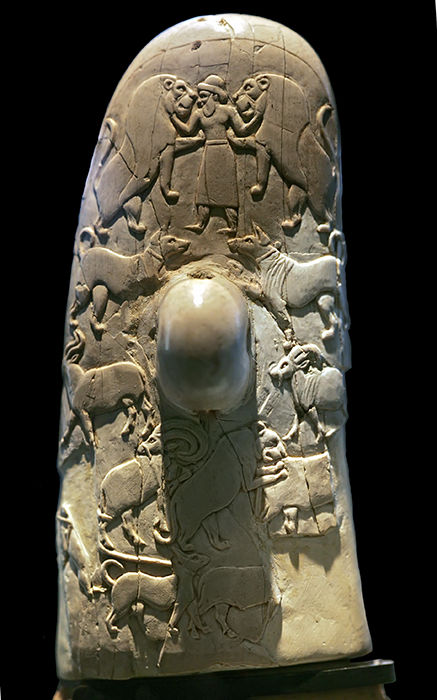
Naqada II: 3 650 BC - 3 300 BC
The back of the knife above is on a completely different theme. It shows the dogs, goats, and other animals owned or hunted by the owner, and portrays the owner as being the master of not just one, but two lions at once, whom he fondles at the throat while they appear to pay him homage.
A highly polished boss on the back of the knife has been drilled from top to bottom and left to right, to ensure that a cord can be used to attach the knife securely to the belt of the owner, shown here with a hat, beard, and finely crafted kilt, the whole scene being almost Abyssinian in character. Abyssinia, or Ethiopia, was known as Kush to the ancient Egyptians.
Photo: Rama
Permission: CeCILL This work is free software; you can redistribute it or modify it under the terms of the CeCILL. The terms of the CeCILL license are available at www.cecill.info
Source: Room 20, Le Louvre, Paris.
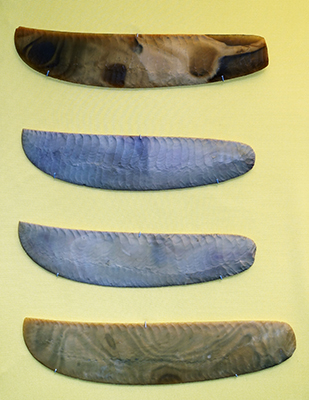
Naqada II: 3 650 BC - 3 300 BC
Ripple flaked knives
Nothing equals the precision and uniformity of Predynastic pressure or 'ripple' flaked knives. Each blade required six different steps in the making, and it probably took several full-time specialists 22 hours to complete just one.
The knife's end could be covered with leather, cord or gold for a handle, but a select few were fitted with elaborately carved ivory handles, marking them as the supreme status symbols of the time, as in the Gebel el-Arak Knife shown above.
Catalog: Late Predynastic (Naqada IIC - IIIA) EA32096, EA59235, EA29289, EA29286
Photo: Don Hitchcock 2018
Source: Original, British Museum
Text: Card at the British Museum, © Trustees of the British Museum, CC BY-NC-SA 4.0
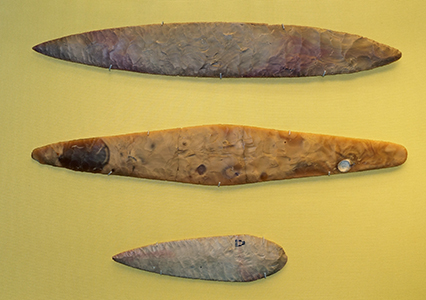
Naqada II: 3 650 BC - 3 300 BC
Lances
Fine flint tools were made throughout Egypt's early history, but by the Middle Predynastic period craft specialists had raised flint working to new heights.
Lances with minute serrations around the cutting edge were produced as status symbols for the elite. Some may have been used as daggers.
Catalog: Early - Middle Predynastic (Naqada II) EA52848, EA49723, EA54426
Photo: Don Hitchcock 2015
Source: Original, British Museum
Text: Card at the British Museum, © Trustees of the British Museum, CC BY-NC-SA 4.0
Naqada II: 3 650 BC - 3 300 BC
Serrations
Close up of the minute serrations on the cutting edge of EA52848.
Catalog: Early - Middle Predynastic (Naqada II) EA52848
Photo: Don Hitchcock 2018
Source: Original, British Museum
Text: Card at the British Museum, © Trustees of the British Museum, CC BY-NC-SA 4.0
Daily life
Middle Late Predynastic
3500-3100 BC
Most early Egyptians were farmers, but in larger towns people specialised in other tasks. Some produced pottery and beer for the community, others made jewellery, stone vessels and exquisite flint knives for wealthy patrons. Such luxury goods and surplus crops were traded for items not available locally This brought about contact, and ultimately conflict, with different cultures in Nubia, to the south, and the Nile Delta (Lower Egypt), to the north. As a result, daily life was to change forever.
Naqada II: 3 650 BC - 3 300 BC
Model house
During the Predynastic period, towns were open settlements of small houses made of mud-coated wood and reeds. Only the foundations remain today but this rare model shows what these houses looked like. A wooden lintel framed the entrance, and the door was a rolled-up mat. Small windows in the back wall allowed in light and air. Such houses continued until the end of the period around 3 200 BC, when people moved into densely-built towns, surrounded by mud brick walls.
Pottery model of house, removable roof (partially restored).
Height 242 mm, length 380 mm, width 267 mm.
Catalog: El Amra a4, Middle Predynastic, Naqada IID, EA3505
Photo (left): Don Hitchcock 2015
Photo (right): © Trustees of the British Museum, CC BY-NC-SA 4.0
Source: Original, British Museum
Text: Card at the British Museum, http://www.britishmuseum.org/, © Trustees of the British Museum, CC BY-NC-SA 4.0
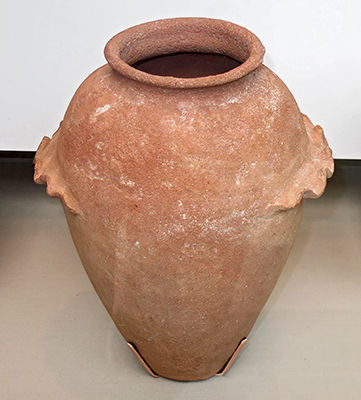
Naqada II: 3 650 BC - 3 300 BC
Wavy handled jar
The wavy or pie crust handles on this Upper Egyptian jar were copied from Canaanite vessels transported overland into Lower Egypt.
Those jars came filled with oils, wine and resins, which the Upper Egyptians coveted. By imitating the jar's shape they believed they could magically have its contents for the afterlife. Eventually their desire for the actual goods caused conflict, starting the events that ultimately led to unification.
Buff pottery jar with a flat base. Two pie-crust handles on the shoulder, and with an everted rim, height 294 mm, diameter 230 mm.
Catalog: Hu/Hiw B425, Middle Predynastic (Naqada IIC), EA30898
Photo: Don Hitchcock 2015
Source: Original, British Museum
Text: Card at the British Museum, http://www.britishmuseum.org/, © Trustees of the British Museum, CC BY-NC-SA 4.0
Naqada II: 3 650 BC - 3 300 BC
Spouted Jar
Contact with the early cities of Mesopotamia began around 3 500 BC. This spouted jar is a copy of a common Mesopotamian shape, attesting to the trade of ideas and influences between the two cultures.
Height 153 mm, width 57 mm.
Catalog: Mostagedda area 29/1800, Middle Predynastic (Naqada IIC - IID), EA63003
Photo (left): Don Hitchcock 2015, 2018
Photo (right): © Trustees of the British Museum, CC BY-NC-SA 4.0
Source: Original, British Museum
Text: Card at the British Museum, http://www.britishmuseum.org/, © Trustees of the British Museum, CC BY-NC-SA 4.0
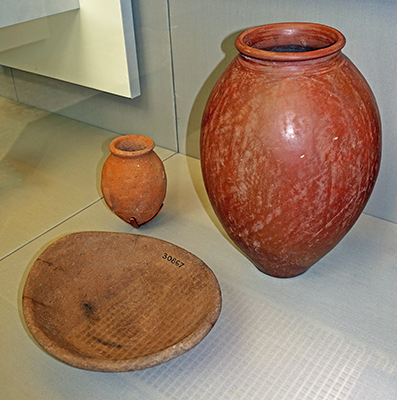
Naqada II: 3 650 BC - 3 300 BC
Daily life pottery
Domestic pottery was made of Nile silt mixed with chopped straw. This addition made the clay easier to fashion, dry and fire. Such pottery was mass produced and little effort was made to smooth the rough surface. Oval bowls were for bread making and serving. The function of the ovoid jar is uncertain, but its pointed base facilitated standing upright in sandy soil.
(lower left) Oval bowl of rough straw-tempered Nile silt pottery with a slight platform base and flaring sides with rounded lip that rises higher at the narrower ends. Predynastic (Naqada IIB-C), Hiw.
Dimensions: height: 74 mm, width 213 mm.
Catalog: Hu (Hiw), Middle Predynastic (Naqada II), EA30867.
(middle left) EA49064
Pottery vase of straw tempered Nile silt, drop shaped with pointed base, short neck and everted roll rim.
Predynastic (Naqada IIC)
Excavated/Findspot: el-Mahasna
Dimensions: Diameter: 88 mm (max), diameter: 56 mm (rim), height: 124 mm (whole)
Catalog: Mahasna H21, Middle Predynastic (Naqada II), EA49064
(upper right) Red polished storage jar. Predynastic, EA62335.
Finer pottery with a red polished surface provided more airtight conditions for storing moist foods and liquids, blackened base.
Mostagedda area 200, Middle Predynastic (Naqada IIB-C), EA62335
Dimensions: height 281 mm, width 104 mm (rim).
Photo: Don Hitchcock 2018
Source: Original, British Museum
Text: Card at the British Museum, http://www.britishmuseum.org/, © Trustees of the British Museum, CC BY-NC-SA 4.0
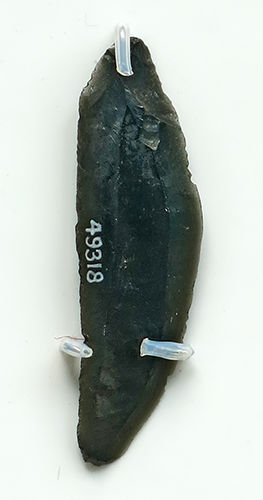
Naqada II: 3 650 BC - 3 300 BC
Obsidian Flake
Scientific analysis of obsidian found in Upper Egypt indicates it came from the Ethiopian highlands. This volcanic glass was rare in Egypt and probably accompanied trade shipments of incense, resins, animal skins and ebony from the south.
Length 34 mm, width 10 mm.
Catalog: Abydos E381, Middle Predynastic (Naqada IID), EA49318
Photo: Don Hitchcock 2015
Source: Original, British Museum
Text: Card at the British Museum, http://www.britishmuseum.org/, © Trustees of the British Museum, CC BY-NC-SA 4.0
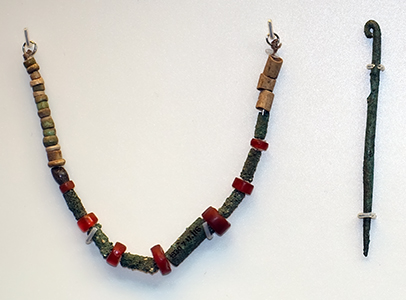
Naqada II: 3 650 BC - 3 300 BC
Copper beads and needle
Copper from the Levant was one of the commodities imported into Lower Egypt by Canaanite traders. Copper tools rarely survive, because they were recycled, leaving mainly beads and needles to indicate their presence.
The string consists of seven long cylindrical copper beads, much corroded, seven short cylindrical carnelian beads, relatively larger than the other beads, one dark-grey steatite barrel, seven short cylinders of bird's leg-bone and a number of disc beads of green glazed steatite and shell. Length 130 mm, diameter 8 mm (max).
Copper pin, length 64 mm, width 3 mm, thickness 5 mm, weight 1 gram.
Catalog: (beads) Mostagedda 11726, Early - Middle Predynastic (Naqada II), EA63096
Catalog: (copper pin/needle) Mostagedda area 1800, Early - Middle Predynastic (Naqada II), EA63106
Photo: Don Hitchcock 2018
Source: Original, British Museum
Text: Card at the British Museum, http://www.britishmuseum.org/, © Trustees of the British Museum, CC BY-NC-SA 4.0
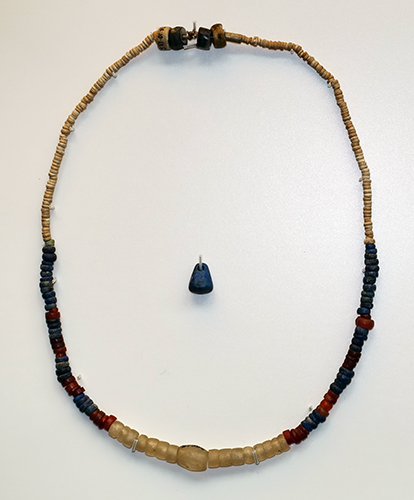
Naqada II: 3 650 BC - 3 300 BC
Lapis Lazuli
The only source for lapis is located in modern Afghanistan, over 2000 miles from Egypt. Despite the distance, this stone was systematically imported into Egypt from about 3 500 BC, possibly by Mesopotamian traders.
The necklace is a string of disc, biconic and barrel beads of various materials. The largest beads are of translucent white quartz, lapis lazuli, banded chalcedony and glazed steatite. The central long truncated convex biconic quartz bead is bored from both ends; the other quartz beads flanking it are short barrels and short cylinders.
Of the four beads of large diameter, two at each end of the string, the two short cylinders are of faded green glazed steatite, one short barrel is of banded chalcedony and the other of lapis lazuli. The remaining lapis lazuli beads are oblate disc and truncated convex biconic discs; the cornelian beads are cylindrical and truncated biconic discs. The string is completed by many small disc beads of shell, a single small disc of green glazed composition and one green glazed steatite cylinder.
Length 460 mm, diameter of largest bead 10 mm (max)
In the centre of the image is a conical pendant of lapis lazuli with a flat, circular base and a blunted point. The upper and lower surfaces are slightly flattened. Pierced for suspension.
Length: 12 mm (max), width: 9 mm (max), thickness: 8 mm (max)
Catalog: Necklace: Qaw el-Kebir, tomb group 1756, Badari, Middle Predynastic (Naqada IIC), EA57586
Catalog: Lapis lazuli pendant: Middle Predynastic (Naqada II), EA57765
Photo: Don Hitchcock 2018
Source: Original, British Museum
Text: Card at the British Museum, http://www.britishmuseum.org/, © Trustees of the British Museum, CC BY-NC-SA 4.0
Naqada II: 3 650 BC - 3 300 BC
Bucrania Amulets
These amulets represent the head of a bull, with the horns curved down over the muzzle.
Catalog: Carnelian E 27419, Serpentine AF 6903
Photo: Don Hitchcock 2015
Source: Original, Musée du Louvre
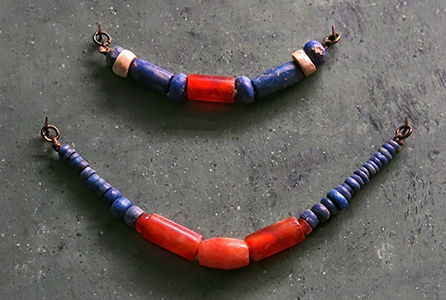
Naqada II : 3 800 - 3 200 BC
Bead Necklaces
Necklaces of beads in calcite, carnelian and lapis-lazuli from Cimetière de Zaouiet el-Maïetin.
Catalog: E 11443 (above), E 11438 (below)
Photo: Don Hitchcock 2015
Source: Original, Musée du Louvre
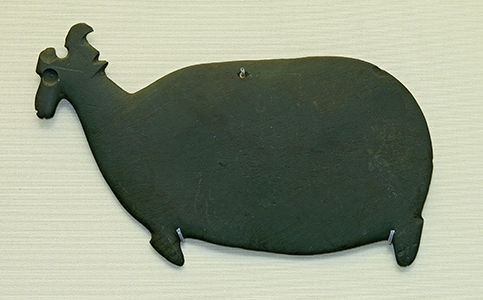
Naqada II: 3 650 BC - 3 300 BC
Palette in the shape of a cow
Sheep, goat and fish were the main sources of animal protein in the diet of the early Egyptians. Cattle were symbols of fertility and strength, and their meat was only consumed on special occasions.
The hides of these animals were also put to use for clothing, while fish bones were made into tools and weapons.
Catalog: Early - Middle Predynastic (Naqada II), EA65238
Photo: Don Hitchcock 2015
Source: Original, British Museum
Text: Card at the British Museum, © Trustees of the British Museum, CC BY-NC-SA 4.0
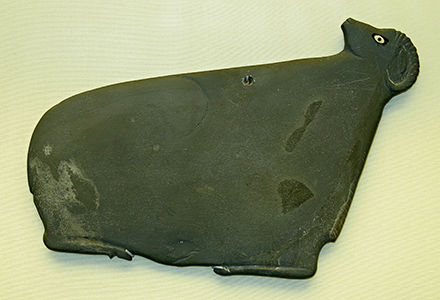
Naqada II: 3 650 BC - 3 300 BC
Palette in the shape of a ram
Mudstone cosmetic-palette in the form of a ram, with an inlaid shell eye.
Width 230 mm, height 155 mm, thickness 15 mm, weight 600 grams.
Catalog: (labelled as an oryx in the catalog, and as Naqada I) EA36368
Photo: Don Hitchcock 2015
Source: Original, British Museum
Text: Card at the British Museum, © Trustees of the British Museum, CC BY-NC-SA 4.0
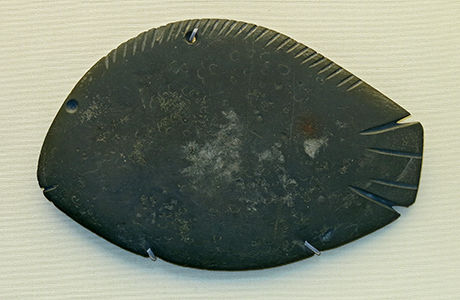
Naqada II: 3 650 BC - 3 300 BC
Palette in the shape of a fish
Mudstone cosmetic-palette in the form of a fish.
Width 138 mm, height 90 mm, thickness 6 mm, weight 180 grams.
Catalog: EA58679
Photo: Don Hitchcock 2015
Source: Original, British Museum
Text: Card at the British Museum, © Trustees of the British Museum, CC BY-NC-SA 4.0
Naqada II: 3 650 BC - 3 300 BC
Fish tail knife blades. These knives have a broad forked 'fish-tail' cutting edge which became more v-shaped with time. A handle of wood or reed was fitted to them, as shown in the illustration below.
( From the diagram from Hikade (2003) below, we can classify the left and centre knives as being from the early period, and the right as being from the late period.
- Don )
Finely knapped, the knives were clearly important possessions. They may have been used to cut the umbilical cord at birth, and symbolically at rebirth in the afterlife.
Catalog: Early Predynastic (Naqada I-IIB), EA2496, EA59240
Catalog: Middle Predynastic (Naqada IIC), EA32098
Photo: Don Hitchcock 2015
Source: Original, British Museum
Text: Card at the British Museum, © Trustees of the British Museum, CC BY-NC-SA 4.0
Schematic shape of early fishtail knife (1), with distinct handle (2), and late fishtail knife (3)
Photo and text: Hikade (2003)
Fishtail knives from U 395 (1), U 178 (2), U 127 (3), and ripple-flaked knife from U 503 (4).
( From Hikade (2003) above, we can classify the top left and top right knives as being from the early period, and the lower left as being from the late period - Don )
The objects above come from Abydos Cemetery U, an excavation of the German Institute of Archaeology. This excavation was carried out using modern techniques supplemented by sieving, so that organic remains and even very small finds could be collected. In addition detailed drawings of the graves were made in order to reconstruct inventories. With the discovery of the tomb U-j our knowledge of trade and wealth in the Naqada III period has been enormously widened and it has provided further insight into the early development of writing. A unique ceramic find depicts an early representation of the so-called ‘smiting the enemy’, which now allows us to date this concept back to the early Naqada period.
Photo and text: Hikade (2003)
The fishtail knife is well documented for the Naqada I to late Naqada IId period (circa 3 800 - 3 200 BC). It is usually made on a core, seldom on a large flake, which has been brought into a shape that remotely resembles the letter Y.
There are two major variants; an early type that dates from Naqada I until the obviously transitional Naqada IIa phase and a later type that dates from Naqada IIb until possibly early Naqada III. The older fishtail knives have at one end a broad fork with a wide, softly curved notch. The blade of the tool reduces slightly in width to the lower end that was once most likely just wrapped with cloth.
A subtype was further retouched in the lower part to allow for the fitting of a handle made of an organic material such as wood or ivory/bone. With the reduction of the lower part it was still possible to maintain the original outline of the knife. Knives with the separate handle section are known for the older as well as the younger form.
The older form of the fishtail knife was altered during mid Naqada II into a type with a tipped fork end and a steep V-shaped notch in the middle). The sides of the body run almost parallel and end, as the older specimens, in a rounded or pointed tip. This type of fishtail knife was also inserted into a handle.
Both kinds of knives were completely retouched on the dorsal and ventral aspects and in some cases grinding traces from an earlier stage of manufacture are still visible. Along the forked end a very fine denticulation often runs, which ends at the point where the handle started. Although studies of the raw material of both types have not been carried out there seems to be a pattern in that most of the Naqada I fishtail knives were made on a dark brownish grey flint (also known from the contemporaneous rhomboid flint knives) whereas caramel to light brown flint seems to dominate the younger artefacts of this group.
Text above: Hikade (2003)
(left) Sites with early fishtail knives, (right) Sites with later fishtail knives.
Photo and text: Hikade (2003)
Sites of ripple-flaked knives.
Photo and text: Hikade (2003)
Naqada II: 3 650 BC - 3 300 BC
Knife with reed handle from Hierakonpolis.
HK43 Burial 412 Courtesy of the Hierakonpolis Expedition.
This blade has also been modified to fit the handle.
On the right is the knife when originally found, but removed from its hide wrapper.
Photo (left): Poster © Trustees of the British Museum, CC BY-NC-SA 4.0
Rephotography: Don Hitchcock 2015
Photo (right): http://www.hierakonpolis-online.org/nekhennews/nn-16-2004.pdf
Text: poster at the Museum © Trustees of the British Museum, CC BY-NC-SA 4.0
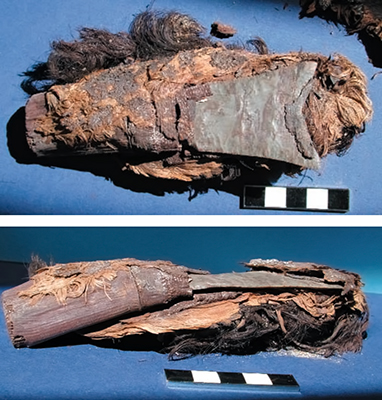
A report of the discovery of the knife:
Placed beneath the head of the deceased, the animal hide wrapper had tightly adhered itself to the hair of the head, so tightly that when the burial was plundered and the head tossed to the surface, the knife went with it. Carefully removing the hairy hide, we could see the flint fishtail, or forked, blade still partly covered with a separate sheath to protect the delicately retouched cutting edge. But the most remarkable sight was the bamboo-like handle still in position. This is the only fishtail knife ever found still hafted. The entire knife with handle is 136 mm long. It is slightly bowed, but this is probably a result of the head pressing against it over the millennia.
The blade is made of a fine grey flint, typical of knives of this type, which are dated to Naqada IIAB and earlier, as discussed below. The expertly knapped blade, with its concave cutting edge, narrows abruptly at the lower end to create the tang that was fitted into the handle and held in place with a 10 mm wide band of leather, wrapped around at least three times. The hollow handle has been preliminarily identified as a stout stem of the common reed, phragmites. Unfortunately, the leather sheath surrounding the blade did not hold up as well; however, a blade now in the beautiful new display of Predynastic objects in the Metropolitan Museum of Art in New York is wrapped in an identical manner. The authenticity of the sheath on the New York piece had been in question, but we can now confirm that it is genuine and use it to reconstruct the original appearance of the sheathing from B412.
Photo and text: http://www.hierakonpolis-online.org/nekhennews/nn-16-2004.pdf
Map of Hierakonpolis 2003/2004.
Photo: http://www.hierakonpolis-online.org/nekhennews/nn-16-2004.pdf
Source: Renée Friedman, Director, Hierakonpolis Expedition, Editor of the Nekhen News, Dept of Ancient Egypt & Sudan, The British Museum.
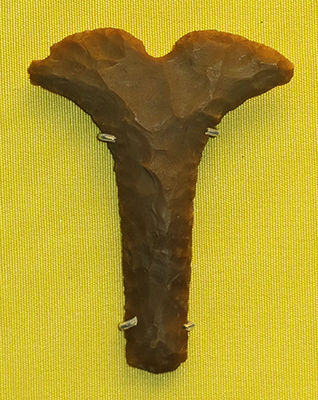
Pesesh-kef knife.
The peculiar form of this ritual implement was derived from the fish-tail knives. It was used in the Old Kingdom (2670 BC - 2181 BC) when it was believed it would reanimate the mummy so that it could eat.
The ancient Egyptian name for this tool can be translated as 'divided flint', describing its strange appearance, or 'flint that divides', denoting its function in cutting the umbilical cord.
Abydos, Temple of Osiris, First Dynasty, EA37279
Photo: Don Hitchcock 2015
Source: Original, British Museum
Text: Card at the British Museum, http://www.britishmuseum.org/, © Trustees of the British Museum, CC BY-NC-SA 4.0
Naqada II: 3 650 BC - 3 300 BC
Boat-shaped cosmetic palettes
(left) Mudstone cosmetic-palette in shape of boat, Naqada II, width 114 mm
Catalog: Middle Predynastic (Naqada II), EA58338
(right) Mudstone cosmetic-palette in form of boat with animal figure-head.
Height 64 mm, width 118 mm, thickness: 7 mm, weight 42 grams.
Catalog: Matura 2720, Early Predynastic (Naqada IIA), EA63415
Photo: Don Hitchcock 2015
Source: Original, British Museum
Text: Card at the British Museum, http://www.britishmuseum.org/, © Trustees of the British Museum, CC BY-NC-SA 4.0
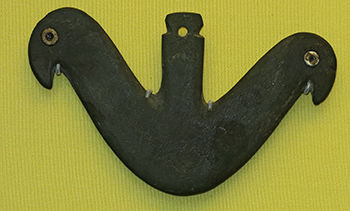
Naqada II: 3 650 BC - 3 300 BC
Boats transported the living, the dead, and also the gods who were considered to reside aboard during festivals and rituals. Boats became symbols of worldly power in life, and divine power in death.
It was believed that this power could be absorbed by grinding cosmetics on the palette, to be applied to the eyes, face and body.
Mudstone, Naqada II cosmetic-palette. Two animal-head projections.
Width 95 mm
Catalog: Early Predynastic (Naqada I-IIB), EA58339
Photo: Don Hitchcock 2015
Source: Original, British Museum
Text: Card at the British Museum, http://www.britishmuseum.org/, © Trustees of the British Museum, CC BY-NC-SA 4.0
Naqada II: 3 650 BC - 3 300 BC
Box with antelopes and fish, reportedly from Abydos, Middle Predynastic (Naqada IIC), painted pottery.
Antelopes represented nature's chaos. The early Egyptians believed that control over them allowed the creation of world order, so the dead could be reborn. Tilapia fish taking fertilised eggs into their mouth symbolise this birth.
Young fish developing in their parent's mouth eventually emerged. Such behaviour was associated with self-generation and later with the myth of the god Atum, who used his spit to create the world.
Height 79.2 mm, length: 132 mm, width 63 mm, weight 494 grams.
Rectangular box of marl pottery with four small feet, decorated in red-brown paint on the long sides with representations of four antelopes, horizontal lines and s-motifs; on short sides are representations of a many-oared boat and a cluster of six fish around a central circle.
Catalog: Early Predynastic (Naqada I-IIB), EA32639
Photo: Don Hitchcock 2018
Source: Original, British Museum
Text: Card at the British Museum, http://www.britishmuseum.org/, © Trustees of the British Museum, CC BY-NC-SA 4.0
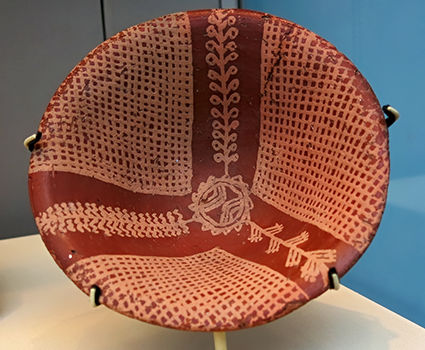
Naqada II: 3 650 BC - 3 300 BC
Painted bowl.
The decoration on this bowl reflects the hope for an afterlife in a land of plenty. In the centre, a circle represents a body of water, or perhaps a desert oasis, with lush vegetation growing around it. Desert hills are shown as cross-hatched triangles. This style of painting is characteristic of the Early Predynastic period.
Conical pottery bowl with a flat base and a slightly everted rim. Decorated with an abstract design in white on the red interior surface.
Height 63 mm, diameter 163 mm
Catalog: Early Predynastic (Naqada I - IIA), EA65360
Photo: Don Hitchcock 2015
Source: Original, British Museum
Text: Card at the British Museum, http://www.britishmuseum.org/, © Trustees of the British Museum, CC BY-NC-SA 4.0
Naqada II: 3 650 BC - 3 300 BC
Model boat
Model boat with cabin, circa 3 300 BC.
The shape of this model boat goes back to the type of wooden boats that imitated rafts made of papyrus bundles, but had been re-designed in a more durable material.
Catalog: Ceramic, ÄS 7182
Photo: Don Hitchcock 2018
Source: Original, Ägyptischen Museum München
Text: Museum card, © Ägyptischen Museum München
Naqada II: 3 650 BC - 3 300 BC
Model boat
Model boat in the shape of a crocodile, circa 3 300 BC.
The body of a crocodile is reinterpreted as the body of a boat in which a passenger has taken a seat. He once sat in a cabin made of ephemeral reeds, which were fixed in the holes just below the edge. There are three small, mummy-shaped figurines, originally in the boat, now lying outside the boat in this image.
Dark red wavy lines on the belly and flanks ( not readily visible in this image - Don )
indicate the life element of the animal and the limbs pressed tightly against the body indicate the speed with which the animal glides through the water. The dangerous crocodile, later a messenger of the sun god, guides the deceased safely through the underworld.
A large number of models of clay ships and boats of various types, with or without passengers, have survived from prehistoric times. Particularly valuable examples are made of perishable material such as reeds.
Catalog: Ceramic, ÄS 6759
Photo: Don Hitchcock 2018
Source: Original, Ägyptischen Museum München
Text: Museum card, © Ägyptischen Museum München
Naqada II: 3 650 BC - 3 300 BC
Pottery Jar
Red ware pottery jar, slip decorated, with a representation of a ship under sail beneath a chequerboard pattern.
Diameter 430 mm, height 585 mm.
(right): Close up of the image of a vulture eating a snake on the jar.
Catalog: EA35324
Photo: Don Hitchcock 2018
Source: Original, British Museum
Text: Card at the British Museum, http://www.britishmuseum.org/, © Trustees of the British Museum, CC BY-NC-SA 4.0
Naqada II: 3 650 BC - 3 300 BC
Pottery Jars
Pottery from Lower Egypt can be identified by its shape and low technical quality. Appearance was unimportant to the Delta cultures because pottery was mainly for use in daily life.
Black polished jars with ring bases are typical of the site of Maadi, a Lower Egyptian trade depot located near modern day Cairo.
Jars with rouletted decoration were more common at Buto, which was a port on the Mediterranean Sea in Predynastic times.
(left) Predynastic blackware pottery jar with foot and two handles.
Height: 215 mm.
Catalog: Probably Maadi, Early - Middle Predynastic (Naqada I - IIC), EA35353
(right) Blackened polished brown ware pottery jar.
Catalog: Badarian culture, Mostagedda, EA62991
Photo: Don Hitchcock 2018
Source: Original, British Museum
Text: Card at the British Museum, © Trustees of the British Museum, CC BY-NC-SA 4.0
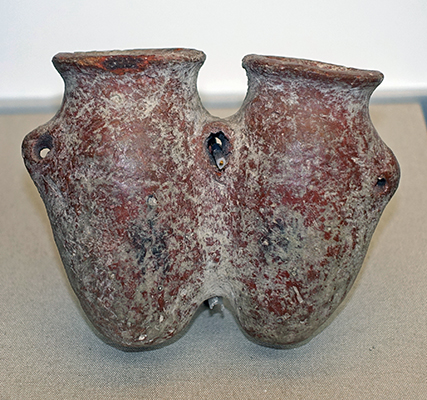
Naqada II: 3 650 BC - 3 300 BC
Double Vessel
Burnished red-brown pottery double-vessel comprising two jars with pointed bases, convex bodies and everted rims, each has pierced lug-handles at the shoulder.
New Kingdom (?) The "New Kingdom" is a period of time during the history of Ancient Egypt. It lasted from around 1520 BC to 1075 BC.
Dimensions: height 58 mm, length 73 mm, depth 37 mm.
Catalog: EA57951
Photo: Don Hitchcock 2018
Source: Original, British Museum
Text: Card at the British Museum, © Trustees of the British Museum, CC BY-NC-SA 4.0
Naqada II: 3 650 BC - 3 300 BC
Beaker with applied arms.
Birth and death were closely related for the ancient Egyptians, and both were dangerous transitions, where maternal love was desired. The two strips of clay applied to the sides of this vessel represent a mother's arms offering breasts.
Pots with relief decoration are very rare, suggesting this beaker was made specifically for the grave.
Black and red ware pottery jar. Pie-crust handles.
Height 140 mm, diameter 85 mm, weight 314 grams
Catalog: Early Predynastic (Naqada IIA) EA53884
Photo: Don Hitchcock 2015, 2018
Source: Original, British Museum
Text: Card at the British Museum, http://www.britishmuseum.org/, © Trustees of the British Museum, CC BY-NC-SA 4.0
Naqada II: 3 500 - 3 200 BC
Horus Jar
The modelled falcons on this jar are among the earliest known depictions of this important bird.
Catalog: Middle Predynastic (Naqada IIC), EA36328
Photo: Don Hitchcock 2015
Source: Original, British Museum
Text: Card at the British Museum, © Trustees of the British Museum, CC BY-NC-SA 4.0
Naqada II: 3 650 BC - 3 300 BC
Cylinder seals
Contact with the early cities of Mesopotamia began around 3 500 BC, but few actual imports are known. Egyptian made cylinder seals with patterns imitating Mesopotamian designs attest to the trade of ideas and influences between the two cultures.
Catalog: Middle - Late Predynastic (Naqada IID - III), EA65859, EA65870
Photo: Don Hitchcock 2015
Source: Original, British Museum
Text: Card at the British Museum, © Trustees of the British Museum, CC BY-NC-SA 4.0
Naqada II: 3 650 BC - 3 300 BC
The goddess Neith
This jar bears the symbol of the warrior goddess Neith: two crossed arrows mounted on a pole, as shown in the left hand image. Like Min she was an ancient deity who rose to prominence in the early dynasties.
Neith was also represented by the click beetle, as in the amulet below, probably owing to the beetle's habit to play dead when threatened, and then suddenly springing back to life.
This is a decorated pottery vase belonging to the class of Naqada II 'D'-Ware. It bears painted scenes of many-oared ships and standing human figures, including dancing women. Pierced handles on the shoulder of the vase.
Height 310 mm, diameter 275 mm, weight 3426 grams.
Catalog: Semaina, Middle Predynastic (Naqada IIC) EA49570
Photo (left): poster, British Museum, © Trustees of the British Museum, CC BY-NC-SA 4.0
Photo (right): Don Hitchcock 2015
Source: Original, British Museum
Text: Card at the British Museum, http://www.britishmuseum.org/, © Trustees of the British Museum, CC BY-NC-SA 4.0
Naqada II: 3 650 BC - 3 300 BC
Palette in the shape of a fish.
Mudstone (greywacke) palette carved in the shape of a fish with tail defined by two carved notches; single piercing at top.
Length: 96 mm, width 56 mm, thickness 5 mm.
Palette type 46p in Petrie’s Corpus of Prehistoric Pottery and Palettes (1921).
Catalog: Naqada II, EA67708
Photo: Don Hitchcock 2018
Source: Original, British Museum
Text: Card at the British Museum, http://www.britishmuseum.org/, © Trustees of the British Museum, CC BY-NC-SA 4.0
Naqada II: 3 650 BC - 3 300 BC
Palette in the shape of a fish.
Mudstone (greywacke) palette carved in the shape of a fish with tail defined by two carved notches; single piercing at top.
Length: 144 mm, width 87 mm.
Palette type like 46R in Petrie’s Corpus of Prehistoric Pottery and Palettes (1921).
The grey-green colour of both fish and the greywacke stone used for palettes had positive connotations of fertility and growth. These life enhancing properties could be transferred to the ground cosmetic powder. As a result, fish-shaped palettes were very popular, especially in the Middle Predynastic period.
Catalog: Mostagedda, Upper Egypt, Naqada II, EA56570
Photo: Don Hitchcock 2018
Source: Original, British Museum
Text: Card at the British Museum, http://www.britishmuseum.org/, © Trustees of the British Museum, CC BY-NC-SA 4.0
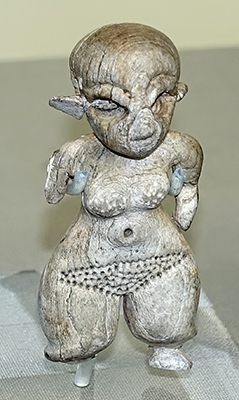
Naqada II: 3 650 BC - 3 300 BC
Ivory figurine of a woman with dwarfism
The ancient Egyptians thought people with dwarfism were endowed with special qualities. Women with the condition were associated with fertility and took part in ritual dancing. Figurines of such people are known from many early temple deposits. Their role was probably to act as intermediaries with the gods.
Height 52 mm, width 25 mm, thickness 16 mm, weight 10 grams.
Catalog: Early- Middle Predynastic (Naqada II), EA32144
Photo: Don Hitchcock 2018
Source: Original, British Museum
Text: Card at the British Museum, http://www.britishmuseum.org/, © Trustees of the British Museum, CC BY-NC-SA 4.0
Naqada IIC-D 3 650 BC - 3 300 BC
Frog-shaped jar
Frogs were connected with the Nile flood, fertility, and well-being. Small frog-shaped stone jars were meant to infuse these concepts into the oils and cosmetics within. Such vessels were luxury items often decorated with inlaid eyes. This was once the case for this example, carved from limestone breccia, but the shell inlays fell out over time.
Breccia cosmetic-vessel, theriomorphic (god depicted in an animal form), representing a frog, eyes originally inlaid, pierced lug handles and everted rim.
Circa 3300 BC.
Height 36 mm, length 59 mm, width 49 mm.
Catalog: EA65240
Photo: Don Hitchcock 2018
Source: Original, British Museum
Text: Card at the British Museum, http://www.britishmuseum.org/, © Trustees of the British Museum, CC BY-NC-SA 4.0
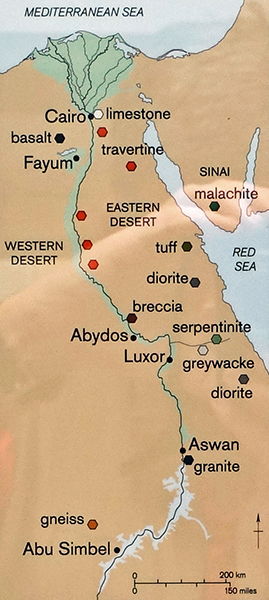
Location of known stone resources used in the Predynastic and Early Dynastic period.
Stone vessels were status symbols in the Predynastic period. Unusual stones, and those transported from afar, were even more highly valued. As the material grew in popularity during the Early Dynastic period, softer, easier to work stones were chosen to meet the demand. The variety of different stones used in this period was never exceeded.
Rephotography: Don Hitchcock 2018
Source: Poster, British Museum
Text: Card at the British Museum © Trustees of the British Museum, CC BY-NC-SA 4.0
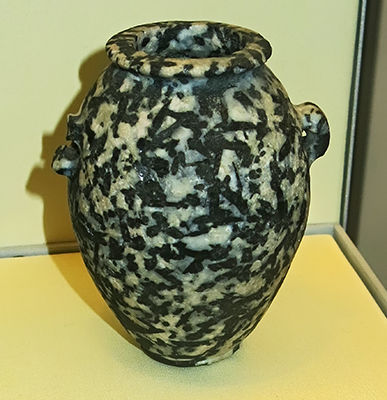
Naqada II - III: 3 650 BC - 2 900 BC
Andesite Porphyry Jar
Once hollowed out, vessels were polished with stone rubbers and fine sand. This jar shows the rough appearance prior to smoothing. It was probably left unfinished when the handle broke.
Black and white porphyry jar, not fully bored. One handle broken. Height 102 mm.
Catalog: Middle - Late Predynastic (Naqada II - III), EA26964
Photo: Don Hitchcock 2015
Source: Original, British Museum
Text: Card at the British Museum, http://www.britishmuseum.org/, © Trustees of the British Museum, CC BY-NC-SA 4.0
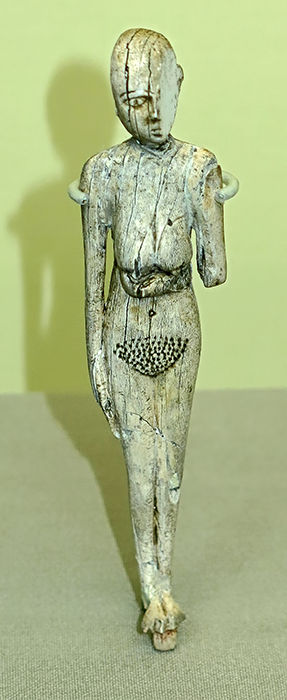
Naqada II - III: 3 650 BC - 2 900 BC
Ivory figurine
This woman is in the standard pose for female supplicants to a deity: one arm down, the other bent across the body, the hand cupping a breast.
Below her feet a peg allowed for mounting on a base, but how such figurines were displayed is uncertain.
Height 104 mm, width 22 mm, thickness 13 mm, weight 14 grams.
Catalog: Middle- Late Predynastic (Naqada II - III), EA32140
Photo: Don Hitchcock 2015
Source: Original, British Museum
Text: Card at the British Museum, http://www.britishmuseum.org/, © Trustees of the British Museum, CC BY-NC-SA 4.0
Naqada II - III: 3 650 BC - 2 900 BC
Pitt-Rivers Knife
The ceremonial knife circa 3200 BC displayed here was once owned by Lieutenant General Henry Lane Fox Pitt Rivers (1827-19000). Its ivory handle is decorated with wild animals set in orderly rows. Carved in delicate raised relief, they symbolise control over the forces of nature. At least eleven different species are shown, all marching towards their sacrifice at the knife's edge.
They include storks and herons, lions, wild dogs, short and long horn cattle, Barbary sheep, oryx, hartebeest and fish.
In the top row, vultures devouring snakes on one side, and elephants trampling cobras on the other, were potent symbols of victory and power during the Late Predynastic period.
The knife has a flint blade with a serrated lower edge.
Reportedly from Sheikh Hamada.
Length 240 mm.
Catalog: Late Predynastic (Naqada IID-III), EA68512
Photo: Don Hitchcock 2018
Source: Original, British Museum
Text: Card at the British Museum, http://www.britishmuseum.org/, © Trustees of the British Museum, CC BY-NC-SA 4.0
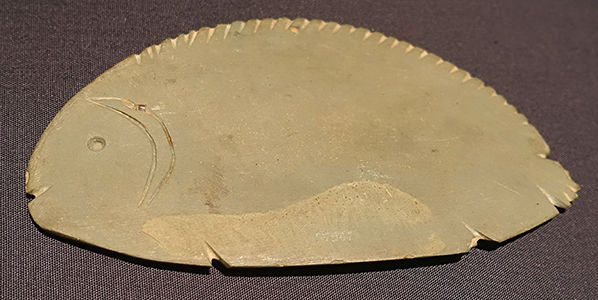
Naqada II-III: 3 650 BC - 2 900 BC
Cosmetic Palette
Mudstone (greywacke) cosmetic-palette carved in the form of a fish with drilled eye, small incised mouth and double crescent shaped lines around the face indicating gills, and incised strokes along the top edge of the body.
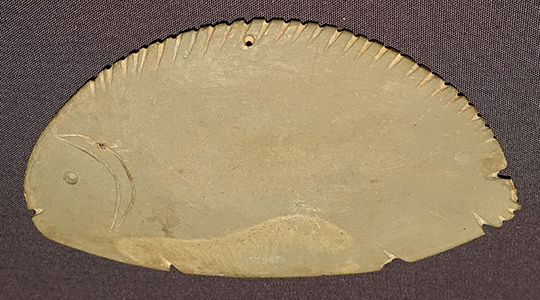
The tail is detailed with incised lines and separated from the body by notches. Two notches along the lower edge of the body represent fins. There is a single piercing at the top.
Height 90 mm, width 167 mm, thickness 8 mm, weight 157 gm.
Catalog: Predynastic (Naqada II-III) EA57947
Photo: Don Hitchcock 2017
Text: Card, http://www.britishmuseum.org/, © Trustees of the British Museum, CC BY-NC-SA 4.0
Source: Exhibition by the British Museum at the National Museum of Australia, Canberra
Naqada II - III: 3 650 BC - 2 900 BC
Pitt-Rivers Knife
Detail of the front and back of the Pitt Rivers knife handle above showing rows of animals.
Catalog: Late Predynastic (Naqada IID-III), EA68512
Photo: © Trustees of the British Museum, CC BY-NC-SA 4.0
Rephotography: Don Hitchcock 2018
Source: poster, British Museum
Text: Card at the British Museum, http://www.britishmuseum.org/, © Trustees of the British Museum, CC BY-NC-SA 4.0
Naqada II-III: 3 650 BC - 2 900 BC
Palette in the shape of a fish.
Mudstone (greywacke) palette carved in the shape of a fish with a pointed nose, small mouth indicated by a small incision, drilled eye, short incised strokes along the top edge, and longer incisions detailing the tail, which is contiguous with the contour of the body and not separated. There is a single piercing at the top.
Length 155 mm.
Catalog: Mahasna, Naqada II-III, EA49266
Photo: Don Hitchcock 2018
Source: Original, British Museum
Text: Card at the British Museum, http://www.britishmuseum.org/, © Trustees of the British Museum, CC BY-NC-SA 4.0
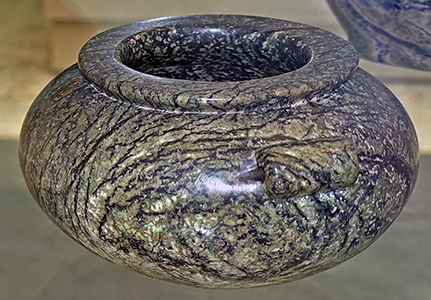
Naqada II-III: 3 650 BC - 2 900 BC
Serpentinite Jar
Squat serpentinite jar with two tubular handles.
Serpentinite is a green stone with dark serpent-like veins, and is found in the Eastern desert. It enjoyed wide usage from the Predynastic to the New Kingdom.
Diameter 115 mm, height 79 mm.
Catalog: Middle - Late Predynastic, Naqada IIC - III, EA35075
Photo: Don Hitchcock 2018
Source: Original, British Museum
Text: Card at the British Museum, http://www.britishmuseum.org/, © Trustees of the British Museum, CC BY-NC-SA 4.0
Naqada III: 3 300 BC - 2 900 BC
Jar Sealing of Pharaoh lry-Hor and Pharaoh Ka, the first humans that we know the name of.
Pharaoh Iry-Hor wrote his name as a falcon over a mouth sign. He was followed by Ka, the first Pharaoh to use a serekh, or royal name box. Immediate predecessors of Narmer, both were buried at Abydos.
The kings before Narmer were collectively remembered as 'the spirits of the dead', but archaeologists have been able to identify some of them from inscriptions, as above.
Left EA35510, right EA35509.
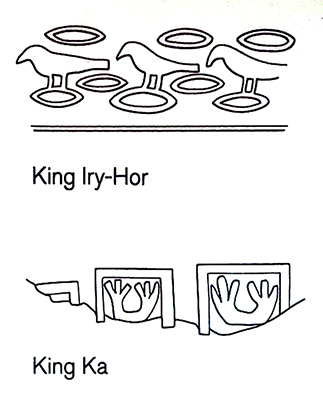
EA35510: Part of a clay jar-seal: with the impression of a repeated design, showing a bird and the r-sign hieroglyph. The seal is fairly well preserved, the inscribed surface being slightly worn.
Length 101 mm, width 82 mm, thickness 51 mm.
Catalog: Abydos, B Cemetery, Late Predynastic (Naqada III), EA35510
EA35509: A fragment of a clay jar-seal: in a good state of preservation, bearing part of an impressed inscription giving the name Ka.
Length 35 mm, width 39 mm.
Catalog: Umm el-Qaab (Abydos) Tomb of Ka, (tomb B7) Late Predynastic (Naqada III), EA35509
Photo (upper left and right): Don Hitchcock 2015
Rephotography of an existing poster, artist unknown (lower left): Don Hitchcock 2018
Source: Original, British Museum
Text: Card at the British Museum, http://www.britishmuseum.org/, © Trustees of the British Museum, CC BY-NC-SA 4.0
Naqada III: 3 300 BC - 2 900 BC
Composite figure of a swallow
The figure is composed of calcite and basalt (?), length 102 mm.
( note that the beak of the swallow is missing - Don )
Swallows stood for strength because of their nature, as well as a play on words. The ancient Egyptian writing system gave the swallow the sound value wr, used to spell the word 'great' or 'strong'.
Writing was introduced in the Late Predynastic period.
Catalog: Naqada III, EA30742
Photo: Don Hitchcock 2018
Source: Original, British Museum
Text: Card at the British Museum, http://www.britishmuseum.org/, © Trustees of the British Museum, CC BY-NC-SA 4.0
Jewellery and jewellery accessories
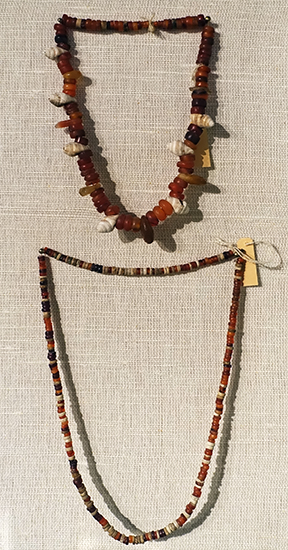
Naqada III: 3 300 BC - 2 900 BC
Two Necklaces
Two necklaces from Abusir el-Malaq, circa late 4th millennium BC.
Especially the flat, disc-shaped beads of the longer necklace are timeless and are used for jewellery during all epochs of Egyptian history - in this case only the find context secures the early dating.
The small necklace shows the combination of cut (artificial) and natural elements (snail shells), which is very typical for the prehistoric period.
Photo: Don Hitchcock 2018
Source and text: Original, Museum August Kestner, Hannover
Early writingText above from a poster at the British Museum, © Trustees of the British Museum, CC BY-NC-SA 4.0
Late Predynastic - Third Dynasty
3 250 BC - 2 613 BC
The hieroglyphic script is a distinctive aspect of ancient Egyptian culture, but its origins are controversial. Once thought to have been borrowed from Mesopotamia, Egyptian writing is now understood as an independent invention. Small labels dating to 3250 BC, found in Abydos Tomb U-i, provide the evidence. Most show symbols, but on some hieroglyphic signs denote sound values that write place names. These hieroglyphs are unlike anything known earlier, suggesting that writing was a deliberate creation by early rulers to control a growing bureaucracy.
Palettes and powerText above: Poster at the British Museum, © Trustees of the British Museum, CC BY-NC-SA 4.0
Late Predynastic
3 300 BC -3 100 BC
The process of unifying Egypt under one king began in the Late Predynastic period, and culminated in the First Dynasty.
Actual events are unknown, but the early rulers recorded their victories on beautifully carved temple objects. They saw themselves fighting these battles on behalf of the gods, to protect the world from chaos. Initially animals were depicted as adversaries, later replaced by people.
Maintaining order and tending to the gods would become the main duties of all Egyptian kings.
Naqada III: 3 300 BC - 2 900 BC
Battlefield palette
This giant cosmetic palette was a gift to a temple. An early ruler is shown as a rampant lion, displaying his abilities by mauling the enemies of order. Gods' images appear on poles equipped with human arms, leading away the captives. The other side of the palette depicts the harmonious outcome of the battle.
The bloody battle on the front of the palette contrasts with the serenity of the two giraffes. They nibble on a finely carved palm tree, which is a symbol of the ruler's productive qualities. This scene reflects the balance of complementary ideas that was to become the heart of Egyptian kingship.
Catalog: Reportedly from Abydos, Naqada III, EA20791, Ashmolean 1892.1171
Photo: Don Hitchcock 2018
Source: Original, British Museum
Text: Card at the British Museum, http://www.britishmuseum.org/, © Trustees of the British Museum, CC BY-NC-SA 4.0
Naqada III: 3 300 BC - 2 900 BC
Hunters palette
The sacrifice of wild animals played an important role in early Egyptian temple ritual by demonstrating control over the chaos in the world. Here two rows of well-equipped hunters both corral and capture wild animals for presentation at the shrine above, and bravely confront a lioness with her cub. This is one of the earliest of the elaborately decorated palettes of the Late Predynastic period.
It shows the development of artistic conventions for depicting the human body: head and legs in profile, with the torso in three- quarter view.
Fragment of 'The Hunters' Palette': of grey mudstone: decorated on one side only with scenes in low relief.
Companies of warriors are shown hunting wild animals, particularly lions. Three men carry the standards denoting different tribes or provinces; the remainder carry their weapons, which include the bow, spear, mace, throwstick and lariat. The rounded objects carried by some of the warriors have been interpreted as bags or shields. One member of the company is attempting to hold a rope which has caught a hartebeest by the horns. Two lions have been hit by arrows and one of the wounded beasts is shown pursuing a man.
The arrows are clearly of the flint-tipped variety, with a chisel edge rather than a point. The dress of the men consists of the short kilt with an animal's tail attached at the back; they all wear beards and most have feather headdresses. Apart from the lions, the animals depicted are the gazelle, hartebeest, hare, jackal, ostrich and a species of deer. In the middle of the palette, but slightly offset towards the wider end, is a flat area surrounded by a raised ring, imitating the circular depressions used for grinding eye-paint on functional palettes.
At the broad end are two items which have attracted much attention, one being a representation of a shrine and the other a mythical beast consisting of the linked fore-parts of two buffalo. The entire surface of the palette is covered with fine scratches, made in the process of carving the relief. A fragment is missing from the middle of one side, whilst the upper left section is completed by the cast of the Louvre fragment.
Findspot: El-Amarna
Dimensions, undocumented with respect to the particular fragments:
Width 305 mm, height 145 mm, depth 22 mm, weight 1.6 kilograms
Height 258 mm (all pieces), width 665 mm (all pieces), depth 24 mm (all pieces)
Height 142 mm Cast piece) width: 400 mm, (cast piece) depth 24 mm (Cast piece)
Curator's comments: One of two fragments at the British Museum with a cast of a third fragment in the Louvre (E.11224). Affixed to 1888,0512.66 and cast of Louvre fragment.
Catalog: Abydos, Late Predynastic (Naqada III), EA20790, 20792; cast of Louvre 11254
Photo (left): Don Hitchcock 2015
Photo (right): © Trustees of the British Museum, CC BY-NC-SA 4.0
Source: Original and Facsimile, British Museum
Text: Card at the British Museum, http://www.britishmuseum.org/, © Trustees of the British Museum, CC BY-NC-SA 4.0
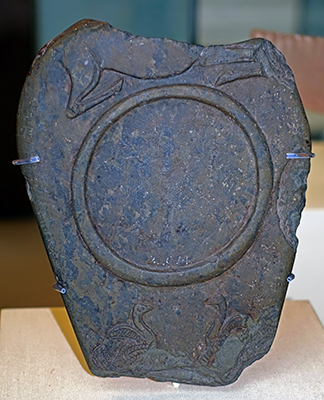
Naqada III: 3 300 BC - 2 900 BC
Gazelle-goose palette
A gazelle rests at the top of this palette fragment, while geese are symmetrically positioned below.
This design reflects an ordered and peaceful world. Both animals were important symbols in earlier times, but gradually lost their meaning during the late Predynastic period.
This is part of a ceremonial palette of grey mudstone, with the figure of an antelope in low relief at the top. This figure was carved on both sides of the palette, and on the reverse it forms the only decoration. The obverse bears a raised ring (copied from cosmetic palettes) below the antelope, whilst at the lower edge of the fragment there are two figures of birds, possibly geese. Both the top and bottom of the object are missing.
( note that the ring is, however, not symmetrical - Don )
Length 152 mm, width 114 mm.
Catalog: Naqada III, EA32074
Photo: Don Hitchcock 2018
Source: Original, British Museum
Text: Card at the British Museum, http://www.britishmuseum.org/, © Trustees of the British Museum, CC BY-NC-SA 4.0
Naqada III: 3 300 BC - 2 900 BC
Cosmetics
Three minerals were used for cosmetics: red ochre (iron oxide), green malachite (copper carbonate), and black galena (lead sulphite). The minerals were ground to a powder on the palettes using a naturally rounded pebble. This powder was then mixed with oils or fats before application.
EA37359: Cosmetic palette, early 1st Dynasty, Thebes.
Length 110 mm, thickness 10 mm, width 90 mm.
Rectangular slate palette with incised border lines on the upper surface. The centre of this side is worn and stained green from use. Two of the corners are slightly chipped.
EA36657: Basalt pebble, length 70 mm.
EA90470: Irregularly-shaped sample of hematite (iron oxide).
EA83062: Piece of malachite used for cosmetics, predynastic, findsite Hierakonpolis, height 9 mm, width 15 mm (max).
EA62104: Galena, misidentified in the catalog.
Catalog: Palette, Late Predynastic (Naqada III), EA37359
Probably Predynastic, EA36657, EA90470
Hierakonpolis, Predynastic, EA83062
Mostagedda 330, Badarian, EA62104
Photo: Don Hitchcock 2018
Source: Original, British Museum
Text: Card at the British Museum, http://www.britishmuseum.org/, © Trustees of the British Museum, CC BY-NC-SA 4.0
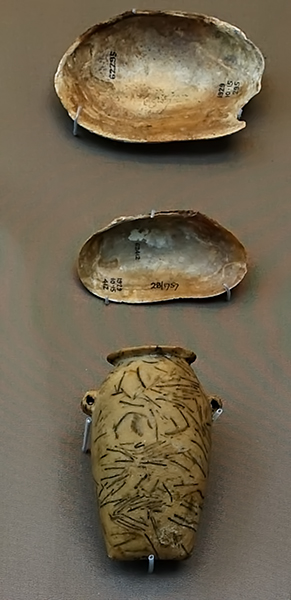
Naqada II-III: 3 650 BC - 2 900 BC
Cosmetic containers
Bivalve shells were commonly used to mix cosmetic pigments. Small stone vessels probably held the precious oils needed to make the paste. These containers were sometimes carved into unusual shapes.
Bottom to top:
EA26971: Variegated limestone vase, cream with grey slashes, bag-shaped vase, with horizontally pierced tubular handles on the sides, the contracted mouth is surrounded by an everted ledge-rim.
Diameter 43 mm (max), height 78 mm. Middle - Late Predynastic (Naqada II-III).
EA62412: Bivalve Spatha mother-of-pearl shell, Mostagedda, Early Predynastic (Naqada IIA), length 67 mm, width 33 mm.
EA62295: Bivalve Spatha mother-of-pearl shell, Mostagedda, Badarian, Predynastic, length 84 mm, width 53 mm.
Photo: Don Hitchcock 2018
Source: Original, British Museum
Text: Card at the British Museum, http://www.britishmuseum.org/, © Trustees of the British Museum, CC BY-NC-SA 4.0
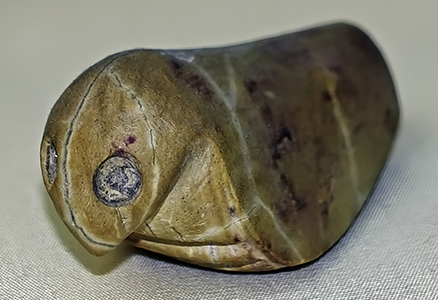
Naqada III: 3 300 BC - 2 900 BC
Falcon statuette
This limestone statuette of the falcon god Horus is pierced at the base for mounting on poles. Images of the gods were taken to the hunt or into battle as emblems and protection.
Figure of a falcon, length 58 mm.
Catalog: EA32135
Photo: Don Hitchcock 2018
Source: Original, British Museum
Text: Card at the British Museum, http://www.britishmuseum.org/, © Trustees of the British Museum, CC BY-NC-SA 4.0
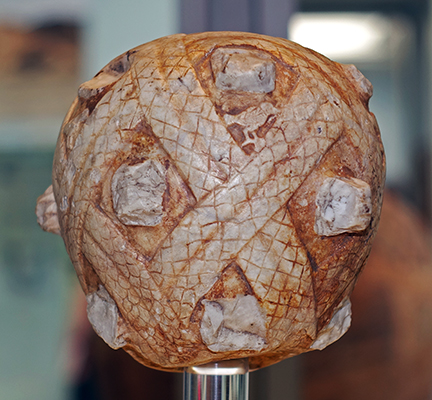
Naqada III: 3 300 BC - 2 900 BC
Decorated mace head
Clenched fists are all that remain of the enemies trapped in the coils of the large snake carved onto this hard limestone mace head. The message of power is clear, and is reinforced by four swallows placed around the top of the mace. The swallow was the hieroglyph for the word 'strength'. Such a mace would have been for display only.
A heavy pear shaped mace-head of hard crystalline limestone, pierced vertically for fixing to a handle. The surface originally had fifteen small square projections, of which only three are relatively intact.
Between these projections the mace is decorated with a design of a snake in low relief, coiled symmetrically around the object, with the head and the tail represented close together. Beneath the topmost group of projections, and between the coils of the snake, are four figures of birds also in relief.
The whole object is carved with great delicacy and detail, and is well preserved apart from the damaged projections and a small amount of chipping at the base.
Dimensions: diameter 80 mm, height 78 mm, weight 750 grams.
Catalog: Naqada III, EA26247
Photo: Don Hitchcock 2018
Source: Original, British Museum
Text: Card at the British Museum, http://www.britishmuseum.org/, © Trustees of the British Museum, CC BY-NC-SA 4.0
Naqada III: 3 300 BC - 2 900 BC
Label with two men
Two men holding a ring between them is the symbol of a town thought to be in the Delta. This label was attached to a box containing goods from that place, which were destined for a ruler's tomb at Abydos.
The use of precious ivory for the label enhanced the prestige of the offering.
Catalog: Late Predynastic (Naqada III), Abydos, U Cemetery, EA66955
Photo (left): Don Hitchcock 2015
Photo (right): from the card at the British Museum © Trustees of the British Museum, CC BY-NC-SA 4.0
Source: Original, British Museum
Text: Card at the British Museum, http://www.britishmuseum.org/, © Trustees of the British Museum, CC BY-NC-SA 4.0
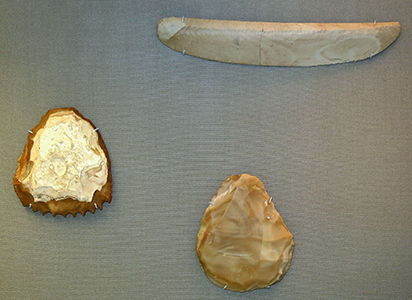
Naqada III: 3 300 BC - 2 900 BC
Scrapers and knife
Tools of daily life were durable and multifunctional. Scrapers were employed for fish scaling and leather working, among other tasks. The scalloped edge on one is unusual and its function is uncertain. Knives made from long blades had many purposes. The cutting edge on the knife shows signs of usage.
Catalog: Abydos, late Predynastic (Naqada III), EA37264, EA37265
Middle - Late Predynastic (Naqada II - III) EA32094
Photo: Don Hitchcock 2015
Source: Original, British Museum
Text: Card at the British Museum, © Trustees of the British Museum, CC BY-NC-SA 4.0
Naqada III: 3 300 BC - 2 900 BC
Flint Hoe and Breccia Axe
Egypt's wealth depended on farming. Barley and emmer wheat were the staple crops. Hoes of flint were used to till the fertile soil. Metal implements were also used, but they were rare. This limestone breccia axe reproduces the form of a functional tool made of copper. It was probably used in ceremonies.
Hoe: Length 159 mm, width 70 mm, thickness 23 mm, weight 230 grams
Red breccia axe-head: Carefully ground into shape and polished. It has a narrow, very slightly convex butt, and splayed sides that turn outwards slightly towards the cutting edge, which is moderately convex. The sides and the butt are squared. At the rear end are two perforations, correspondingly positioned in a line parallel to the butt. The cutting end is damaged at several points along its width, though the chipping is confined almost entirely to one face. This same face has a weathered appearance at its butt end. On the other face small inclusions have been displaced from the matrix, leaving holes in the surface.
Axe: Height 116 mm, width 74 mm, thickness 13 mm, weight 1980 grams.
Catalog: Hoe: Abydos, Middle Predynastic (Naqada II), EA37268
Axe: reportedly from Gebelein, Late Predynastic (Naqada III) EA32092
Photo: Don Hitchcock 2015
Source: Original, British Museum
Text: Card at the British Museum, © Trustees of the British Museum, CC BY-NC-SA 4.0
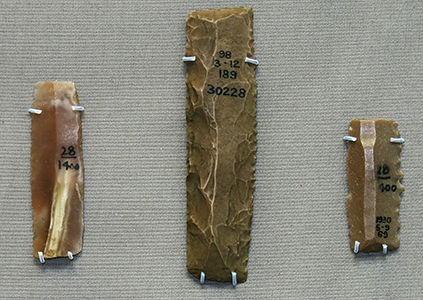
Naqada III: 3 300 BC - 2 900 BC
Sickle blades
Sickles were used to harvest the crops. Standardised, mass produced sickle blades were introduced at the end of the Predynastic period to increase agricultural efficiency.
The blades were fitted into a curved mount. Their standard size meant they could be easily replaced when blunt or broken.
Catalog: Mostagedda area, 1400, Late Predynastic (Naqada III), EA62372 EA83065
(centre) Late Predynastic (Naqada III) EA30228
Photo: Don Hitchcock 2015
Source: Original, British Museum
Text: Card at the British Museum, © Trustees of the British Museum, CC BY-NC-SA 4.0
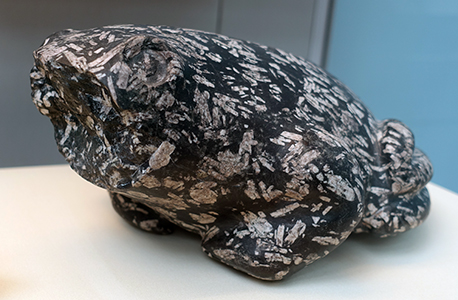
Naqada III: 3 300 - 2 900 BC
The frog goddess Heket
The frog goddess Heket watched over childbirth, a connection forged by the myriad tadpoles visible on the Nile banks. Small statuettes offered as votive gifts at many early temples are evidence of her popularity. This larger statue of andesite porphyry Is one of the few sizeable animal sculptures surviving from the Early Dynastic period It might have been a cult statue, or a royal gift to a shrine.
Greenish-black andesite porphyry was quarried from one of the ancient quarries on the flanks of Gebel Dokhan, high on the hill-slopes of Wadi Abu Maamel, known collectively as Mons Porphyrites by the Romans.
Catalog: Late Predynastic (?)1st Dynasty (?), EA66837
Photo: Don Hitchcock 2018
Source: Original, British Museum
Text: Card at the British Museum, http://www.britishmuseum.org/, © Trustees of the British Museum, CC BY-NC-SA 4.0
Additional text: http://www.art-granite.com/article/information/Eto_interesno__Geologicheskaya_informatsiya_o_granite_.html
Additional text: Nicholson and Shaw (2000)
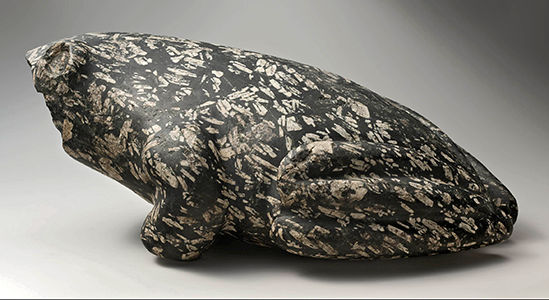
Naqada III: 3 300 BC - 2 900 BC
The frog goddess Heket
A finely-worked figure of a frog: in black and white porphyritic andesite/diorite. The details of the legs and eyes are depicted, and the surface of the stone is smooth and polished. The eyes have been drilled out to a depth of 5 mm and were probably inlaid with a different colour of stone. Part of the face and chin has been restored, including the mouth.
Height 115 mm, length 287 mm, width 174 mm, weight 6800 grams.
Catalog: Late Predynastic (?)1st Dynasty (?), EA66837
Photo: © Trustees of the British Museum, CC BY-NC-SA 4.0
Source: Original, British Museum
Text: Card at the British Museum, http://www.britishmuseum.org/, © Trustees of the British Museum, CC BY-NC-SA 4.0
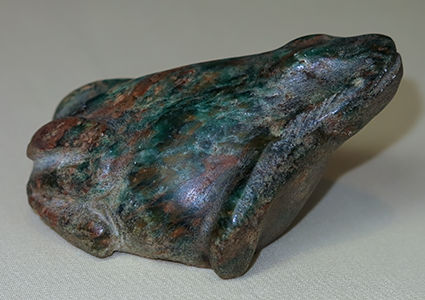
Naqada III: 3 300 BC - 2 900 BC
Frog
Figure of a frog in green stone, streaked with brown. The eyes and mouth are depicted by shallow depressions and incised lines, although the work is not very detailed. The surface is smooth and polished, except on the underside, which is rough and may have been broken.
Length 82 mm, width 59 mm, height 44 mm.
Numerous examples of Early Dynastic frog-figures are known.
Catalog: Late Predynastic (Naqada III) - Early Dynastic, EA54372
Photo: Don Hitchcock 2015
Source: Original, British Museum
Text: Card at the British Museum, http://www.britishmuseum.org/, © Trustees of the British Museum, CC BY-NC-SA 4.0

Naqada III: 3 300 BC - 2 900 BC
Amulets
Pelican, lion and vulture amulets. The qualities of certain animals, such as the strength of a lion and the maternal skills of a pelican, made them suitable as protective amulets to ward off evil.
The vulture was the hieroglyphic symbol writing the word 'mother', and the goddess Nekhbet protector of the king, was often shown in the form of a vulture.
(left to right)
EA57751: Serpentine amulet in form of pelican, single piercing, Naqada III, 35 mm.
EA57750: Serpentine amulet in form of lion, single piercing, Naqada III, 25 mm.
EA57752: Blue glazed composition amulet in the form of a vulture, single piercing, Naqada III, 19 mm.
EA57753: Vulture amulet, apparently of serpentine, no other information.
Catalog: Late Predynastic (Naqada III) - Early Dynastic, EA57751, EA57750, EA57752, EA57753
Photo: Don Hitchcock 2015
Source: Original, British Museum
Text: Card at the British Museum, http://www.britishmuseum.org/, © Trustees of the British Museum, CC BY-NC-SA 4.0
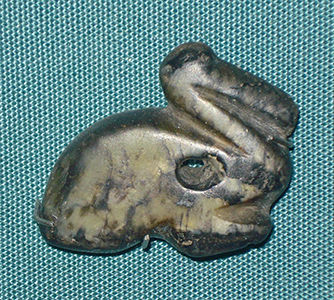
Naqada III: 3 300 BC - 2 900 BC
Pelican Amulet
Serpentine amulet in form of pelican, single piercing, Naqada III, 35 mm.
Catalog: Late Predynastic (Naqada III) - Early Dynastic, EA57751
Photo: © Trustees of the British Museum, CC BY-NC-SA 4.0
Source: Original, British Museum
Text: Card at the British Museum, http://www.britishmuseum.org/, © Trustees of the British Museum, CC BY-NC-SA 4.0
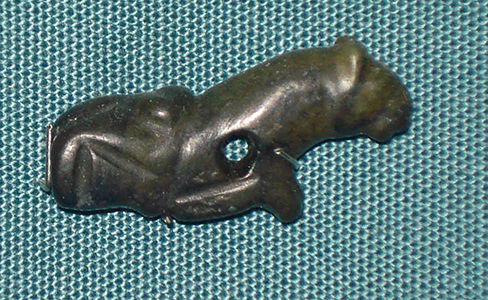
Naqada III: 3 300 BC - 2 900 BC
Lion Amulet
Serpentine amulet in form of lion, single piercing, Naqada III, 25 mm.
Catalog: Late Predynastic (Naqada III) - Early Dynastic, EA57750
Photo: © Trustees of the British Museum, CC BY-NC-SA 4.0
Source: Original, British Museum
Text: Card at the British Museum, http://www.britishmuseum.org/, © Trustees of the British Museum, CC BY-NC-SA 4.0
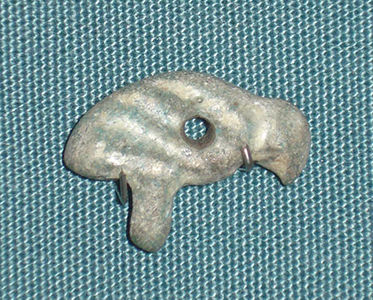
Naqada III: 3 300 BC - 2 900 BC
Vulture Amulet
Blue glazed composition amulet in the form of a vulture, single piercing, Naqada III, 19 mm.
Catalog: Late Predynastic (Naqada III) - Early Dynastic, EA57752
Photo: © Trustees of the British Museum, CC BY-NC-SA 4.0
Source: Original, British Museum
Text: Card at the British Museum, http://www.britishmuseum.org/, © Trustees of the British Museum, CC BY-NC-SA 4.0
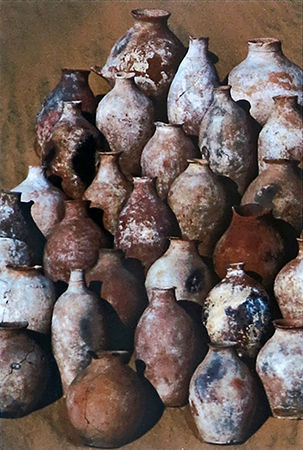
Naqada III: 3 300 BC - 2 900 BC
Wine from Tomb U-j of Scorpion I at Abydos 1
The early ruler buried in Tomb U-j at Abydos must have been very fond of wine since he imported nearly 4500 litres of it, brought in 700 foreign jars. When excavated by a German team in 1988, two chambers of the nine room tomb were still filled with 360 imported vessels, stacked three rows deep.
(left) Imported wine jars from Tomb U-j at Abydos.
Courtesy of the German Archaeological Institute, Cairo.
Photo: © Trustees of the British Museum, CC BY-NC-SA 4.0
Source: Poster, British Museum
Text: Card at the British Museum, http://www.britishmuseum.org/, © Trustees of the British Museum, CC BY-NC-SA 4.0
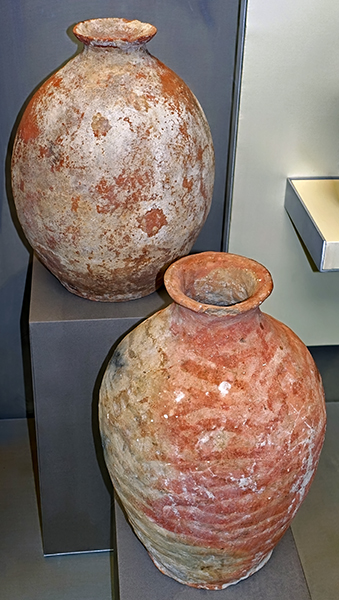
Naqada III: 3 300 BC - 2 900 BC
Two wine jars.
The two jars displayed here probably originated from another room, emptied earlier. Chemical analysis proves they contained resinated grape wine, much like modern retsina.
Some of the wine was also sweetened with added grapes and dried figs, or flavoured with herbs including mint, coriander and sage. This same tomb also held the labels with the earliest evidence of writing in Egypt, dating to about 3 250 BC.
Scorpion I was the first of two rulers of Upper Egypt during Naqada III. His name may refer to the scorpion goddess Serket, though evidence suggests Serket's rise in popularity to be in the Old Kingdom, bringing doubt to whether Scorpion actually took his name from her.
Scorpion is believed to have lived in Thinis one or two centuries before the rule of the better-known Scorpion II of Nekhen and is presumably the first true king of Upper Egypt. To him belongs the U-j tomb found in the royal cemetery of Abydos where Thinite kings were buried.
Left, above: EA27747: Red ware necked pottery jar, flat base, convex sides, everted rim, exterior covered with white magma.
Height: 315 mm, diameter 244 mm.
Right, below: EA27748: Brownware pottery shouldered jar; buff slip and mottled red paint.
Height 355 mm, diameter 223 mm
Catalog: Probably Abydos, Tomb U-j, Late Predynastic Naqada III, EA27747, EA27748
Photo: Don Hitchcock 2018
Source: Original, British Museum
Text: Card at the British Museum, http://www.britishmuseum.org/, © Trustees of the British Museum, CC BY-NC-SA 4.0
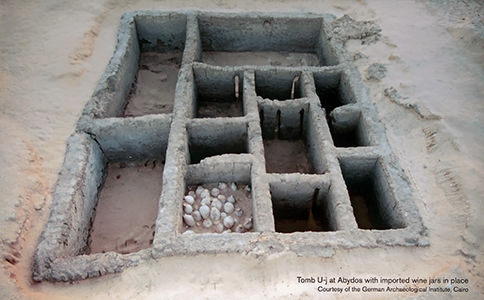
Naqada III: 3 300 BC - 2 900 BC
Tomb of U-j at Abydos with imported wine jars in place.
Photo: Courtesy of the German Archaeological Institute, Cairo, © Trustees of the British Museum, CC BY-NC-SA 4.0
Source: Poster, British Museum
Text: Card at the British Museum, http://www.britishmuseum.org/, © Trustees of the British Museum, CC BY-NC-SA 4.0

Naqada III: 3 300 BC - 2 900 BC
Bucrania amulets
The abstract style of these amulets is generally considered to represent a bull's head, seen from above, with the horns curved down over the muzzle. Such amulets became popular in Late Predynastic times and continued to be made into the Second Dynasty. They attest to a new reliance on positive powers for protection.
Left, EA57743, no further information.
Second from left, EA57744: Amethyst amulet in the form of a stylised bull-head, Naqada III, length 35 mm.
Centre, EA57747: Steatite amulet in form of stylised bull-head with inlaid shell eyes, one horn broken, Naqada III, length 32 mm.
Second from right, EA57748: Pink limestone amulet in form of stylised bull-head, Naqada III, length 38 mm.
Right, EA54743: Calcite amulet in form of stylised bull-head; inlaid eyes, Naqada III, length 28 mm.
Catalog: Late Predynastic (Naqada III) - Second Dynasty, EA57743, EA57744, EA57747, EA57748, EA54743
Photo: Don Hitchcock 2015
Source: Original, British Museum
Text: Card at the British Museum, http://www.britishmuseum.org/, © Trustees of the British Museum, CC BY-NC-SA 4.0
Naqada Period
Bull's head amulet in white limestone. The horizontal perforation at the back has been broken. From Hemamieh North Spur, ( grid reference? ) F:232 at ( depth? ) 1'6".
Collection Place Hemamieh
Collection Place Notes F:232 1'6"
Accession Number LDUCE-UC10328
Photo: Don Hitchcock 2018
Source: Original, Petrie Museum, London, England
Text: Card / online catalogue, the Petrie Museum, © 2015 UCL. CC BY-NC-SA license.
Additional reference: Brunton & Caton-Thompson (1928), LXXI, 63
Naqada Period
Naqada I
Hippopotamus tusk, plain, with sixteen holes around the widest end. Hippopotamus tusk, upper canine germ (juvenile). From Naqada Tomb 1587.
Length 79 mm, Width 25 mm, Accession Number LDUCE-UC4159.
Naqada II
String of beads, steatite, carnelian and fluorite, length 51 mm, from Naqada Tomb 1413, Accession Number LDUCE-UC4602.
Naqada II: String of beads, garnet, glazed composition (faience), gold foil on plaster beads.
Length 212 mm.
From Naqada Tomb 1413, Accession Number LDUCE-UC4603
Brown pebble. From Naqada, Grave 1413.
Height 40 mm, length 33 mm.
Accession Number LDUCE-UC36033
Naqada II: Pierced wide ivory comb with grooved teeth, slight notching at top. From Naqada Tomb 1413.
Length 46 mm, width 38 mm
Accession Number LDUCE-UC4599
Photo: Don Hitchcock 2018
Source: Original, Petrie Museum, London, England
Text: Card / online catalogue, the Petrie Museum, © 2015 UCL. CC BY-NC-SA license.
Naqada III: 3 300 BC - 2 900 BC
Bucrania amulets
Left, EA57744: Amethyst amulet in form of stylised bull-head, Naqada III, length 35 mm
Second from left, EA57747: Steatite amulet in form of stylised bull-head with inlaid shell eyes, one horn broken, Naqada III, length 32 mm.
Second from right, EA57748: Pink limestone amulet in form of stylised bull-head, Naqada III, length 38 mm.
Right, EA54743: Calcite amulet in form of stylised bull-head; inlaid eyes, Naqada III, length 28 mm.
Catalog: Late Predynastic (Naqada III) - Second Dynasty, EA57744, EA57747, EA57748, EA54743
Photo: © Trustees of the British Museum, CC BY-NC-SA 4.0
Source: Original, British Museum
Text: Card at the British Museum, http://www.britishmuseum.org/, © Trustees of the British Museum, CC BY-NC-SA 4.0
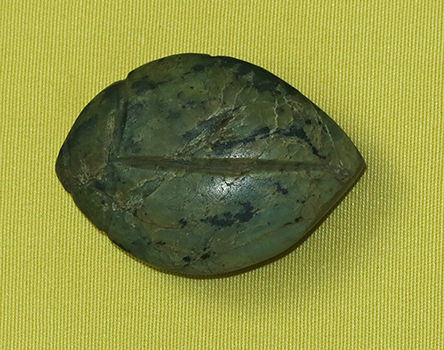
Naqada III: 3 300 BC - 2 900 BC
The goddess Neith
Neith was also represented by the click beetle, as in this amulet, probably owing to the beetle's habit to play dead when threatened, and then suddenly spring back to life.
Catalog: Late Predynastic (Naqada III) - Early Dynastic, EA22810
Photo: Don Hitchcock 2015
Source: Original, British Museum
Text: Card at the British Museum, http://www.britishmuseum.org/, © Trustees of the British Museum, CC BY-NC-SA 4.0
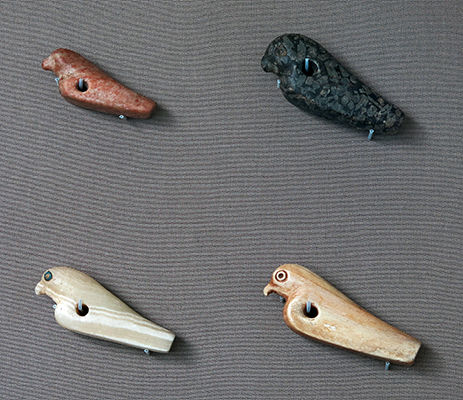
Naqada III: 3 300 BC - 2 900 BC
The falcon Horus
The falcon god Horus was the local deity of Hierakonpolis, the capital of an early regional kingdom, who eventually became the patron god of kingship.
Images of falcons were rare before Horus rose to prominence as a royal symbol and they then became popular as protective amulets.
(top left) EA17278: Limestone amulet in form of falcon, length 45 mm. Culture/period Naqada III
(top right) EA21909: Porphyry stylised figure of a falcon, single piercing, length 58 mm. Culture/period Naqada III (Late Predynastic or Early Dynastic)
(bottom left) EA13402: Calcite amulet from Thebes in the form of a falcon, single piercing, length 45 mm. Culture/period Naqada III (Late Predynastic or Early Dynastic)
(bottom right) EA14463 Ivory amulet in the form of a falcon, length 51 mm. Culture/period Naqada III (Late Predynastic or Early Dynastic)
Catalog: Late Predynastic (Naqada III) - Early Dynastic, EA17278, EA21909, EA13402, EA14463
Photo: Don Hitchcock 2015
Source: Original, British Museum
Text: Card at the British Museum, http://www.britishmuseum.org/, © Trustees of the British Museum, CC BY-NC-SA 4.0
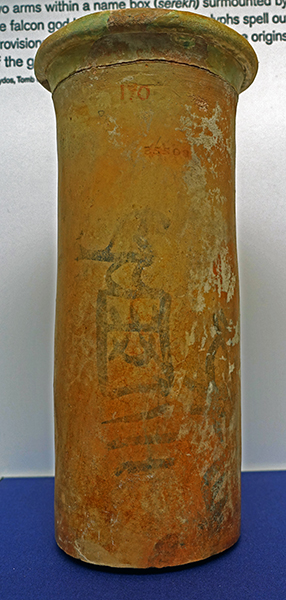
Late Predynastic (Naqada III), circa 3 120 BC
Jar with ink inscription of King Ka
Until the discovery of the labels from Tomb U-j, the earliest known hieroglyphs were on jars from the tomb of King Ka, who ruled about 3120 BC. The inscription on this vessel shows the name of the king, written as two arms within a name box (serekh) surmounted by the falcon god Horus. Alongside, hieroglyphs spell out 'Provisions from Upper Egypt'. This tells us the origins of the goods destined for the king's tomb.
Cylinder jar of dull red pottery with the remains of a pale cream slip. The jar has an external roll-rim, part of which is missing, and an incised line of decoration around the neck. On the side of the jar is an inscription in black ink.
The inscription reads as 'Ka', together with a group of signs of uncertain meaning, probably to be read ỉp-šm‘, in black ink. This inscription, with others of similar type, has been interpreted as a form of official mark or registration.
Height 270 mm, width 120 mm, diameter 124 mm (rim), 105 mm (base)
Catalog: Abydos, Tomb B7, Tomb of Ka, Late Predynastic (Naqada III), EA35508
Photo: Don Hitchcock 2018
Source: Original, British Museum
Text: Card at the British Museum, http://www.britishmuseum.org/, © Trustees of the British Museum, CC BY-NC-SA 4.0
The beginnings of mummification
The chance discovery of naturally preserved bodies from the Predynastic Period, before 3 100 BC, may have suggested to the ancient Egyptians that the corpse - and hence perhaps also the spirit of the individual - could survive death. By the third millennium BC, the notion that the dead body should be preserved had attained great importance.
Bodies excavated at Hierakonpolis in Upper Egypt indicate that as early as 3 500 BC experiments in artificial preservation of the corpses were being made, using resins and linen wrappings.
True embalming, involving extraction of internal organs and drying of the soft tissues, had certainly begun by about 2 600 BC, and techniques were refined and elaborated over the following 3 000 years.
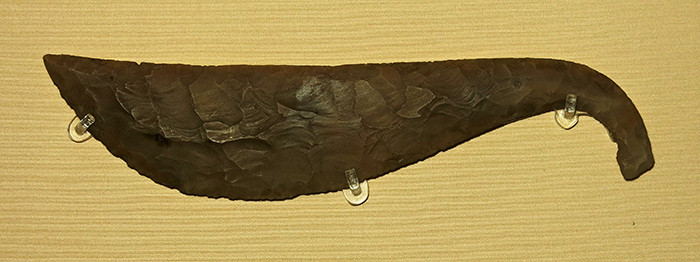
Late Predynastic, before 3 100 BC
Ritual knife
In the by now developing craft of preserving the dead as mummies, this flint knife was used to make an incision in the left flank of the body of the deceased, through which the internal organs were extracted.
Blade of a flint knife, with straight back and convex cutting edge. The butt is hollowed and curved for the handle, and is worked both sides.
Width 41 mm, length 188 mm
Catalog: unknown provenance, EA52849
Photo: Don Hitchcock 2015
Source: Original, British Museum
Text: Card at the British Museum, http://www.britishmuseum.org/, © Trustees of the British Museum, CC BY-NC-SA 4.0
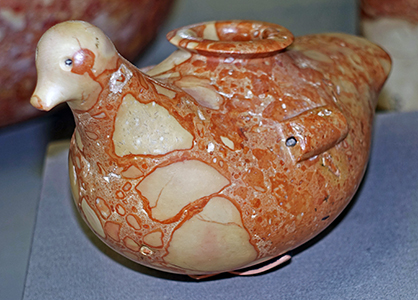
Late Predynastic / 1st Dynasty 3 300 BC - 2 900 BC
Bird Vessel
Red breccia vessel in the form of a bird. The vessel has two pierced tubular handles.
( These handles were used with cords to tie down a separate lid, which is not with the vessel at this point - Don )
Length 184 mm.
This attractive red stone was used from early times for stone vessels, mace heads, and gaming pieces. It was a favourite material for the rare animal-shaped vessels of the Late Predynastic period, such as this bird vessel. The quarry site is unknown, but sporadic deposits occur in Middle Egypt.
Catalog: EA35306
Photo: Don Hitchcock 2018
Text: Card at the British Museum, http://www.britishmuseum.org/, © Trustees of the British Museum, CC BY-NC-SA 4.0
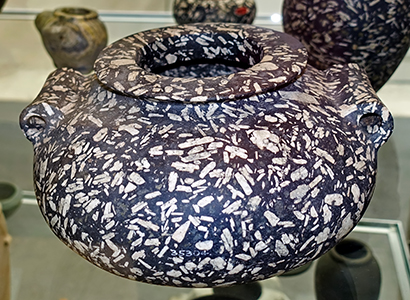
Late Predynastic / 1st Dynasty 3 300 BC - 2 900 BC
Andesite porphyry spheroidal jar
Andesite porphyry spheroidal jar with two pierced tubular handles.
Height 140 mm.
Catalog: EA35304
Photo: Don Hitchcock 2018
Text: Card at the British Museum, http://www.britishmuseum.org/, © Trustees of the British Museum, CC BY-NC-SA 4.0
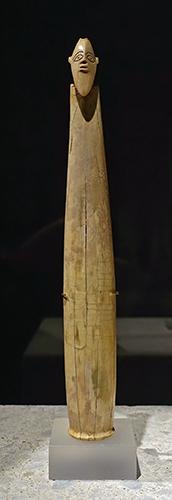

Protodynastic, 3 500 BC.
Rod amulet with a bearded head
Catalog: Elephant ivory, ÄM 14208
Photo: Don Hitchcock 2018
Source: Original, Staatliche Museen zu Berlin, Neues Museum, Germany
Text: © Card at the Staatliche Museen zu Berlin, https://smb.museum-digital.de, (CC BY-NC-SA 3.0 DE)
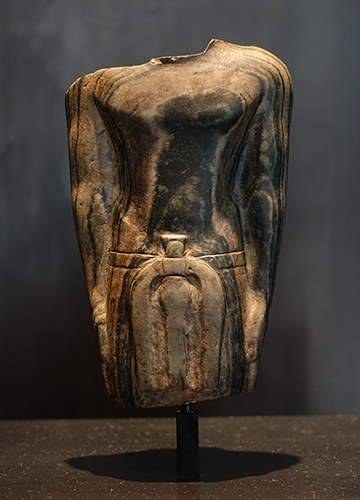
Protodynastic, 3 200 BC
Torso of a male figure
Torso of a male figure with the Horus name of Pharaoh Scorpion below the left breast.
( this is one of the earliest known occurrences of the Pharaoh Scorpion name in Egypt - Don )
Height: 112 mm.
Photo: Don Hitchcock 2018
Catalog: Anorthosite gneiss. Anorthosite is a phaneritic, intrusive igneous rock characterised by its composition: mostly plagioclase feldspar (90 - 100%), ÄS 7149
Source: Original, Ägyptischen Museum München
Acquired by the Friends Group of the Egyptian Museums of München.
Text: © Ägyptischen Museum München
Additional text: http://www.leben-in-luxor.de/luxor_lexikon_museen_smaek2.html
Protodynastic: 3 200 BC
Ointment jar
---
Eighteenth - Twentieth Dynasty: 1 550 BC - 1 075 BC
Chain
Catalog: Abusir, amethyst, gold, ÄM 18775, ÄM 34405
Photo: Don Hitchcock 2018
Source: Display, Staatliche Museen zu Berlin, Neues Museum, Germany
Text: © Card at the Staatliche Museen zu Berlin (CC BY-NC-SA 3.0 DE)
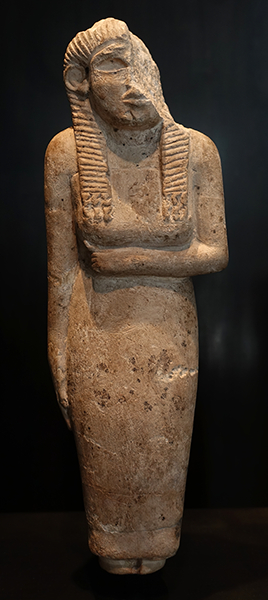
Protodynastic, circa 3 000 BC.
Standing figure of a woman
Standing figure of a woman ('city goddess'), 347 mm.
Catalog: Limestone, Abydos (?), ÄS 4234
Photo: Don Hitchcock 2018
Source: Original, Ägyptischen Museum München
Text: © Ägyptischen Museum München
Additional text: http://www.leben-in-luxor.de/luxor_lexikon_museen_smaek2.html
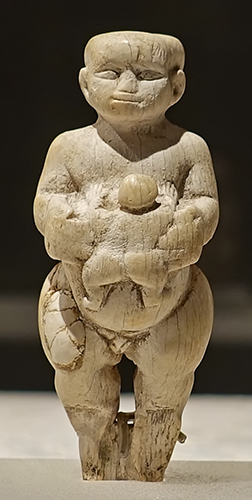
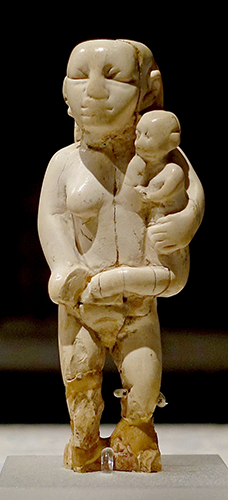
Protodynastic, circa 3 000 BC.
Two figures
Two figures of a woman with her child.
Catalog: Ivory, ÄM 14441, ÄM 17600
Photo: Don Hitchcock 2018
Source: Original, Staatliche Museen zu Berlin, Neues Museum, Germany
Text: © Card at the Staatliche Museen zu Berlin, https://smb.museum-digital.de, (CC BY-NC-SA 3.0 DE)

Timeline for early Egypt, from 11 000 BC to 2 500 BC.
Photo: Poster, British Museum © Trustees of the British Museum, CC BY-NC-SA 4.0
Rephotography: Don Hitchcock 2015
References
- Adams B., Porat N. , 1996: Imported Pottery with Potmarks from Abydos, In: J. Spencer (ed.), Aspects of Early Egypt, London: British Museum Press, p. 98-107.
- Anderson W. , 1989: Badarian Burials: Possible Indicators of Social Inequality in Middle Egypt During the Fifth Millennium B.C., Department of Anthropology McGill University, Montreal April, 1989, a thesis submitted to the Faculty of Graduate Studies and Research in partial fulfilment of the requirements for the degree of Master of Arts
- Brunton G., Caton-Thompson C., 1928: The Badarian civilization and predynastic remains near Badari, (British School of Archaeology in Egypt and Egyptian research account : thirtieth year, 1924). 1928
- Brunton, G., Caton-Thompson G., 1928: The Badarian Civilisation and Predynastic Remains near Badari, London
- Brunton G., 1929: The beginnings of Egyptian civilization, Antiquity 3, 456 - 467.
- Brunton G., Morant G., 1937: Mostagedda and the Tasian Culture, British Museum Expedition to Middle Egypt, First and Second Years (1928, 1929), B. Quaritch Limited, 1937 - Egypt - 163 pages
- Caton-Thompson E., Gardner E., 1934: The Desert Fayum, Royal Anthropological Institute of Great Britain and Ireland, London, 1934.
- Friedman R., 1999: Badari Grave Group 569, Studies in Egyptian Antiquities. A Tribute to T.G.H James, edited by W.V. Davies, British Museum Occasional Papers 123 (London 1999): 1-12.
- Gatto M., 2001-2002: Two Predynastic pottery caches at Bir Sahara (Egyptian Western Desert), Sahara, 13: 51 - 60
- Harer W., 1985: Pharmacological and Biological Properties of the Egyptian Lotus, Journal of the American Research Center in Egypt, Vol. 22 (1985), pp. 49-54 Published by: American Research Center in Egypt DOI: 10.2307/40000390
- Hikade T., 2003: Getting the ritual right – fishtail knives in Predynastic Egypt, in: S. Meyer (ed.), Ancient Egypt – Temple of the Whole World. Studies in Honour of Jan Assmann, Brill, Vol. 22 (1985), Leiden/Boston/Köln 2003: 137-151.
- Holmes D., 1989: The Predynastic Lithic Industries of Upper Egypt: A Comparative Study of the Lithic Traditions of Badari, Nagada and Hierakonpolis, BAR (15) 469, Volumes I and II.
- Kákosy L., 1995: 'The Soter Tomb in Thebes', in S.P, Vleeming (ed.), Hundred-Gated Thebes: Acts of a Colloqium on Thebes and the Theban area in the Graeco-Roman Period, Leiden: Brill, 61- 67
- Kitchen K., 1993: Ramesside inscriptions : translated and annotated Notes and comments, 1, Ramesses I, Sethos I and contemporaries’ (Oxford, 1993), 2-3.
- Koen E., 2008: Women in Ancient Egypt: The religious experiences of the non-royal woman, Thesis, MPhil in Ancient cultures at the University of Stellenbosch.
- Köhler E., Hart E., Klaunzer M. , 2017: Wadi el-Sheikh: A new archaeological investigation of ancient Egyptian chert mines, PLOS ONE, 12(2): e0170840. https://doi.org/10.1371/journal.pone.0170840
- Malkowski E., 2010: Before the Pharaohs: Egypt's Mysterious Prehistory, Inner Traditions / Bear & Co, Apr 12, 2010 - History - 336 pages
- Martin G., 1991: Hidden Tombs of Memphis, Thames and Hudson, London 1991
- Maspero G., 1903: History of Egypt, Chaldea, Syria, Babylonia, and Assyria, London : Grolier Society
- Math N., 2014: Die Badarikultur, Neue Untersuchungen zu einer Kultur des 5. Jahrtausends v. Chr., angestrebter akademischer Grad Master of Arts (MA) Wien, 2014
- Nicholson P., Shaw I., 2000: Ancient Egyptian Materials and Technology, Cambridge University Press, Mar 23, 2000 - History - 702 pages
- Patch D., Eaton-Krauss M., Allen S., 2011: Dawn of Egyptian Art, Jan 1, 2011 - Art, Ancient - 275 pages
- Petrie W., Quibell K., , 1895: Naqada and Ballas, London
- Pinch G., 1994: Magic in Ancient Egypt, London British Museum Press
- Pommerening, T., Marinova, E., Hendrickx, S., 2010: The Early Dynastic origin of the water-lily motif, Chronique d’Egypte, 85 (2010): 14-40
- Raven M., 1980: Papyrus-sheaths and Ptah-Sokar-Osiris Statues, RMO, 1980 - 296 pages
- Rawlinson G., 1886: Ancient Egypt,T. Fisher Unwin, Tenth Edition
- Riemer H., Kuper R., 2000: 'Clayton rings': enigmatic ancient pottery in the Eastern Sahara, Sahara, 12: 91-100.
- Shaw I., 2000: The Oxford History of Ancient Egypt, Oxford University Press, USA, 31 Aug. 2000 - History - 528 pages
- Smith H., 2006: The Fortress of Buhen: The Inscriptions, (London, 1976), 118-19, no. 1511, pls. XXV/1, LXXIV/2-3
- Strudwick N., 2006: Masterpieces of Ancient Egypt, University of Texas Press, 1 Nov. 2006 - Social Science - 352 pages
- Taylor J., 2010: Journey Through the Afterlife: Ancient Egyptian Book of the Dead, Harvard University Press, 2010 - History - 320 pages
- Usai D., 2020: The Qadan, the Jebel Sahaba and the Lithic CollectionArchaeologia Polona vol. 58: 2020, 99 – 119 PL ISSN 0066-5924 DOI:10.23858/APa58.2020.006
- Wilkinson T., 2002: Early Dynastic Egypt, Routledge, 11 Sep. 2002 - Social Science - 440 pages
Back to Don's Maps
 Back to Archaeological Sites
Back to Archaeological Sites
 Back to Egypt Index Page
Back to Egypt Index Page

